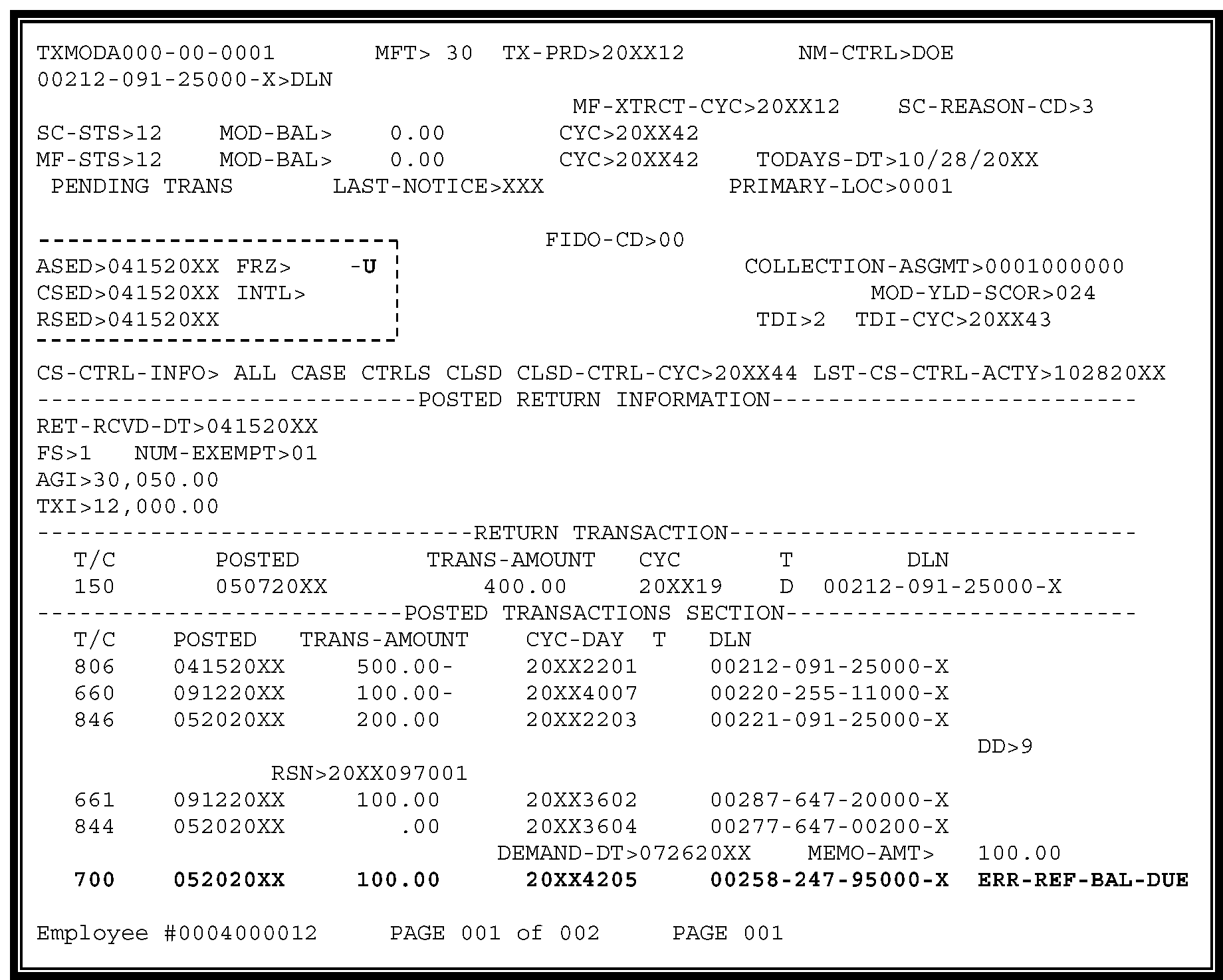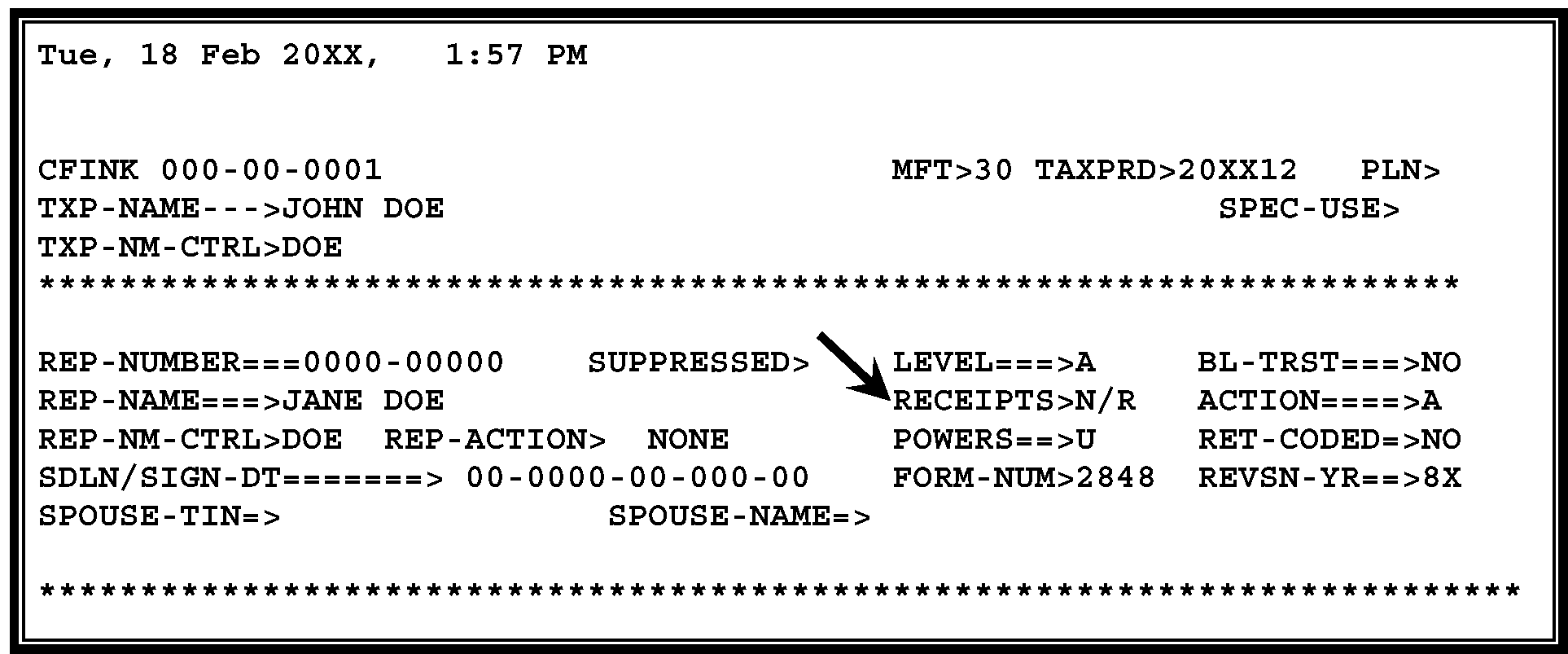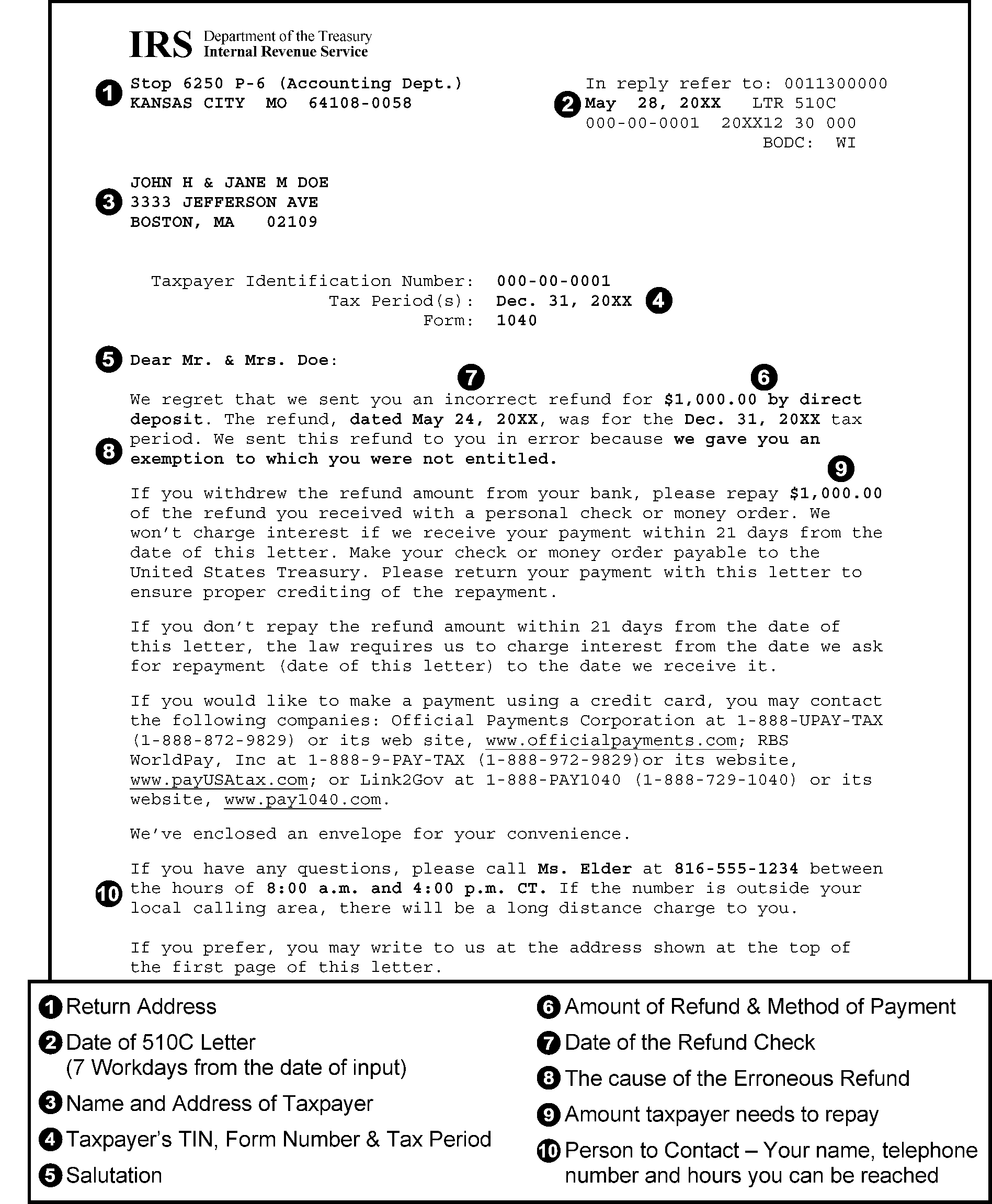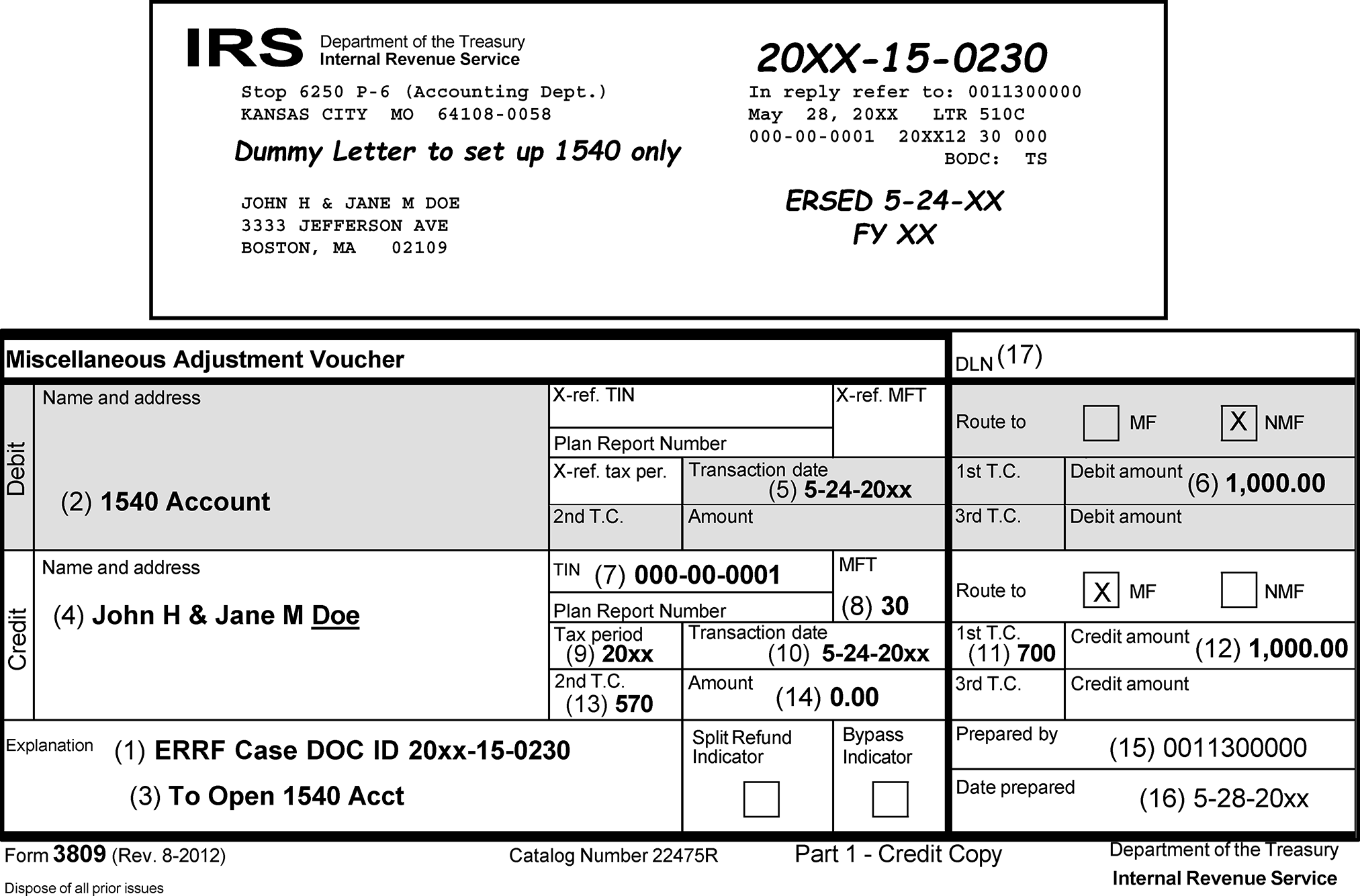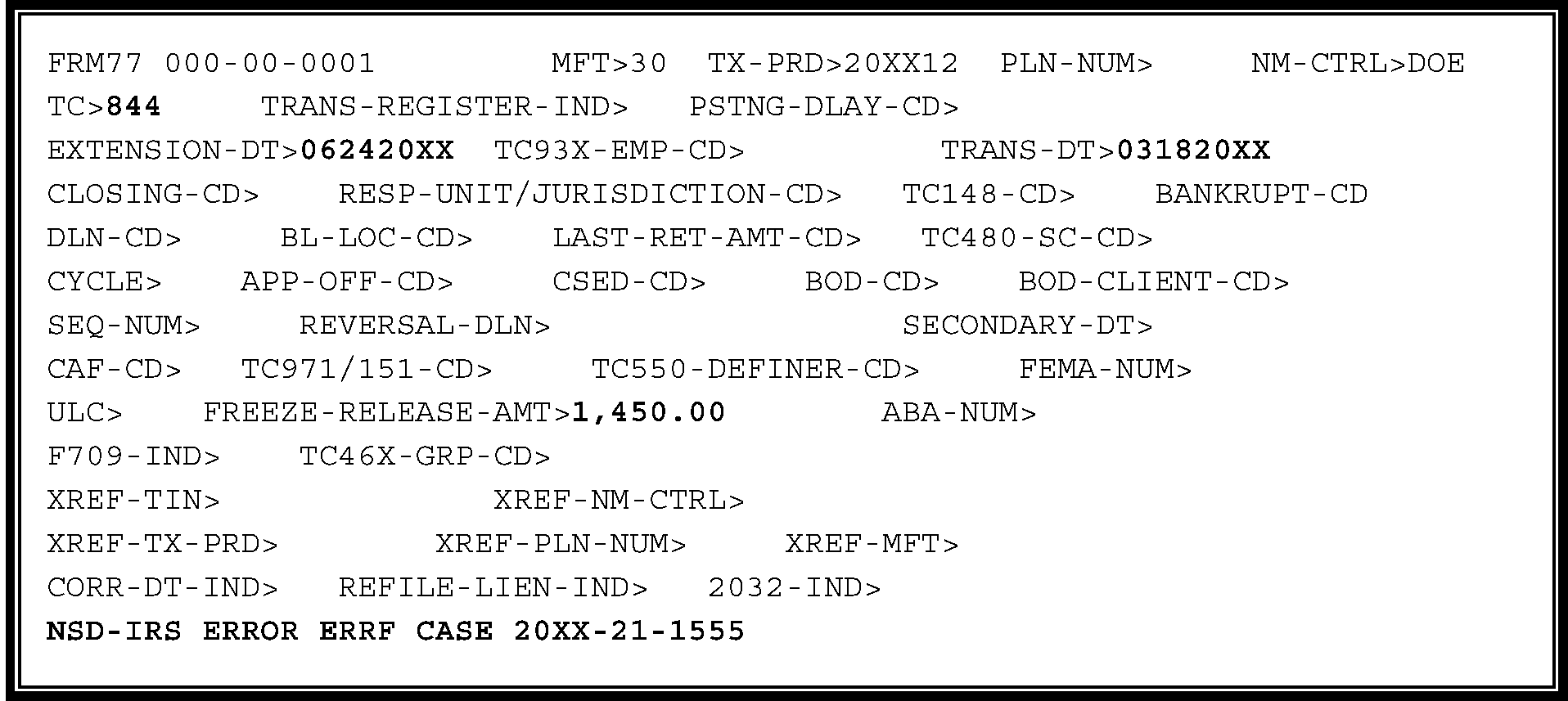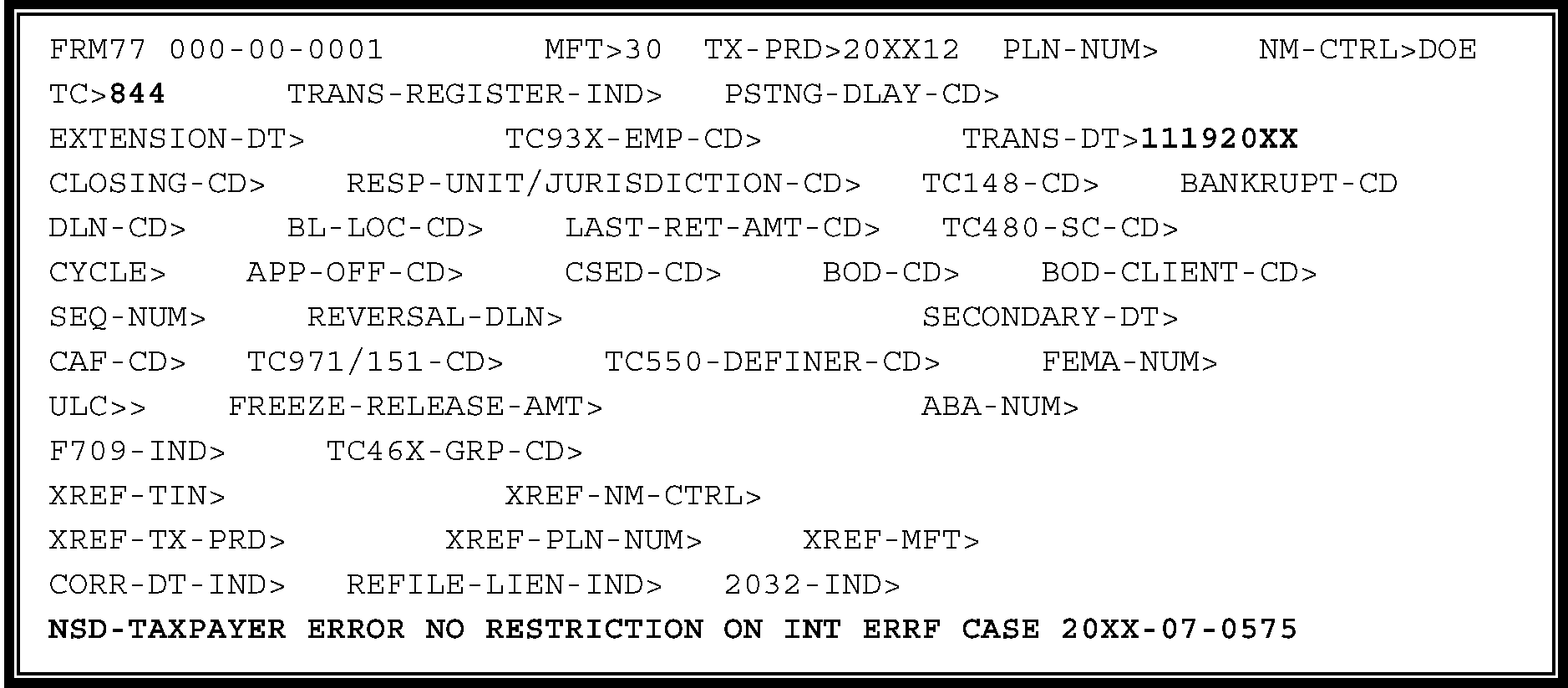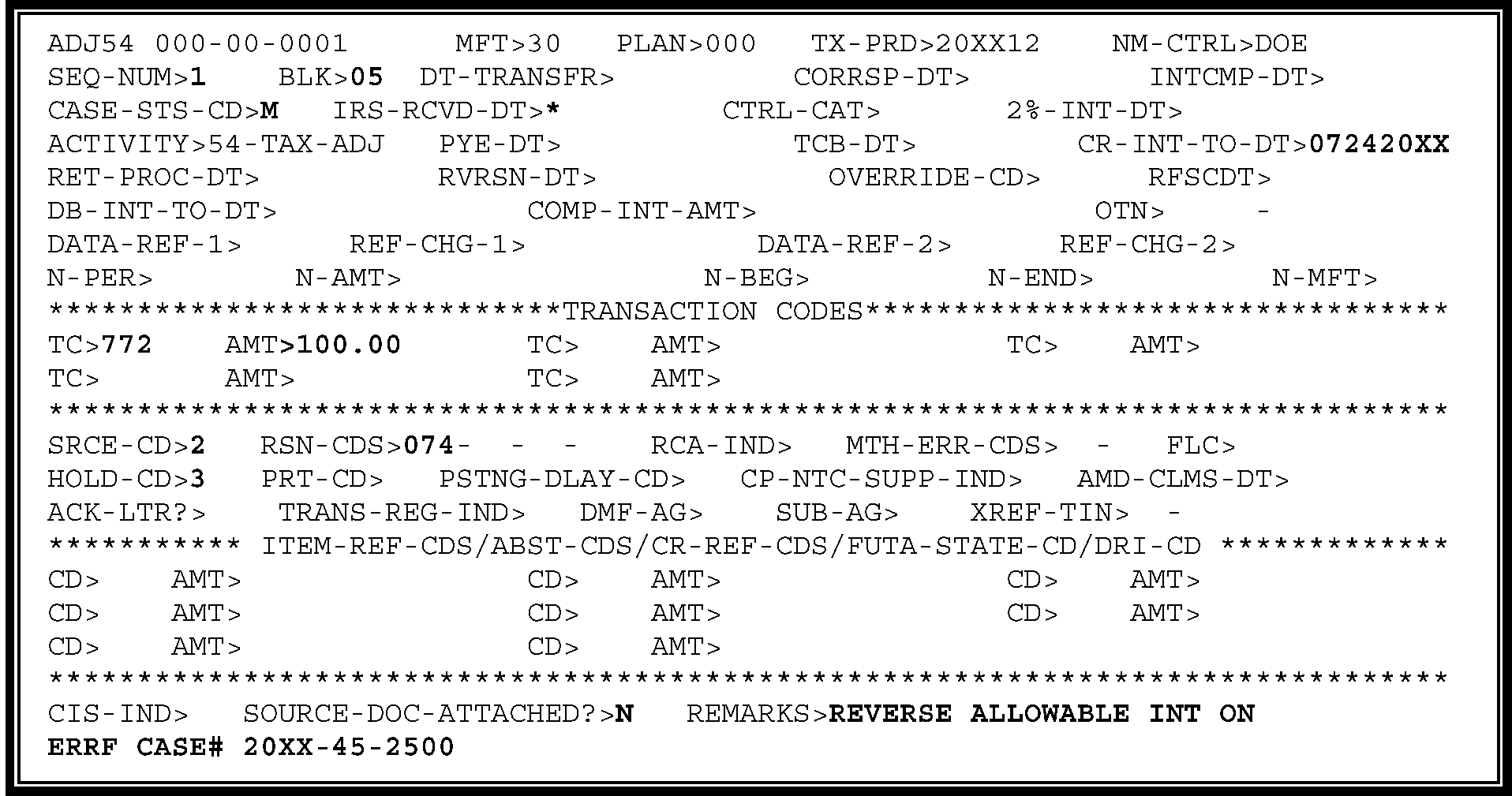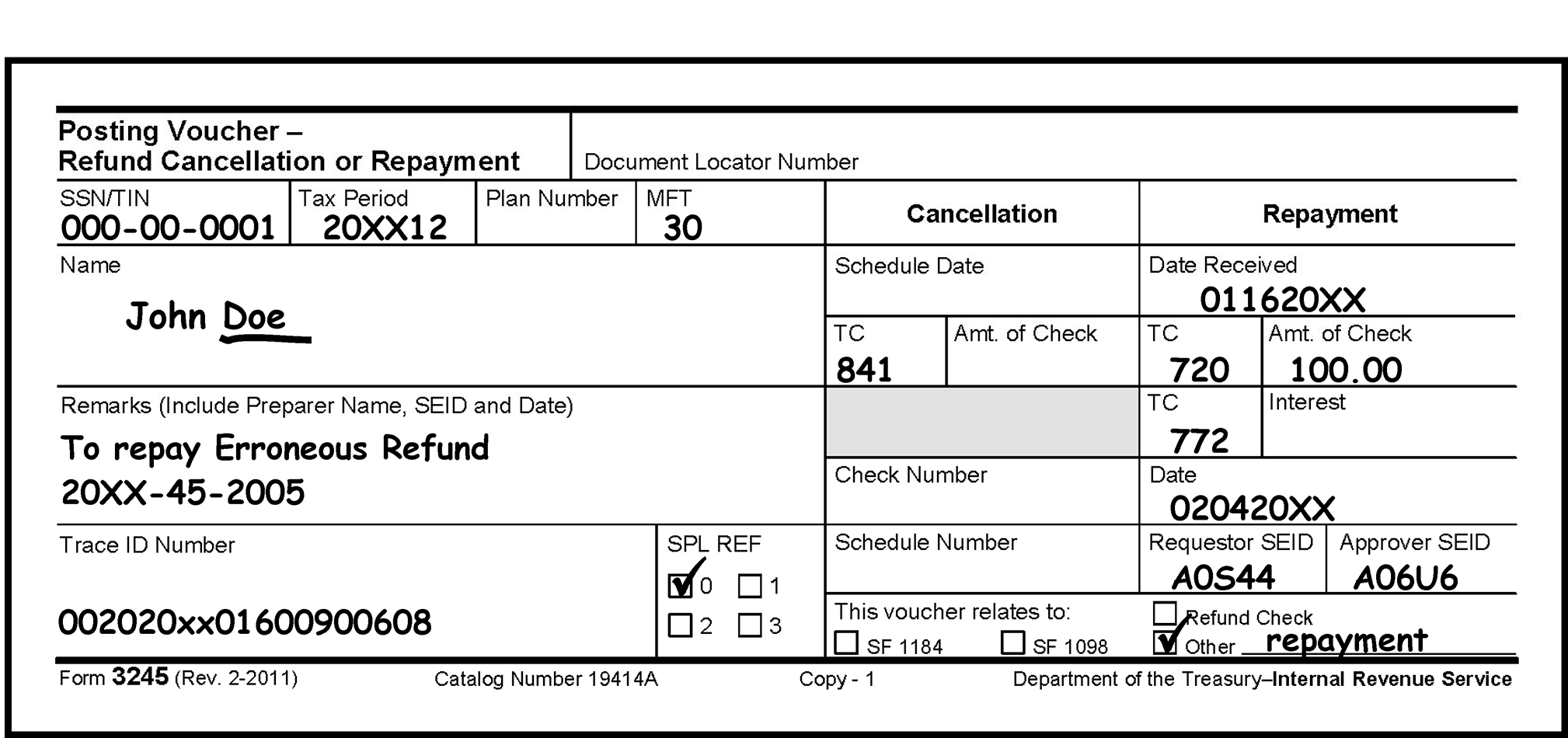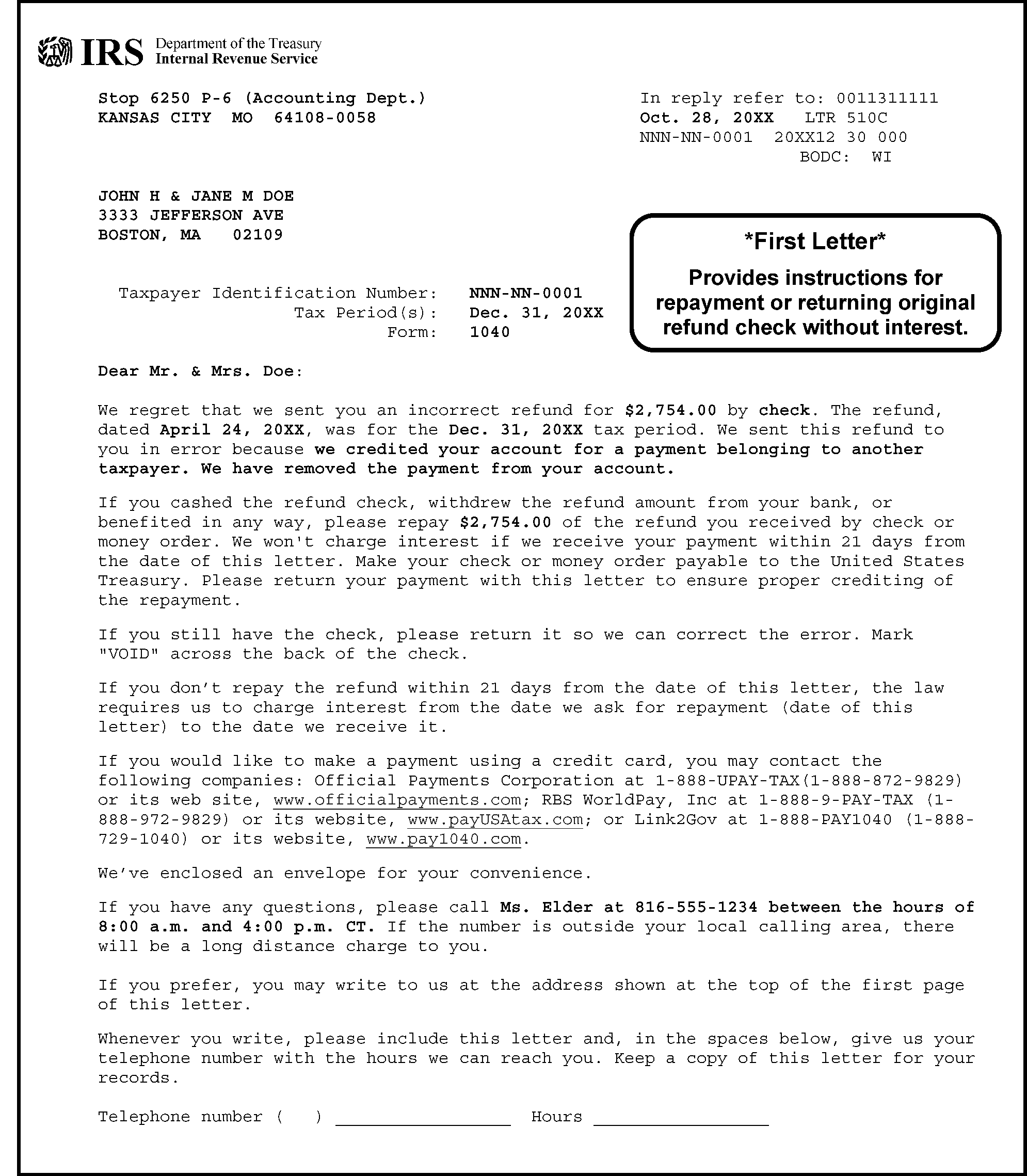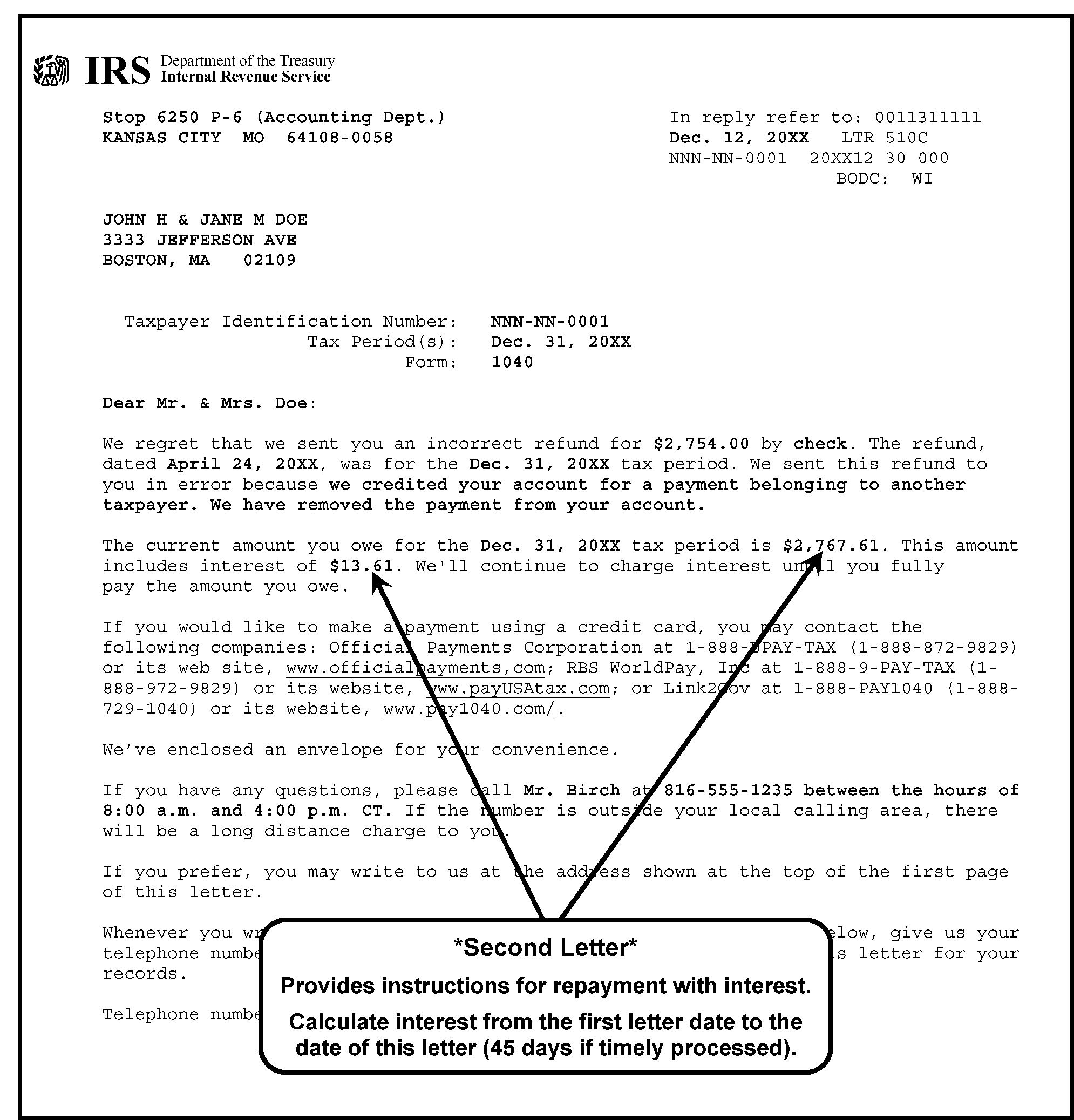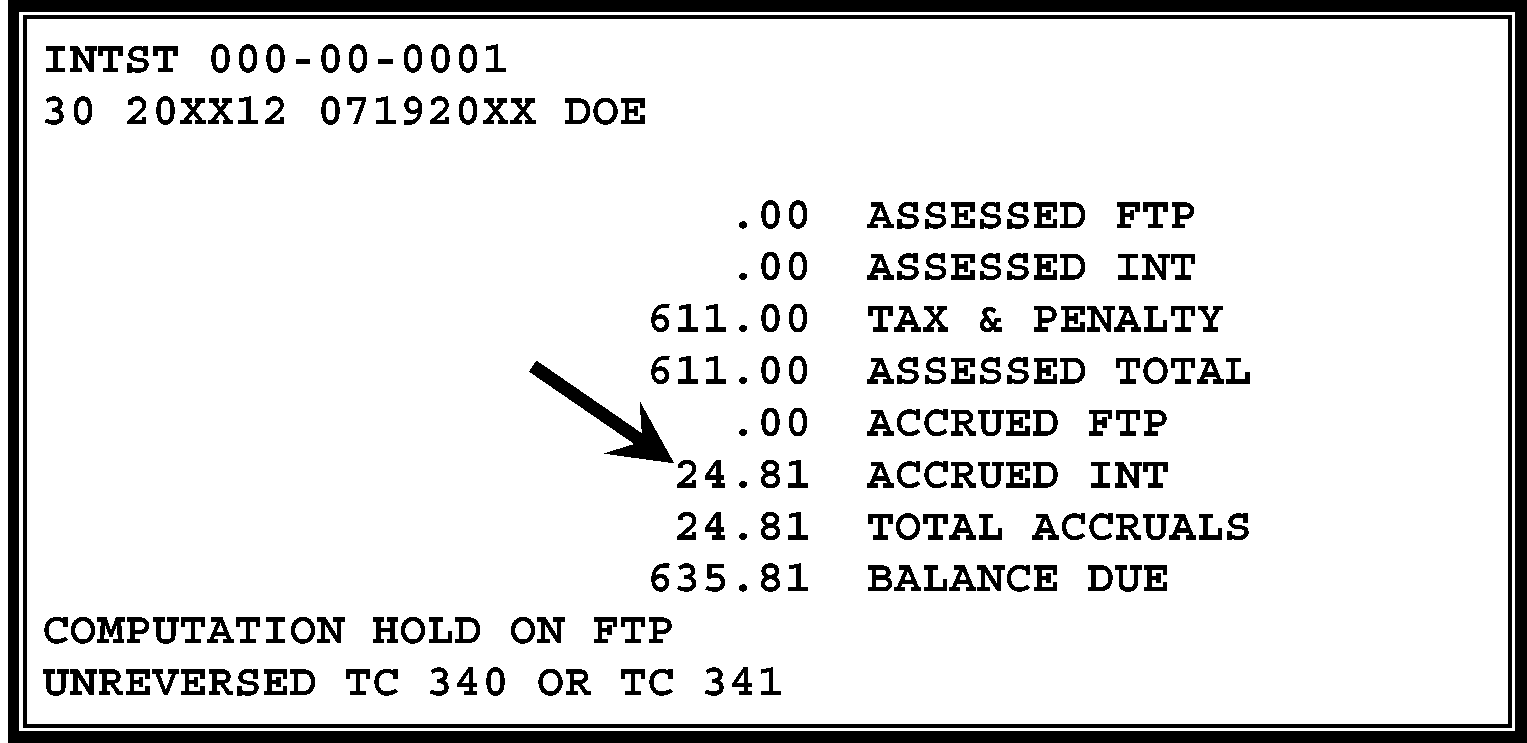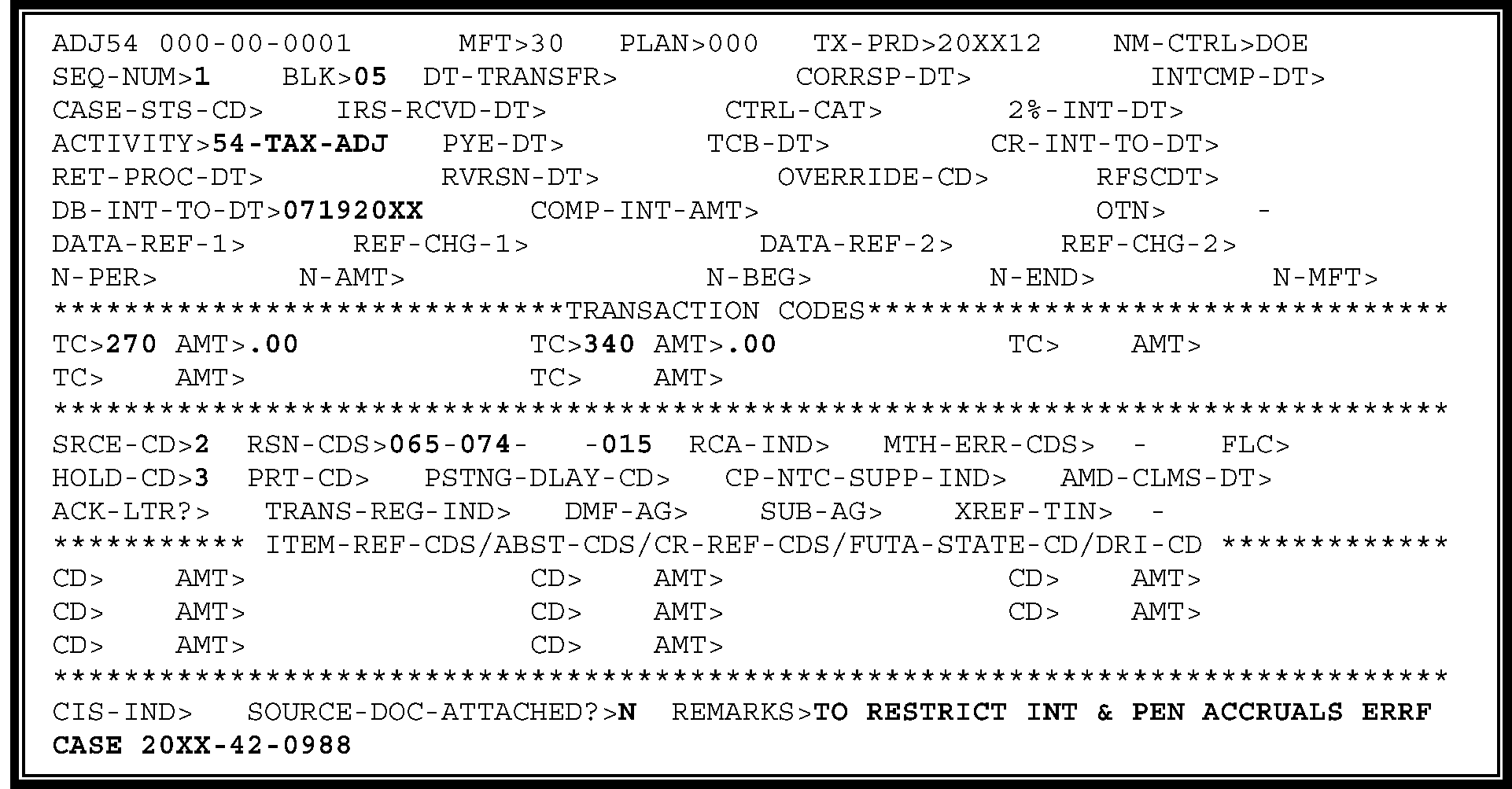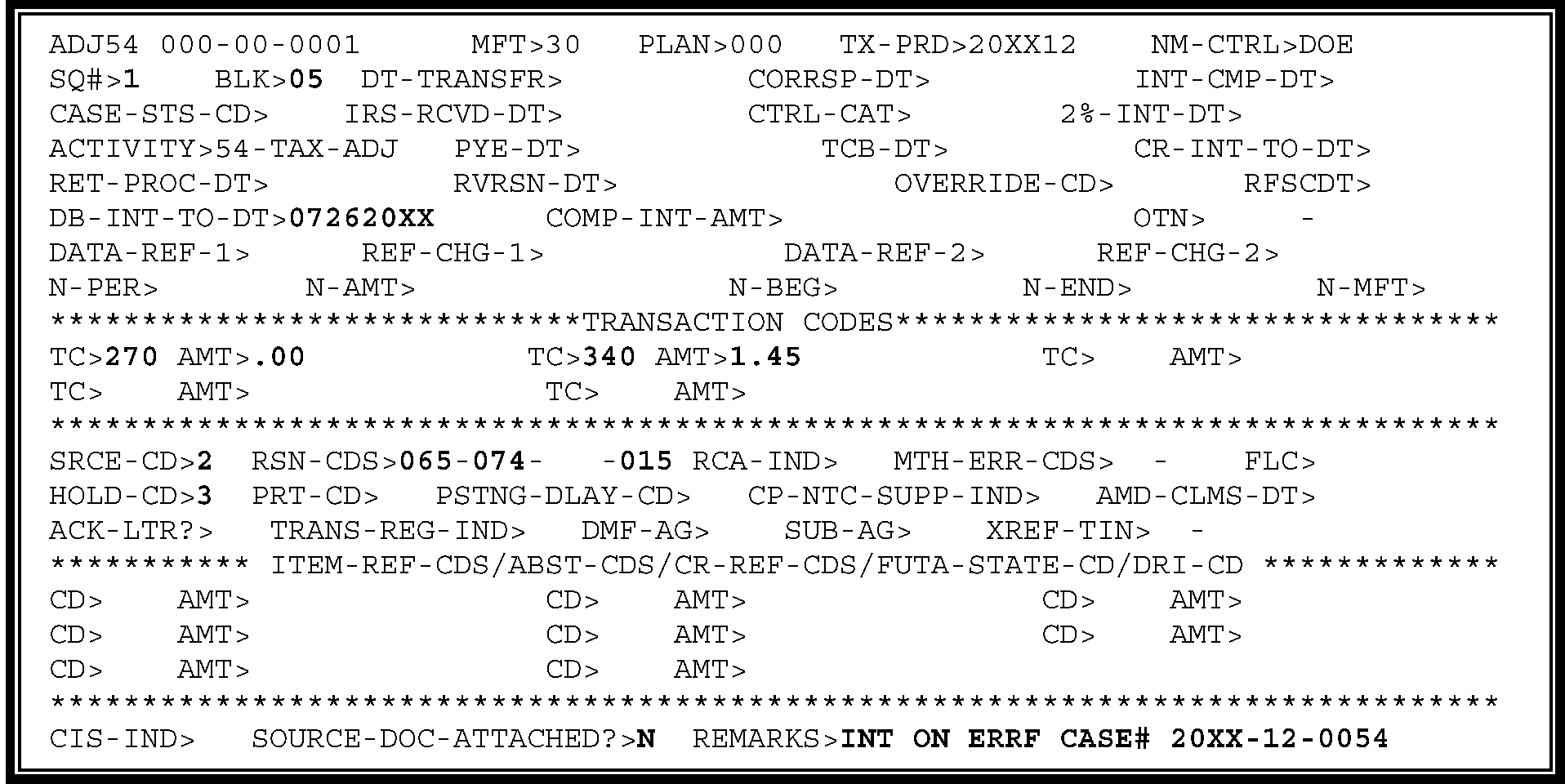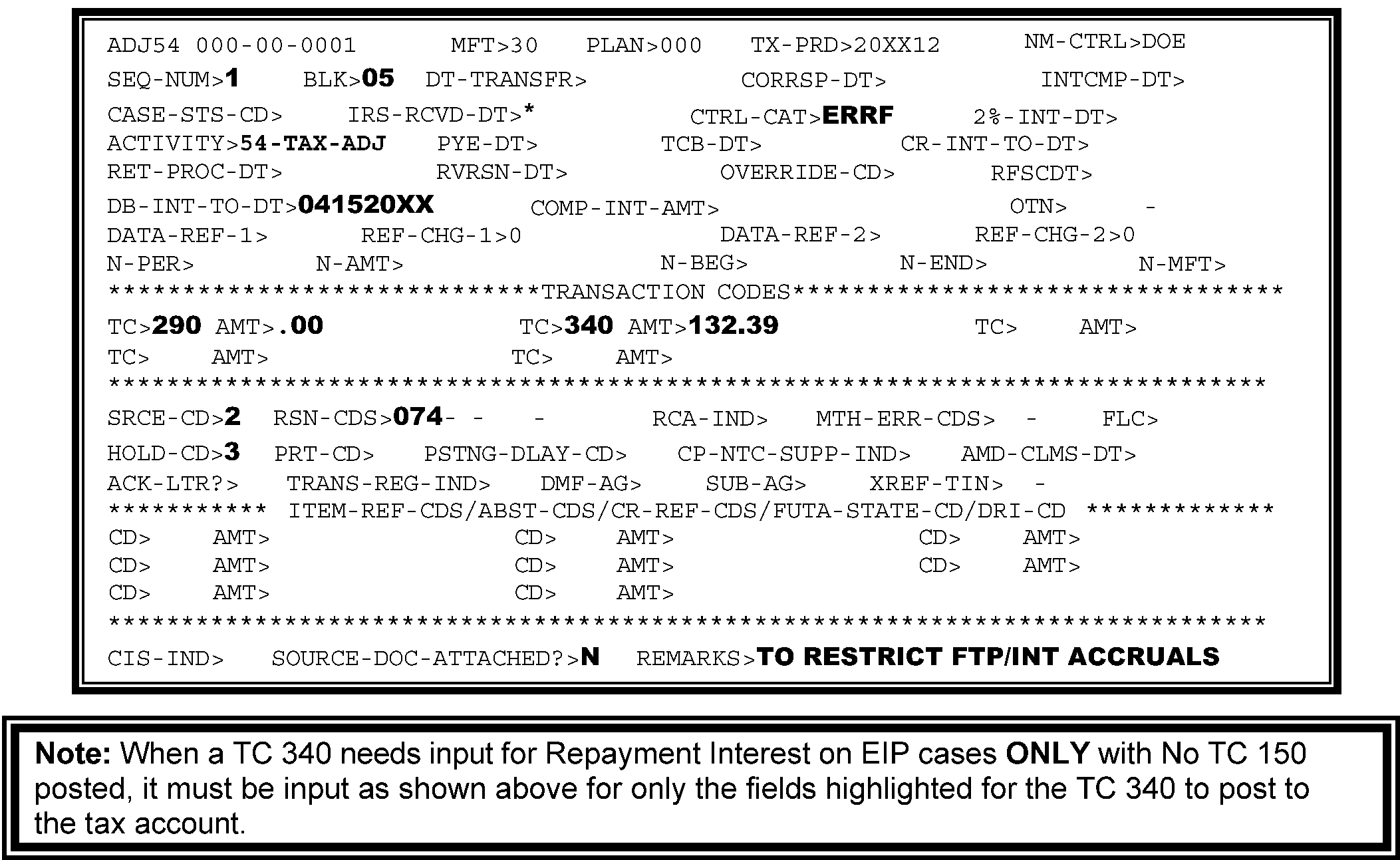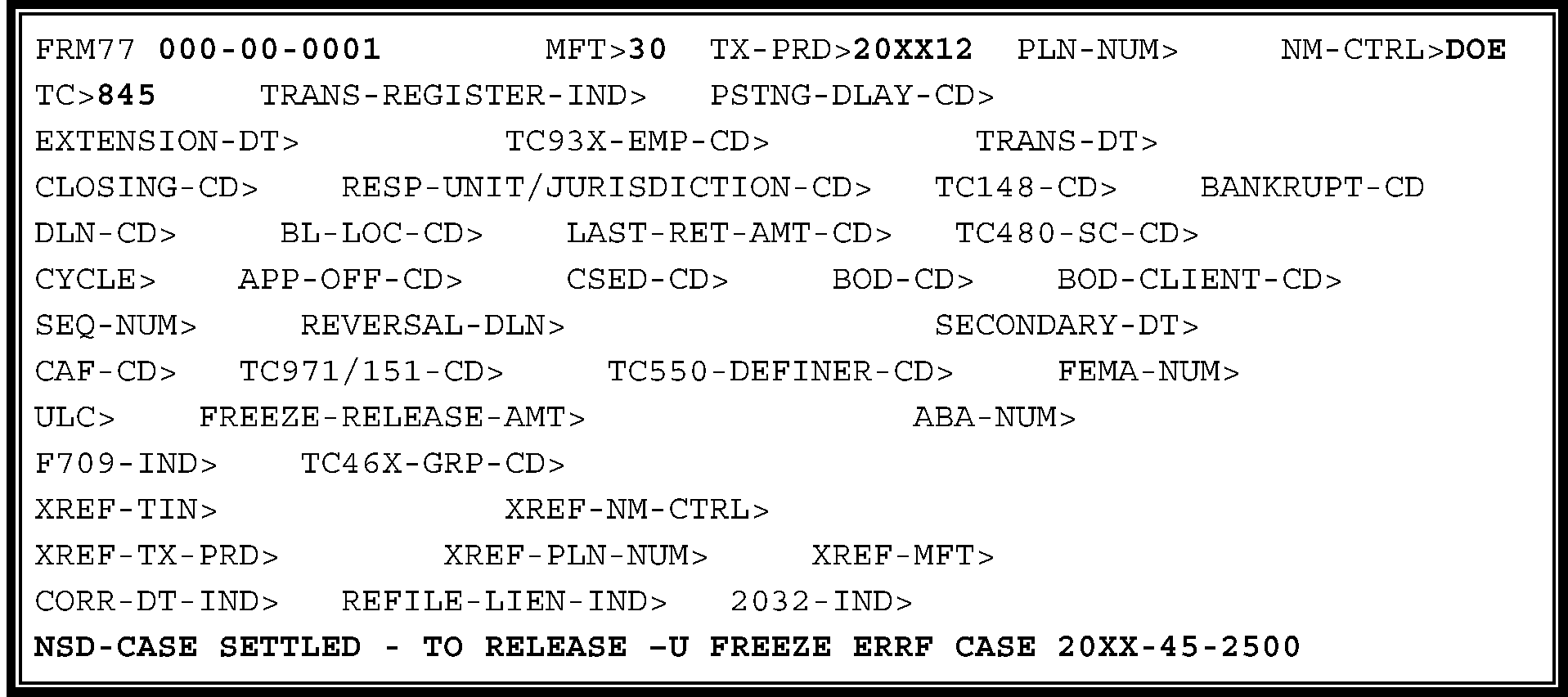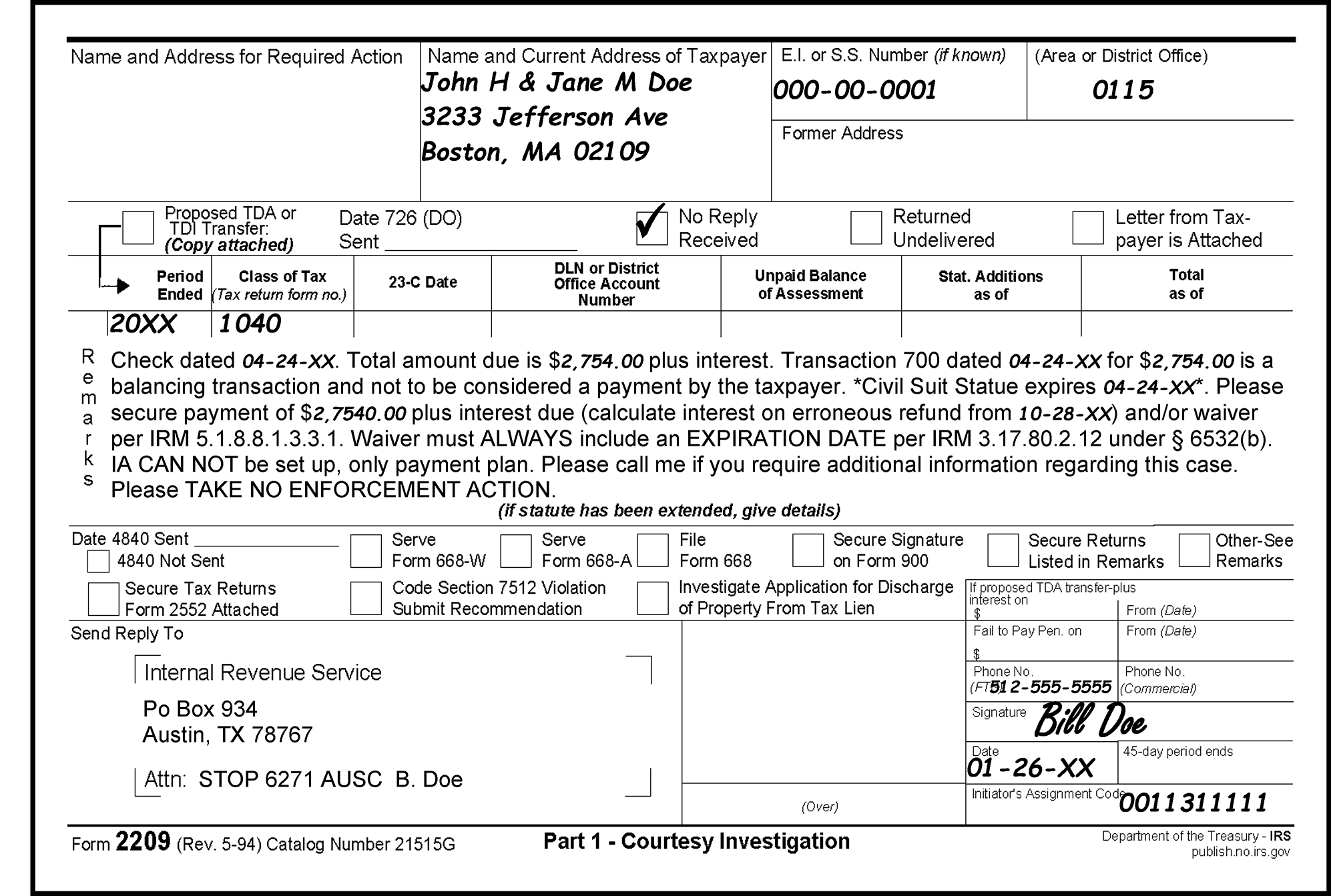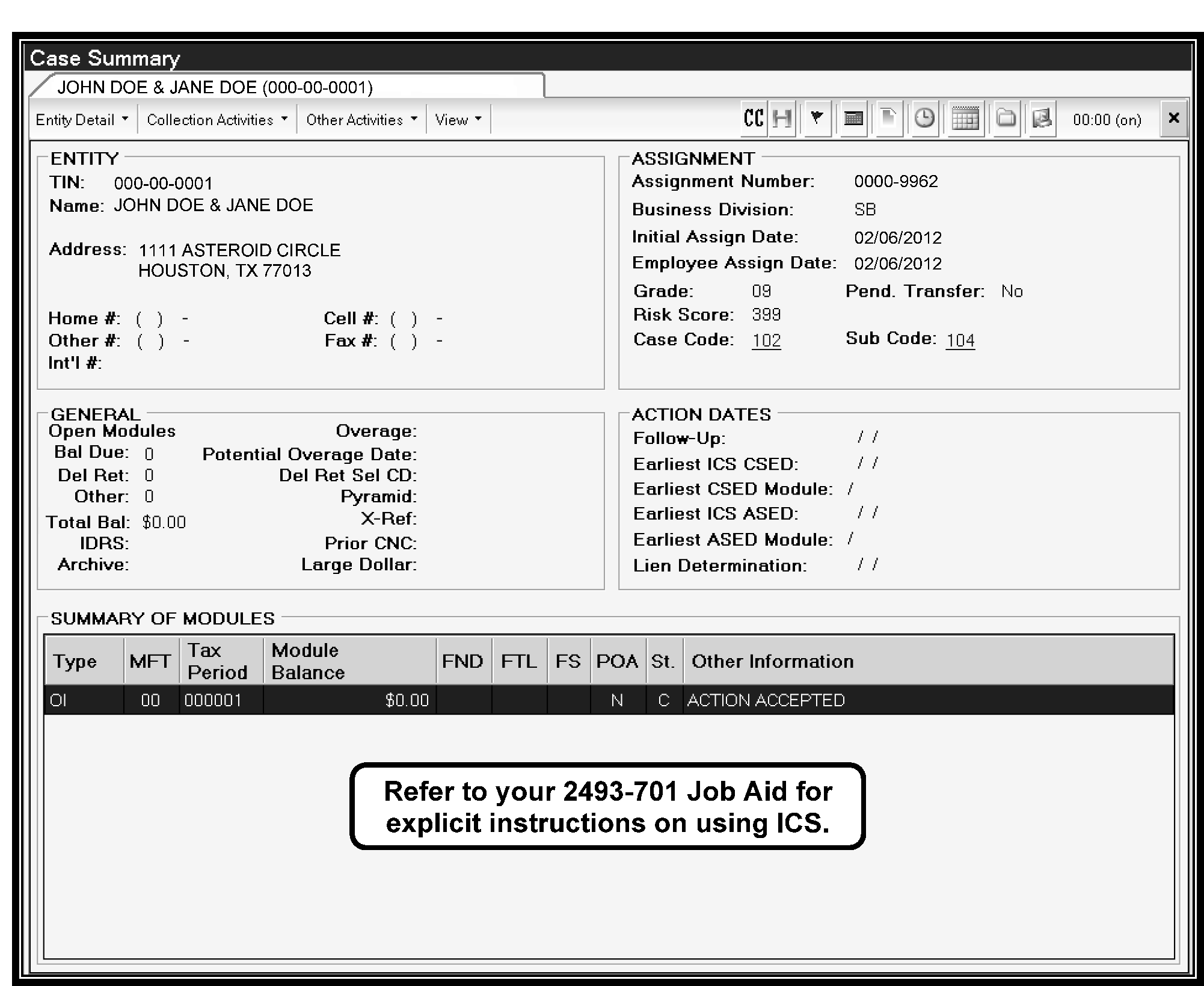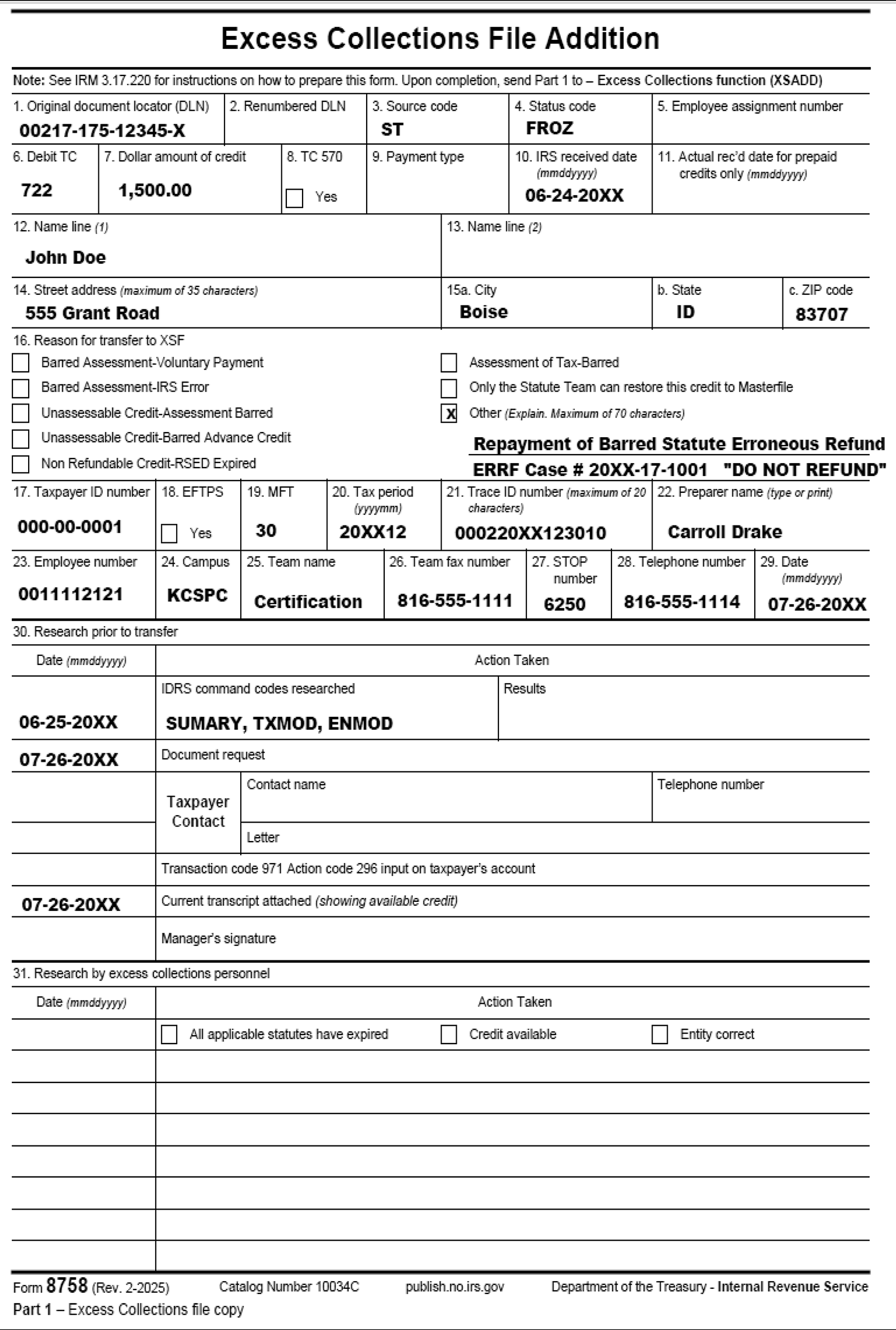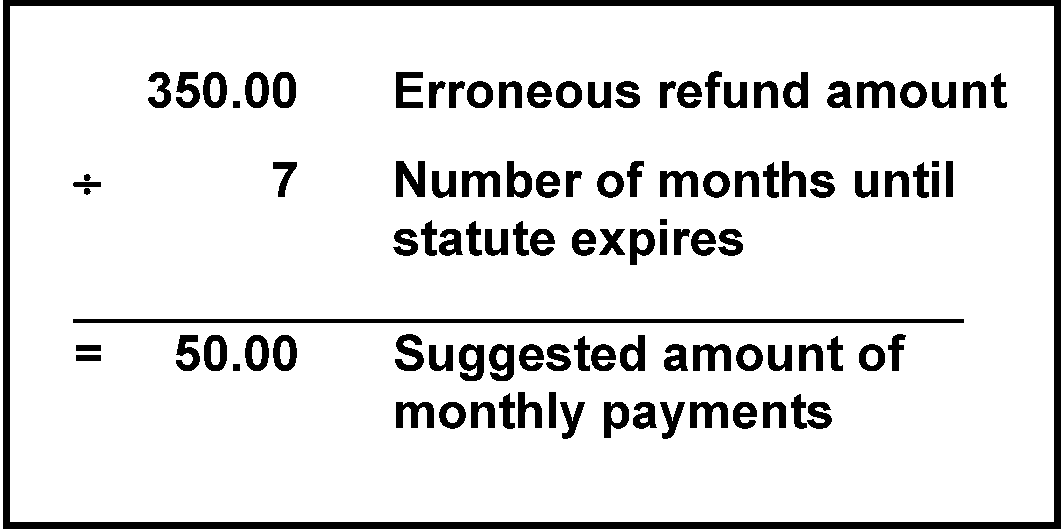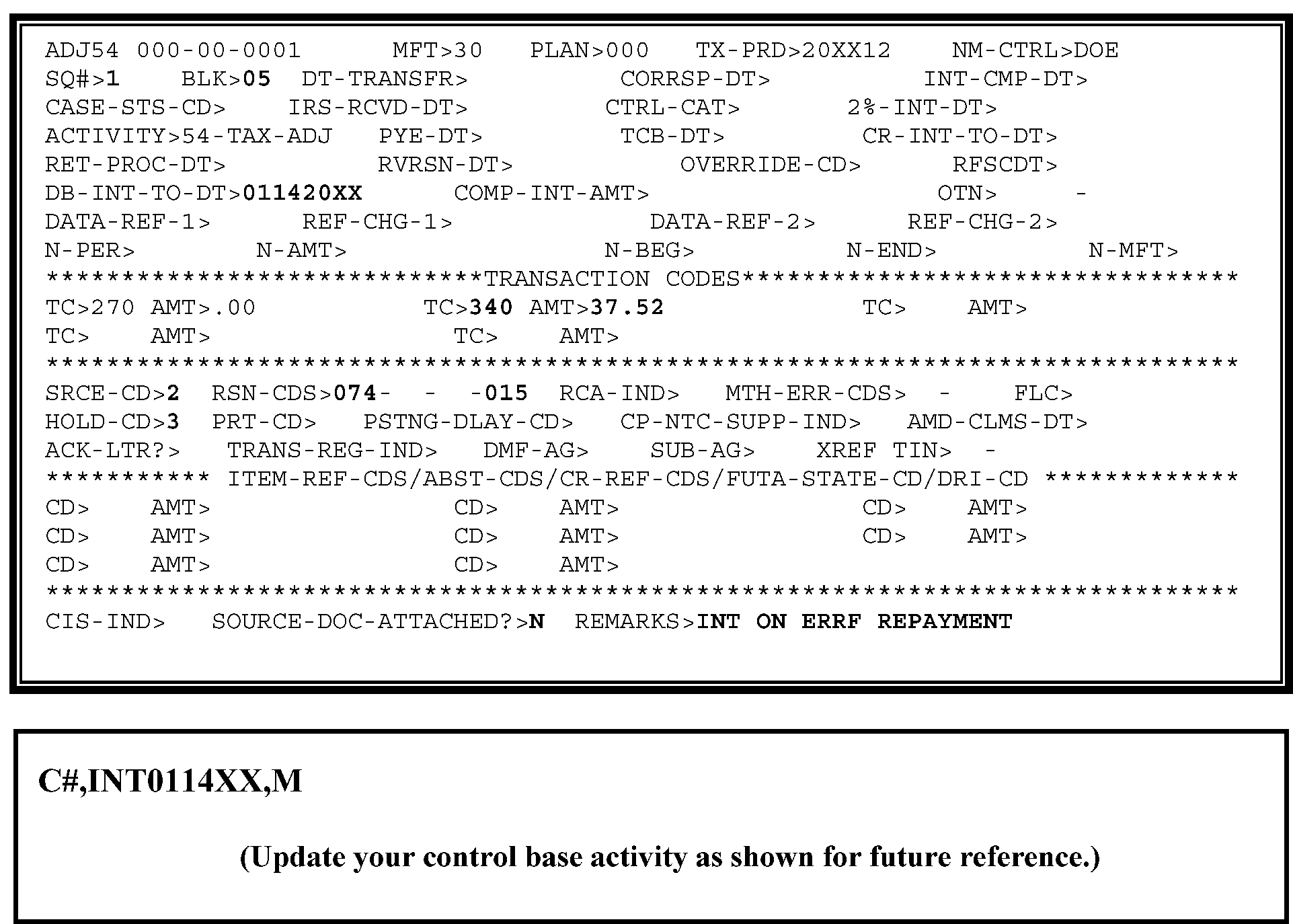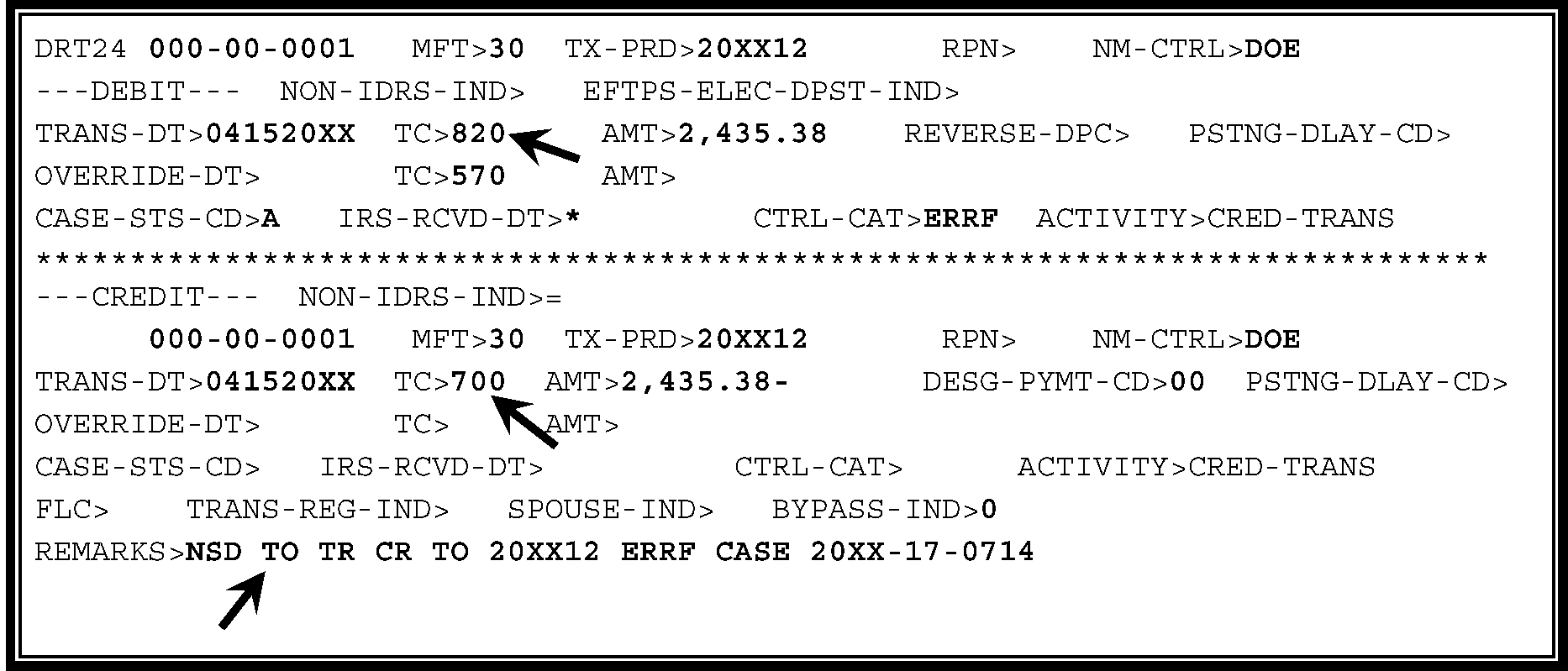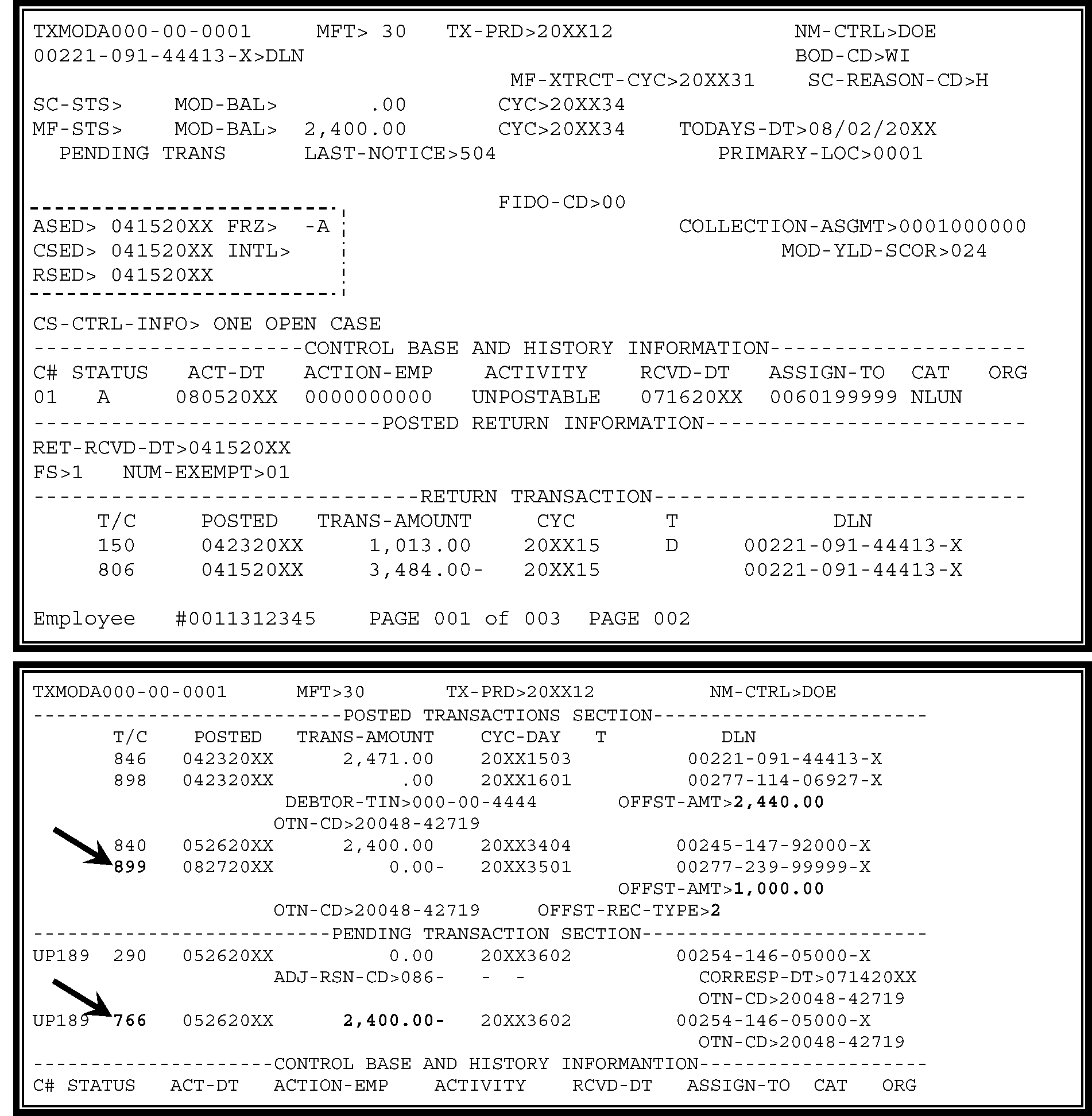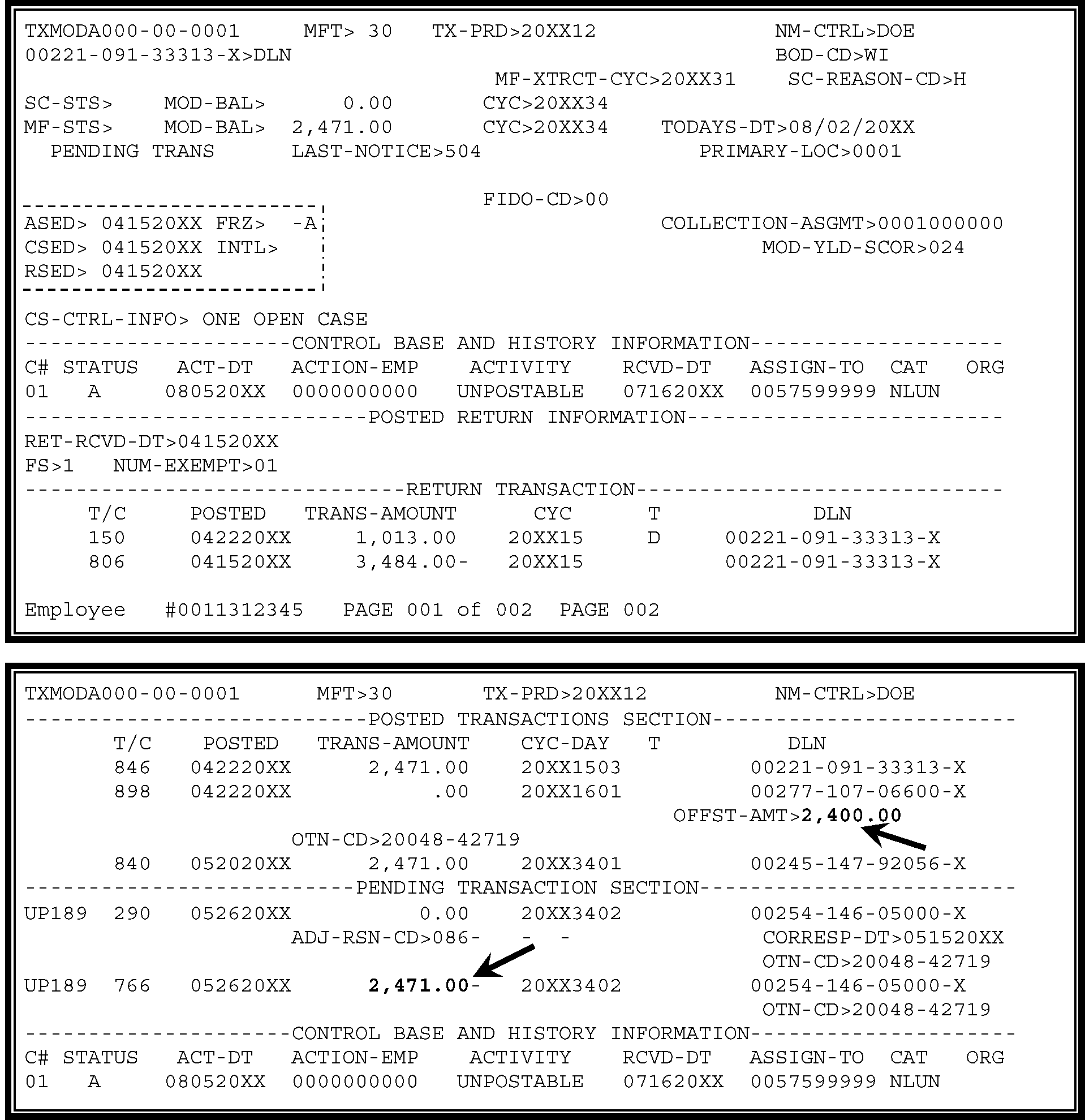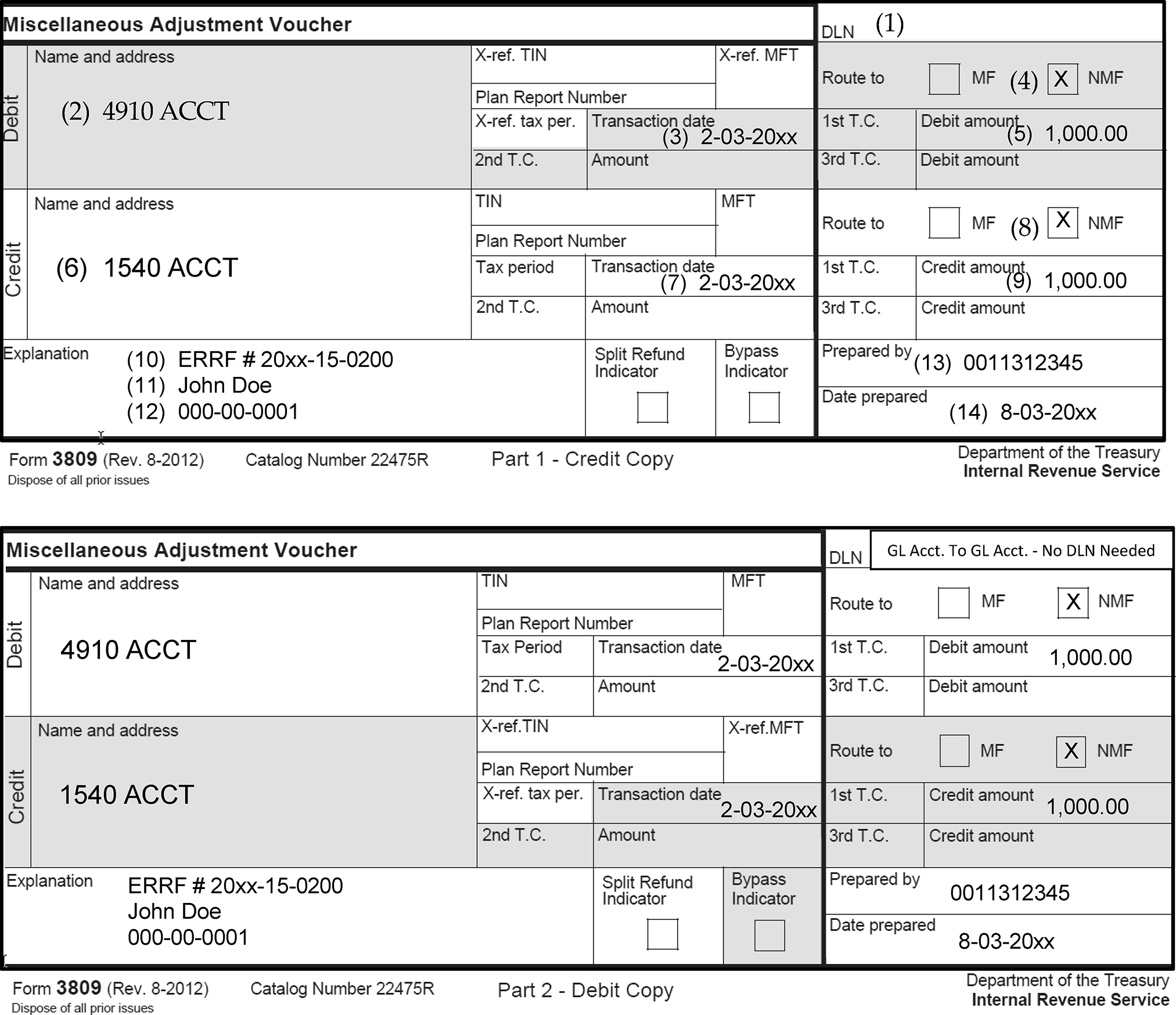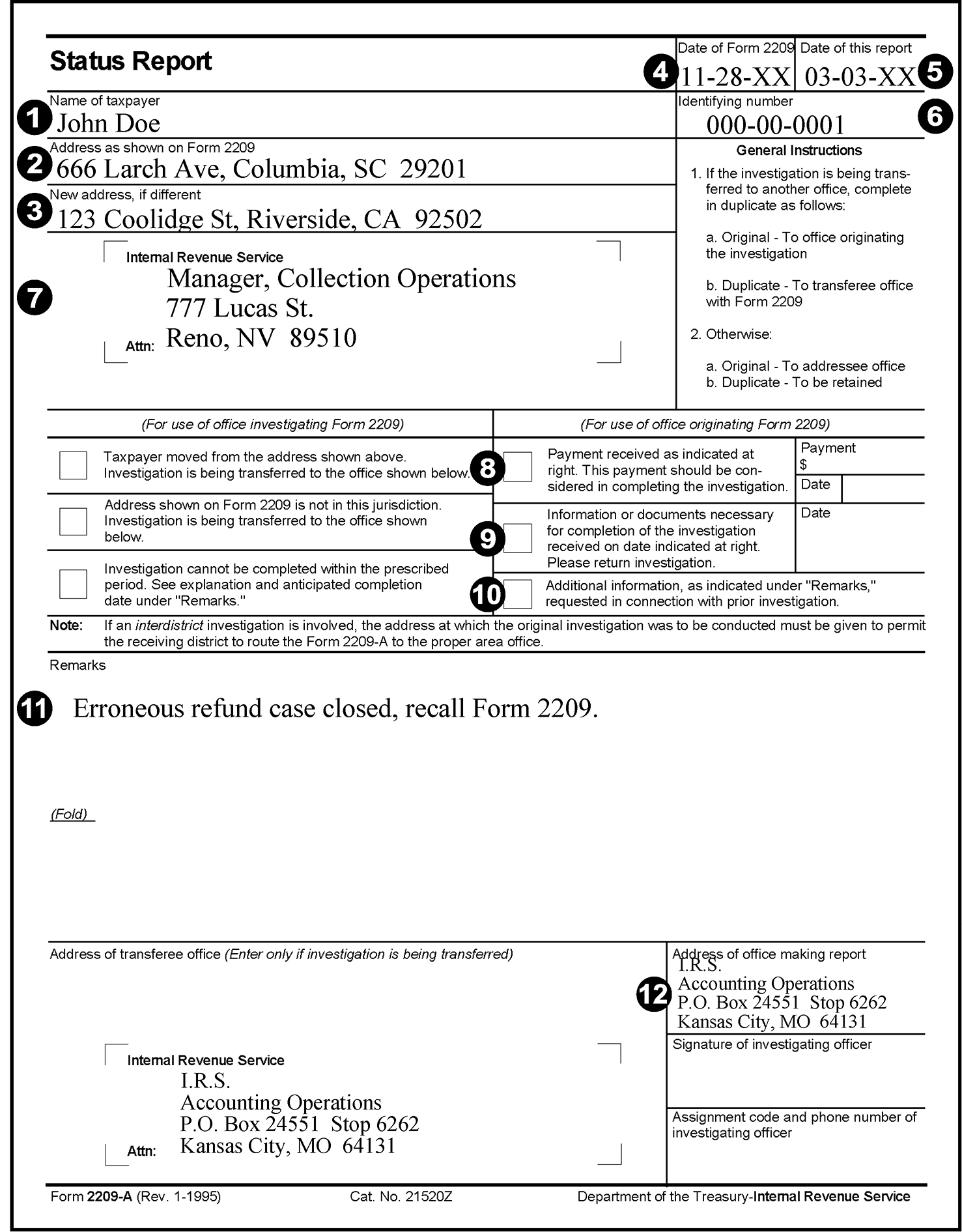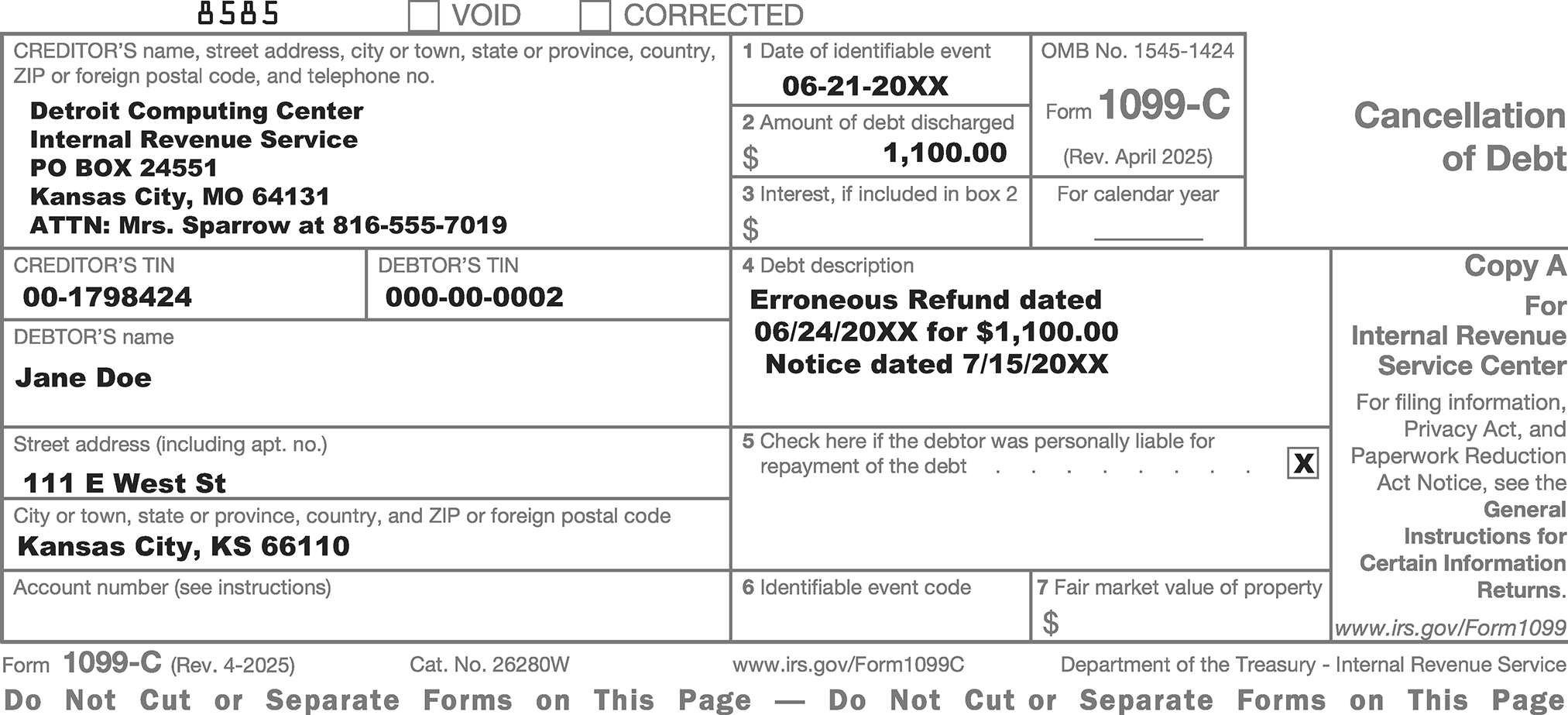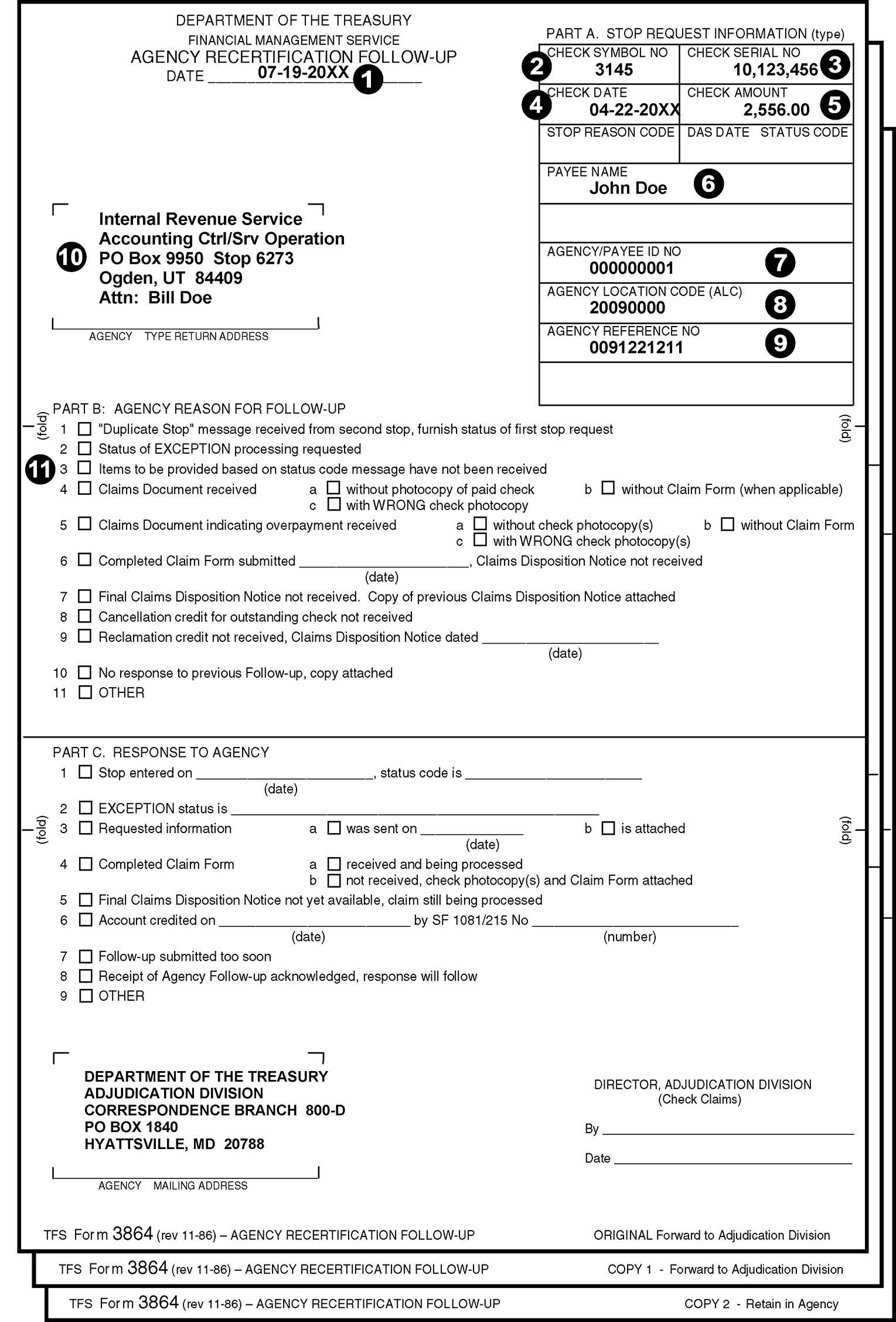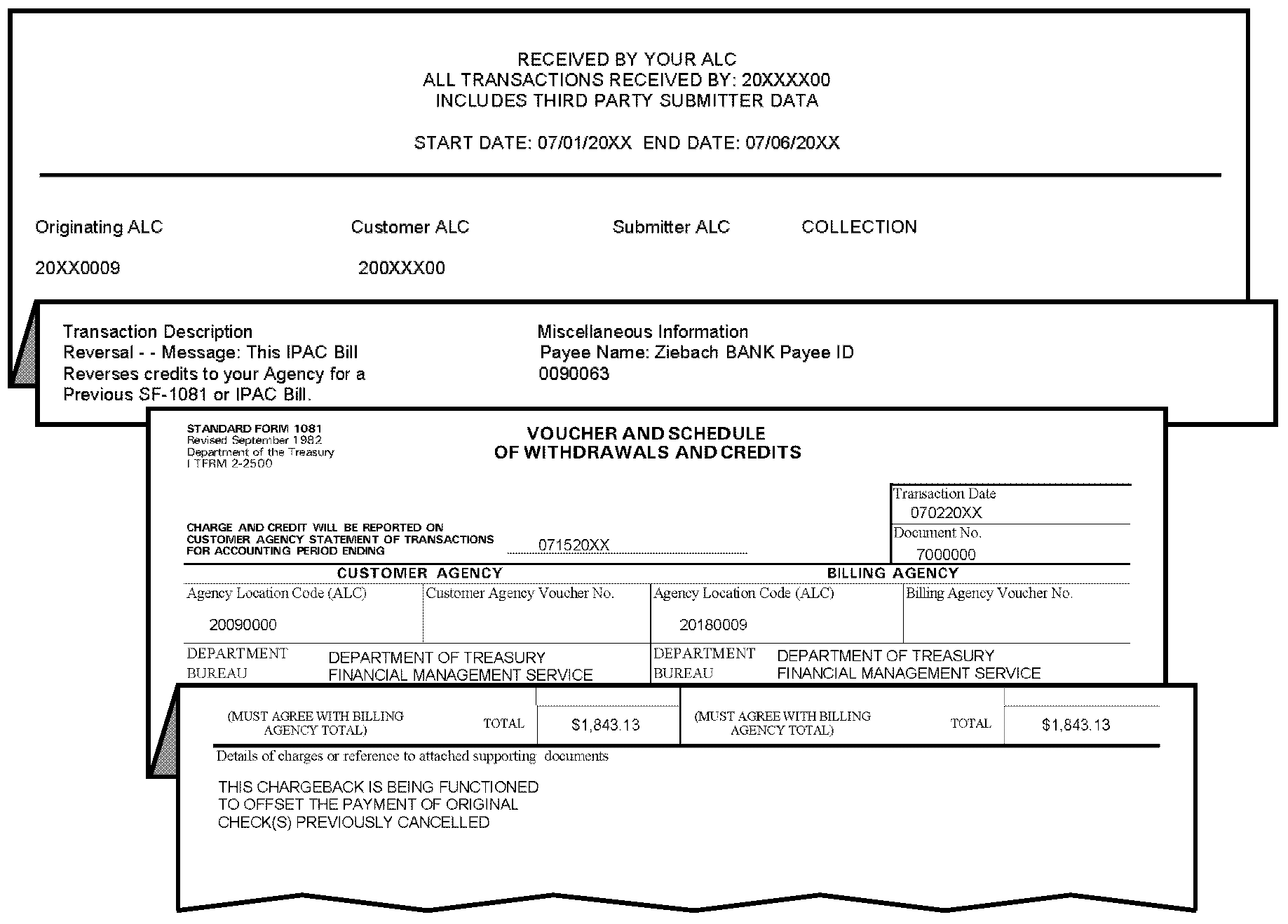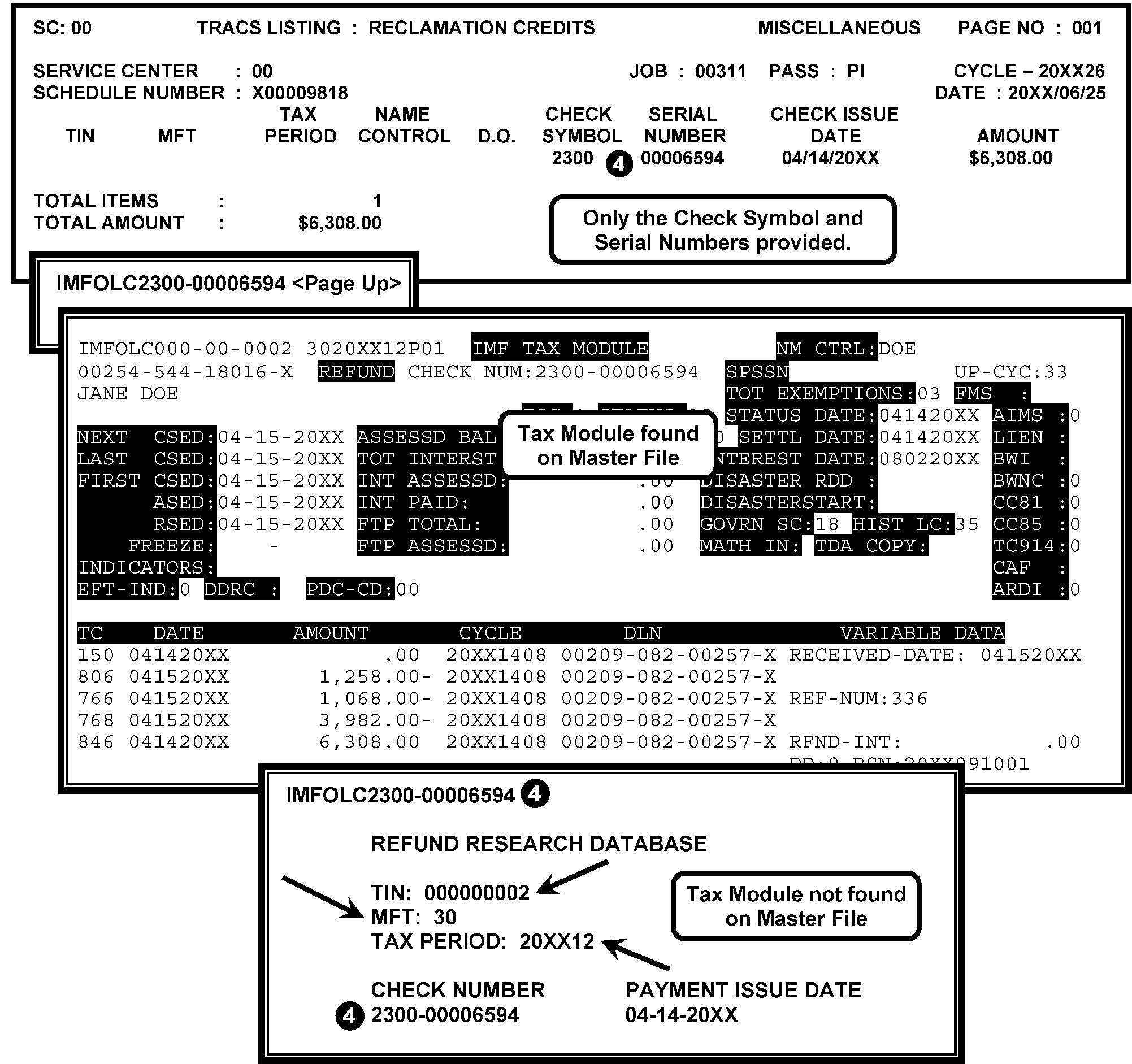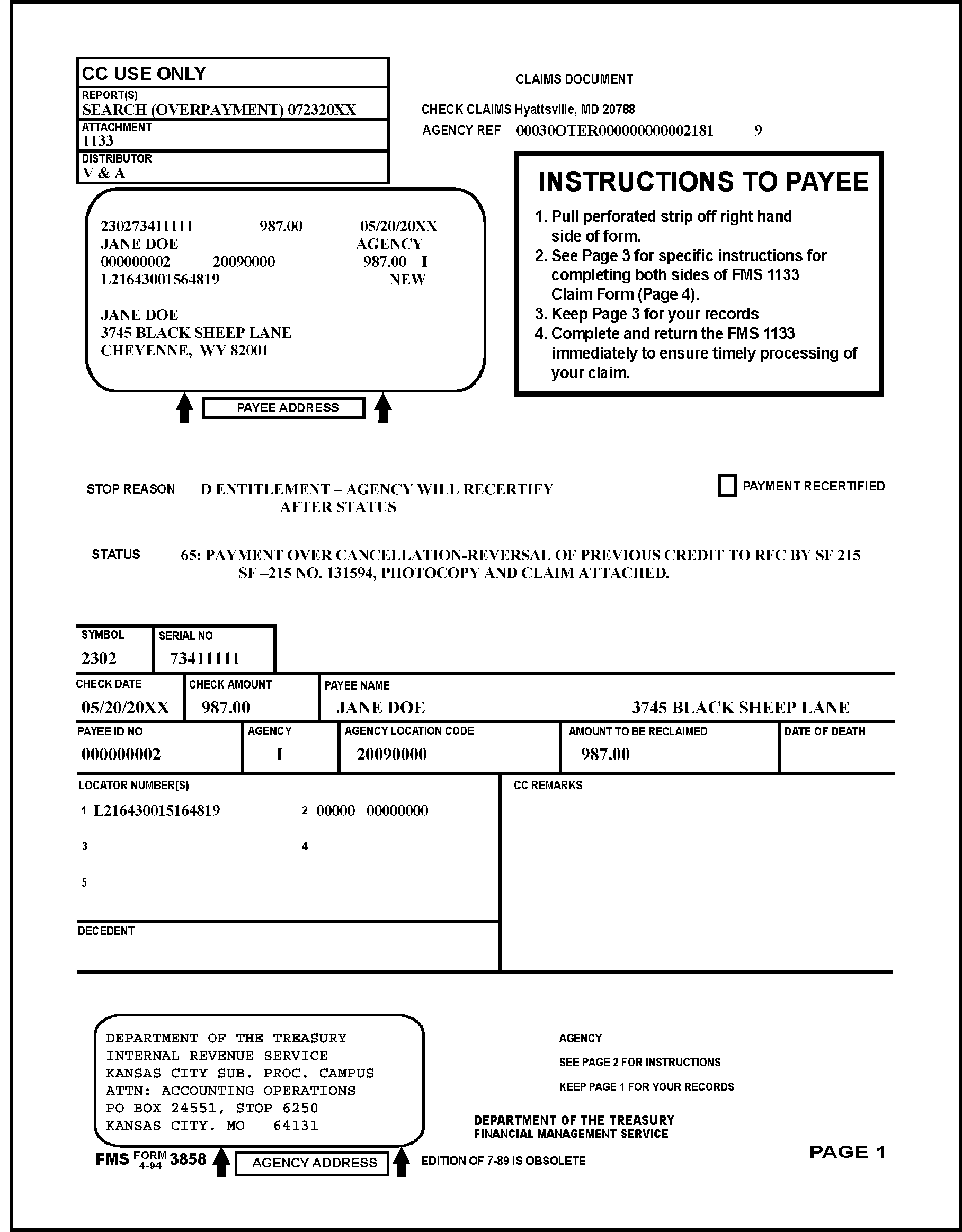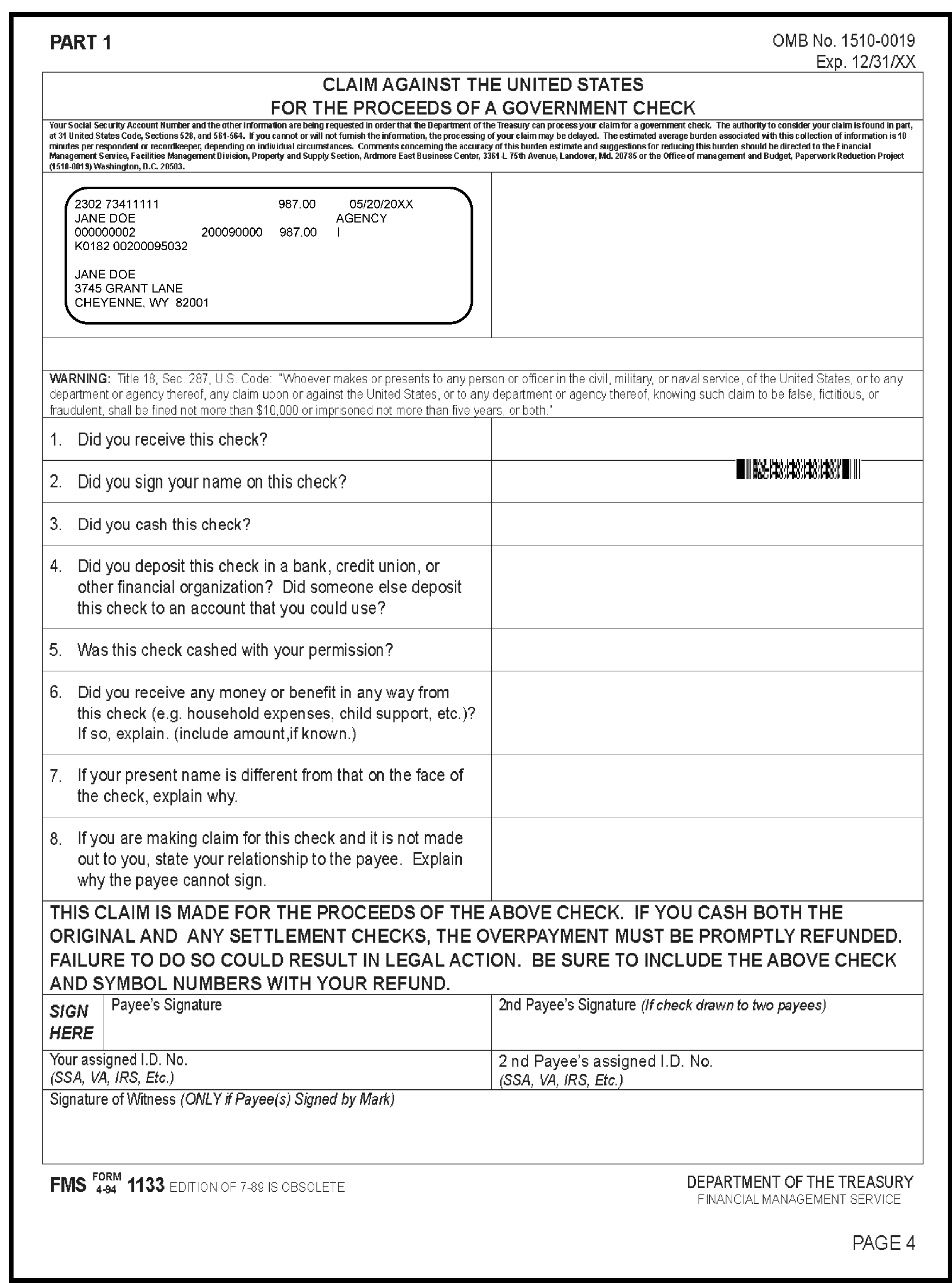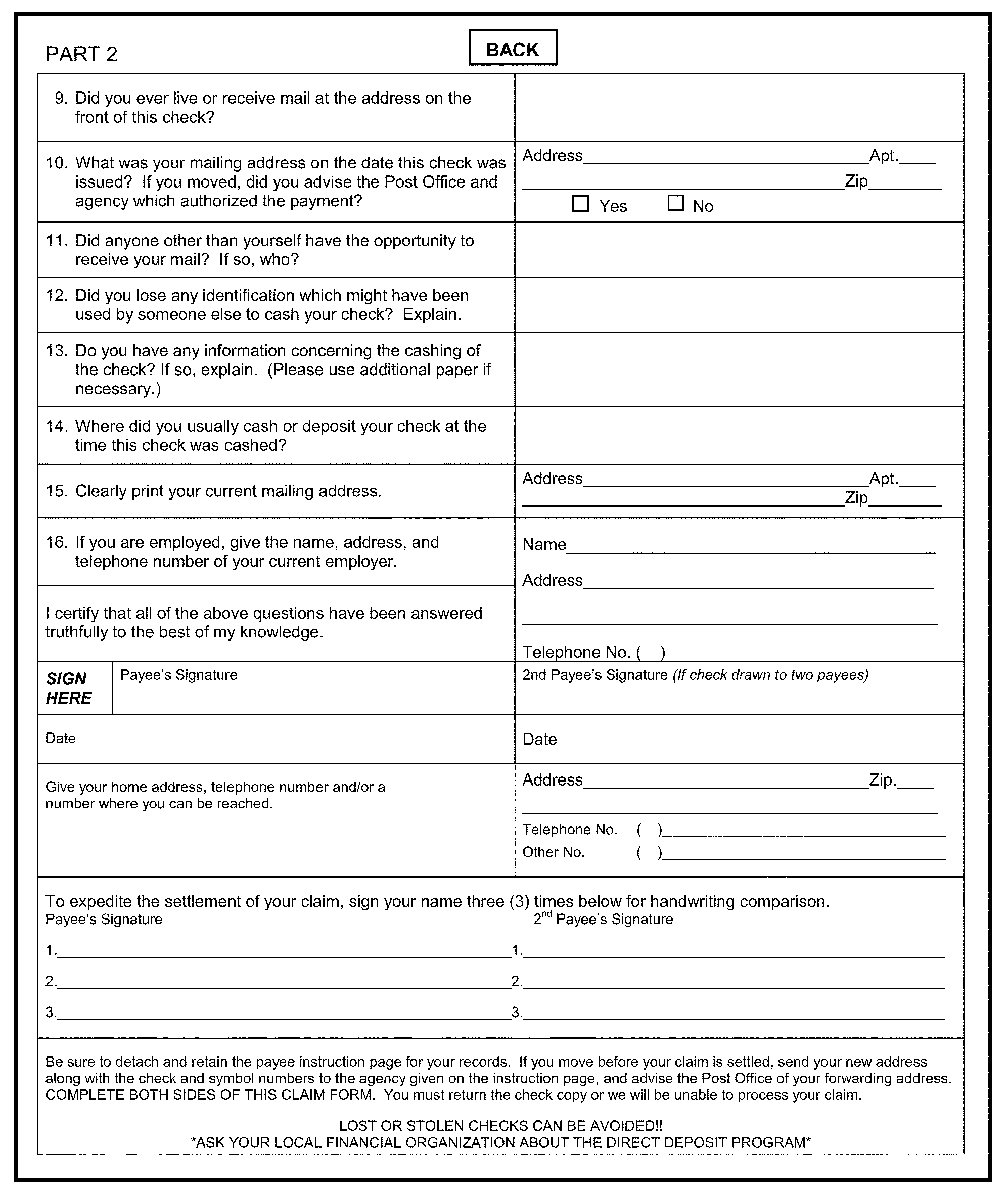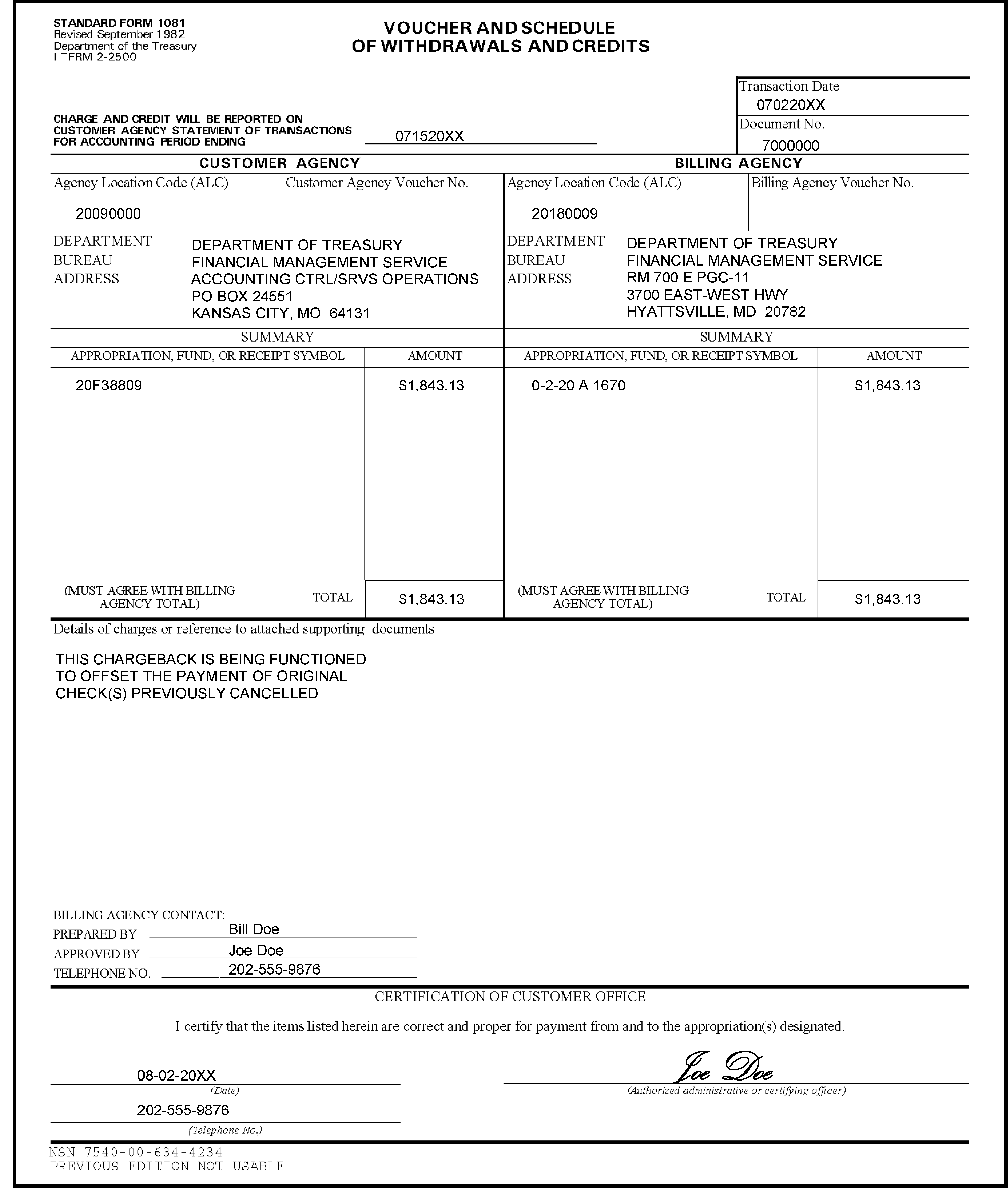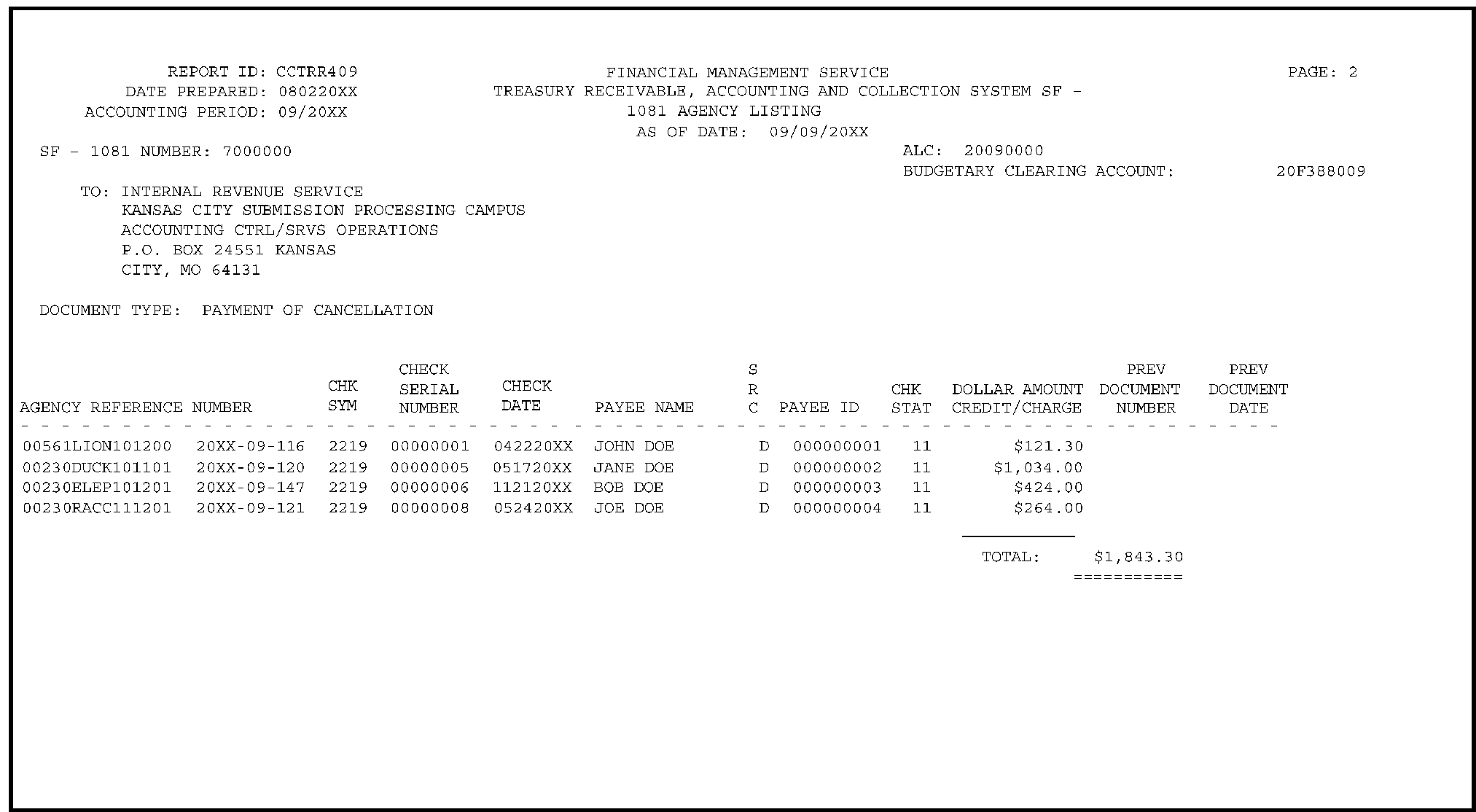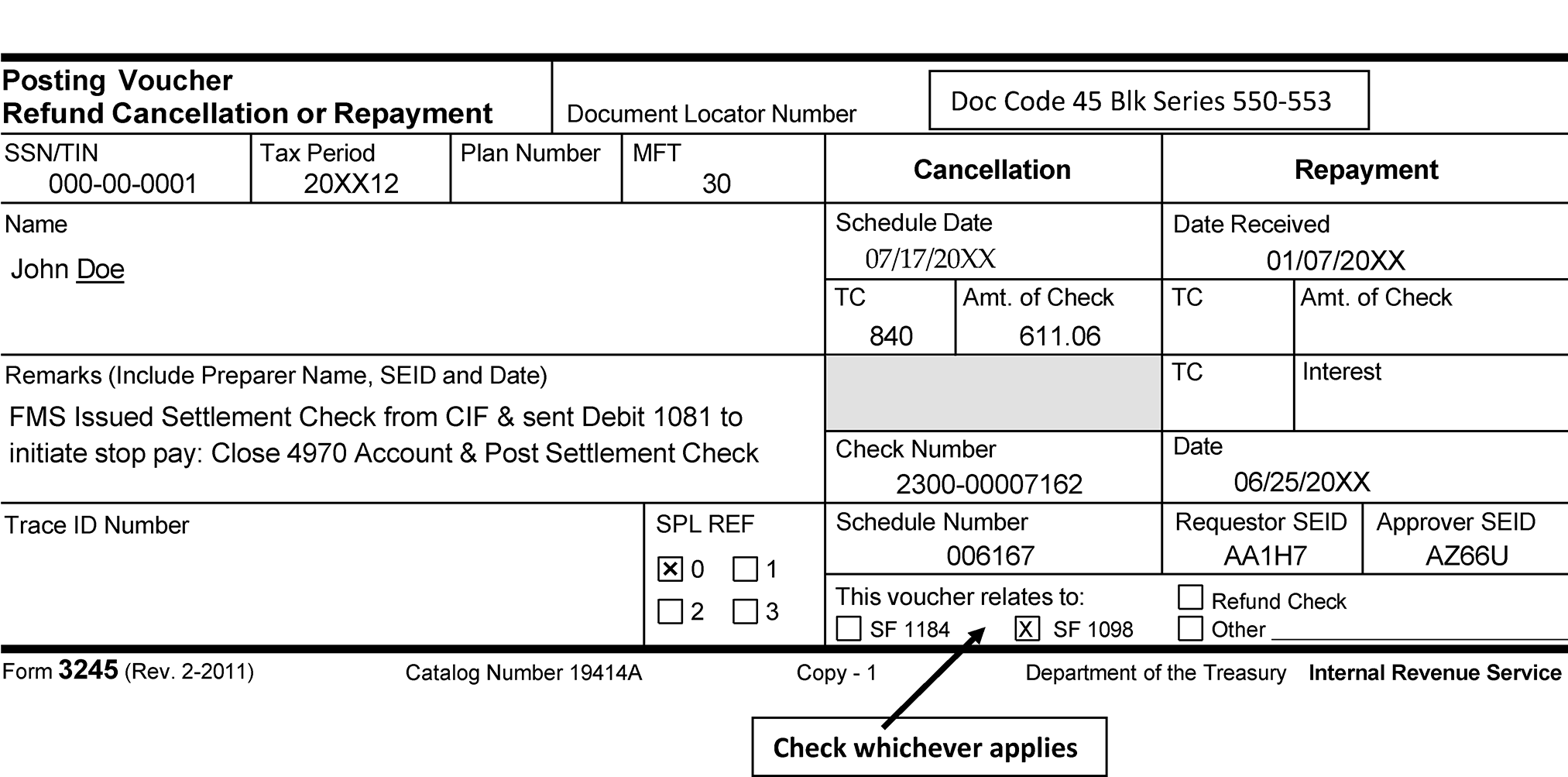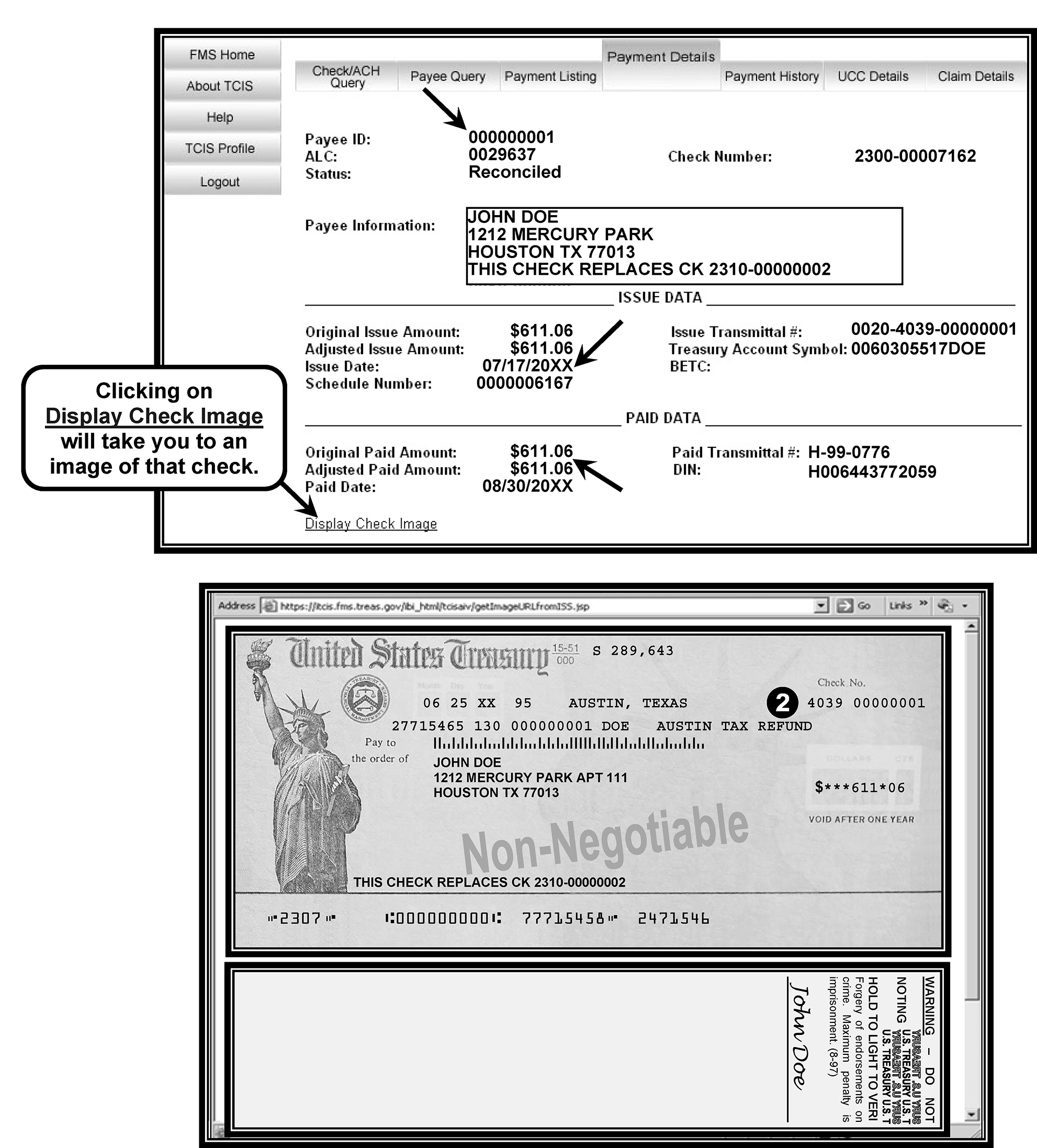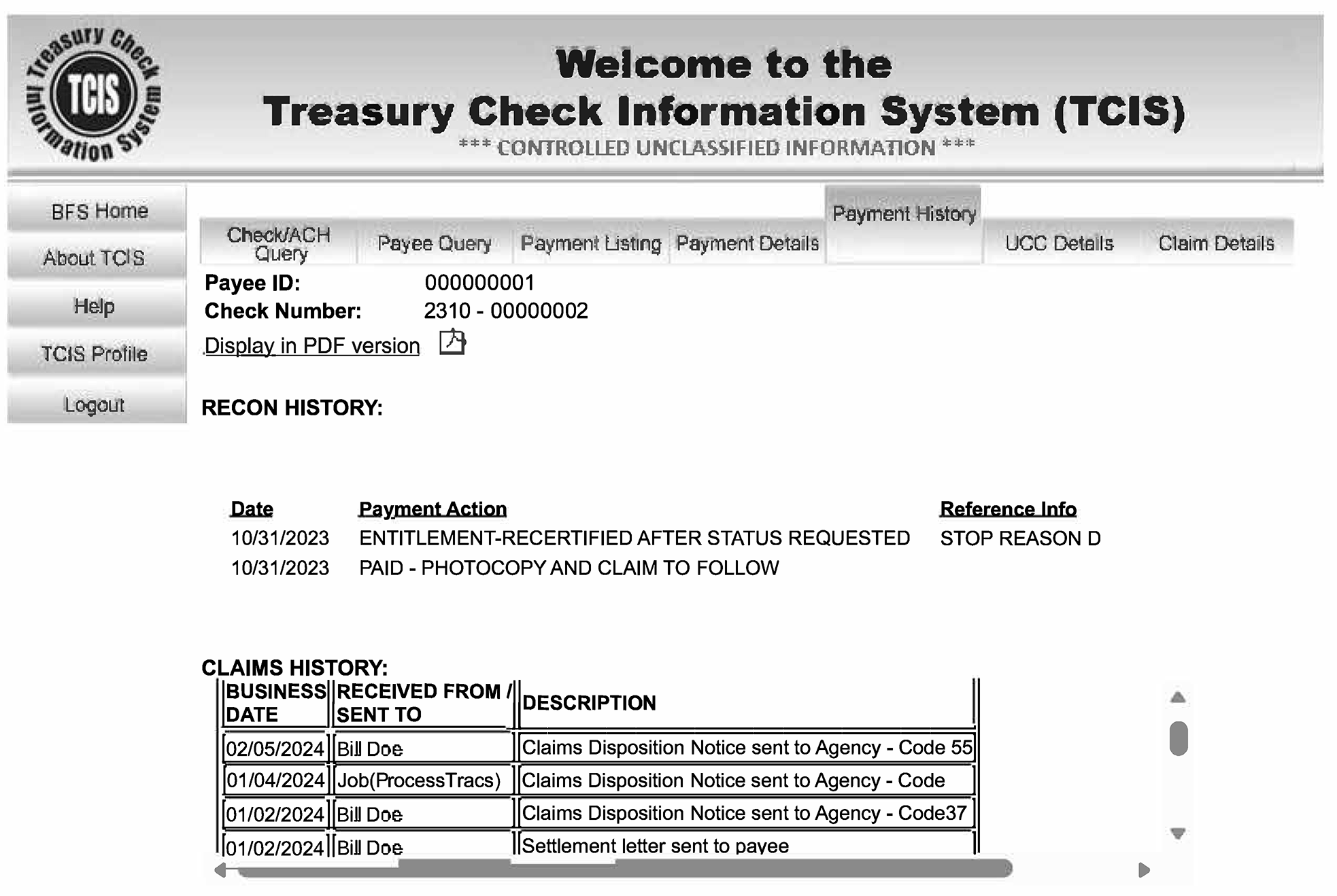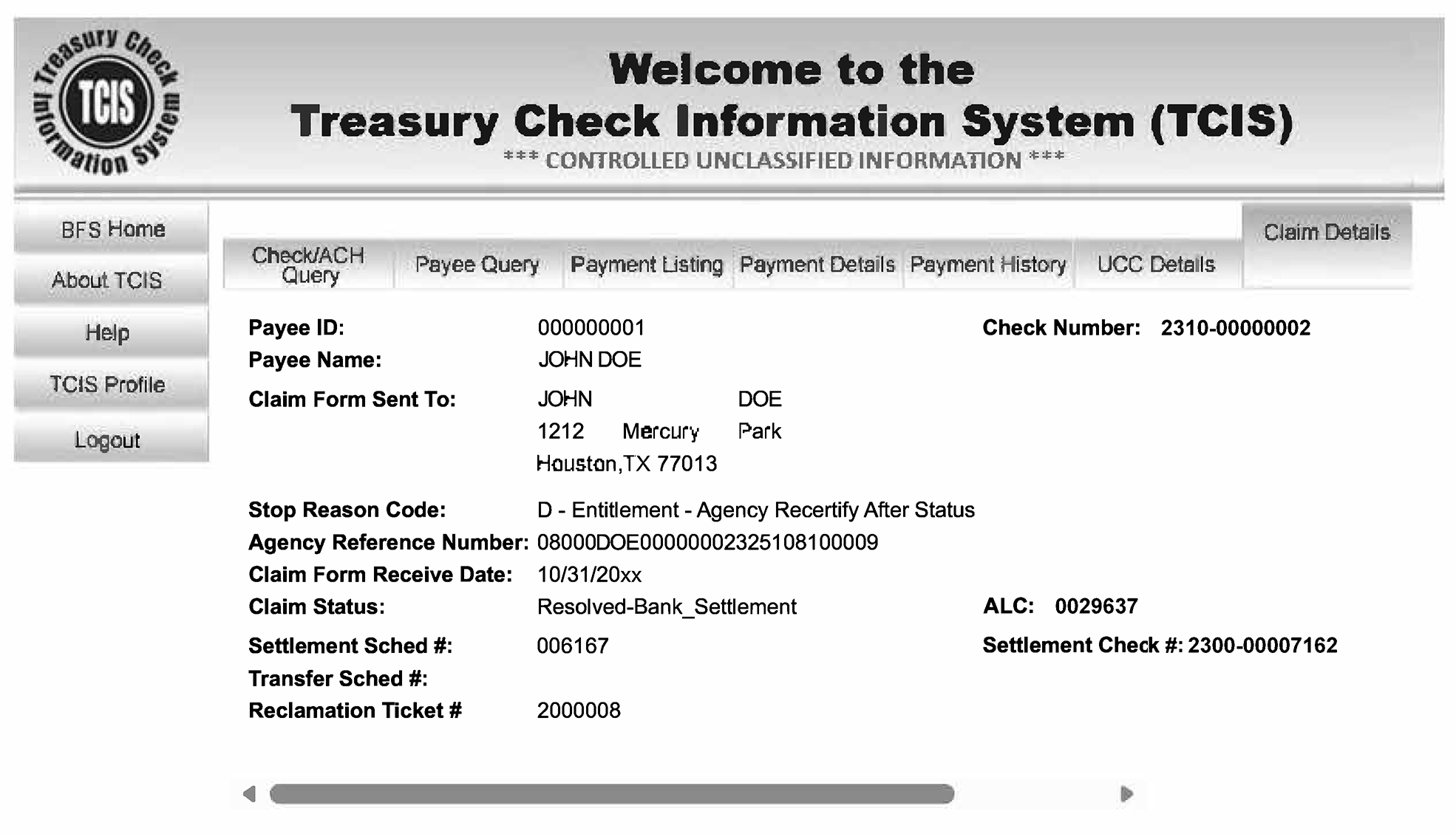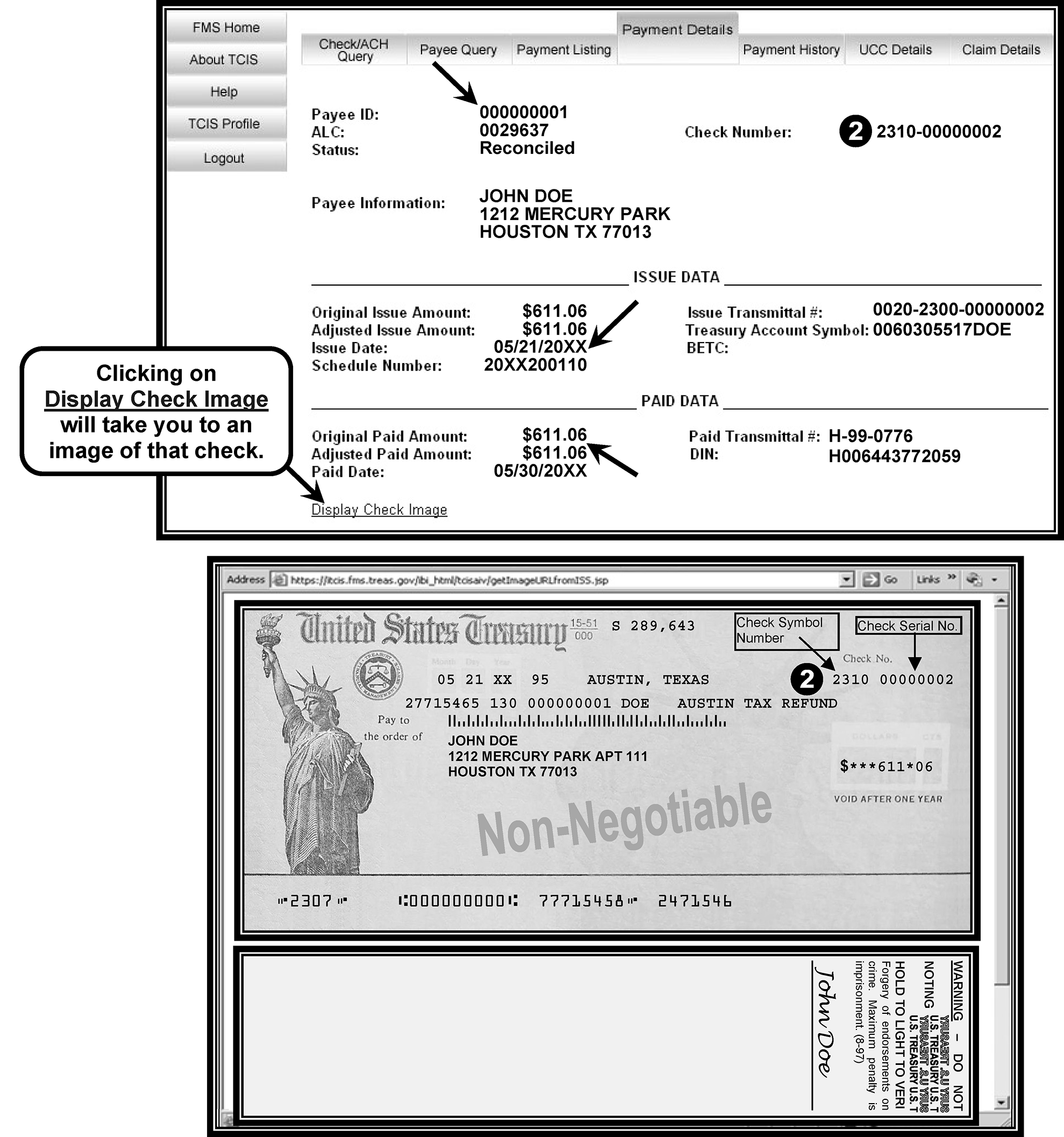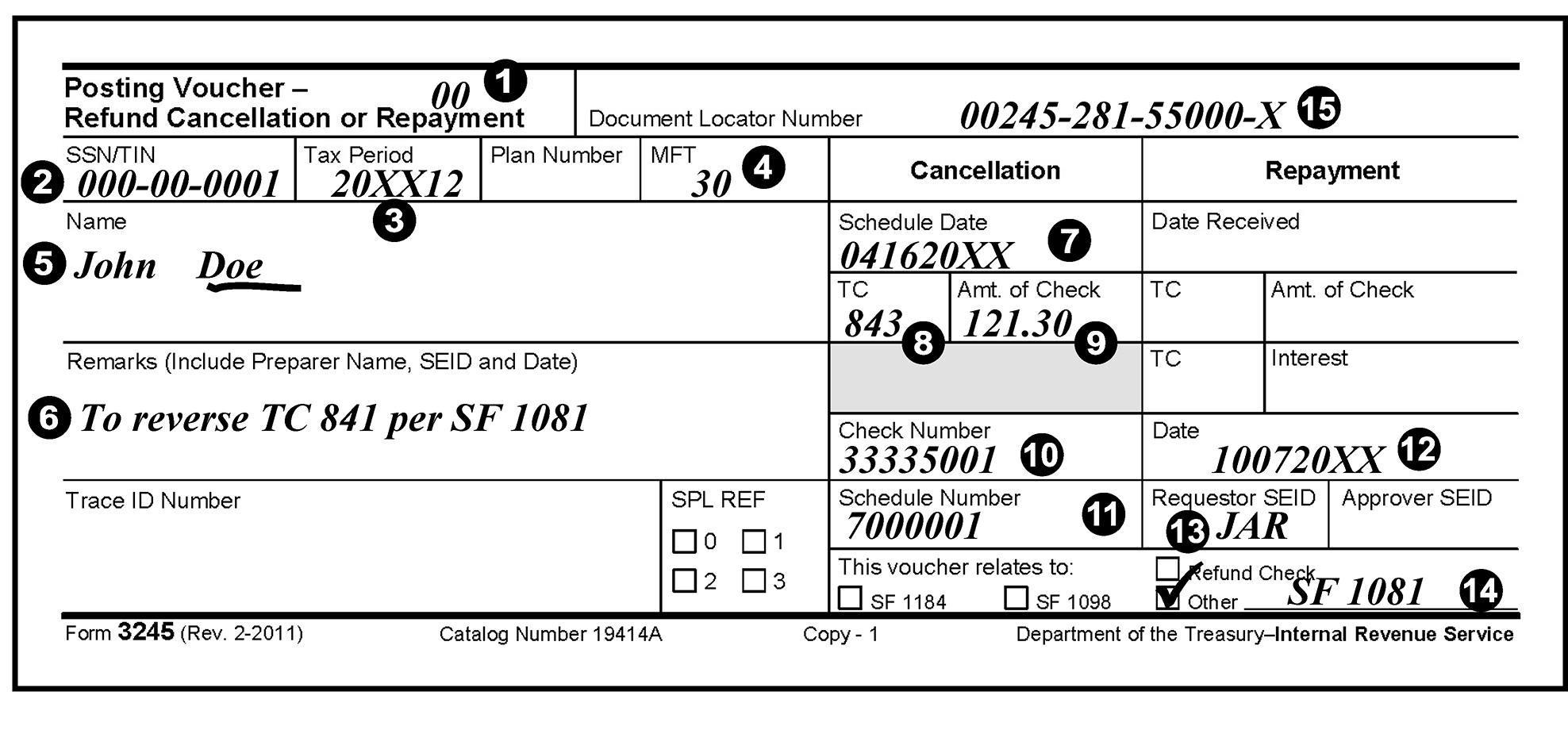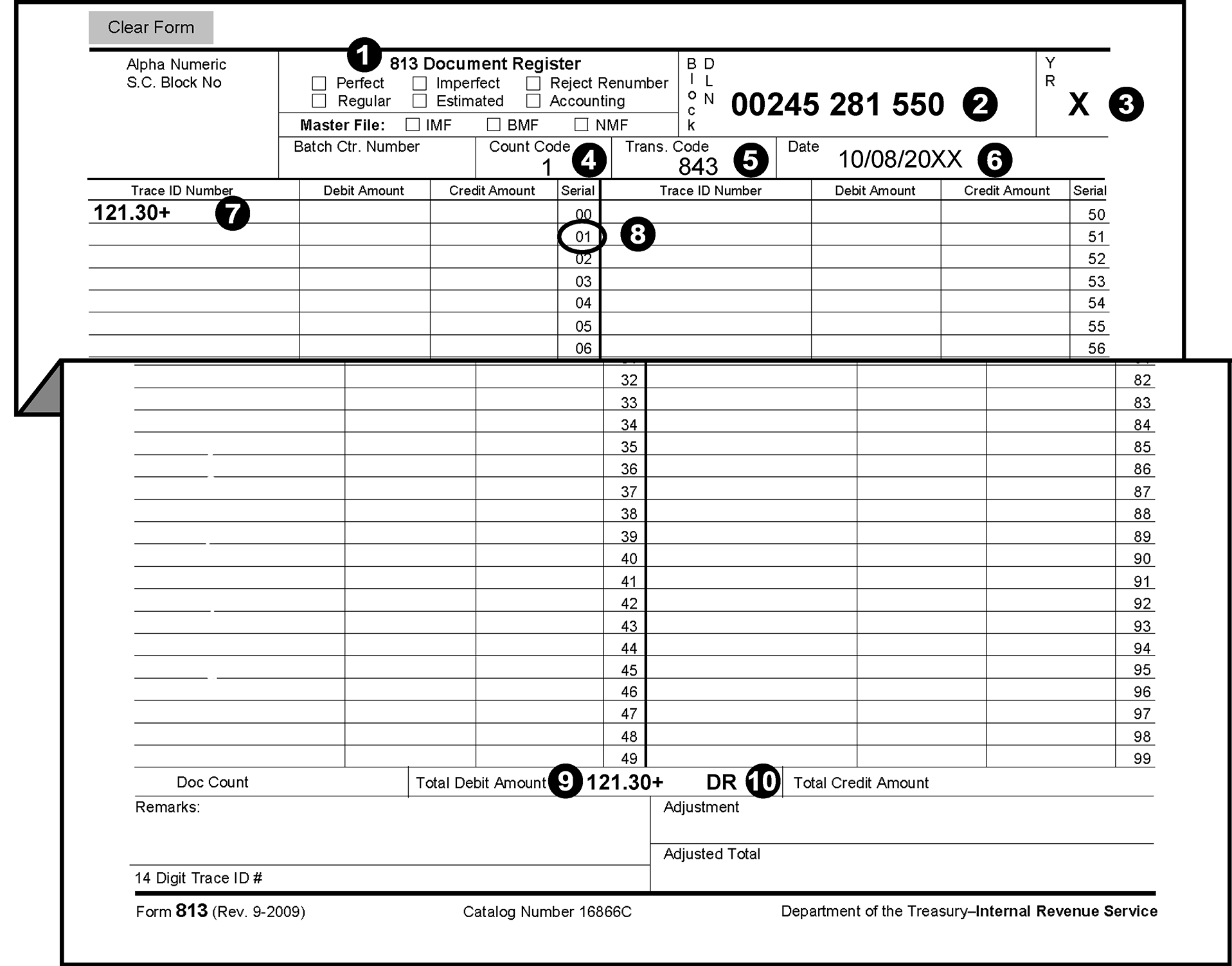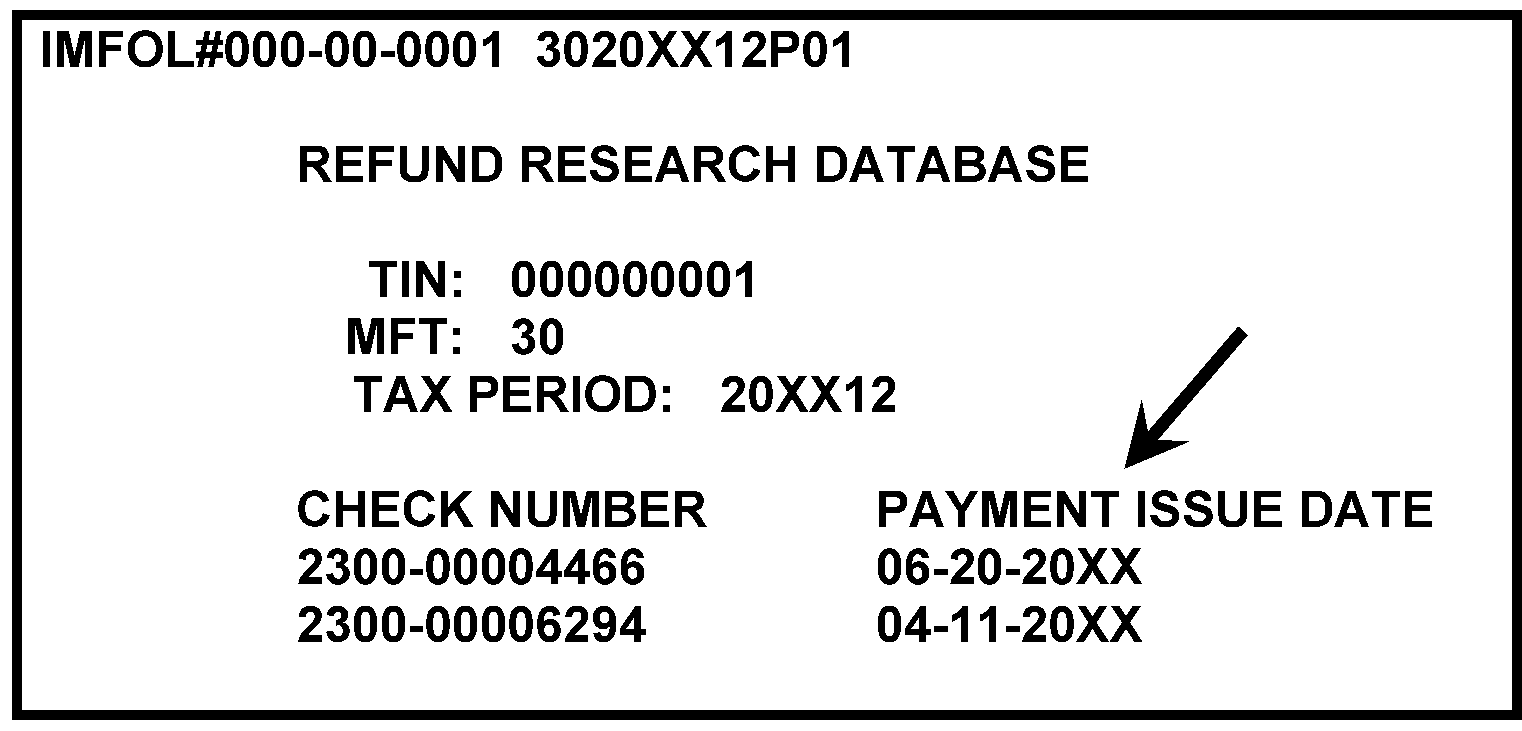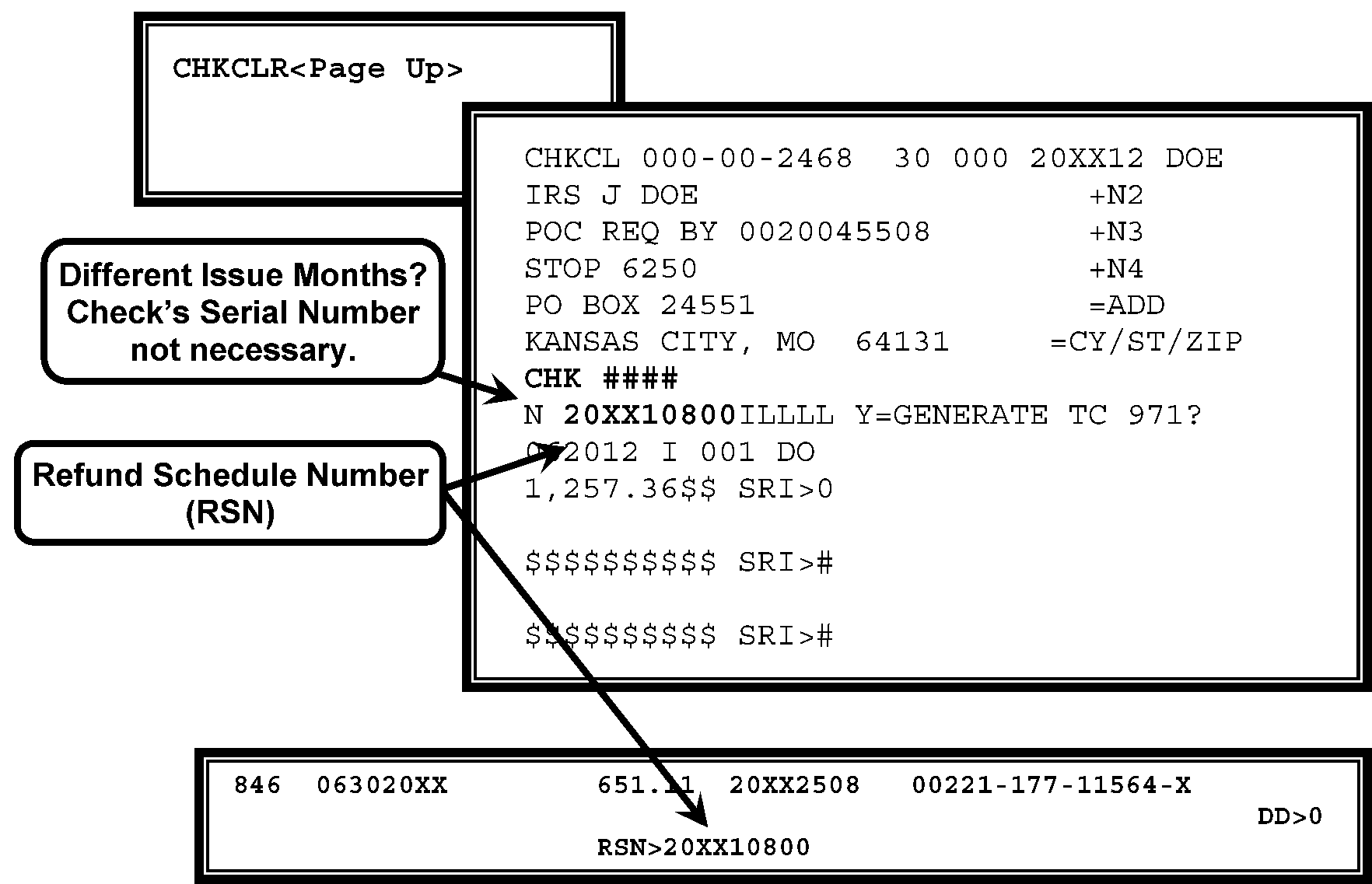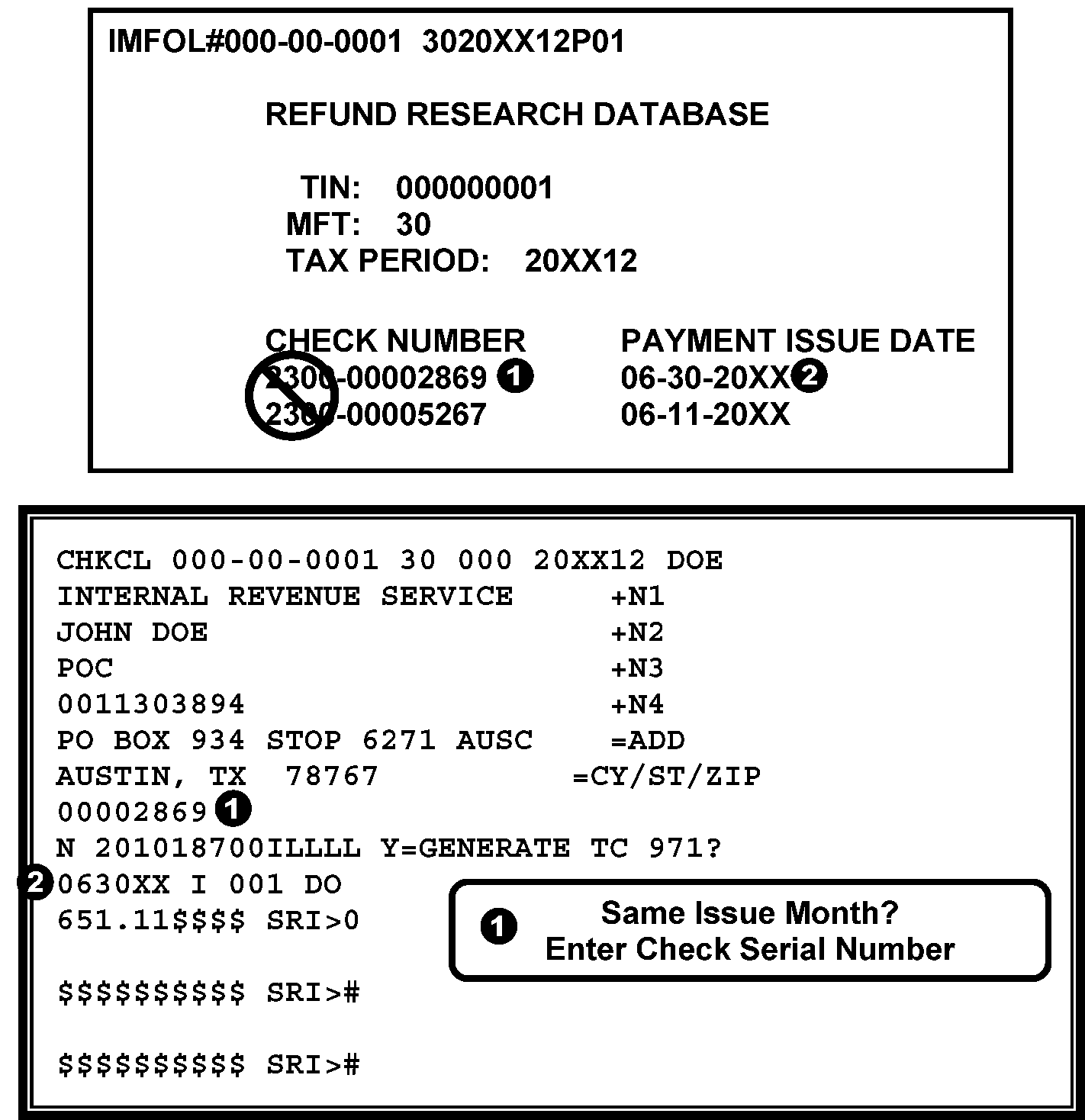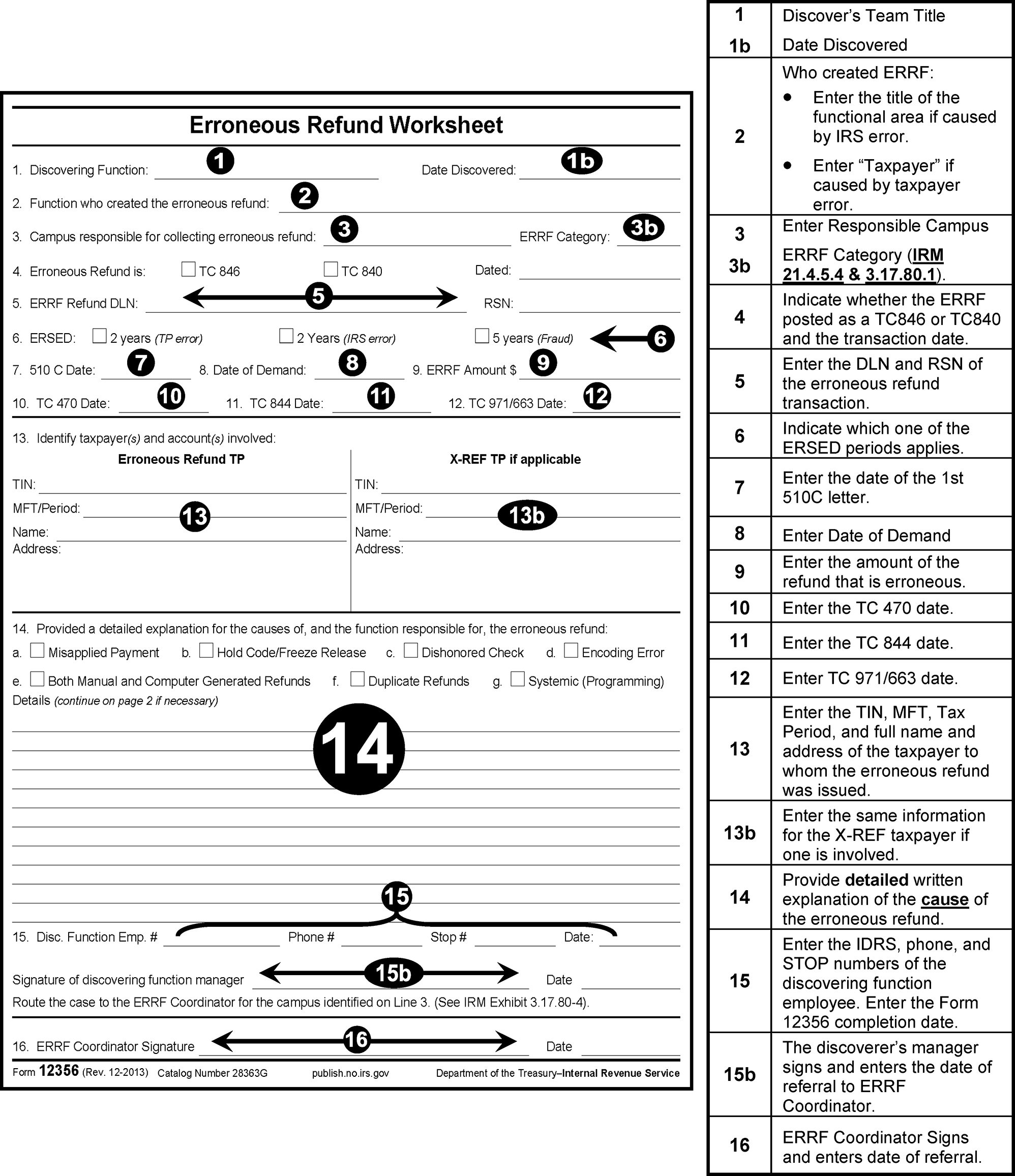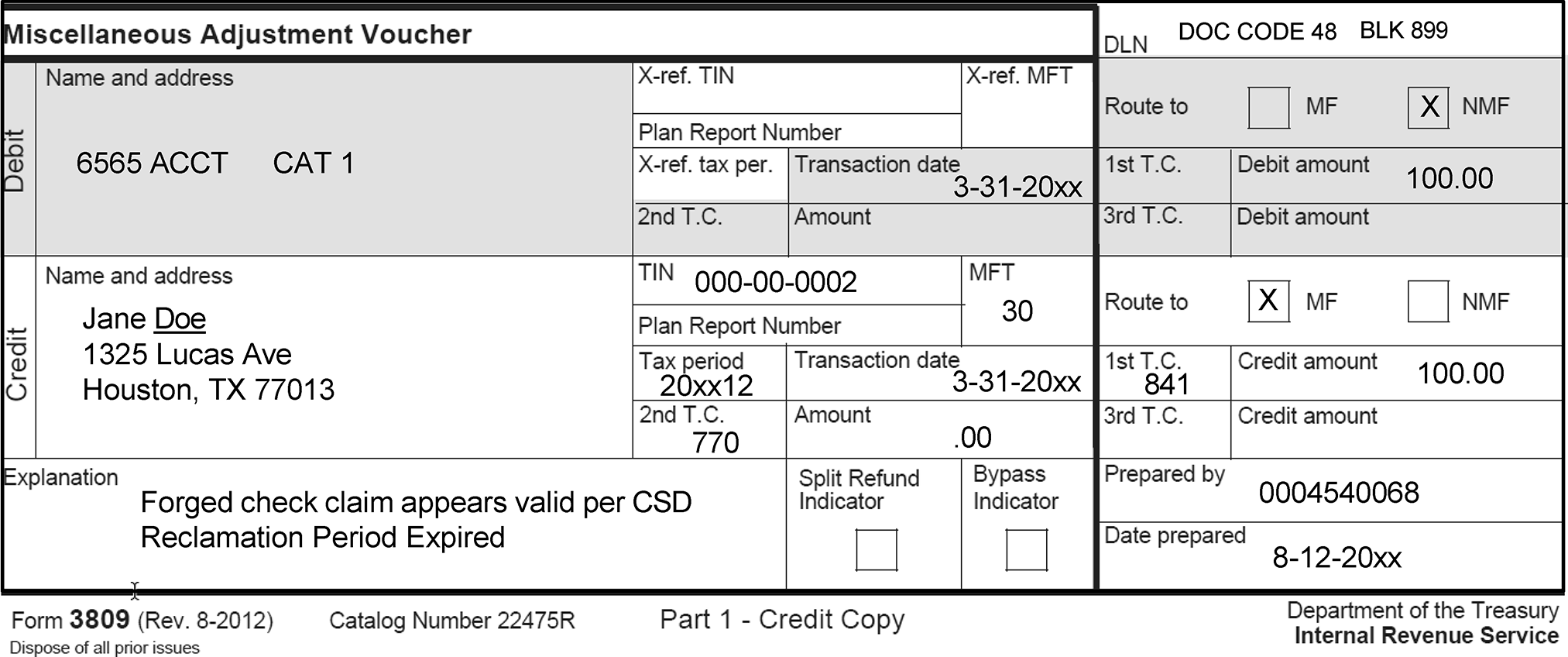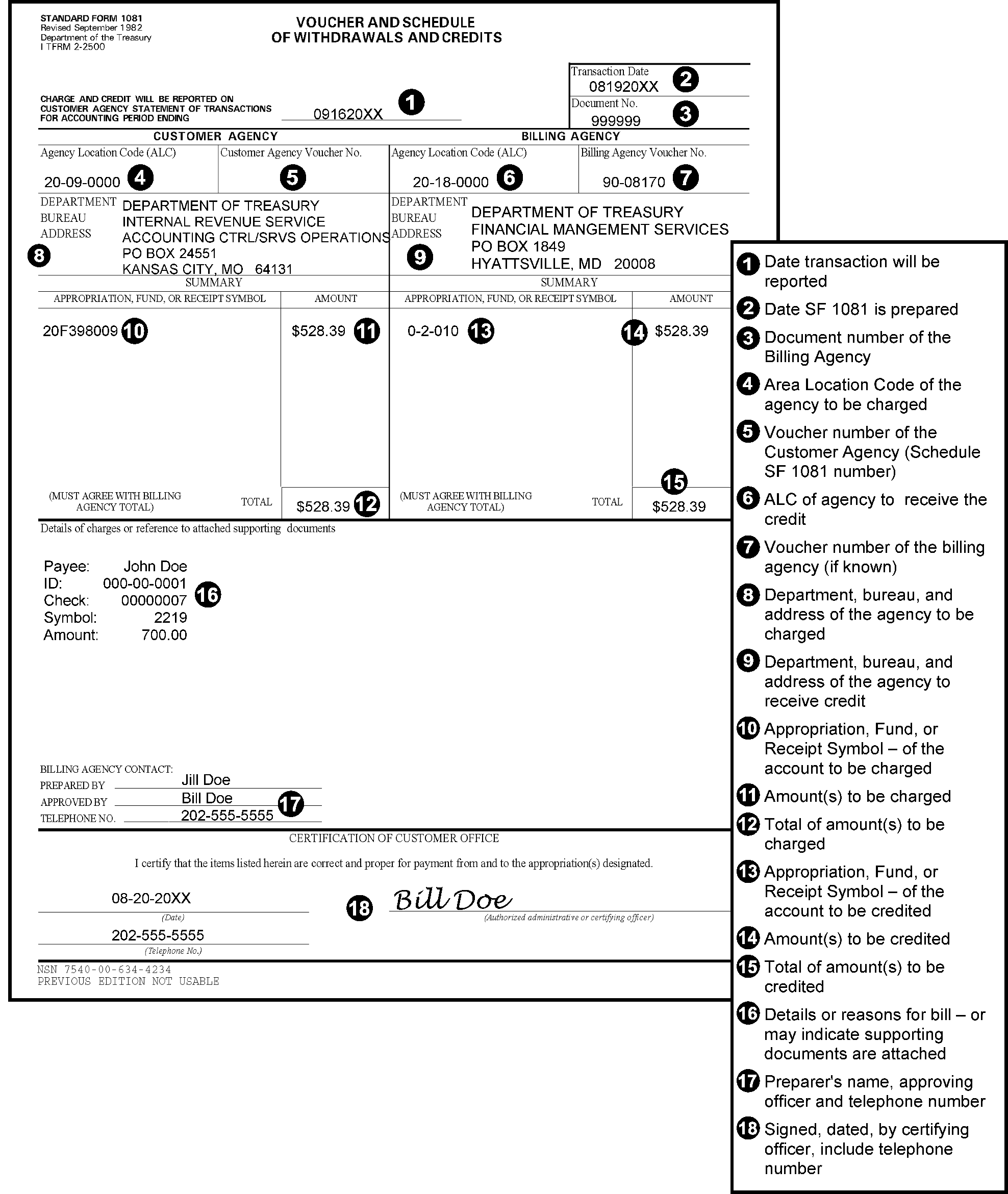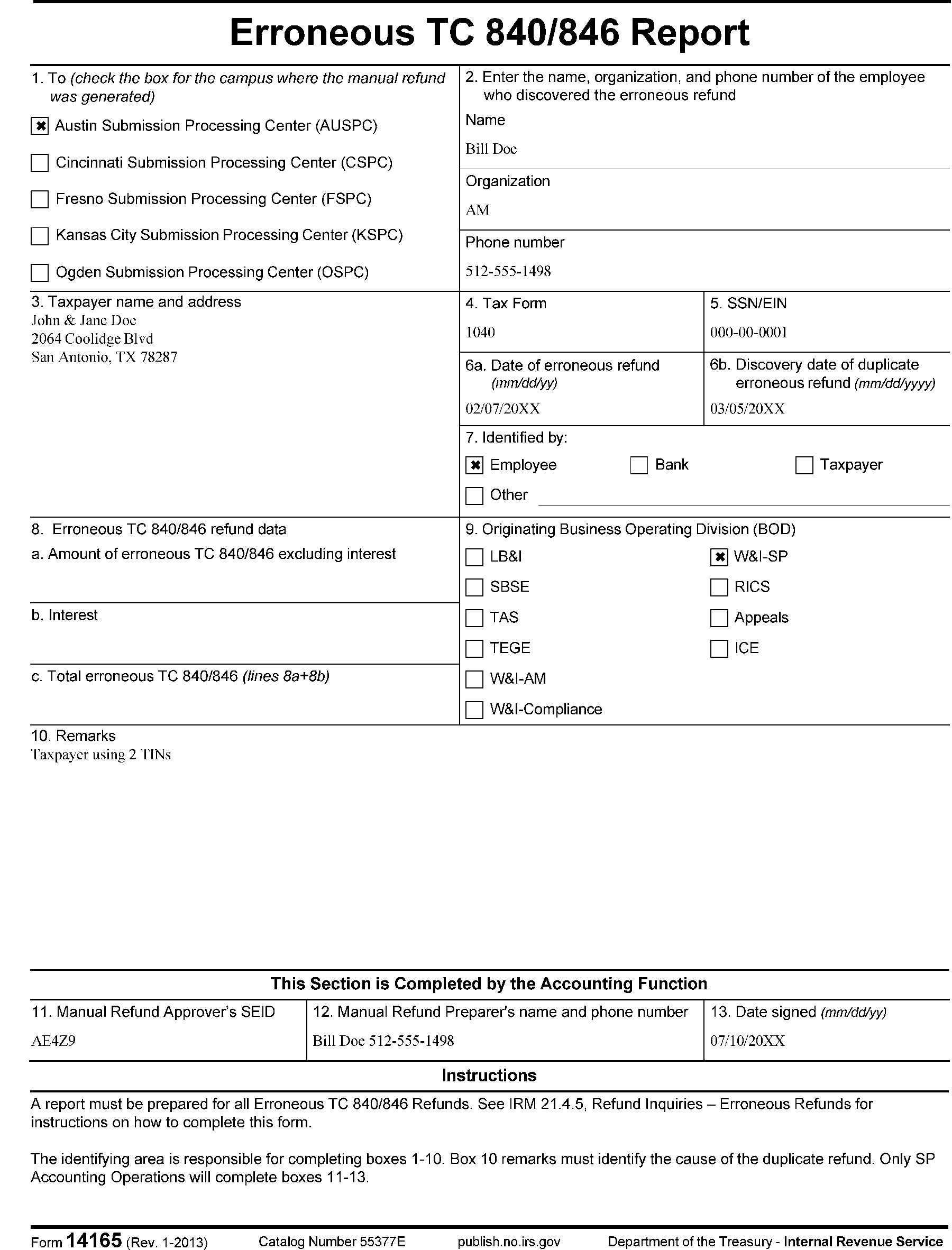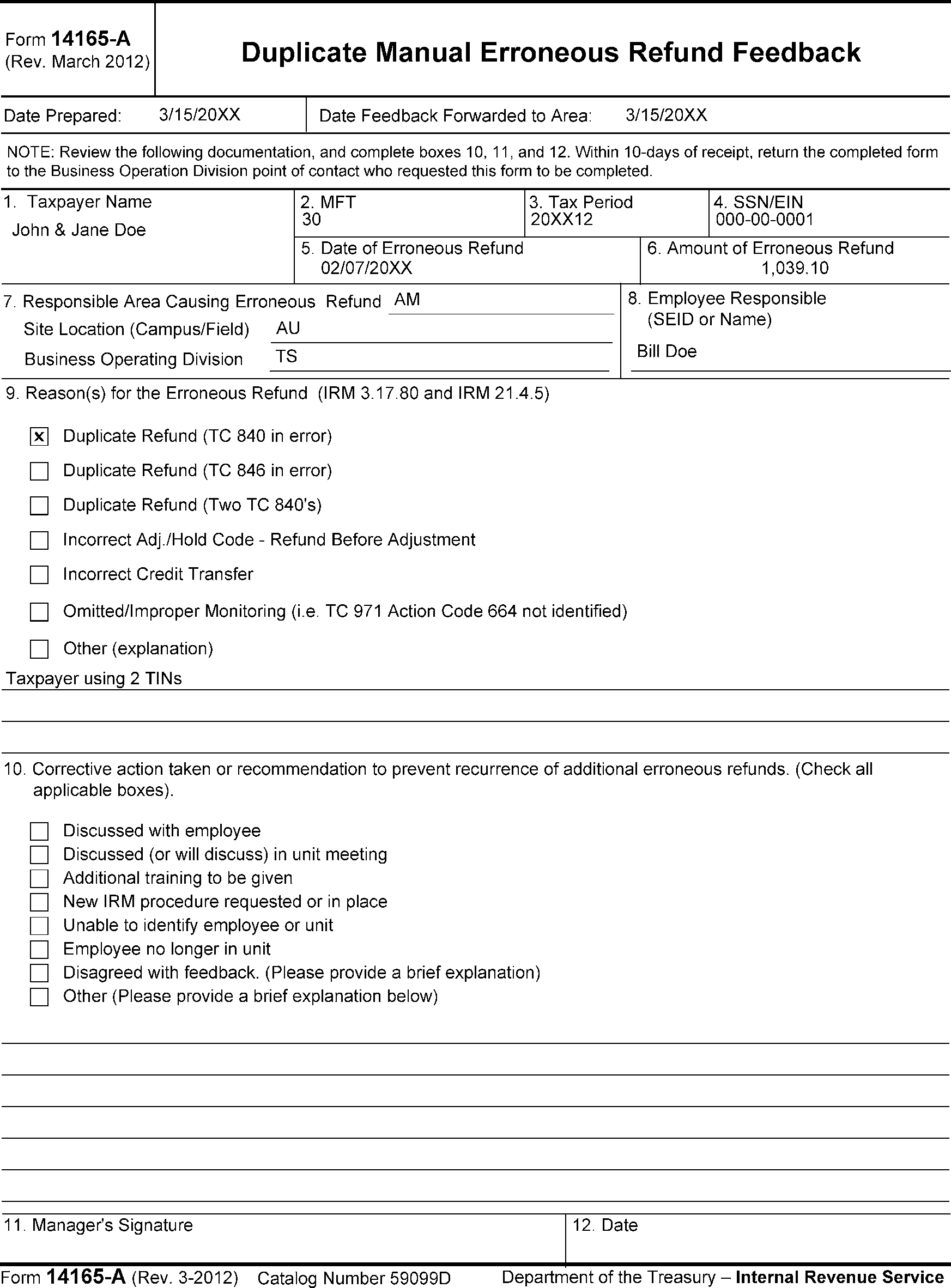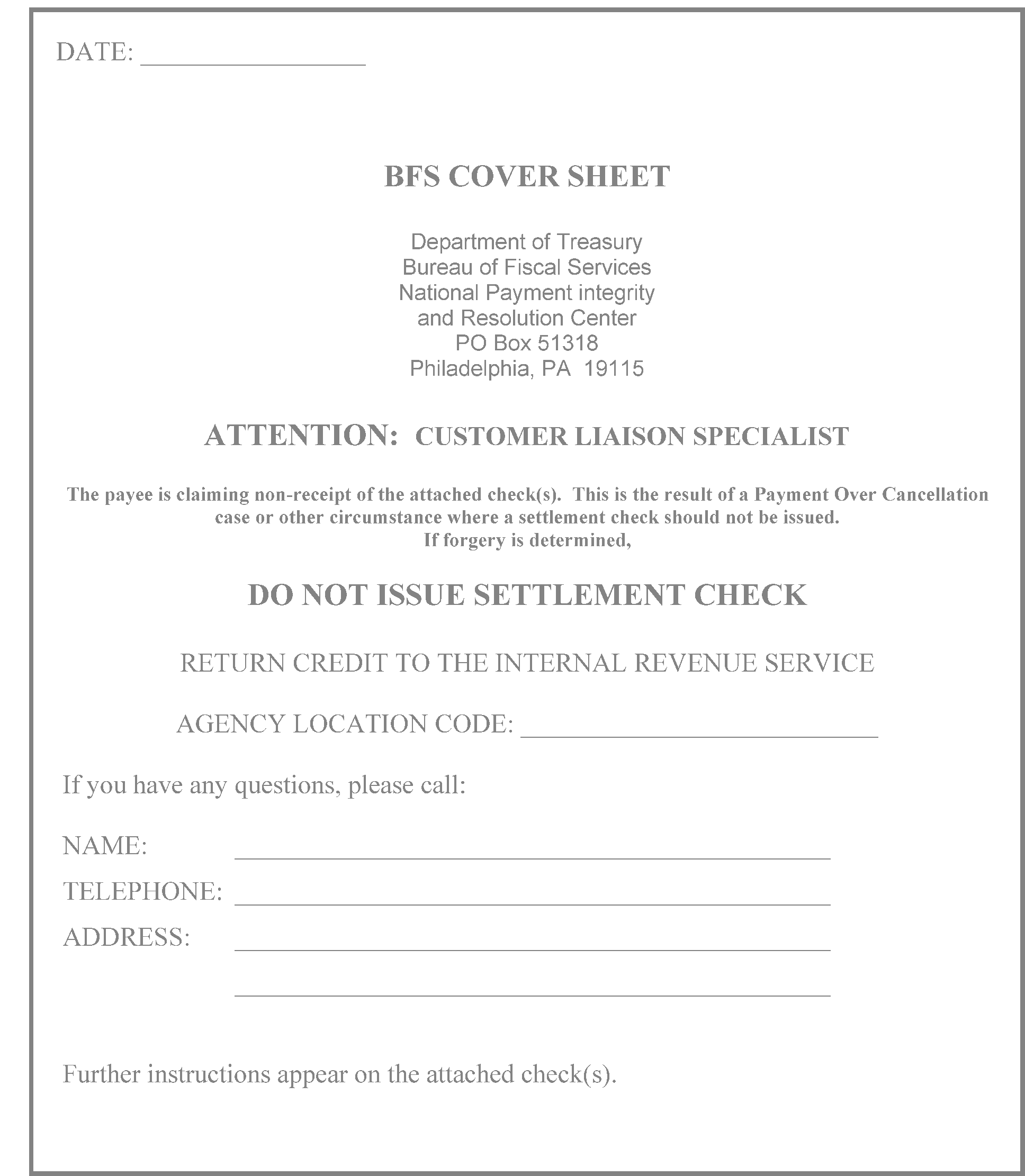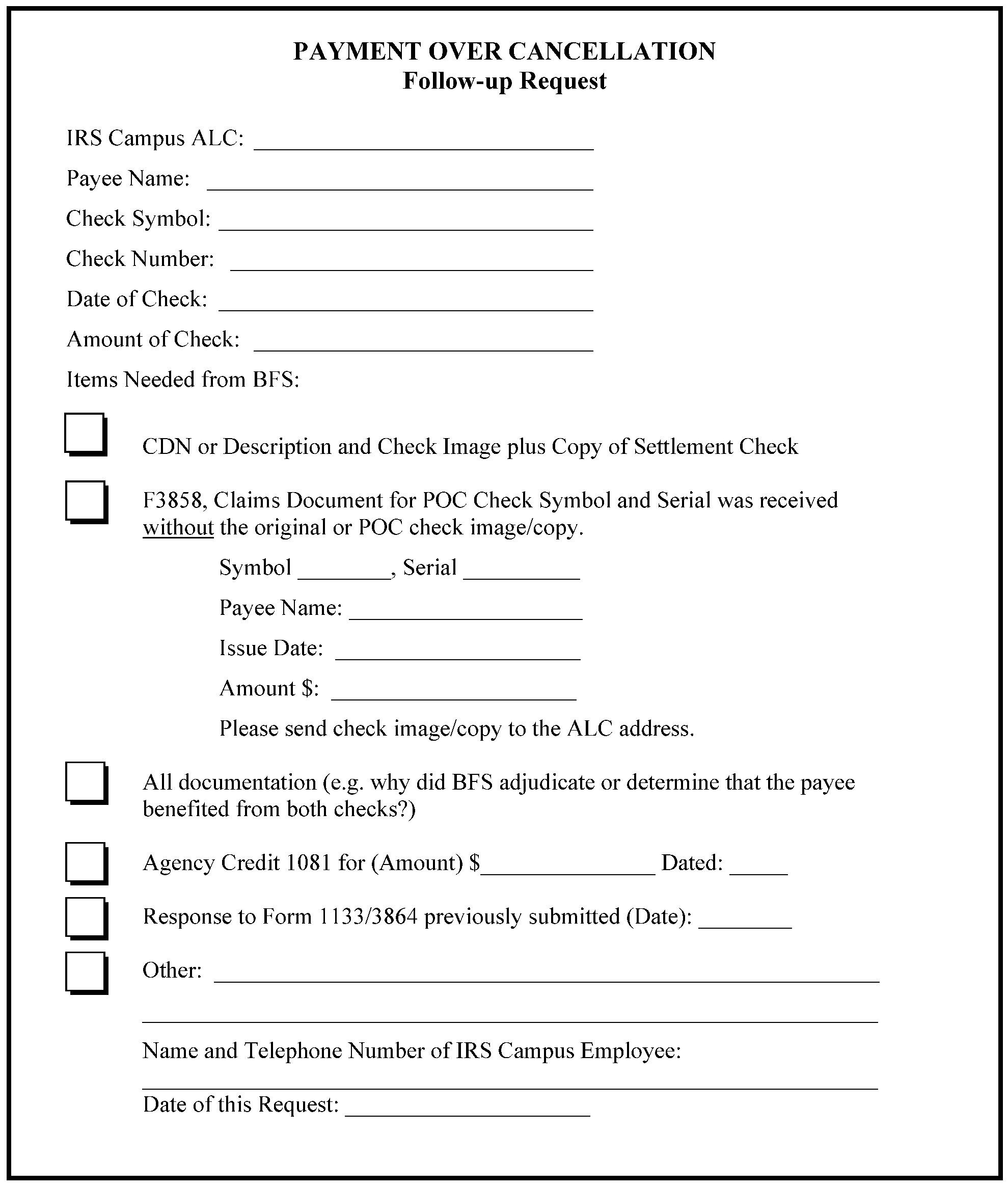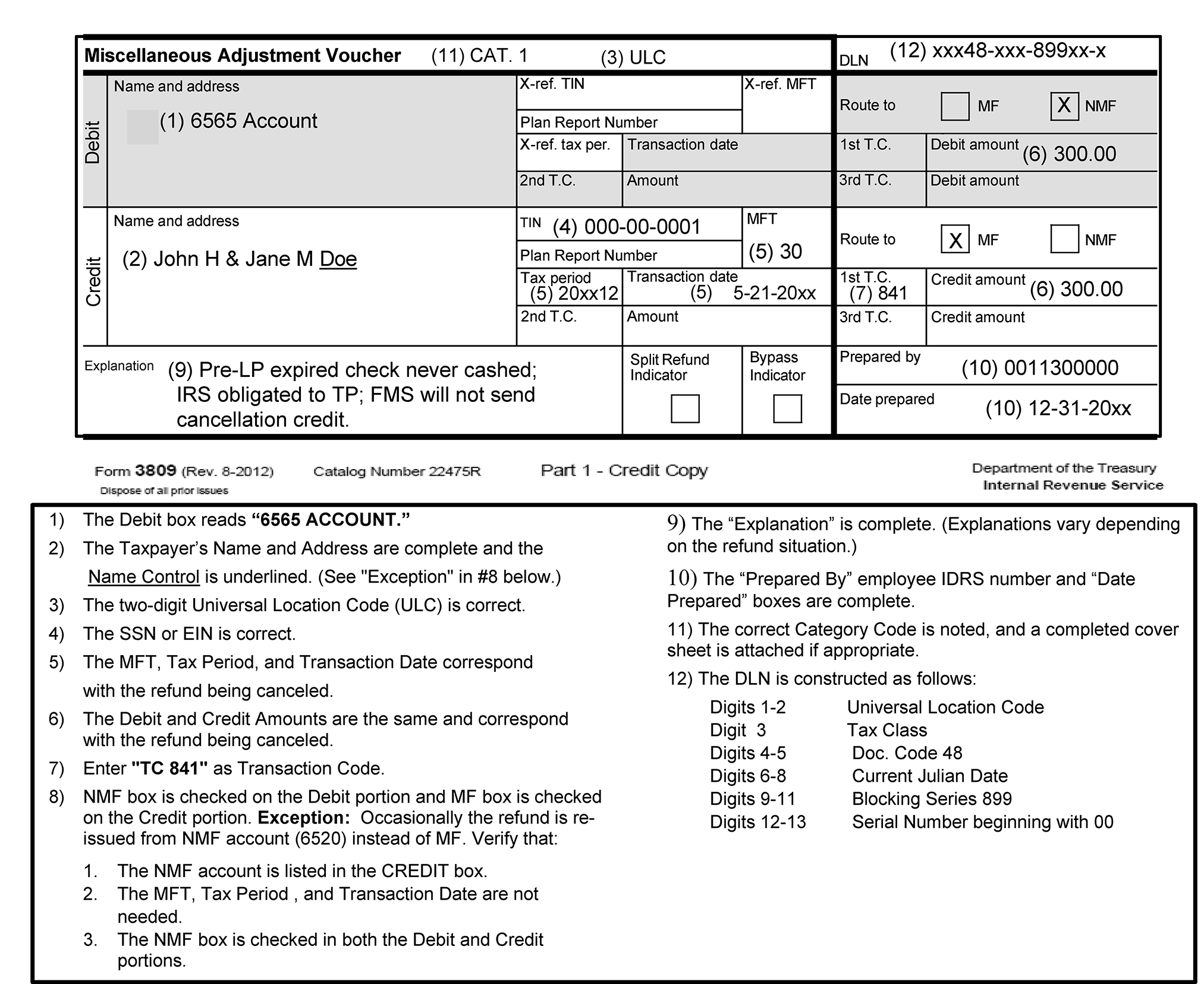- 3.17.80 Working and Monitoring Category D, Erroneous Refund Cases in Accounting Operations
- 3.17.80.1 Program Scope and Objectives
- 3.17.80.1.1 Background
- 3.17.80.1.2 Authority
- 3.17.80.1.3 Roles and Responsibilities
- 3.17.80.1.4 Program Management and Review
- 3.17.80.1.5 Program Controls
- 3.17.80.1.5.1 Program Reviews
- 3.17.80.1.5.2 Corrective Action Plan
- 3.17.80.1.5.3 Vulnerability Assessments
- 3.17.80.1.6 Terms and Acronyms
- 3.17.80.1.7 Related Resources
- 3.17.80.1.8 Accountability
- 3.17.80.1.9 Integrity
- 3.17.80.1.10 Technical Requirements
- 3.17.80.1.11 Statutory Requirements
- 3.17.80.1.12 Management and Congressional Needs
- 3.17.80.1.13 Annual Clearance of IRM
- 3.17.80.2 Recovering Category D, Erroneous Refunds
- 3.17.80.2.1 Taxpayer Advocate Service
- 3.17.80.2.2 General Overview and General Ledger Accounts for Erroneous Refunds
- 3.17.80.2.3 Account 1535 Court Case Erroneous Refund (Kansas City Only)
- 3.17.80.2.4 Interest Considerations
- 3.17.80.2.5 Methods Used to Recover Erroneous Refunds
- 3.17.80.2.5.1 Erroneous Refund Statute Considerations
- 3.17.80.2.5.2 Statutes Determined by Erroneous Refund Category Type
- 3.17.80.2.6 Category A1 or A2 Erroneous Refunds
- 3.17.80.2.6.1 Processing Categories A, B or C Erroneous Refunds
- 3.17.80.2.7 General Overview - Category D, Unassessable Erroneous Refunds
- 3.17.80.2.7.1 IDRS Case Control Base - ERRF
- 3.17.80.2.7.2 Accounting Operation Error Feedback
- 3.17.80.2.8 Recovering Erroneous Refunds with Additional Balance Due
- 3.17.80.2.8.1 Working Statute Imminent Cases
- 3.17.80.2.8.2 Taxpayer Returns Original Refund Check
- 3.17.80.2.8.3 Tax Refund Issued in Error
- 3.17.80.2.8.4 Taxpayer Repays in Full
- 3.17.80.2.8.5 Processing Partial Repayments
- 3.17.80.2.8.6 Statute Barred Refunds
- 3.17.80.2.8.7 Hardship Manual Refund Request
- 3.17.80.2.9 Transferring Refunds Erroneously Posted (For Information Only - Accounts Management Procedures)
- 3.17.80.2.10 Maintaining and Monitoring Case Files - Accounting (ACO) ERRF Monitoring Tool
- 3.17.80.2.10.1 Maintaining Paper Case Files
- 3.17.80.2.10.2 Maintaining Electronic Case Files On SharePoint
- 3.17.80.2.10.3 Maintaining Case Files (Cases ≡ ≡ ≡ ≡ ≡ ≡ or Less Only)
- 3.17.80.2.11 Refund Cancellation, Repayments and Replies to Correspondence
- 3.17.80.2.12 Replies to Form 2209 Cases from Collection Field Function
- 3.17.80.2.13 Processing 844 Transcripts (TRANS-844) (-U Freeze)
- 3.17.80.2.14 Dishonored Check Erroneous Refund Repayments
- 3.17.80.2.15 Erroneous Refund Repayments After the ERSED Has Expired
- 3.17.80.2.16 Treasury Offset Program (TOP) Erroneous Refund Cases
- 3.17.80.2.17 Write-Off Procedures - Disbursement Loss 4910 Account for Unrecoverable Erroneous Refunds (for General Ledger Account Types 1530, 1535, 1540, 1543)
- 3.17.80.2.18 Form 1099 - Unrecoverable Unassessable Erroneous Refunds
- 3.17.80.2.19 Forms 1099 MISC. and Whistleblower Activities (Ogden Only)
- 3.17.80.2.20 Researching and Resolving Undeliverable Forms 1099-C
- 3.17.80.2.21 Release Claim Form Secured by Secret Service
- 3.17.80.2.22 Transferring Category D, Unassessable Erroneous Refund Cases
- 3.17.80.3 Resolving Unpostable Identity Theft (IDT) Cases
- 3.17.80.3.1 Resolving Unpostable Identity Theft Cases Processed as Erroneous Refunds
- 3.17.80.3.2 Resolving Cases with TC 841 Posted
- 3.17.80.3.3 Resolving Unpostables on Identity Theft Cases Processed by Another Site
- 3.17.80.3.4 Resolving Cases with a TC 700 Posted
- 3.17.80.3.5 Resolving Unpostable Identity Theft Cases Where the TC 840 or TC 849 Has Been Transferred to Another SSN or an IRSN
- 3.17.80.3.6 Resolving Unpostable Identity Theft Cases Where There is Duplicate TC 841
- 3.17.80.3.7 Duplicate Identity Theft (IDT) TC 841 or TC 700 Posting Identified by Originators
- 3.17.80.3.8 Duplicate Identity Theft (IDT) TC 700 Posting Identified by Accounting
- 3.17.80.3.9 Identity Theft Actions to be Taken by the Erroneous Refund Team
- 3.17.80.3.10 Actions to be Taken by the RACS Team
- 3.17.80.4 Identity Theft (IDT) Erroneous Refunds Forms 3809
- 3.17.80.4.1 Processing the Non-Master File (NMF) Receipts
- 3.17.80.4.2 Maintaining the Receipts
- 3.17.80.4.3 Inventory Control
- 3.17.80.4.4 Monthly Balancing Procedures
- 3.17.80.5 Cancelled Refund Checks (Standard Form or SF-1098)
- 3.17.80.5.1 Treasury Checks Returned to the Submission Processing Center and Regional Financial Center
- 3.17.80.5.2 Processing Intercepted Refund Checks (Reason for Return Code 01)
- 3.17.80.5.3 Returned Check Cancellations - Manually Prepared Individual Master File (IMF) and Business Master File (BMF) (RRCs 02 and 03)
- 3.17.80.5.4 Processing Returned Automated Non-Master File (ANMF) Checks
- 3.17.80.5.5 Returned Individual Retirement Account File (IRAF) Checks
- 3.17.80.5.6 Correcting Erroneously Posted Transaction Code (TC) 841
- 3.17.80.5.7 Incorrect Cancellation Amounts
- 3.17.80.6 Undeliverable Refund Check (Transaction Code (TC) 740, S- Freeze) Cancellations
- 3.17.80.6.1 Undeliverable Enterprise Computing Center - (ECC-MTB) for Code 02/TC 846) Individual Master File (IMF)/Business Master File (BMF) Refund Check Cancellations
- 3.17.80.6.2 Undeliverable Integrated Data Retrieval System (IDRS) Generated Refunds
- 3.17.80.6.3 Unpostable Cases Received from Rejects/Refund Inquiry
- 3.17.80.7 Treasury's Receivable Accounting and Collection System (TRACS)
- 3.17.80.7.1 Background - Competitive Equality Banking Act of 1987, Public Law 100–86
- 3.17.80.7.2 Processing Reclamation Credits (REC)
- 3.17.80.7.3 Processing Unavailable Check Cancellation Credits (UCC)
- 3.17.80.7.4 Processing Limited Payability Cancellations (LPC)
- 3.17.80.7.5 Miscellaneous Treasury Receivable, Accounting, and Collection System (TRACS) Listing
- 3.17.80.8 Processing Payments Over Cancellation (POC) - Preliminary Processes before an Erroneous Refund
- 3.17.80.8.1 TRACS Listing Research
- 3.17.80.8.2 Processing SF 1081 or TRACS Debits
- 3.17.80.8.3 Processing Debits, SF 1081, or TRACS Credit
- 3.17.80.8.3.1 Corrected SF 1081
- 3.17.80.8.4 BFS Form 3858 - "GOALS" Automated Payments Over Cancellation
- 3.17.80.8.4.1 Limited Payability
- 3.17.80.8.4.2 Undeliverable or No Taxpayer Reply
- 3.17.80.8.4.3 Payment Over Cancellation - Taxpayer Repayments and Replies to Correspondence
- 3.17.80.8.4.4 Bureau of the Fiscal Service (BFS) Determinations
- 3.17.80.8.4.5 Monitor Case for Credits
- 3.17.80.8.5 SF 1081 Debits Other Than Status 61 and 65
- 3.17.80.8.6 Refund Repayments Made to Check Claims Group
- 3.17.80.8.7 Erroneous Payments Made by Regional Financial Centers
- 3.17.80.9 Maintaining Account 6565, Processing and Monthly Balancing Routine
- 3.17.80.10 Miscellaneous Reports - Monthly Reporting of Accounting Receipts and Error Feedback for Category D Erroneous Refunds
- 3.17.80.10.1 Monthly Reporting of Accounting Error Feedback for Duplicate, Manual Erroneous Refunds (DMER)
- 3.17.80.10.2 Monthly Review and Reporting of the Erroneous Refund General Ledger RRACS 0131 and 0156 Report Listings
- 3.17.80.10.3 Quarterly Review of the Erroneous Refund General Ledger 0131 and 0156 Report Listings
- 3.17.80.11 Return Preparer Misconduct Erroneous Refunds (Kansas City)
- 3.17.80.11.1 Processing the Receipt
- 3.17.80.11.2 Maintaining the Receipts
- 3.17.80.11.3 Inventory Control
- 3.17.80.11.4 Monthly Balancing Procedures
- Exhibit 3.17.80-1 Erroneous Refund Interest Considerations
- Exhibit 3.17.80-2 If/Then Flow Chart for Erroneous Refund Identification
- Exhibit 3.17.80-3 Erroneous Refund Accounts 1530, 1535, 1540, 1543
- Exhibit 3.17.80-4 Erroneous Refund Coordinators
- Exhibit 3.17.80-5 Regional Financial Centers
- Exhibit 3.17.80-6 Blocking Series Chart for Document Code 45, for Miscellaneous Processing (SF 1098, 1081, TRACS and ID-Theft Processing)
- Exhibit 3.17.80-7 Blocking Series Chart for Document Code 45, Forms 3753 (Manual Refund Posting Voucher)
- Exhibit 3.17.80-8 BFS Treasury Receivable Accounting, and Collection System Contact List
- Exhibit 3.17.80-9 Reason For Cancellation Codes (SF 1098) Paper Checks and Electronic Funds Transfer (EFT)
- Exhibit 3.17.80-10 BFS Coversheet - Do Not issue Settlement Check
- Exhibit 3.17.80-11 Form 3809 Miscellaneous Adjustment Voucher
- Exhibit 3.17.80-12 Erroneous Refund Case History Sheet
- Exhibit 3.17.80-13 Unassessable Erroneous Refund (five year) Check Sheet
- Exhibit 3.17.80-14 2019 Enterprise Computing Center (Posting Cycles)
- Exhibit 3.17.80-15 Business Operating Division (BOD) Points of Contact (POC’s) for Duplicate, Manual, Erroneous Refund Feedback, Form 14165-A, and Erroneous Refund Form 12356
- Exhibit 3.17.80-16 Treasury Check Information System (TCIS) Query Display - 1
- Exhibit 3.17.80-17 Treasury Check Information System (TCIS) Query Display - 2
- Exhibit 3.17.80-18 Acronyms
- Exhibit 3.17.80-19 Identity Theft Write-Off Cover Memorandum
- Exhibit 3.17.80-20 Administrative Disbursement Loss Relief Request Checklist
- Exhibit 3.17.80-21 Control-D Overage Report (CCA4243)
- Exhibit 3.17.80-22 Accounting Operation Error Feedback Form
- Exhibit 3.17.80-23 Balance Sheet
- Exhibit 3.17.80-24 Cause of Erroneous Refunds
- Exhibit 3.17.80-25 CC UPTIN Unpostable Display
- Exhibit 3.17.80-26 Erroneous Refund Write-Off Cover Memorandum for Administrative Resolution
- Exhibit 3.17.80-27 Sample Case Listing for Administrative Resolution of Erroneous Refund Losses
- Exhibit 3.17.80-28 IAT Accounting Erroneous Refund Monitoring Tool
- Exhibit 3.17.80-29 COMPAD Multiple Payments Full Paid
- Exhibit 3.17.80-30 COMPAD Multiple Payments Balance Due
- 3.17.80.1 Program Scope and Objectives
Part 3. Submission Processing
Chapter 17. Accounting and Data Control
Section 80. Working and Monitoring Category D, Erroneous Refund Cases in Accounting Operations
3.17.80 Working and Monitoring Category D, Erroneous Refund Cases in Accounting Operations
Manual Transmittal
December 11, 2025
Purpose
(1) This transmits revised IRM 3.17.80, Accounting and Data Control, Working and Monitoring Category D, Erroneous Refund Cases in Accounting Operations.
Material Changes
(1) IRM 3.17.80.1.20(11), Interest Considerations - IPU 25U0082 issued 01-21-2025, Updated the instructions for expired ERSED offset, moved information to subsection IRM 3.17.80.2.4.
(2) IRM 3.17.80.1.22.1, Processing Categories A, B or C Erroneous Refunds - IPU 25U0082 issued 01-21-2025, Updated Form 3809 Figure 3.17.80-4 example, moved information to subsection IRM 3.17.80.2.6.1.
(3) IRM 3.17.80.1.26(1), Maintaining Paper Case Files - IPU 25U0082 issued 01-21-2025, Updated instructions for paper case files, moved information to subsection IRM 3.17.80.2.10.1.
(4) IRM 3.17.80.1.26.1(1) Note, (2), (4) & (16), Maintaining Electronic Case Files On SharePoint - IPU 25U0082 issued 01-21-2025, Updated instructions for electronic case files, moved information to subsection IRM 3.17.80.2.10.2.
(5) IRM 3.17.80.1.26.2, Maintaining Case Files (Cases ≡ ≡ ≡ ≡ ≡ ≡ or Less Only) - Moved information to subsection IRM 3.17.80.2.10.3(1) c, added reference to the new ACO ERRF Monitoring tool 45 day activity review instructions and information.
(6) IRM 3.17.80.1.29, Processing 844 Transcripts (TRANS-844) (-U Freeze) - IPU 25U0082 issued 01-21-2025, Updated Form 3809 Figure 3.17.80-24 example, moved information to subsection IRM 3.17.80.2.13.
(7) IRM 3.17.80.1.33, Write-Off Procedures - Disbursement Loss 4910 Account for Unrecoverable Erroneous Refunds (for General Ledger Account Types 1530, 1535, 1540, 1543) - IPU 25U0082 issued 01-21-2025, Updated Form 3809 Figure 3.17.80-27 example, moved information to subsection IRM 3.17.80.2.17 and made update.
(8) IRM 3.17.80.1.33.1(6) d, Write-Off Procedures - Disbursement Write Off 6920 Account for Unrecoverable Erroneous Refunds (for General Ledger Account Types 1530, 1535, 1540, 1543) - IPU 25U0082 issued 01-21-2025, Added to instructions for electronic closed case files, combine case into one pdf document, moved information to subsection IRM 3.17.80.2.17.1
(9) IRM 3.17.80.2.2 General Overview - Category D, Unassessable Erroneous Refunds - Added, updated and clarified instructions for receiving new receipts.
(10) IRM 3.17.80.2.7.1(1), (4), IDRS Case Control Base - ERRF - Update to instructions.
(11) IRM 3.17.80.2.7.2(2), Accounting Operation Error Feedback - Update to instructions.
(12) IRM 3.17.80.2.8(1) & (4), Recovering Erroneous Refunds with Additional Balance Due - Update to instructions.
(13) IRM 3.17.80.2.8.3(3), Tax Refund Issued In Error - Update to instructions.
(14) IRM 3.17.80.2.10, Maintaining and Monitoring Case Files - Added subsection to include the new ACO ERRF Monitoring tool 45 day activity review instructions and information.
(15) IRM 3.17.80.2.11(5)c, (12), Refund Cancellation, Repayments and Replies to Correspondence - Update to instructions and added reference to the new ACO ERRF Monitoring tool 45 day activity review instructions and information.
(16) IRM 3.17.80.2.14(4), (5), Dishonored Check Erroneous Refund Repayments - Update to instructions and added reference to the new ACO ERRF Monitoring tool 45 day activity review instructions and information.
(17) IRM 3.17.80.7.4.4, Bureau of the Fiscal Service (BFS) Determinations - IPU 25U0082 issued 01-21-2025, Updated Form 3809 Figure 3.17.80-49 example, moved information to subsection IRM 3.17.80.8.4.4.
(18) IRM 3.17.80.9 (2) Note, Maintaining Account 6565, Processing and Monthly Balancing Routine - Added note to instructions for the RIVO Altered Check refund cancellation transactions, block and serial number information.
(19) IRM 3.17.80.10.2, Monthly Review and Reporting of the Erroneous Refund General Ledger RRACS 0131 and 0156 Report Listings - Updated instructions to replace RACS 003 report with the RACS 051 report.
(20) Exhibit 3.17.80-1, Erroneous Refund Interest Considerations - Update to exhibit.
(21) Exhibit 3.17.80-9 Note, Reason For Cancellation Codes (SF 1098) - Added note to instructions for the RIVO Altered Check refund cancellation transactions, block and serial number information.
(22) Exhibit 3.17.80-11, Form 3809 Miscellaneous Adjustment Voucher - IPU 25U0082 issued 01-21-2025, Updated Form 3809 example.
(23) Exhibit 3.17.80-12, Erroneous Refund Case History - Updated history sheet exhibit to current version 03-2024.
(24) Exhibit 3.17.80-15, Business Operating Division (BOD) Points of Contact (POC’s) for Duplicate, Manual, Erroneous Refund Feedback, Form 14165-A, and Erroneous Refund Form 12356 - Update to exhibit.
(25) Exhibit 3.17.80-22, Accounting Operation Error Feedback Form - Update to exhibit.
(26) Exhibit 3.17.80-23, Balance Sheet - Update to exhibit.
(27) Exhibit 3.17.80-24, Cause of Erroneous Refunds - Update to exhibit.
(28) Exhibit 3.17.80-25, CC UPTIN Unpostable Display - Update to exhibit.
(29) Exhibit 3.17.80-26, Erroneous Refund Write-Off Cover Memorandum for Administrative Resolution - Update to exhibit.
(30) Exhibit 3.17.80-28, Accounting Erroneous Refund (ERRF) Monitoring Tool - Added a screen shot exhibit of the Integrated Automation Technologies (IAT) accounting ERRF monitoring tool.
(31) Exhibit 3.17.80-29, COMPAD Multiple Payments Full Paid - Added screen print showing COMPA example.
(32) Exhibit 3.17.80-30, COMPAD Multiple Payments Balance Due - Added screen print showing COMPA example.
(33) Editorial Updates have been made throughout:
-
Renumbered sections and subsections throughout IRM due to rearrangement of Program Scope and Objectives
-
Updated Figures throughout to remove PII and duplicate information
-
Grammar and Spelling
-
Plain Language
-
Web Links
-
Email Addresses
Effect on Other Documents
IRM 3.17.80, Accounting and Data Control, Working and Monitoring Category D, Erroneous Refund Cases in Accounting Operations dated January 21, 2025, Effective (January 1, 2025) is superseded. The following IRM Procedural Updates have been incorporated: IPU 25U0082 dated January 21, 2025.Audience
All Submission Processing Accounting Operations Campuses (Taxpayer Services and Small Business/Self Employed)Effective Date
(01-01-2026)Scott Wallace
Director, Submission Processing
Taxpayer Services
-
Accounting and Data Control, Working and Monitoring Category D, Erroneous Refund Cases in Accounting Operations, IRM 3.17.80, is for the Submission Processing, Accounting Operations Erroneous Refund Teams - only.
-
Purpose: These procedures provide guidelines and requirements for the recovery of Category-D erroneous Refunds caused by the IRS, taxpayers, or systemic programming issues.
-
Audience: All business operating divisions (BOD’s) within the IRS that have erroneous refunds that will impact Director’s accountability.
-
Policy Owner: Director, Submission Processing and Director, Customer Account Services.
-
Program Owner: Submission Processing (SP), Account Services, an organization within Taxpayer Services (TS) division.
-
Program Goals: Program goals the recovery of Category D erroneous refunds, monitoring, and reporting of all erroneous refund cases to ensure proper accounting.
-
IRM deviations must be submitted in writing to the Submission Processing Director, and signed by the Field Director, following instructions from IRM 1.11.2, Internal Management Documents System - Internal Revenue Manual (IRM) Process.
-
An erroneous refund is defined as, "the receipt of any money from the IRS to which the recipient is not entitled. This definition includes all erroneous refunds regardless of taxpayer intent or whether the error that caused the erroneous refund was made by the IRS, the taxpayer, a systemic issue, or a third-party."
-
IRM 3.17.80, Accounting and Data Control, Working and Monitoring Category D, Erroneous Refund Cases in Accounting Operations, provides guidelines for reviewing the facts and evaluating the circumstances surrounding a Category-D erroneous refund and trying to recover the erroneous refund. These procedures contain requirements for obtaining restitution, and/or resolution.
-
The authority for these policies are:
-
Delegation Order 1-6, Certification and Approval of Internal Revenue Collection.
-
Delegation Order 1-17, Audit and Settlement of Accountable Officer’s Accounts - Revenue Accounting and Submission Processing.
-
Delegation Order 1-18, Settlement of Accounts and Relief of Accountable Officers - Administrative Accounts.
-
Delegation Order 1-20, Collections from Employees of the Internal Revenue Service.
-
Delegation Order 1-25, Termination of Collection Action against Federal Depositaries.
-
Treasury Directive 32-04, Settlement of Accounts and Relief of Accountable Officers.
-
Treasury Directive 34-02, Credit Management and Treasury Debt Collection Program.
-
The Federal Claims Collection Act of 1966, as amended (Public Law 89-508) (31 USC 3701 et seq).
-
The Debt Collection Act of 1982, as amended (Public Law 97-365) (5 USC 5514 and 31 USC 3701 et seq).
-
The Deficit Reduction Act of 1984, as amended (Public Law 98-369) (26 USC 6402 and 31 USC 3720A).
-
The Chief Financial Officers Act of 1990, as amended (Public Law 101-576) (31 USC 901 et seq).
-
The Federal Debt Collection Procedures Act of 1990, as amended (Public Law 101-647) (28 USC 3001 et seq).
-
The Debt Collection Improvement Act of 1996, as amended (Public Law 104-134) (5 USC 5514 and 31 USC 3701 et seq).
-
31 CFR Part 5, "Treasury Debt Collection."
-
OMB Circular A-129 (Revised), "Policies for Federal Credit Programs and Non-Tax Receivables."
-
Treasury Financial Manual, Volume 1, Part 4, Chapter 4000, Debt Management Services Collection of Delinquent Nontax Debt.
-
IRM 1.2.1.13, Policy Statements for Customer Account Services Activities.
-
-
The Submission Processing Headquarters Erroneous Refund Analyst (and back-up) is the individual responsible for the oversight of the Category-D, Erroneous Refund Recovery program.
-
The Accounts Management Headquarters Erroneous Refund Analyst (and back-up) is the individual responsible for creating the IRM 21.4.5, Erroneous Refunds, for all Business Operating Divisions (BOD’s) to use when an erroneous refund is identified.
-
The Erroneous Refund HQ Points of Contact are individuals within the various BODs for communications to and about erroneous refunds that happened within the HQ Analyst’s BOD.
-
An Accountable Officer is any government employee or officer who, by reason of employment, is responsible for or has custody of government funds. Accountable Officers are held accountable for losses occurring within their accounting jurisdictions until restitution is made or relief is granted.
-
The Federal Accounting Standards Advisory Board (FASAB) establishes accounting concepts and standards. The Federal Financial Management Improvement Act (FFMIA) of 1996 prescribes that agencies implementation and maintenance of financial management systems substantially comply with Federal Financial Management Systems requirements, applicable Federal Accounting Standards and U. S. Government Standard General Ledger at transaction level and audits to report compliance.
-
The Field Director, Submission Processing, is normally the Accountable Officer for the campus accounting system. The Field Director, Submission Processing, usually delegates the authority for carrying out the accounting function. However, the ultimate responsibility remains with the Field Director, Submission Processing who can be held financially responsible if proper controls are not maintained. The Accountable Officer is responsible for ensuring that the following principles and standards are met in maintaining the accounting system.
-
Management has the primary responsibility for providing a system of internal controls. Management is held accountable for internal controls. Management is liable for losses where it fails to provide proper internal controls. However, all personnel have a responsibility for understanding and ensuring that internal controls are functioning as intended.
-
All IRS employees must take care to protect Personally Identifiable Information (PII). Any loss of PII could result in information being compromised to commit identity theft. PII information must be encrypted on computers and e-mail. Sanitize taxpayer PII or use secure messaging. If you suspect or know of a potential information loss, report it to your manager and:
-
Treasury Inspector General for Tax Administration (TIGTA) at 1-800-366-4484.
-
The following SharePoint contains information every IRS employee needs to know about Privacy, Governmental Liaison and Disclosure (PGLD) programs including Privacy, Records, Incident Management (IM), Employee Protection and Authentication. The site also contains direct links on how to report losses, thefts or disclosures of sensitive data. Disclosure and Privacy Knowledge Base - Home (sharepoint.com).
-
-
There are laws requiring the appropriate reporting of records loss.
Note:
PGLD/IM reviews all PII Breach Reporting Forms and alerts the Records and Information Management (RIM) Program Office if official records have been reported as lost, stolen, or destroyed on the PII Breach Reporting Form, in accordance with 36 Code of Federal Regulations (CFR) 1230, Unlawful or Accidental Removal, Defacing, Alteration, or Destruction of Records. Upon receipt of the Records Loss Report from the IM office, the IM Program office will contact the reporting point of contact to complete Form 15035, Records Loss Reporting. The RIM Program office will conduct an intake and risk assessment process. Unauthorized disposition of records in an employee’s custody or the IRS’ custody must be reported to the Records Specialist or IRS Records Officer. See IRM 1.15.3.4, Unauthorized Disposition of Records. Visit the Records Management page in the Disclosure and Privacy Knowledge Base Site or contact the RIM staff at *Records Management for additional information about records.
-
All IRS employees must refer to the Document 12990, IRS Records Control Schedules for the National Archives and Records Administration (NARA) retention and disposition requirement for the erroneous refund case files and forms throughout the IRM.
-
All IRS employees must have a clear understanding of Classified waste. Classified waste is documentation containing taxpayer entity or account information that is not part of the case and is not needed for audit trail purposes. Refer to IRM 21.5.1, Account Resolution - General Adjustments, for guidance on handling classified waste to prevent inadvertent/unauthorized destruction of records.
-
The program effectiveness includes conducting reviews and analysis to detect and identify material or significant deficiencies that could adversely impact IRS audits and/or financial statements.
-
These reviews are necessary to ensure Submission Processing is conducting business as prescribed in the governing IRM's and are designed to identify potential internal control deficiencies that may impair the integrity of the general ledger accounts and/or financial reporting.
-
Program Reviews are mission critical to the health of accounting and deposit programs to ensure integrity of the general ledger accounts and accuracy of the financial statements.
-
It is essential that each function conducts its operations with an emphasis on mitigating risks, identifying best practices, and adhering to IRM requirements.
-
An objective assessment of program compliance, including all applicable procedures and guidelines, is necessary to ensure that adequate internal controls are in place.
-
A program review ensures actions are in accordance with IRM procedures. SP HQ Accounting and Deposit Section conducts program reviews to verify compliance with IRM requirements, address TIGTA/GAO findings, identify risks to internal controls, address error trends, and training needs, as needed.
-
In addition, the reviews ensure IRM procedures are applicable, adequate, and adhere to Department of the Treasury and/or IRS guidelines.
-
Program reviews will be planned and conducted based on business needs and priorities.
-
Notification will be provided to the SP campus leadership in advance.
-
Reviews will be conducted to evaluate program delivery and conformance to administrative and/or IRM compliance requirements.
-
The program review summary report will outline observations and recommendations for program guidance, corrective actions, and/or mitigation strategies, as appropriate.
-
A memorandum signed by the Director, SP will be forwarded to the Field Director, SP with a high-level overview of the areas of improvement.
-
Functional areas will retain a copy of the report and all applicable supporting documentation in a centralized location.
-
-
The Corrective Action Plan is a plan of action that is developed to resolve the condition that resulted in noncompliance with IRM requirements.
-
In addition, an effective Corrective Action Plan identifies the root cause of problems to minimize or eliminate their recurrence.
-
Corrective actions are developed, implemented, managed, and monitored to promote program improvement.
-
As part of the Program Review process, functional areas are required to provide a written Corrective Action Plan response to the review recommendations within thirty days of receiving the program review summary report.
-
The Corrective Action Plan must include:
-
Date of Review
-
Program Reviewed
-
Recommendation/Risk Identified
-
Corrective Action
-
Completion Date
-
-
A copy of the program review and Corrective Action Plan must be retained as substantive documentation and evidence of mitigation and/or remediation of the noncompliance.
-
SP HQ Accounting and Deposit will follow-up up to ensure corrective actions have been taken and to provide any additional and/or ongoing support, as needed.
-
A vulnerability assessment identifies, quantifies, and prioritizes the vulnerabilities of government programs and assets including systems/technology, property, funds, and employees.
-
Vulnerability assessments may be conducted on any business process to assess the risks of business failure and/or weakness caused by internal or external factors.
-
See Exhibit 3.17.80-18 for commonly used acronyms and their definitions.
-
See IRS Style Guide - Abbreviations and acronyms for commonly used acronyms and their definitions.
-
These procedures must be used in conjunction with IRM 3.17.63 Redesign Revenue Accounting Control System (RRACS), IRM 3.17.64 Accounting Control General Ledger Policies and Procedures, IRM 3.17.243 Miscellaneous Accounting, IRM 21.3.3 Incoming and Outgoing Correspondence/Letters, IRM 21.4.5 Erroneous Refunds, IRM 3.0.167 Losses and Shortages, IRM 2.3 IDRS Terminal Responses, IRM 1.11.5 Publishing the Internal Revenue Manual (IRM), IRM 1.11.8 Service-wide Electronic Research Program (SERP), IRM 25.13.1, Taxpayer Correspondence Services, IRM 10.5.1 Privacy Policy, IRM 10.5.1.6.9.4 Faxing, IRM 10.5.1.6.8 E-mail and Other Electronic Communications. IRM deviations must be submitted in writing following instructions from IRM 1.11.2.2 Internal Management Documents System - Internal Revenue Manual (IRM) Process, IRM Standards, and elevated through appropriate channels for executive approval.
-
IRM 1.2.2.2.6, Delegation Order 1-6, Certification and Approval of Internal Revenue Collection
-
IRM 1.2.2.2.15, Delegation Order 1-17, Audit and Settlement of Accountable Officer’s Accounts - Revenue Accounting and Submission Processing
-
IRM 1.2.2.2.16, Delegation Order 1-18, Settlement of Accounts and Relief of Accountable Officers - Administrative Accounts
-
IRM 1.2.2.2.17, Delegation Order 1-20, Collections from Employees of the Internal Revenue Service
-
IRM 1.2.2.2.22, Delegation Order 1-25, Termination of Collection Action against Federal Depositaries
-
Treasury Directive 32-04, dated October 4, 2022 TREASURY DIRECTIVE 32-04 | U.S. Department of the Treasury
-
Treasury Directive 34-02, dated February 25, 2016 TREASURY DIRECTIVE 34-02 | U.S. Department of the Treasury
-
The organizational structure, operating procedures and administrative practices are adopted throughout management to provide reasonable assurance that programs and administrative activities are effectively carried out.
-
The highest standards of truthfulness and honesty must be applied in accounting for the receipt, disbursement, and application of public funds. Management and the Congress must be able to rely on the accuracy of all transactions in future planning. To meet these standards competent leadership and qualified technicians are of prime importance.
-
Each accounting system must maintain complete and reliable records for all funds, property, and other assets, as well as liabilities, obligations, receipts, and revenues. All financial transactions must have documents supporting a summary record and financial report. Procedures implemented in carrying out the operation will be simple, efficient, practical, and must apply all legal and regulatory requirements. The responsibility for each accounting function, such as preparing documents, preparing journals, posting ledgers, reviewing, and balancing must be performed by separate units within the Accounting Operation to provide internal checks and minimize opportunities for fraudulent, unauthorized, or irregular acts.
-
All applicable laws relating to funds and appropriations must be complied with. Each fund (e.g., General Ledger) or appropriation must be used for the purpose authorized by law. Accounting records must be designed to show compliance with this requirement.
-
The accounting system must provide financial records consistent with standards set by other agencies and the Department of the Treasury in connection with its central accounting and reporting responsibilities. The financial data must be correct and reported timely to meet the needs of the President and Congress for budget activities.
-
This IRM is updated and published annually after review and concurrence by impacted stakeholders according to the clearance process established in IRM 1.11.9, Internal Management Documents, Clearing and Approving the Internal Revenue Manual (IRM)
-
Functional areas are responsible for reviewing the information in this IRM annually to ensure accuracy, consistency, and to promote effective program administration.
-
An erroneous refund is defined as “the receipt of any money from the IRS to which the recipient is not entitled”. This definition includes all erroneous refunds regardless of taxpayer intent or whether the error that caused the erroneous refund was made by the IRS, the taxpayer, or a third party.
-
Erroneous Refunds are processed according to categories (A1, B, etc.) based upon certain characteristics on the tax module. The categories are defined in IRM 21.4.5, Erroneous Refunds, and must be used for processing all erroneous refunds (See Exhibit 3.17.80-2).
-
For Un-assessable (Category D) erroneous refund cases processed in Accounting Control/Services, Erroneous Refund Unit, it is imperative that technicians use and be familiar with the instructions outlined in IRM 21.4.5, Erroneous Refunds, when processing cases.
-
Accounting Erroneous Refund team employees must be able to identify Duplicate Manual Erroneous Refund (DMER) cases.
-
A DMER is created anytime a manual refund (TC 840) and a computer generated refund (TC 846), or two manual refunds are issued for the same overpayment, one of which the taxpayer is not entitled to receive. This definition applies regardless of taxpayer intent or whether the error that caused the DMER was made by the IRS, the taxpayer, or a third party.
-
Because of the seriousness of this kind of erroneous refund it is imperative for you to review:
-
IRM 21.4.5.5.6, Duplicate, Manual, Erroneous Refund (DMER), contains procedure information on the originating areas case actions that are required.
-
The IRM 3.17.80.10.1, Monthly Reporting of Accounting Error Feedback for Duplicate, Manual Erroneous Refunds (DMER), contains procedure information on the Accounting teams case actions that are required.
-
-
Section 3705 (a) of the IRS Restructuring and Reform Act of 1998 (RRA 98) requires employees to include their name, telephone number and unique identifying number (Integrated Data Retrieval System (IDRS) number) on manually generated and handwritten correspondence. Employees should only use their last name and include a title (e.g., Mr., Miss, Mrs., or Ms.).
-
Refunds issued to an identity thief are Category D erroneous refunds; however, the provisions of this IRM do not apply. Identity Theft (IDT) Erroneous Refunds, refer to IRM 3.17.64.7.8, Erroneous Refunds, IRM 3.0.167.8 Disbursement Losses, and Exhibit 3.17.80-19 Write Off Cover Memorandum for Identity Theft Erroneous Refund Write-Off Procedures.
-
Refer to the Integrated Talent Management (ITM) Course 10824, Researching and Resolving Erroneous Refunds, located at: Integrated Talent Management (sharepoint.com) and Job aid 2493-701.
-
Refer taxpayers to the Taxpayer Advocate Service (TAS) (See IRM Part 13, Taxpayer Advocate Service ) when the contact meets TAS criteria (See IRM 13.1.7, Taxpayer Advocate Case Processing, Taxpayer Advocate Service (TAS) Case Criteria and you can’t resolve the taxpayer’s issue the same day. The definition of “same day” is within twenty-four hours. These “Same day” cases include cases you can completely resolve in twenty-four hours, as well as cases in which you have taken steps within twenty-four hours to begin resolving the taxpayer’s issue(s). Do not refer these cases to TAS unless they meet TAS criteria, and the taxpayer asks to be transferred to TAS. Refer to IRM 13.1.7.4, Exceptions to Taxpayer Advocate Service (TAS) Criteria Same Day Resolution by Operations. When referring cases to TAS, use Form 911, Request for Taxpayer Advocate Service Assistance (and Application for Taxpayer Assistance order).
-
TAS has reached agreements with the commissioners of the Taxpayer Services (TS) Division, Small Business and Self-Employed (SB/SE) Division, Tax Exempt and Government Entities (TE/GE), Criminal Investigation (CI), Independent Office of Appeals (Appeals) and Large Business and International (LB&I), that outline the procedures and responsibilities for the processing of TAS casework when either the statutory or delegated authority to complete case transactions rests outside of TAS. These agreements are known as service level agreements (SLAs).
-
The SLAs contain basic requirements for handling TAS-referred cases and includes specific actions to take on TAS referrals and specific time frames for completing those actions. Employees in the business operating divisions will acknowledge receipt and provide the name and phone number of the IRS employee assigned to work the case via Form 3210, Document Transmittal, secure messaging E-mail, facsimile, or by telephone within three workdays of the Form 12412, Operations Assistance Request (OAR) receipt. If necessary, the assigned employee/manager will contact the TAS employee and negotiate the completion date in resolving the OAR actions.
-
The SLAs are found at: Service Level Agreements (sharepoint.com)
-
While TAS can/will make requests (e.g., OAR) for taxpayers with hardship situations, under no circumstances will there be a release of credits to the taxpayer with the hardship unless the HQ Submission Processing (HQSP) Erroneous Refund Analyst (or Back-up) has been informed of the need for release of the credits.
Note:
If the IRS is unable to recover the previous repayment credits that were released to the taxpayer under the Hardship claim by TAS, a new required description will be used when there is a need for writing-off the case as uncollectible (See IRM 3.17.80.10(2) for the erroneous refund descriptions).
-
If it is necessary to release credits to the taxpayer with the hardship
-
Inform the TAS point of contact (usually, the person who sent the OAR) that the taxpayer still has an erroneous refund balance and provide the balance amount to the TAS point of contact.
-
-
Continue monitoring the case for any available credits until the Erroneous Refund Statute Date (See IRM 3.17.80.2.10.1, IRM 3.17.80.2.10.2 and IRM 3.17.80.2.10.3, Maintaining Case Files).
-
Send the taxpayer a finalLetter 3414C informing the taxpayer they have an erroneous refund balance due, and the taxpayer will receive a Form 1099-C if the balance is not repaid in the same calendar year the erroneous refund statute date expires. (See IRM 3.17.80.2.10.1 and IRM 3.17.80.2.10.2, Maintaining Case Files, further instructions about sending the letter and a Form 1099-C).
Note:
Final letter means sending no additional, quarterly letters (cases where the erroneous refund balance is $600.00 and higher) or semi-annual letters (cases where the erroneous refund balance is $599.99 or less). Do not send the 1099-C paragraph in the final letter if the erroneous refund is less than $600.00.
-
Write-off the erroneous refund balance if the account is not repaid in the same calendar year the erroneous refund statute date expires (See IRM 3.17.80.2.17).
-
General Ledger Accounts for Erroneous Refunds:
-
1530 Account, Court Case Erroneous Refund
-
1535 Account, Criminal Investigation (CI) Court Ordered Restitution Erroneous Refund
-
1540 Account, Non-Court case Erroneous Refund
-
1543 Account, Payment Over Cancellation (POC) Erroneous Refund
-
1545 Account, Identity Theft (IDT) Erroneous Refunds
-
1547 Account, Return Preparer Misconduct (RPM) Erroneous Refund
-
4910 Account, Disbursement Losses
-
6905 Account, IDT Erroneous Refund Write-off Relief
-
6907 Account, RPM Erroneous Refund Write-off Relief
-
6920 Account, Disbursement Write-off Relief
Note:
The external subsidiary record for these accounts is Form 3809, Miscellaneous Adjustment Voucher, which will be used to debit and credit the accounts as needed to control and track erroneous refunds. This does not apply to General Ledger 6905 Account (See IRM 3.17.64.7.8.2.8, Account 6905 ID Theft Erroneous Refund Write Off Relief) and 6920 Account (See IRM 3.17.64.7.8.2.10, Account 6920 Disbursement Write-Off Relief).
-
-
Accounting employees must review the case within the first ten workdays of receipt for accuracy and completeness.
-
Each erroneous refund case will be controlled with a unique document ID "Control Number" when Accounting receives the case. The control number allows for the tracking of an individual erroneous refund case file.
-
IRS must report disbursement losses per IRM 3.0.167, Losses and Shortages. Areas causing erroneous refunds must provide documentation to support write-off actions if considered uncollectible (ERSED has expired).
-
Documentation consists of the circumstances surrounding the reason and/or actions that resulted in an erroneous refund (See IRM 21.4.5.6.1, Account Actions For Category D Erroneous Refunds).
-
A completed Form 12356, Erroneous Refund Worksheet
-
Erroneous refund category and what caused it
-
Documentation of all actions taken (verbal, C Letters, etc.)
-
Context of telephone conversations, if applicable
-
Copies of all letters (e.g., Letter 510C, Quick Notes, etc.)
-
-
In addition to working notices, transcripts, and quality reviews, establishing a mechanism to provide feedback to the areas causing erroneous refunds to occur demonstrates the IRS proactive approach to reduce errors and suffer fewer disbursement losses (See IRM 3.17.80.2.7.2, Accounting Operation Error Feedback).
-
Erroneous Refund cases must be sent to the respective Submission Processing site Erroneous Refund function documented and accurately prepared, as outlined in IRM 21.4.5, Erroneous Refunds (e.g., A refund has an RSN showing 2010046281Z. The 8th and 9th position is 28 which represents Philadelphia the case belongs to the Ogden’s Service center).
Note:
If a full-paid erroneous refund case is received and it belongs to another site’s Erroneous Refund team, Do Not Send The Case To Another Site’s Erroneous Refund Team. Follow IRM 3.17.80.2.8.4, Taxpayer Repays in Full.
-
The Category type of erroneous refund must be identified.
-
Determine the correct Accounting Site for recovery actions. If the Accounting Erroneous Refund team incorrectly receives a case belonging to another site Accountable Officer, forward the case by email to the correct site for the Accountable Officer and cc the originator.
-
If an Erroneous Refund team is maintaining a case that belongs to another Accounting site (and Accountable Officer of another site), re control the IDRS control base and follow IRM 3.17.80.2.22, Transferring Category D, Unassessable Erroneous Refund Cases, to transfer the erroneous refund case to the site of the Accountable Officer.
-
When incomplete case files are received, a copy must be returned to the originator by E-mail requesting corrective actions to the information/documentation or adjustment on the account and return to Accounting within five workdays.
-
Make sure the erroneous refund statute expiration date (ERSED) is open prior to returning a copy of the case to the originator for completion. (use the TC 846 date on IDRS).
-
If the ERSED is open, and the newly received case is incomplete and there is no response to the original email request, forward the original email request and the case copy to the originators manager after five workdays of attempting to obtain the missing documentation and cc the originators HQ Analyst BOD POC listed in Exhibit 3.17.80-15.
-
If there is no response to the email request sent to originators manager, forward the email request to your manager. Your manager will then forward email to your local P&A staff to follow up with the originators local P&A staff for corrective action or documentation. If no response, your manager will forward the email to the SP HQ Analyst BOD POC listed in Exhibit 3.17.80-15.
-
Make sure Transaction Code (TC) 971 with Action Code (AC) 663 is input.
-
-
Form 12356, Erroneous Refund Worksheet must be prepared from the point of discovery. The Form 12356 must be used by the area discovering the erroneous refund per IRM 21.4.5.6.1, Account Actions for Category D Erroneous Refunds.
-
Accounting must include documentation of actions taken, pending actions, telephone calls, copies of all letters, etc., must be annotated on the accounting Erroneous Refund History Sheet and be retained in the case file. This assists in substantiating future write-off actions if not recovered in the manual billing process.
-
The ERSED is two years from the erroneous refund TCIS paid/cashed date or TC 846 date unless the refund was induced by fraud or misrepresentation of a material fact, in which case the ERSED expires in five years from the erroneous refund TCIS paid/cashed date or TC 846 date. If there are causes that do not appear to be covered in this IRM, seek assistance to pursue cases through coordination the Headquarters Erroneous Refund Analyst to obtain Chief Counsel's approval to pursue recovery using the five year duration. Refer to IRM 3.17.80.2.5.1, Erroneous Refund Statute Considerations.
Note:
Always research TCIS to locate the actual refund paid/cashed date. Use the latter of the TCIS paid or TC 840/846 date on IDRS when determining the ERSED for collection on an ERRF, however once the ERSED has expired use the TC 846 date for requesting the write off disbursement loss relief for the ERRF amount.
Note:
All payment over cancellation (POC) cases have a five year ERSED. The five year ERSED also includes dishonored check, stopped check, refer to maker, account closed and insufficient funds (only when there is a TC 280 or TC 286 penalty with a money amount). Coordination with Counsel is not necessary.
-
Classification depends on the type of error which caused the Erroneous Refund. For additional information, See Exhibit 3.17.80-2 Erroneous Refund Flow Chart. All erroneous refunds will be classified into categories as described in IRM 21.4.5, Erroneous Refunds.
-
The entire amount of the unpaid erroneous refund must be reversed into the 1530/1535/1540/1543/1545/1547 General Ledger and recovered, within the ERSED, through voluntary repayment, right of offset, or civil suit pursuant to IRC 7405. This process forms the basis for the instructions in this IRM to monitor, recover or write-off as unrecoverable Erroneous Refund cases.
-
References to the erroneous refund account types (1530, 1535, 1540, 1543, 1545, 1547) are shown in text as "15TH" .
-
See IRM 3.17.80.2.17, Write-Off Procedures - Disbursement Loss 4910 Account, for Unrecoverable Erroneous Refunds.
-
Accounts: 1530, Employee Fraud-Court Case Erroneous Refunds, 1535, Court Case Erroneous Refunds (Kansas City-Only), 1540, Non-Court Case Erroneous Refunds, 1543, Payment Over Cancellation Erroneous Refunds, 1545, ID-Theft Erroneous Refunds, and 1547, Return Preparer Misconduct Erroneous Refunds were established with Redesigned Revenue Accounting Control System (RRACS).
-
These accounts impact the Director's accountability.
-
If it is determined that an erroneous refund is recoverable, one of the 15XX Accounts are debited and used to substantiate use of credit TC 700 posted to the taxpayer's account (no TC 700 on barred statute cases). This action prevents erroneous Master File (MF) notices from generating while corresponding with the taxpayer requesting repayment for the Erroneous Refund.
-
A false credit TC 700 posts to the taxpayer's account, identified by Document Code 58 blocking series 950-999 if the 1530, 1535, 1540 is being used and blocking series 850 - 899 if the 1543 is being used in the document locator number (DLN). "Erroneous Refund (-U Freeze)" ERR-REF-BAL-DUE is displayed on TXMOD for the IMF cases. This informs other employees that the account is being worked and monitored in Accounting.
-
See Figure 3.17.80-1 , for a view of the TXMOD screen and Exhibit 3.17.80-3, Erroneous Refund Accounts 1530, 1535, 1540, and 1543.
-
-
The Customer Account Data Engine (CADE) 2 solution modernizes the IRS to a daily processing environment.
-
The components of CADE 2 Transition State 1 in January 2015 include:
New Cycles Refund Issuance Notice Issuance -
Campus Cycle –Thursday – Wednesday
-
Master File Processing – Friday - Thursday
-
Notice Review – Saturday - Monday (eight days later, 2 am eastern)
-
Unpostables – Tuesday to Tuesday
Refunds for IMF accounts are accelerated to provide refunds to taxpayers more quickly. -
Direct deposit refunds will be issued in four business days from posting.
-
Paper check refunds will be issued in six business days from posting.
IMF notices under a $1,000 tolerance (change in refund amount) will bypass Notice Review Processing System (NRPS) and will be sent directly to Correspondence Processing System (CPS), to be mailed to the taxpayer. -
Daily Processing – IMF processing with the new cycle definition outlined in (15) a), but processing daily (daily transactions to daily accounts) with weekly processing occurring on Thursday (see Exhibit 3.17.80-14, yearly posting chart).
. -
IMF will identify Unpostable criteria daily, but the files will not be processed by Generalized Unpostable Framework (GUF) until the weekly cycle. This will result in subsequent transactions posting in the same cycle resolving the Unpostable criteria for the earlier transaction marked as Unpostable.
-
CADE 2 database – Establishment of a taxpayer account database that will house all individual taxpayer accounts. IMF will process all transactions and settle accounts and will provide data to the CADE 2 database. IMF will remain the system of record for Transition State 1. Key programs IDRS and Integrated Production Model (IPM) will receive data from the CADE 2 database.
-
-
IMF transactions posting time frames are outlined as follows:
-
Daily transactions directed to a daily account are expected to post daily with daily processing. Transactions will be displayed using Corporate File On-line (CFOL) command codes (IMFOL) the second day after campus input. Transactions will be displayed on IDRS command codes (i.e., TXMOD, ENMOD) the third day after campus input.
-
Weekly transactions directed to a daily account are expected to post with the master file weekly processing on Thursday and will result in the account type changing to weekly.
-
Daily and weekly transactions directed to a weekly account are expected to post with the weekly processing on Thursday.
-
Use of the posting delay code on transactions will result in the transaction being held until the weekly processing on Thursday. When the transaction is processed on Thursday and the posting delay code contains a value other than zero, the transaction will continue to resequence for the number of cycles equal to the value.
EXAMPLE: A transaction input with a posting delay code of 1 will be processed on Thursday, and will resequence until the following weekly processing day (the following Thursday).
CAUTION: Be aware that the use of the posting delay code by IRS personnel, on a daily account with daily transactions, will result in delaying the posting of the transactions that would resolve the account.
-
-
CFOL Command Code IMFOL will contain an indicator on the screen to identify whether the account is a Daily account or a Weekly account.
Note:
Some new IMFOL definer codes have been added to be able to view a “historical” look at accounts for a previous date or cycle. The new IMFOL definers are:
-
“J” – IMF Tax Module Balance History
-
“K” – IMF Entity Freeze History
-
“L” – IMF Tax Module Freeze History
-
-
For Notice Review and/or Erroneous Refund units, when CC NOREFP is initiated, the following charts explain when the TC 846 and systemic TC 841 will be displayed:
Daily Account TC 846/841 Posting Chart Transaction Code CFOL Command Codes IDRS Command Codes TC 846 Next business day Second business day TC 841 Two business days Third business day Weekly Account TC 846/841 Posting Chart Transaction Code CFOL Command Codes IDRS Command Codes TC 846 Saturday after freeze releases Monday after freeze releases TC 841 Second Saturday after freeze releases Second Monday after freeze releases
-
The 1530 receivable account is used to record an employee fraud case and/or civil suit erroneous refund court case. Account 1530 will be supported by:
-
Court documents
-
Treasury Inspector General for Tax Administration (TIGTA) and/or Criminal Investigation (CI) Reports
-
Debit vouchers or other documents showing the name of each debtor, amount receivable and details of the transaction creating the indebtedness.
-
-
Employee fraud cases are controlled in the 1530 Account. Access will be limited.
-
Transfer case to the 4910 Disbursement Loss Account, when the case is determined uncollectible (ERSED has expired).
Documentation will explain why the case is uncollected. -
The external subsidiary for the 1530 account is the file of paper documents described in (1) above.
-
Account 1530, Civil Suit Erroneous Refund cases:
-
This account records erroneous refunds that result in a court case. Account 1530 is supported by copies of all correspondence, court documents, TIGTA and/or CI or other agency reports, debit vouchers or documents showing the name of each debtor, amount receivable and details of the transaction creating the indebtedness.
-
Since Employee Fraud Erroneous Refund cases are considered a Category-D erroneous refund case and the case has been through court where we expect restitution, proceed to send quarterly (balance of $600.00 or higher) or semi-annual (balance of $599.99 or less) letters.
-
Transfer cases from the 1540 or 1543 Account to this account when it is determined that the case is going to court.
-
Transfer cases to the 4910 Disbursement Loss Account once the case is determined to be uncollectible. See IRM 3.17.80.2.17, Write-Off Procedures - Disbursement Loss 4910 Account for Unrecoverable Erroneous Refunds and IRM 3.0.167.8.1.7, Account 4910, Disbursement Loss, for additional instructions.
-
Indicators that the case is uncollectible include: 1) Taxpayer has fled the country; 2) Taxpayer is incarcerated and won’t be released until after the ERSED; 3) Taxpayer is deceased; 4) There are indicators that the taxpayer cannot be found (e.g., returned letter indicating taxpayer does not live at the address IRS has on file and no better address can be found).
-
-
Account 1540, Non-Court Case Erroneous Refund:
-
This account records erroneous refunds that are NOT court cases. This account represents erroneous refunds that have NOT resulted in court cases, or have not been repaid, assessed or determined uncollectible. Account 1540 is supported by copies of all correspondence, debit vouchers (Form 2209, Form 3809, etc.) or other documents showing the name of the debtor, amount receivable and details of the transaction creating the indebtedness.
-
Transfer cases to the 1530 Account when it is determined that the case is going to court.
-
Transfer cases to the 4910 Disbursement Loss Account when the ERSED (either two or five years) expires.
-
A case determined to be uncollectible before the statute expiration is transferred to the 4910 Disbursement Loss Account. Documentation must be included and explain why the account is uncollectible. See IRM 3.17.80.2.17, Write-Off Procedures - Disbursement Loss 4910 Account for Unrecoverable Erroneous Refunds, IRM 3.17.64.7.8.2.7, Account 4910, Disbursement Loss (Real Account, DR Normal Balance), and IRM 3.0.167.8.1.7, 4910 Account - Disbursement Loss, for additional instructions.
Note:
Indicators that the case is uncollectible include: 1) Taxpayer has fled the country; 2) Taxpayer is incarcerated and won’t be released until after the ERSED; 3) Taxpayer is deceased; 4) There are indicators that the taxpayer cannot be found (e.g., returned letters indicating taxpayer does not live at the address IRS has on file and no better address can be found on Accurint); 5) Direct Deposit 150.1 account owner cannot be located; 6) Systemic IRS errors e.g., EIP, RRC, etc. taxpayer did not receive
-
-
Account 1543, Payment Over Cancellation (POC) Erroneous Refund:
-
A "Payment Over Cancellation (POC)" case occurs when a taxpayer files a claim for non-receipt of a refund check, a replacement (Recertified) check is issued, and it is determined that both checks were cashed.
-
This account records erroneous refunds that are NOT court cases (1530 Account) and NOT cases that belong in the 1540 account, "regular" erroneous refunds. Account 1543 is supported by copies of all correspondence, debit vouchers (e.g., various Bureau of Fiscal Services (BFS) Forms and IRS Form 2209, Form 3809, etc.) or other documents showing the name of the debtor, amount receivable and details of the transaction creating the indebtedness.
-
Although extremely rare, transfer cases to the 1530 Account when it is determined that the case is going to court. Transfer cases to the 4910 Disbursement Loss Account when the ERSED (always five years for POC cases) expires.
-
A case determined to be uncollectible before the statute expiration is transferred to the 4910 Disbursement Loss Account. Documentation must explain why the account is uncollectible. See IRM 3.17.80.2.17, Write-Off Procedures - Disbursement Loss 4910 Account for Unrecoverable Erroneous Refunds, IRM 3.17.64.7.8.2.7, Account 4910, Disbursement Loss (Real Account, DR Normal Balance), and IRM 3.0.167.8.1.7, Account 4910 - Disbursement Loss, for additional instructions.
Note:
Indicators that the case is uncollectible include: 1) Taxpayer has fled the country; 2) Taxpayer is incarcerated and won’t be released until after the ERSED; 3) Taxpayer is deceased; 4) There are indicators that the taxpayer cannot be found (e.g., returned letters indicating taxpayer does not live at the address IRS has on file and no better address can be found on Accurint); 5) Direct Deposit error 150.1 account owner cannot be located; 6) Systemic IRS errors e.g., EIP, RRC, etc. taxpayer did not receive
-
-
Account 1545, Identity Theft (IDT) Erroneous Refunds:
-
This receivable account will be used to record identity theft erroneous refunds and was effective June 25, 2012. This account represents identity theft erroneous refund receivables which are uncollectible. The account 1545 will be supported by a Form 3809. Beginning January 15, 2014, cases that are opened via new IDRS command codes IDT 48 or IDT 58 will be supported by EOD 1640, EOD 1622 and Batch posting 171 reports.
-
Identity Theft Erroneous Refunds are considered Induced by Fraud or Misrepresentation of a Material Fact and must be transferred to the 6905 Account, at the expiration of the 5-year ERSED. (See IRM 3.0.167.8.1.5, 1545 Account - Identity (ID) Theft Erroneous Refund and IRM 3.17.64.8.2.5, Account 1545 Identity Theft Erroneous Refunds (Real Account, DR Normal Balance) and IRM 3.17.80.3, Resolving Unpostable Identity Theft (IDT) Cases, for further information.)
-
Refunds issued to an identity thief are erroneous refunds; however, the provisions of this IRM do not apply. Follow the procedures found in IRM 25.23.4.4, Taxpayer Inquiries Involving Identity Theft (IDT), and in IRM 25.25, Revenue Protection.
Note:
Identity Theft Transaction Code indicators with AC on IDRS are: 1) TC 971 AC 501 - Taxpayer identified identity theft; 2) TC 971 AC 506 - IRS identified identity theft; 3) TC 971 AC 522 - IRS Identity Theft Documentation Received; 4) TC 971 AC 524 - Deceased taxpayer has no filing requirement.
-
If an incorrect refund is issued to the TIN owner as the result of fraudulently filed tax returns (identity theft) are erroneous refunds (Refer to IRM 21.4.5.12(6), How to Repay an Erroneous Refund or Return an Erroneous Refund Check or Direct Deposit.
-
This account is not under director's Accountability.
-
-
Account 1547, Return Preparer Misconduct Erroneous Refunds:
-
This receivable account will be used to record return preparer misconduct erroneous refunds and was effective July 1, 2015. This account represents return preparer misconduct erroneous refund receivables which are uncollectible. Cases that are opened via new IDRS command codes RPM48 or RPM58 will be supported by EOD 1640, EOD 1624 and batch posting 172 report.
-
Preparer Misconduct Erroneous Refunds are considered Induced by Fraud or Misrepresentation of a Material Fact and must be transferred to the 6907 Account, at the expiration of the 5-year ERSED. (See IRM 3.0.167.8.1.6, 1547 Account - Return Preparer Misconduct (RPM) Erroneous Refund and IRM 3.17.64.8.2.6, Account 1547 - Return Preparer Misconduct Erroneous Refunds (Real Account, DR Normal Balance and IRM 3.17.80.11, Return Preparer Misconduct (Kansas City), for further information.
-
This account is not under director’s accountability.
-
-
If an erroneous refund is identified for Form 8038-CP accounts, the erroneous refund procedures in IRM 21.4.5, Erroneous Refunds, will be followed with the following exceptions:
-
Determine if the refund was issued to a trustee and not the issuer.
Note:
If the issuer authorized another entity (for example, a trustee bank) to receive the requested refundable credit payment on its behalf, the names in Part I and II will be different and the refund was issued to a trustee and not the issuer. If the issuer didn’t authorize another entity to receive the requested refundable credit payment, the issuer’s name will be in Part I or in Part I and II.
-
If the refund was issued to a trustee, don't input a TC 844.
-
A TC 971 CC 663 must be input on the tax module. Refer to IRM 21.4.5.6.1, Account Actions For Category D Erroneous Refunds and IRM 21.7.7.7.4.5.4.1, Form 8038-CP Erroneous Refund Procedures.
-
The Letter 510C must be sent to the issuer and not the trustee. Issuer entity information can be found in Part II, Reporting Authority, of Form 8038-CP.
-
All other procedures for erroneous refunds found in IRM 21.4.5, Erroneous Refunds must be followed.
-
If the refund was issued to the Issuer, follow normal erroneous refund procedures found in IRM 21.4.5, Erroneous Refunds, and IRM 3.17.80, Working and Monitoring Category D, Erroneous Refund Cases.
-
Establish a control base on IDRS and assign to an employee in category ERRF and status A for the erroneous refund case.
-
Do not prepare Form 3809 to credit the taxpayer’s account until the ERSED has expired, to avoid any repayments from refunding.
-
Input TC 470 CC 93 to avoid notices being issued to the taxpayer if this has not already been accomplished.
-
Maintain case file and documentation.
-
Suspend the case file and follow-up with the taxpayer quarterly if the balance is ($600.00 or more) or semi-annual if the balance is ($599.99 or less), send a reminder Letter 3414C with the erroneous refund balance owed. (See IRM 3.17.80.2.10.1, IRM 3.17.80.2.10.2 and IRM 3.17.80.2.10.3, Maintaining Case Files).
-
When a case indicates the applicable two or five year ERSED has expired and the Internal Revenue Service no longer has the legal right to recover the Erroneous Refund (Refer to IRM 3.17.80.2.17, Write-Off Procedures - Disbursement Loss 4910 Account for Unrecoverable Erroneous Refunds).
-
-
This receivable account is used to record erroneous refund receivables that result in a court case (initiated by Criminal Investigations).
-
The RRACS procedures for this account are in IRM 3.17.64, Accounting and Data Control, Accounting Control General Ledger Policies and Procedures, procedures for a review of this account are in IRM 3.17.15, Accounting and Data Control, Accounting Reports Analyst Responsibilities, and procedures for write off in the IRM 3.0.167, Accounting and Data Control, Losses and Shortages.
-
1535 Account will be supported by:
-
Form 3809 documents
-
Backup documentation such as IDRS print reflecting erroneous refund
-
-
For court-ordered restitution (or IRS employee fraud) cases identified by CI, process as follows.
-
Cases received from the Criminal Investigation (CI) Field are identified with a "CRIMINAL INVESTIGATION RESTITUTION CASE" cover sheet.
-
CI will:
-
Reverse all erroneous credits.
-
Input TC 130.
-
Prepare Form 3809, Miscellaneous Adjustment Voucher, Form 3753, Manual Refund Posting Voucher or Form 12857, Refund Transfer Posting Voucher as appropriate. (See Figure 3.17.80-4, Figure 3.17.80-24, Figure 3.17.80-49, and Exhibit 3.17.80-11 for examples of completed Form 3809).
-
Prepare any necessary manual refunds to the injured taxpayer, following IRM 21.4.4, Refund Inquiries, Manual Refunds, manual refund procedures.
-
Send a Letter 3414C to the taxpayer requesting repayment. A copy of the correspondence becomes part of the case file documentation.
-
-
Update the IDRS Category Code to "ERRF," reassign the IDRS control base to the CI-SDC unit in Ogden, change the status to "A" with activity code "ERRORREF(CI-RestitutionCase)."
-
If no taxpayer reply 45 days after the date of the initial letter (use ENMOD for the initial letter date if there is not a copy of the letter), the Erroneous Refund team will review each case file.
-
The Erroneous Refund team will follow-up with taxpayer quarterly (balance $600.00 or over) or semi-annual (balance $599.99 or less) correspondence reminding the taxpayer of the current balance.
-
The Erroneous Refund team will monitor the account for payments/credits to post to the account as they become available using generated TC 844 transcripts (See IRM 3.17.80.2.13, Processing 844 Transcripts (TRANS-844) -U Freeze).
-
Kansas City Accounting Operations will maintain the case files in alphabetical (last name first) order.
-
Organize the case file as follows (each letter on the list below will have a corresponding tab in the case file):
-
Court judgment in criminal case must be attached to the left of the case file.
-
Completed case History Sheet must be on top right of case folder. (See Exhibit 3.17.80-12)
-
A current TXMOD print showing any new activity on the account must be maintained in the case folder directly under the History Sheet. If there is no new activity (do not print the TXMOD) annotate History Sheet: "No new activity on TXMOD." The TXMOD must be updated and printed when a review is conducted, when an action is taken on the account (discard old TXMOD prints except for the original - See Note below).
-
A balance sheet showing the original erroneous refund balance and all subsequent payments must precede the Case History sheet and tax modules.
-
All corresponding Form 3809 must follow the balance sheet with the most current on top. The Form 3809 must be stapled to the balance sheet to prevent it from being lost.
-
-
Pull the case every three or six months (3 months for case balance $600.00 or above and 6 months for case balance $599.99 or below) for review.
-
When performing the review contact the Department of Justice team. The email request is limited to five tax accounts per request and must include the following information in the email request:
Note:
≡ ≡ ≡ ≡ ≡ ≡ ≡ ≡ ≡ ≡ ≡ ≡ ≡ ≡ ≡ ≡ ≡ ≡ ≡ ≡ ≡ ≡ ≡ ≡ ≡ ≡ ≡ ≡ ≡ ≡ ≡ ≡ ≡ ≡ ≡ ≡≡ ≡ ≡ ≡ ≡ ≡ ≡ ≡ ≡ ≡ ≡ ≡ ≡ ≡ ≡≡ ≡ ≡ ≡ ≡ ≡ ≡ ≡ ≡ ≡ ≡ ≡ ≡ ≡ ≡ ≡ ≡ ≡ ≡ ≡ ≡ ≡ ≡ ≡ ≡ ≡ ≡ ≡ ≡ ≡ ≡ ≡ ≡ ≡ ≡ ≡ ≡ ≡ ≡ ≡ ≡ ≡ ≡ ≡ ≡ ≡ ≡ ≡ ≡ ≡ ≡ ≡ ≡ ≡ ≡ ≡ ≡ ≡ ≡ ≡ ≡ ≡ ≡ ≡ ≡ ≡ ≡ ≡ ≡ ≡ ≡ ≡ ≡ ≡ ≡ ≡ ≡ ≡ ≡ ≡ ≡ ≡ ≡ ≡ ≡ ≡ ≡ ≡ ≡ ≡ ≡ ≡ ≡ ≡ ≡ ≡ ≡ ≡ ≡ ≡ ≡ ≡ ≡ ≡ ≡ ≡ ≡ ≡ ≡ ≡
-
Case File Number
-
Taxpayer Name
-
Taxpayer TIN
-
MFT Code
-
Tax Period
-
-
If an overpayment offset from the taxpayers’ tax account occurs you must send an email to the Department of Justice team at *TS Criminal Restitution to notify them of the overpayment offset action performed.
-
If a Scheme Development case meets "write-off" criteria the “memo” with backup documentation will be prepared by the Kansas City's Submission Processing Accounting Operation and include the following:
-
Write-off criteria and reference documented (Example: Twenty year collection statute, or deceased taxpayer, IRM or IRC reference to the Statute expiration of Collection).
-
History Sheet must be current.
-
Supporting documentation.
-
Journal copy of Form 3809, Miscellaneous Adjustment Voucher showing Debit to 4910 Account in case file.
-
A copy of the memorandum requesting administrative resolution maintained in case file.
-
A copy of the erroneous refund listing maintained in case file with the case highlighted.
-
The case documentation is used to support the relief request and will explain why the case is unrecoverable.
-
-
Follow IRM 3.17.80.2.17, Write-Off Procedures - Disbursement loss 4910 Account, for Unrecoverable Erroneous Refunds, when transferring the loss from the 1535 Account to the 4910 and 6920 Accounts.
-
Move the case to the "closed" file when TC 845 is input to release the Erroneous Refund Freeze, when appropriate.
-
Internal Revenue Code IRC 6404(e) requires that the IRS employee will abate any assessed interest from the date of the refund to the date by which repayment is demanded from the taxpayer on any Erroneous Refund of $50,000.00 or less, provided the taxpayer or any related party in no way caused the Erroneous Refund to occur.
Note:
If the refund is greater than $50,000.00, interest abatement is not required, but will be allowed on a case by case basis. Questions on cases of erroneous refunds in excess of $50,000.00 must be referred to your Team Leader, Work Leader, service-wide interest specialist, or to local Counsel. Also, contact the SP HQ Erroneous Refund Analyst about the interest abatement issue to determine if the case will go directly to Chief Counsel. If the refund is $100,000.00 or more interest is assessed from the date of the refund to the date of the demand letter, then taxpayers have ten business days ≡ ≡ ≡ ≡ ≡ ≡ ≡ ≡ ≡ ≡ ≡ ≡ ≡ ≡ ≡ ≡ ≡ to repay the amount to avoid additional interest. (See the If and Then chart below and IRM 3.17.80.2.8.4, Taxpayer Repays in Full.)
-
Determine whether the taxpayer caused the erroneous refund and if interest is due (See Exhibit 3.17.80-1).
If Then The taxpayer caused the error, deliberate or not, regardless of the amount of the erroneous refund Interest is assessed from the refund date (TC 846/TC 840). The Letter 510C will provide a balance due which includes interest calculated to the notice date. Taxpayers have twenty-one days ≡ ≡ ≡ ≡ ≡ ≡ ≡ ≡ ≡ ≡ ≡ ≡ ≡ ≡ to pay the balance due or interest will continue to accrue. The IRS caused the error, and the amount of the refund is $50,000 or less Interest is assessed from the notice of demand date (date of the Letter 510C). The taxpayer has twenty-one days ≡ ≡ ≡ ≡ ≡ ≡ ≡ ≡ ≡ ≡ ≡ ≡ to pay the balance due stated in the notice of demand or interest will accrue starting on the notice and demand date. The IRS caused the error, and the amount of the erroneous refund is more than $50,000 but less than $100,000 Interest is assessed from the refund date (TC 846/TC 840). The taxpayers have twenty-one days ≡ ≡ ≡ ≡ ≡ ≡ ≡ ≡ ≡ ≡ ≡ ≡ ≡ ≡ to repay the amount to avoid additional interest. The IRS caused the error, and the amount of erroneous refund is $100,000 or more Interest is assessed from the refund date (TC 846/TC 840). Taxpayers have ten business days ≡ ≡ ≡ ≡ ≡ ≡ ≡ ≡ ≡ ≡ ≡ ≡ ≡ ≡ to repay the amount to avoid additional interest. -
Interest assessments are abated when the interest is not legally due, excessive, or barred under IRC 6404(a). See IRM 20.2.7.3, IRC 6404(a), Excessive or Not Legally Due.
-
In cases involving requests for abatement of interest on erroneous refunds, the facts must be sufficiently researched (e.g., information provided by a taxpayer, post mark dates on documents, TXMOD, etc.) and the documentation for acceptance or denial attached to the case.
-
See IRM 20.2.7, Abatement and Suspension of Debit Interest, for further instructions or clarification on abatement of interest.
-
Interest on the Erroneous Refund is recovered in the same manner as the Erroneous Refund to which the interest relates. Interest (at the applicable rate) is charged on the amount of the Erroneous Refund from the date of issuance until the date of recovery unless waived under IRM 1.2.1.4.4, Policy Statement 3-4, Abatement of Interest on Erroneous Refunds.
-
Policy Statement 3-4, Abatement of Interest on Erroneous Refunds, requires that:
-
Taxpayers are not held liable for interest on erroneous refunds until the taxpayer is asked to repay the refund.
-
The IRS must clearly be at fault in issuing the refund, and the refund must not exceed $50,000.00. Questions on cases of erroneous refunds in excess of $50,000.00 must be referred to your Team Leader, Work Leader, or local Counsel.
-
-
Delegation Order 20-1 (Rev.2), paragraphs 14 through 16, IRM 1.2.2.14.1, Abatement of Interest, states that IRS officials have the authority to abate interest on Erroneous Refunds under IRC 6404(e)(2).
-
Interest can be abated when the following conditions apply:
-
Documentation is present which leaves no doubt an IRS error caused the Erroneous Refund to be issued.
-
Documentation is present which substantiates repayment of the refund has been received in full.
-
The official is satisfied after considering the relative size of the Erroneous Refund, the amount of interest involved, the circumstances surrounding any delay in the repayment of the Erroneous Refund and the handling and correction costs which would be entailed, a waiver would be fair and equitable to the Government and the taxpayer.
-
The authority delegated herein will not be re-delegated.
-
-
Interest considerations are covered in IRM 20.2.7.7, Interest, Abatement and Suspension of Debit Interest, Erroneous Refunds, IRC 6404(e)(2).
-
IRM 20.2, Penalty and Interest, Interest is available on Service-wide Electronic Research Program (SERP). The Office of Service-wide Interest Administration and IRM 20.2, Penalty and Interest, provides oversight on computing interest.
-
IRM 20.2, Penalty and Interest recommends that interest specialists work the complicated restricted interest cases.
-
-
After the Erroneous Refund is paid in full, interest must be computed and assessed ONLY if the credit is available to cover the amount of the interest. Only input TC 340 when any payments or credits are received before the ERSED expires and can be applied to the remaining interest owed. (See IRM 3.17.80.2.8.4, Taxpayer Repays in Full).
Note:
If the remaining interest (only) owed exceeds≡ ≡ ≡ ≡, you must keep the case open, continue to send quarterly (balance $600.00 or over) or semi-annual (balance $599.99 or under) letters, and monitor for additional credit until ERSED expires.
-
If the Erroneous Refund Statute Expiration Date (ERSED) is expired, the erroneous refund will be offset against any refund otherwise due the taxpayer so long as the offset involves the same taxpayer, the same type of tax, and the same tax year to which the refund is related. Contact Chief Counsel, Procedure and Administration, Branches 1/2 ≡ ≡ ≡ ≡ ≡ ≡ ≡ ≡ ≡ ≡ ≡ ≡ ≡ ≡ ≡PA01&PA02 Assignments, if your case involves an erroneous refund of overpayment interest ≡ ≡ ≡ ≡ ≡ ≡ ≡ ≡ ≡ ≡ ≡ ≡ ≡ ≡ ≡ ≡ and offset is outside of the two-year period of limitations for filing an erroneous refund suit. (See Chief Counsel’s non-acquiescence to Pacific Gas and Electric Company v. United States, 417 F.3d 1375 (Fed. Cir. 2005), and Action on Decision (AOD) 2006-02; 2006-26 IRB 1). (see note below).
Note:
≡ ≡ ≡ ≡ ≡ ≡ ≡ ≡ ≡ ≡ ≡ ≡ ≡ ≡ ≡ ≡ ≡ ≡ ≡ ≡ ≡ ≡ ≡ ≡ ≡ ≡ ≡ ≡ ≡ ≡ ≡ ≡ ≡ ≡ ≡ ≡ ≡ ≡ ≡ ≡ ≡ ≡ ≡ ≡ ≡ ≡ ≡ ≡ ≡ ≡ ≡ ≡ ≡ ≡ ≡ ≡ ≡ ≡ ≡ ≡ ≡ ≡ ≡ ≡ ≡ ≡ ≡ ≡ ≡ ≡ ≡ ≡ ≡ ≡ ≡ ≡ ≡ ≡ ≡ ≡ ≡ ≡ ≡ ≡ ≡ ≡ ≡ ≡ ≡ ≡ ≡ ≡ ≡ ≡ ≡ ≡ ≡ ≡ ≡ ≡ ≡ ≡ ≡ ≡ ≡ ≡ ≡ ≡ ≡ ≡ ≡ ≡ ≡ ≡ ≡ ≡ ≡ ≡ ≡ ≡ ≡ ≡ ≡ ≡ ≡ ≡ ≡ ≡ ≡ ≡ ≡ ≡ ≡ ≡ ≡ ≡ ≡ ≡ ≡ ≡ ≡ ≡ ≡ ≡ ≡ ≡ ≡ ≡ ≡ ≡ ≡ ≡ ≡ ≡ ≡ ≡ ≡ ≡ ≡ ≡ ≡ ≡ ≡ ≡ ≡ ≡ ≡ ≡ ≡ ≡ ≡ ≡ ≡ ≡ ≡ ≡ ≡ ≡ ≡ ≡ ≡ ≡ ≡ ≡ ≡ ≡ ≡ ≡ ≡ ≡ ≡ ≡ ≡ ≡ ≡ ≡ ≡ ≡ ≡ ≡ ≡ ≡ ≡ ≡ ≡ ≡ ≡ ≡ ≡ ≡ ≡ ≡ ≡ ≡ ≡ ≡ ≡ ≡ ≡ ≡ ≡ ≡ ≡ ≡ ≡ ≡ ≡ ≡ ≡ ≡ ≡ ≡ ≡ ≡ ≡ ≡ ≡ ≡ ≡ ≡ ≡ ≡ ≡ ≡ ≡ ≡ ≡ ≡ ≡ ≡ ≡ ≡ ≡ ≡ ≡ ≡ ≡ ≡ ≡ ≡ ≡ ≡ ≡≡ ≡ ≡ ≡ ≡ ≡ ≡ ≡ ≡ ≡ ≡ ≡ ≡ ≡ ≡ ≡ ≡ ≡ ≡ ≡ ≡≡ ≡ ≡
Note:
≡ ≡ ≡ ≡ ≡ ≡ ≡ ≡ ≡ ≡ ≡ ≡ ≡ ≡ ≡ ≡ ≡ ≡ ≡ ≡ ≡ ≡ ≡ ≡ ≡ ≡ ≡ ≡ ≡ ≡ ≡ ≡ ≡ ≡ ≡ ≡ ≡ ≡ ≡ ≡ ≡ ≡ ≡ ≡ ≡ ≡ ≡ ≡ ≡ ≡ ≡ ≡ ≡ ≡ ≡ ≡≡ ≡ ≡ ≡ ≡ ≡ ≡ ≡ ≡ ≡ ≡ ≡ ≡ ≡ ≡ ≡ ≡ ≡ ≡ ≡ ≡ ≡≡ ≡ ≡ ≡ ≡ ≡ ≡ ≡ ≡ ≡ ≡ ≡ ≡ ≡ ≡ ≡ ≡ ≡ ≡ ≡ ≡ ≡ ≡ ≡ ≡ ≡ ≡ ≡ ≡ ≡ ≡ ≡ ≡ ≡ ≡ ≡ ≡ ≡ ≡ ≡ ≡ ≡ ≡ ≡ ≡ ≡ ≡ ≡ ≡ ≡ ≡ ≡ ≡ ≡ ≡ ≡ ≡ ≡ ≡ ≡ ≡ ≡ ≡ ≡ ≡ ≡ ≡ ≡ ≡ ≡ ≡ ≡ ≡ ≡ ≡ ≡ ≡ ≡ ≡ ≡ ≡ ≡ ≡ ≡ ≡ ≡ ≡ ≡ ≡ ≡ ≡ ≡ ≡ ≡ ≡ ≡ ≡ ≡ ≡ ≡ ≡ ≡ ≡ ≡ ≡ ≡ ≡ ≡ ≡ ≡ ≡ ≡ ≡ ≡ ≡ ≡ ≡ ≡ ≡ ≡ ≡ ≡ ≡ ≡ ≡ ≡ ≡ ≡ ≡ ≡ ≡ ≡ ≡ ≡ ≡ ≡ ≡ ≡ ≡ ≡ ≡ ≡ ≡ ≡ ≡ ≡ ≡ ≡ ≡ ≡ ≡ ≡ ≡ ≡ ≡ ≡ ≡ ≡ ≡ ≡ ≡ ≡ ≡ ≡ ≡ ≡ ≡ ≡ ≡ ≡ ≡ ≡ ≡ ≡ ≡ ≡ ≡ ≡ ≡ ≡ ≡ ≡ ≡ ≡ ≡ ≡ ≡ ≡ ≡ ≡ ≡ ≡ ≡ ≡ ≡ ≡ ≡ ≡ ≡ ≡ ≡ ≡ ≡ ≡ ≡ ≡ ≡ ≡ ≡ ≡ ≡ ≡ ≡ ≡ ≡ ≡ ≡ ≡ ≡ ≡ ≡ ≡ ≡ ≡ ≡ ≡ ≡ ≡ ≡ ≡ ≡ ≡ ≡ ≡ ≡ ≡ ≡ ≡ ≡ ≡ ≡ ≡ ≡ ≡ ≡ ≡ ≡ ≡ ≡ ≡ ≡ ≡ ≡ ≡ ≡ ≡ ≡ ≡ ≡ ≡ ≡ ≡ ≡ ≡ ≡ ≡ ≡ ≡ ≡ ≡ ≡ ≡ ≡ ≡ ≡ ≡ ≡ ≡ ≡ ≡ ≡ ≡ ≡ ≡ ≡ ≡ ≡ ≡ ≡ ≡ ≡ ≡ ≡ ≡ ≡ ≡ ≡ ≡ ≡ ≡ ≡ ≡ ≡ ≡ ≡ ≡ ≡ ≡ ≡ ≡ ≡ ≡ ≡ ≡ ≡ ≡ ≡ ≡ ≡ ≡ ≡ ≡ ≡ ≡ ≡ ≡ ≡ ≡ ≡ ≡ ≡ ≡ ≡ ≡ ≡ ≡ ≡ ≡
-
Assessable erroneous refunds are refunds which the IRS will assess (credit reversals are not assessments) under the IRC. The assessment will be either a TC 290 Reason Code (RC) 51, as in the case of Category B erroneous refunds, or deficiency, as in Category A-1 or A-2 erroneous refunds or other assessable taxes, as in Category C.
-
These refunds are referred to as assessable erroneous refunds.
-
The IRS' authority to assess assessable erroneous refunds is not limited to the amount of "total tax."
-
Provided that the applicable period for the assessment of the tax to which the refund relates is still open, the IRS will assess the full amount refunded.
-
Once the refund is assessed, it can be collected in the same manner as a tax within the collection statute expiration date (CSED).
-
See IRM 21.4.5, Erroneous Refunds, for a variety of the types, categories, and processing procedures.
-
-
Category D erroneous refunds, referred to as "unassessable" erroneous refunds, are refunds not resulting from a tax determination and are not assessable under the IRC.
-
Erroneous Refunds carry a two or five year ERSED date and can only be recovered by following proper erroneous refunds procedures.
-
See IRM 21.4.5, Erroneous Refunds, for types, categories, and processing procedures on identified erroneous refunds and what must be completed prior to the receipt of the case to the Erroneous Refund Team.
-
-
If the case does not qualify for assessment as described in IRM 21.4.5, Erroneous Refunds, the Erroneous Refund can be recovered only by the following:
-
Civil suit under IRC 7405 is within two or five years from the time the refund is received by the taxpayer and negotiated (TCIS paid date). (See IRC 6532(b))
-
The Erroneous Refund will be offset against any refund otherwise due the taxpayer for the same year and with respect to the same type of tax to which the refund is related. There is no time limitation on this right of offset. (See IRM 3.17.80.2.4(11), Interest Considerations).
-
To the extent the refund is an unassessable erroneous refund, the refund will be offset against any refund otherwise due to the taxpayer with respect to any year or any type of tax. This right to offset is limited to the ERSED.
-
The taxpayer can voluntarily repay the erroneous refund.
-
The payment amount matches the requested amount on Erroneous refund correspondence.
-
The check on RTR indicates the payment is for the Erroneous refund, or has the notice/correspondence attached to it.
-
There are no other tax obligations on the module.
-
Correspondence from the taxpayer(s) has been received indicating payment should be applied towards the Erroneous refund.
-
The payment has a designated payment code (DPC) that indicates payment pertains to the Erroneous refund. For further information on DPC's (See IRM 3.8.45.10.1, Designated Payment Code (DPCs) and Document 6209, Section 11, Collection, 10 - Designated Payment Codes (DPC).
-
-
The collection methods and statutes of limitation for recovering erroneous refunds are different than those used to collect tax liabilities. Three different statutes will apply to Erroneous Refund account modules:
-
Assessment Statute Expiration Date (ASED)
-
Collection Statute Expiration Date (CSED)
-
Erroneous Refund Statute Date (ERSED)
-
-
The ASED expires three years from the due date or the date the return was filed; whichever is later.
-
The CSED expires ten years from the date of the assessment.
-
The ERSED expires two or five years from the date the refund check was cashed (refer to IRC 6532(b).
Note:
Always research TCIS to locate the actual refund paid/cashed date. Use the latter of the TCIS paid or TC 840/846 date on IDRS when determining the ERSED for collection on an ERRF, however once the ERSED has expired use the TC 846 date for requesting the write off disbursement loss relief for the ERRF amount.
-
Generally, the IRS has two years from the date the taxpayer received the refund check and the date the check cleared to initiate an Erroneous Refund suit, or to take other actions to recover the Erroneous Refund.
-
If the Erroneous Refund was "induced by fraud or misrepresentation of a material fact," the ERSED is five years. These types of cases must be coordinated with local Counsel before any action is taken to pursue recovery under the five year statute.
-
Internal Revenue Code IRC 7405 allows the Internal Revenue Service to institute a suit to recover amounts erroneously refunded to a taxpayer. To be timely, an erroneous refund suit must be filed within two (or five) years from the date the taxpayer received the erroneous refund. IRC 6532(b); O'Gilvie v. United States, 519 U.S. 79 (1996). Additionally, the Internal Revenue Service will exercise the common law right of offset to credit an overpayment against an unpaid liability of the taxpayer. However, offset must be made within the IRC 6532(b) two-year statute of limitations Crocker First Nat. Bank of San Francisco v. United States, 137 F. Supp. 573, 574 (N.D. Cal. 1955). This is a reminder that Erroneous Refund teams must not be performing any offsets of any credits to repay an erroneous refund after the ERSED - even when credit is available after the ERSED. The only exception is when the taxpayer has given the IRS permission to repay the erroneous refund.
-
-
Each site will direct employees to coordinate with the local Counsel to determine case types for applying the five year ERSED. Before referring to Counsel fill out a "Non-Rebate 5 year ERSED Check Sheet" to determine if the five year ERSED is applicable. (See Exhibit 3.17.80-13)
-
Always review cases to apply statute considerations. The statutes listed by categories below apply to erroneous refunds:
-
Category A-1: ASED and CSED
-
Category A-2: ASED and CSED
-
Category B: ASED and CSED
-
Category C: ASED and CSED
-
Category D: CSED and ERSED
-
-
When Category A-1 or A-2 (Assessable) erroneous refunds are identified, review the case to determine if it meets Examination's criteria. See IRM 21.4.5, Erroneous Refunds. Tax decreases made in error must be forwarded to the Examination function.
-
If assessment or abatement actions were previously input, the case does not meet Examination's criteria.
-
-
For the IRS to make an assessment, the taxpayer must agree to the assessment or a Notice of Deficiency must be issued. The Notice of Deficiency gives the taxpayer ninety days to petition the tax court (One hundred and fifty days if the Notice of Deficiency is addressed to a taxpayer outside the United States). If the taxpayer does not petition, then IRS can assess after the ninety day period has expired. Notices of Deficiency must be issued before the ASED expires.
-
Research the Centralized Authorization File (CAF) using command code (CC) CFINK (See Figure 3.17.80-2 ). A CAF representative will be entitled to the same information you are providing to the taxpayer.
-
Cases received in Accounting must be returned to the originator for resolution unless an adjustment was made in error. This would be worked in Accounting as a Category D Unassessable Erroneous Refund. If the case is not a Unassessable Category D type, then return cases to the originator for resolution.
Note:
Letter 510C without appeal rights is inappropriate here. The only cases worked in Accounting are those where the ASED has expired and the ERSED is open. There would be no assessments made on these cases and voluntary repayment would be applied to Excess Collections (or Unidentified Remittance File, URF).
-
-
When a taxpayer repays the Erroneous Refund voluntarily:
-
If ASED has expired but the ERSED is open, apply repayment to Excess Collections (or Unidentified Remittance File, URF).
-
If the ASED is open and the ERSED is open, adjust the account.
-
If the ERSED is closed (refer to IRM 3.17.80.2.15, Erroneous Refund Repayments After the ERSED Has Expired).
-
-
If the taxpayer repays, prepare Form 3245, Posting Voucher - Refund Cancellation or Repayment and update IDRS to post the credit transactions. (See IRM 3.17.80.2.11, Refund Cancellation, Repayments and Replies to Correspondence).
-
Transfer to Excess Collections (or Unidentified Remittance File, URF) not to be refunded or reapplied if ASED is expired, but ERSED is open (refer to IRM 3.17.220.2.2.1, Preparation of Form 8758).
-
If ASED is open ERSED is open, adjust account.
-
-
If no response from the taxpayer:
-
If ERSED is still open (See IRM 3.17.80.2.10.1, IRM 3.17.80.2.10.2 and IRM 3.17.80.2.10.3, Maintaining Case Files).
-
If the ERSED is closed:
close the case on IDRS: C#,NOPAYMENT,C,ERRF
notate actions taken on the case History Sheet
file in the closed case file.
-
-
When the case meets Examination's criteria, process per local Examination Notice of Deficiency procedures. Before routing erroneous refunds to Examination, be sure the case meets Examination's criteria and that the three year ASED has not expired.
-
To determine whether interest is due from the taxpayer, See Exhibit 3.17.80-1, Erroneous Refund Interest Considerations, and IRM 3.17.80.2.4, Interest Considerations, IRM 20.2.1, Interest Introduction, Standards and Guidelines or IRM 21.4.5.8, Erroneous Refunds on Designated and Non-Designated Payments.
-
Category A, B or C erroneous refunds received in Accounting are not considered unassessable type erroneous refund, upon receipt.
Note:
Do not follow these procedures if the adjustment did not result from a tax determination. Instead, process as a Category D unassessable erroneous refund.
-
Immediately contact the Submission Processing site Planning and Analysis staff analyst to contact the area causing adjustments in error.
-
Errors impact the Submission Processing Director's accountability over disbursement losses.
-
-
Return cases to the originator for resolution (See IRM 21.4.5, Erroneous Refunds).
-
Direct deposit refunds made in error or refunds determined to be sent to "unknown" or "unable to locate" recipients will eventually be written off. Case files citing these circumstances must provide sufficient explanation to support write-off actions. (See Figure 3.17.80-3 and Figure 3.17.80-4 ).
-
Cases forwarded to Accounting/Erroneous Refunds Units must meet Category D criteria as defined in IRM 21.4.5, Erroneous Refunds. The related training material can be found in ITM Course 10824, Researching and Resolving Erroneous Refunds.
-
Accounting employees must review the case within the first ten workdays of receipt for accuracy and completeness (listed below)
-
Each erroneous refund case will be controlled with a unique case ID document "Control Number" by Accounting. The control number allows for the tracking of an individual erroneous refund case file.
-
See IRM 21.4.5.7, Adjustments and Credit Transfers on Category D Accounts, for necessary actions and how to assemble and submit packages for processing by Accounting Erroneous Refund Units.
-
Make sure the Letter 510C (See Figure 3.17.80-3 and Figure 3.17.80-4) was issued and the TC 844, TC 470 with Closing Code (CC) 93, and TC 971 AC 663 were input. When receiving the erroneous refund make sure the TC 844 is correct and carries your campus DLN identifier (KC 09, AU 18, OG 29). Form 12356, Erroneous Refund history sheet must also be included. Make sure that all applicable Statutes are open. Follow site direction and IRM 3.17.80.2.5.1, Erroneous Refund Statute Considerations, to refer case types deemed meeting the 5 year ERSED to local Counsel, as appropriate.
. -
If the taxpayer (or a related party) has in no way caused the erroneous refund to occur and the Erroneous Refund amount is $50,000.00 or less, the IRS will: input TC 844, CC REQ77. (See Figure 3.17.80-5) The date on Letter 510C is the date by which repayment is demanded (EXTENSIONDT) which is seven workdays NOT including the day of input, weekends and holidays. When using CC ENMOD to determine the date of demand, it is six working-days from the posting date NOT including the day of input, weekends and holidays.
Note:
If the refund is greater than $50,000.00 and an interest abatement is requested, See IRM 20.2.7.7, Interest, Abatement and Suspension of Debit Interest, Erroneous Refunds IRC 6404(e)(2). If the refund amount is $100,000.00 or more interest is assessed from the date of the refund to the date of the demand letter, then taxpayers have ten workdays ≡ ≡ ≡ ≡ ≡ ≡ ≡ ≡ ≡ ≡ ≡ ≡ ≡ ≡ ≡ ≡ ≡ to repay the amount to avoid additional interest.
-
Use the date of the related TC 846 or TC 840 as the TC 844 transaction date (TRANSDT).
-
Input the amount of the erroneous portion of the refund in the (Freeze RELEASEAMT) field.
-
If the taxpayer (or related party) has in any way contributed to the cause of the refund, deliberate or not, or the refund is greater than $50,000.00 (regardless of fault): input TC 844, CC REQ77 (See Figure 3.17.80-6) using the date of the related TC 846 or TC 840 as the (TRANSDT).
-
Do not input a date of demand or a freeze release amount.
-
Input TC 130 (if applicable) to Freeze a refund on an account other than that which had the Erroneous Refund such as:
-
If IDRS actions were not input and/or documentation is not attached or incomplete, contact the originator by E-mail for resolution. Return a copy of the case back to the originator informing them IRM 21.4.5 , Erroneous Refunds, was not followed for preliminary preparation of the Category D erroneous refund case, request actions and/or documentation be completed and returned to Accounting within five workdays.
Note:
Do Not return if the erroneous refund date is a future date and the TC 844 is not input, Form 12356 will state that a TC 844 be input by the Accounting Function upon receipt of the case.
Note:
Occasionally Field Offices without IDRS access will forward a case to Accounting Operations without completing the necessary requirements - Do Not return these cases. Send a Letter 510C, input Transaction Codes (TC’s) 844, 470 with Closing Code 93, and 971 with Action Code 663. (See IRM 21.4.5.13, Field Offices Without IDRS)
-
If the case is complete and the taxpayer has not responded to the first notification within forty-five days, follow-up within ten workdays, with a second letter, including interest due, and prepare Form 3809 to credit the taxpayer's account and debit the appropriate 15XX General Ledger account. Number Form 3809 and post the TC 700 false credit with Document Code 58 in blocking Series 950 through 999 if the 1530, 1535, 1540 is being used and blocking series 850 - 899 if the 1543 is being used to display the literal Refund Balance Due notification on IMFOL and TXMOD. If reversing, post the TC 702 with Document Code 58 in Blocking Series 900 through 949 if the 1530, 1535, 1540 is being used and blocking series 800 - 849 if the 1543 is being used.
-
The New ACO ERRF Monitoring tool may be used for the 45 day activity review (refer to IRM 3.17.80.2.10).
-
Credit the taxpayer's account (TC 700) false credit for the Erroneous Refund only.
-
Check for penalty accruals. Input CC INTST. If accruals are incorrect input TC 270 (.00) using REQ54 to restrict the module and remove any accruals.
-
Input a TC 270 (.00) to restrict Failure to Pay (FTP) if the erroneous refund is the only amount due on tax module.
-
Review for and reverse erroneous portion of credit interest refunded.
-
Reverse only the erroneous portion of the credit interest if computer generated (TC 777) interest has not occurred.
-
Input a TC 772 using CC REQ54 to reverse all or part of the allowable interest given. (See Figure 3.17.80-7 ).
-
Annotate actions taken on the History Sheet.
-
If the case is complete, and the forty-five day response time has not yet passed, monitor the account for recent transactions posting, for statute expiration dates, and to determine the date for the interest letter (second or later Letter 3414C).
-
Maintain case file and documentation.
-
Suspend case file and monitor for subsequent follow-up actions (See IRM 3.17.80.2.10, IRM 3.17.80.2.10.1, IRM 3.17.80.2.10.2 and IRM 3.17.80.2.10.3, Maintaining and Monitoring Case Files).
-
-
If necessary, documentation is not received with the case file, update the History Sheet stating the reasons a copy of the case is being returned to the originator. Maintain the case and IDRS open control base for monitoring, the erroneous refund must be resolved before the TC 844 - U freeze can be released and the IDRS control base closed.
Note:
Form 12356, Erroneous Refund Worksheet must be included as documentation for all Category D erroneous refunds. If this documentation is not received with the case, refer the sender by email to IRM 21.4.5.6.2, Form 12356, Erroneous Refund Worksheet, for completion of the Form 12356. Request this form be completed and sent to the erroneous refund team. If no reply to the request after sufficient time has been given (five workdays), forward the original email request and case copy to the originators manager and request the documentation be completed.
Note:
Form 14165, Erroneous TC 840/846 Report, must be included as documentation for all Category D Duplicate, Manual, Erroneous Refund (DMER) cases. If this documentation is not received with the case, refer the sender to IRM 21.4.5.5.6.2, Form 14165, Erroneous TC 840/846 Report, for completion of the Form 14165. Request this form be completed and sent to the Erroneous Refund team. If no reply to the request, after sufficient time (five workdays) has been given, forward the original email request and case copy to the originators manager and request the documentation be completed.
-
If the applicable ERSED, CSED or ASED has not expired, but is imminent, expedite the processing of the case (See IRM 3.17.80.2.8.1, Working Statute-Imminent Cases). Prepare appropriate Erroneous Refund correspondence and Form 2209, Courtesy Investigation (or use Integrated Collection System (ICS) if it is available):
Note:
If the ASED is still open and the refund is Category A-1, A-2, B, or C, forward to the appropriate function for assessment and do not debit 15XX Account.
-
The amount of the Erroneous Refund exceeds≡ ≡ ≡ ≡ ≡ ≡ ≡ ≡
-
The two or five year ERSED is open, but imminent.
-
-
Review the case file for interest which will be due from the taxpayer (See IRM 3.17.80.2.4, Interest Considerations and Exhibit 3.17.80-1, Erroneous Refund Interest Considerations).
-
If the ERSED two or five year will expire in approximately three months, the Erroneous Refund amount is over ≡ ≡ ≡ ≡ ≡ ≡ ≡, issue the appropriate Erroneous Refund letter and issue Form 2209 (or access ICS if available). See IRM 3.17.80.2.8.1, Working Statute-Imminent Cases.
-
Erroneous Refund Unit employees must verify the correct blocking series posted with the TC 700 false credit (58 Document Code, 950-999 blocking series). This unique blocking code produces the displayed literal Erroneous Refund Balance ("-U" Freeze) on the IMF-only accounts. For all BMF accounts it will be necessary to place a history item on IDRS using the same literal, Erroneous Refund Balance.
-
Recovering multiple unassessable Category D erroneous refunds issued to the same taxpayer by different Submission Processing sites on the same tax year will be combined as one case and worked by the site according to (d) below to prevent multiple bills from being sent to the same taxpayer.
Note:
Erroneous refunds issued to the same taxpayer by different sites on different tax years will be worked as separate cases and transferred to the site issuing the erroneous refund if not recovered at the expiration of the ERSED according to (9) below.
-
Multiple refunds will be discovered on the same tax year during a variety of case and account management actions or reviews.
-
Combining these amounts will prevent the appearance of harassment, taxpayer burden and multiple billings, and will make sure the taxpayer's account is handled efficiently and consistently nationwide.
-
Use the earliest IDRS assigned date to determine which site jurisdiction will manage the recovery. If dates are identical, then look for the largest dollar amount. If unable to make this determination, forward the issue to the respective Planning and Analysis staff analyst for a decision.
-
Combine the liability amount, correspond with the taxpayer, freeze the account as appropriate and indicate the attributes of the refunds on the combined History Sheets as separate checks for maintaining the issuing site's identity. Use Bureau Fiscal Service's (BFS) Check Symbol and Serial Number information to differentiate the checks.
-
-
Maintaining multiple Erroneous Refund check issue cases by one site will benefit the IRS by offering equitable treatment of taxpayers and improved customer service.
-
If Erroneous Refund amounts are not recovered by the ERSED, return the appropriate portion of the amount and case to the issuing site Agency Location Code (ALC).
-
Describe the attempts by the IRS to recover the Erroneous Refund amount. Provide a copy of the History Sheet when returning the portion of the case to the originating site.
-
Both sites require supporting documentation that attempts were made to recover the funds for an eventual report. Follow instructions in IRM 3.17.80.2.17, Write-Off Procedures - Disbursement Loss 4910 Account for Unrecoverable Erroneous Refunds and IRM 3.0.167.8.4, Relief Request Procedures, for write-off to Accounts 4910 and 6920.
-
Retain a copy of the case in the closed case file.
-
-
Submission Processing site Erroneous Refund Coordinators are listed in Exhibit 3.17.80-4.
-
A control base must be established on IDRS and assigned to the erroneous refund team or an employee in category ERRF and status A for all new receipts and open erroneous refund cases.
-
Update the control base with the ERRF case control ID number when assigned.
-
The control base will remain open for the erroneous refund case until it has been repaid or written off into the general ledger 6920 account.
-
Update the activity on the open control base when taking action such as the next follow up review date, posting credit transaction, etc.
-
The Accounting Operation’s role, is to attempt recovery or request voluntary repayment of erroneous refunds, does not change.
-
Each case will be controlled with a unique case ID document "Control Number" and will be notated on the Form 3809. The control number allows for the tracking of an individual erroneous refund case file.
-
Accounting will send error feedback electronically (see Exhibit 3.17.80-22) to the respective site servicing areas, Business Operating Division (BOD), Points of Contact listed in Exhibit 3.17.80-15, when the causes (see Exhibit 3.17.80-24) are attributable to the actions of a functional area whether the Erroneous Refund was initiated locally or at another site (identify site and BOD).
Note:
This not only alerts the area of processing errors to initiate corrective actions, it also documents that we have informed management to prevent future erroneous refunds. (See table below for examples)
If: Then: The erroneous refund was issued and identified in Kansas City's servicing area -
Error Feedback is sent by Kansas City's Erroneous Refund team to their local (servicing area) business or functional area BOD POC listed in Exhibit 3.17.80-15
-
Kansas City's Erroneous Refund team will report the feedback information on their Monthly Erroneous Refund Report to Headquarters.
The erroneous refund was issued by Fresno's servicing area and subsequently identified by Ogden’s servicing area -
The case is sent to Kansas City’s Erroneous Refund team
-
Kansas City’s Erroneous Refund team will report the feedback information on their Monthly Erroneous Refund Report to Headquarters
-
Error Feedback is sent by Kansas City’s Erroneous Refund team the BOD POC listed in Exhibit 3.17.80-15 identifying Fresno's (servicing area) business or functional area on the feedback document
-
-
Administrative resolution of the Accountable Officer for disbursement losses must be requested in accordance with IRM 3.0.167, Losses and Shortages. Areas causing erroneous refunds must provide documentation to support disbursement losses if considered uncollectible (ERSED has expired).
-
Documentation consists of the circumstances surrounding the reason actions resulted in an erroneous refund.
-
In addition to working notices, transcripts, and quality reviews, establishing a mechanism to provide feedback to the areas causing erroneous refunds to occur demonstrates the IRS proactive approach to reduce errors and suffer fewer disbursement losses.
-
-
Erroneous Refund cases must be sent to the respective Submission Processing site Erroneous Refund function documented and accurately prepared, as outlined in IRM 21.4.5.6.1, Account Actions for Category D Erroneous Refunds.
-
Feedback electronic file must have but is not limited to:
-
Feedback sheet explaining findings and corrective actions taken.
-
Full IDRS TXMOD print of account where ERRF occurred.
Note:
≡ ≡ ≡ ≡ ≡ ≡ ≡ ≡ ≡ ≡ ≡ ≡ ≡ ≡ ≡ ≡ ≡ ≡ ≡ ≡ ≡ ≡ ≡ ≡ ≡ ≡ ≡ ≡ ≡ ≡ ≡ ≡ ≡ ≡ ≡ ≡ ≡ ≡ ≡ ≡ ≡ ≡ ≡ ≡ ≡ ≡ ≡ ≡ ≡ ≡ ≡ ≡ ≡ ≡ ≡ ≡ ≡ ≡ ≡ ≡ ≡ ≡ ≡ ≡ ≡ ≡ ≡ ≡ ≡ ≡ ≡ ≡ ≡ ≡ ≡ ≡ ≡ ≡ ≡ ≡ ≡ ≡ ≡ ≡ ≡ ≡ ≡ ≡ ≡≡ ≡ ≡ ≡ ≡ ≡ ≡ ≡ ≡ ≡ ≡ ≡ ≡ ≡ ≡ ≡ ≡ ≡ ≡ ≡≡ ≡ ≡ ≡ ≡ ≡ ≡ ≡ ≡ ≡ ≡ ≡ ≡ ≡ ≡ ≡ ≡ ≡ ≡ ≡ ≡ ≡ ≡ ≡ ≡ ≡ ≡ ≡ ≡ ≡ ≡ ≡ ≡ ≡ ≡ ≡ ≡ ≡ ≡ ≡ ≡ ≡ ≡ ≡ ≡ ≡ ≡ ≡ ≡ ≡ ≡ ≡ ≡ ≡ ≡ ≡ ≡ ≡ ≡ ≡ ≡ ≡ ≡ ≡ ≡ ≡ ≡ ≡ ≡ ≡ ≡ ≡ ≡ ≡ ≡ ≡ ≡ ≡ ≡ ≡≡ ≡ ≡ ≡ ≡≡ ≡ ≡ ≡ ≡ ≡ ≡ ≡ ≡ ≡ ≡ ≡ ≡ ≡ ≡ ≡ ≡ ≡ ≡ ≡ ≡ ≡ ≡ ≡ ≡ ≡ ≡ ≡ ≡ ≡ ≡ ≡ ≡ ≡ ≡ ≡ ≡ ≡ ≡ ≡ ≡ ≡ ≡ ≡ ≡ ≡ ≡ ≡ ≡ ≡ ≡ ≡ ≡ ≡ ≡ ≡ ≡ ≡ ≡ ≡ ≡ ≡ ≡ ≡ ≡ ≡ ≡ ≡ ≡ ≡ ≡ ≡ ≡ ≡ ≡ ≡ ≡ ≡ ≡ ≡ ≡ ≡ ≡ ≡ ≡ ≡ ≡ ≡ ≡ ≡ ≡ ≡ ≡ ≡ ≡ ≡ ≡ ≡ ≡ ≡ ≡ ≡ ≡ ≡ ≡ ≡ ≡ ≡ ≡ ≡ ≡ ≡ ≡ ≡ ≡ ≡ ≡ ≡ ≡ ≡ ≡ ≡ ≡ ≡ ≡
-
Entity section of ENMOD print for accounts affected.
-
Copy of Form 12356 (if provided in the erroneous refund package sent to the Erroneous Refund team).
-
Any information identifying the employee or area causing the erroneous refund such as a copy of the manual refund document, Discovery Directory prints, IDRS Unit and USR Database (IUUD) prints, etc.
-
-
Accounting Operations History sheet must also include documentation of actions taken, pending actions, telephone calls, copies of all letters, etc., must be annotated on the History Sheet and be retained in the case file. This assists in substantiating future write-off actions if not recovered in the manual billing process.
-
Accounts: 1530, Employee Fraud-Court Case, 1535, Court Case (Kansas City-Only), 1540, Non-Court Case, 1543, Payment Over Cancellation, and 1545, ID-Theft, 1547, Return Preparer Misconduct, Erroneous Refunds were established with Redesigned Revenue Accounting Control System (RRACS).
-
These accounts impact the Director's accountability.
-
Make sure that applicable statutes are still open. (See IRM 21.4.5, Erroneous Refunds)
-
History Sheets and supporting documentation are necessary to substantiate the Erroneous Refund and any future write-off actions. This applies to cases received from other areas. If pertinent documentation is not received with the case, including Form 12356, Erroneous Refund Worksheet, update the local History Sheet stating the reasons. Return a copy of the case by email to the originator for correction or request complete documentation.
-
Combination cases will have both a CSED and ERSED applicable. (See IRM 21.4.5.15.1, Collection Statute Expiration Date for Category D Erroneous Refunds)
-
When an assessable tax liability plus a unassessable erroneous refund amount exists:
-
See IRM 21.4.5.15.1, Collection Statute Expiration Date for Category D Erroneous Refunds, for further instructions.
-
Research the CAF CC CFINK for power of attorney (POA) indicators. The indicator requires the IRS to issue notices or correspondence to the taxpayer's representative or POA.
-
If the taxpayer does not respond to the first letter within forty-five days, take the following steps:
-
Within ten workdays issue IDRS Letter 3414C to notify the taxpayer of the erroneous refund amount and interest due.
-
Prepare Form 3809 to post a TC 700 false credit in the amount of the erroneous refund balance. Use the Document Code 58, blocking series 950-999 if account types 1530, 1535, 1540 are being used and blocking series 850 - 899 if the account type 1543 is being used.
Note:
Input a TC 470 CC 93 (Input TC 470 CC 93 only if prior TC 470 CC 93 has expired or was not previously input. See above IRM 3.17.80.2.7(1), General Overview - Category D, Unassessable Erroneous Refunds), prior to preparing the false credit (TC 700) to prevent balance due notices from generating to the taxpayer for the erroneous refund amount.
-
The New ACO ERRF Monitoring tool may be used for the 45 day activity review (refer to IRM 3.17.80.2.10).
-
-
Cycle the input of all transactions, as appropriate.
-
If applicable, reverse interest and penalty.
-
Research modules for TC 470, STAUP’s and TC 844. If a TC 470, Closing Code (CC) 93, is not present on the Erroneous Refund tax module, input TC 470 using IDRS CC REQ77. This prevents erroneous MF notices from generating.
-
Monitor the account for the above transactions to post to Master File. This posting action could take up to six (6) weeks.
-
Once the TC 700 false credit posts to the account, input reversal TC 472. This reverses the TC 470, CC 93, and allows normal notices to generate for tax liability balances due to IRS.
-
See IRM 3.17.80.2.8.4, Taxpayer Repays in Full through IRM 3.17.80.2.8.5, Processing Partial Repayments for case monitoring and recovery actions.
-
Update History Sheet case file when taking follow-up and monitoring actions and update IDRS history as appropriate.
-
-
See IRM 3.17.80.2.5, Methods Used to Recover Erroneous Refunds, for cases deemed valid as a five (5) year ERSED. See IRM 20.2, Penalty and Interest, and IRM 3.17.80.2.4, Interest Considerations, for instructions when interest will be applicable.
-
At times, areas will forward cases shortly before the related statutes will expire. These cases are known as Statute Imminent cases. Review credit transfer documents for both the ERSED and/or ASED. Route to the appropriate area for expedited processing per site direction for case processing.
-
If a Letter 510C was not sent, issue Letter 510C within ten workdays of receipt. Include a self-addressed, return envelope.
-
Photocopy or scan documentation for case file. Record actions on History Sheet.
-
If necessary, seek recovery of the Erroneous Refund amount, follow procedures within IRM 3.17.80.2.10.1, IRM 3.17.80.2.10.2 and IRM 3.17.80.2.10.3, Maintaining Case Files, and mail Form 2209, Courtesy Investigation to the appropriate Field Collection Group. Include a copy of all correspondence (e.g., Letter 510C, etc.).
Note:
Find the correct Collection Field Function group by going to IRS Source - Home (sharepoint.com) then click on the, "SERP," link. Next, click on the, "Who/Where," tab. Next, click on the "RO by TSIGN/ZIP/STATE," link and select the drop-down, "Search By:" to select Zip Code and enter the taxpayer's zip code. Send the completed Form 2209 to the point of contact listed. If Integrated Collection System (ICS) is available, it will be used instead of submitting Form 2209.
-
Annotate the date and case control number on Form 2209 and specify Statute expiration date under the remarks as appropriate. In remarks notate: "Take No Enforcement Actions" "ERSED Expires (add the date)."
-
Update History Sheet "Form 2209 prepared" . Enter in remarks, "Notice sent to taxpayer on (date). Form 2209 initiated (date) to the Field Collection Group" .
-
Update IDRS control base to "2209TOCOLL,A."
-
Monitor the case for necessary follow-up with Technical/Collections. If no reply, see Form 2209-A for next step procedures in IRM 3.17.80.2.10.1, IRM 3.17.80.2.10.2 and IRM 3.17.80.2.10.3, Maintaining Case Files.
-
If taxpayer fully repays or returns the original refund check:
Note:
All taxpayer payments go through Deposit, they will post the taxpayers repayment to their tax account. Deposit will route all original refund checks to the Refund Inquiry team to return the original check to the Bureau of Fiscal Service requesting credit to the taxpayers’ tax account for the returned refund check.
-
Interest is not charged when a treasury check is returned (the check was not cashed).
-
Deposit will prepare a Form 3245 upon receipt of the Erroneous Refund payment. (See Figure 3.17.80-8)
-
Deposit will route the Form 3245 to the Erroneous Refund team.
-
If the repayment has posted update IDRS history to notate ERRF Repaid.
-
If the repayment has not posted monitor the account for all actions to post, update IDRS history when posted.
-
Release TC 844 and TC 470 CC 93, as necessary.
-
Check for penalty accruals. Input CC INTST. If accruals are incorrect input TC 270 (.00) using REQ54 to restrict the module and remove any accruals.
-
-
Retain a copy of the check or Form 3245 in the closed case file.
-
These procedures are applicable when Letter 510C was not previously sent, incomplete, or issued incorrectly.
-
The Letter 510C must explain the refund they received was incorrect and the reason for being erroneously issued. If the refund was not caused by the taxpayer and is $50,000.00 or less, advise them that if the Erroneous Refund is repaid within twenty-one calendar days from the date of the letter, interest will not be charged. Request the refund check be returned, if not cashed. (See Figure 3.17.80-9)
-
The first Letter 510C will be considered a first notice or first bill.
-
Accounts Management must have communicated with the taxpayer to return or repay the erroneous refund. Verify CC ENMOD and/or the case history information Accounts Management (AM) sends with the case to determine whether AM did tell the taxpayer to repay the erroneous refund. If AM did tell the taxpayer, that communication will be considered a first notice, and the issuance of a first Letter 510C will not be necessary.
-
If a replacement Letter 510C is issued due to a correction, acknowledge the letter is a change from the original letter.
-
-
If there is no response from the taxpayer, no later than ten workdays after the forty-fifth day (sixty days if International correspondence is being performed) of the initial Letter 510C or correspondence, issue a second Letter 3414C and include interest that will be assessed. (See IRM 21.4.5.6.1, Account Actions for Category D Erroneous Refunds)
-
The New ACO ERRF Monitoring tool may be used for the 45 day activity review (refer to IRM 3.17.80.2.10).
-
Prepare related case file, Form 3809 and assign case controls.
-
Check for penalty accruals. Input CC INTST. If accruals are incorrect input TC 270 (.00) using REQ54 to restrict the module and remove any accruals.
-
See IRM 3.17.80.2.4, Interest Considerations, IRM 20.2, Interest, and Exhibit 3.17.80-1, Erroneous Refund Interest Considerations.
-
Annotate on the case History Sheet and Case Label or Electronic Case folder, the date the ERSED expires. (The Statute expires two or five years from the date of the refund check (IRC 6532(b)).
Note:
For the ERSED and ACO Service-wide consistency, research TCIS to locate the actual refund paid/cashed date. Use the latter of the TCIS paid or TC 840/846 date on IDRS when determining the ERSED for collection on an ERRF, however once the ERSED has expired use the TC 846 date for requesting the write off disbursement loss relief for the ERRF amount.
-
Photocopy or Scan correspondence or Letter 510C for the case file and send a Letter 510C to the taxpayer (allow forty-five days for a reply or repayment).
-
Update the IDRS control base.
-
Update case History Sheet with the actions taken.
-
Annotate the first Letter 510C date as the date of demand (if applicable).
-
-
For those cases not meeting collections referral criteria, suspense and review each case every three or six months and issue a Letter 3414C including updated Interest, until the ERSED expires. (See IRM 3.17.80.2.10.1, IRM 3.17.80.2.10.2 and IRM 3.17.80.2.10.3, Maintaining Case Files).
-
If the taxpayer responds with full repayment of the Erroneous Refund amount, follow procedures below. (Paper form Repayments will be processed through Receipt and Control).
-
Determine if the taxpayer responded, with payment and within the specified time frame on Letter 510C.
-
If repayment ($50,000 or less) is posted to IDRS within the specified time frame ≡ ≡ ≡ ≡ ≡ ≡ ≡ ≡ ≡ ≡ ≡ ≡ ≡ ≡ ≡, and if the 15XX account was used to credit the erroneous refund in the taxpayer's account, prepare Form 3809 (TC 702, Document Code 58 blocking series 900-949 if the 1530, 1535, 1540 is being used and blocking series 800 - 849 if the 1543 is being used) to reverse the debit in the appropriate 15XX Account (Use the date of the TC 700 false credit).
Note:
If the erroneous refund is $100,000.00 or more, the taxpayer has ten business days ≡ ≡ ≡ ≡ ≡ ≡ ≡ ≡ ≡ ≡ ≡ ≡ ≡ ≡ ≡ to repay, per IRC 6601(e)(3). If repayment in full is made within this period, no interest will accrue from the date of demand (TC 844) up to repayment date (TC 720 or TC 670). If the erroneous refund is less than $100,000.00, taxpayer has twenty-one days ≡ ≡ ≡ ≡ ≡ ≡ ≡ ≡ ≡ ≡ ≡ ≡ ≡ ≡ ≡ ≡ to repay. If repayment is made in full within this period, no interest will accrue from the date of demand (TC 844) to the repayment date (TC 720 or TC 670). If caused by taxpayer error, interest is charged from the date of the erroneous refund to the repayment date.
-
If repayment is not within the specified time frame, compute interest due before case is closed. (See IRM 3.17.80.2.4(10), Interest Considerations).
-
In both situations above, also:
-
Update IDRS control base to reflect current actions.
-
Update case History Sheet.
-
Place case in file and monitor for actions to post.
-
-
Once TC 720 and TC 702 post:
Note:
Full repayment on Category D unassessable erroneous refunds must "NEVER" post as a TC 670 to avoid erroneous interest and penalty accruals. Master File will be unable to calculate interest to correctly suspend interest from the date of demand to the repayment date. (See Exhibit 3.17.80-25)
-
If the repayment did not post with a TC 720, manually compute interest, using the correct "to" (repayment date) and "from" date of erroneous refund or date of demand (DOD). Interest is assessed up to the amount of the payment. If interest owed is ≡ ≡ ≡ ≡ ≡ or less, input a TC 340 for zero (.00) and close control base. Before closing the Erroneous Refund case, verify interest. If interest is $5.00 or less, input TC 290 for zero (.00) with Priority Code 5 and Hold Code 3.
-
Input CC INTST. Check for interest and/or penalty accruals. (See Figure 3.17.80-12 ) If accruals are incorrect and the taxpayer(s) were timely with full repayment of the Erroneous Refund, input a TC 340 (restricts interest) and/or TC 270 for zero (.00) (restricts failure to pay (FTP)) using CC REQ54 to restrict the module and remove any accruals (See Figure 3.17.80-13 ).
-
-
After the Erroneous Refund is paid in full, interest must be computed and assessed "ONLY" if the credit is available to cover the amount of the interest. Any payments or credits received before the ERSED expires can be applied to the interest owed.
.Note:
If remaining interest (only) owed exceeds ≡ ≡ ≡ ≡ ≡ ≡, you must keep case open, continue to send quarterly (balance $600.00 or more) or semi-annual (balance $599.99 or less) letters. Monitor for additional credit that can be applied to the remaining interest owed until the ERSED expires, (you will only input the TC 340 if additional credit is available to cover the interest amount)
-
When a TC 340 for interest is input use the date of the last payment as your DB-INT-TO-DT. (See Figure 3.17.80-14)
-
When a TC 340 for repayment interest on Only the Economic Impact Payment (EIP) cases with NO TC 150 posted to the tax module, the TC 340 must be input as shown below for the transaction to post to the tax account. (See Figure 3.17.80-15)
-
Interest must be assessed ONLY on the Erroneous Refund amount if the taxpayer(s) made payments or credit is available to cover the interest due. However, after the 15XX Account has been reimbursed, any payment received before the ERSED expires can be offset against interest.
-
Accounting will input TC 845 using CC REQ77 to release the ("-U" Freeze). Close the IDRS control base and record information on the case History Sheet. File case in the "Closed File." Electronic closed cases will be moved to the Yearly document library folder on SharePoint. (See Figure 3.17.80-16 )
-
For cases where additional interest is due and the two or five year ERSED has not expired, DO NOT release the TC 844 (-U Freeze). File case in the "Suspense," file, pending additional payments or potential offsets.
-
Notate on the case History Sheet, the amount used to compute interest and the date to when interest was computed.
-
If and/or when interest applies on an IRS-caused erroneous refund, the "from" date is the date of demand; the "to" date, the date of the second (or subsequent) Letter 3414C (or other letters previously mentioned).
-
If the ERSED has expired and repayment is received, process as outlined in IRM 3.17.80.2.15, Erroneous Refund Repayments After the ERSED Has Expired.
-
If the taxpayer responds with a partial repayment, process as outlined below. All paper form repayments will be processed through Receipt and Control.
-
When partial repayment is received, has posted to IDRS and the ERSED is open:
-
Prepare Form 3809 (TC 702, Document Code 58, blocking series 900-949) to reverse the debit portion in 15XX Account repaid by the taxpayer.
-
If partial payment is received without indication as to when final payment will be received, correspond with the taxpayer. Use a Letter 3414C, unless it meets the criteria outlined in (3) below. The letter to the taxpayer must include interest due.
-
Update the IDRS control base to: PARTIALPMT,A,ERRF
-
Update the case History Sheet to show the partial repayment and indicate when final payment will be made, if indicated by the taxpayer.
-
Place the case file in suspense and monitor the account.
-
-
When partial repayment(s) is (or are) received and the remaining erroneous refund exceeds ≡ ≡ ≡ ≡ ≡ ≡ ≡ and ERSED is open:
-
Process as above in IRM 3.17.80.2.8.5(2), Processing Partial Repayments.
-
Complete Form 2209, Courtesy Investigation. Send Form 2209 to the appropriate Collection Field Function group. Note on Form 2209 that partial payment was received from the taxpayer.
Note:
Find the correct Collection Field Function group by going to IRS Source - Home (sharepoint.com) and click on the, "SERP," link. Then, click on the, "Who/Where," tab. Next, click on the "RO by TSIGN/ZIP/STATE" link and select the drop-down, "Search By:" button and select Zip Code and enter the taxpayer's zip code. Send the completed Form 2209 to the point of contact listed. If Integrated Collection System (ICS) is available, it is permissible to make the Courtesy Investigation request using ICS.
-
Indicate only the unassessable erroneous refund amount; include in remarks: ERSED date and "Take No Enforcement Actions."
-
Suspend case for three months (ninety days). If no reply, follow up with Form 2209-A. (See Figure 3.17.80-18a and Figure 3.17.80-18b)
-
Continue processing as outlined in IRM 3.17.80.2.10.1, IRM 3.17.80.2.10.2 and IRM 3.17.80.2.10.3, Maintaining Case Files.
-
-
If repayment is received after expiration of two or five year ERSED, process as outlined in IRM 3.17.80.2.15, Erroneous Refund Repayments After the ERSED Has Expired.
-
When taxpayers agree to repay on a payment plan, process cases as outlined in IRM 3.17.80.2.11(13-20), Refund Cancellation, Repayments and Replies to Correspondence.
-
If an Erroneous Refund is issued after the refund statute expiration date(RSED) has expired, establish a case file and work as an Erroneous Refund.
-
Statute Barred Refund cases are rare. Cases can be identified by a master file (MF) analysis (e.g., STEX -B Freeze, etc.).
-
Process as unassessable erroneous refund, no debit or TC 700 false credit will be placed on the account. Monitor case for available credits or repayment.
-
Correspondence is issued by the discovering site. The site Refund Schedule Number (RSN) defines where the case is assigned; this will be the RSN of the site where the refund was released (TC 840 or TC 846).
-
See IRM 3.17.80.2.15, Erroneous Refund Repayments After the ERSED Has Expired.
-
If the taxpayer does repay, the repayment will post to the taxpayer's account as a TC 720, Refund Repayment. Prepare Form 8758, Excess Collections File Addition, to move credit to Excess Collections File (6800 Account). (See Figure 3.17.80-19 and IRM 3.17.220.2.2.1, Preparation of Form 8758 ).
-
If the taxpayer(s) do not repay, continue processing as outlined in IRM 3.17.80.2.10.1, IRM 3.17.80.2.10.2 and IRM 3.17.80.2.10.3, Maintaining Case Files.
-
Monitor the case file until the ERSED expires.
-
When the ERSED expires, update the IDRS control base "ERSEDEXP,A."
-
When the ERSED expires, initiate write-off procedures in IRM 3.17.80.2.17, Write-Off Procedures - Disbursement Loss 4910 Account for Unrecoverable Erroneous Refunds (for General Ledger account types 1530, 1535, 1540, 1543), even though no credit was taken from Account 15XX.
-
Annotate actions on the History Sheet.
-
Update IDRS and close the control base (e.g., RELGRANTED,C, TORELIEF,C or WOAPPROVED,C).
-
Retain in the closed case file, electronic closed case files will be in the Yearly Closed document library on SharePoint.
-
-
Accounting Operations employees will receive OAR’s from TAS requesting a manual refund to relieve an economic hardship. These accounts would not normally require a manual refund however based on the facts and circumstances of the case TAS has determined that a systemic refund will not be received in time to relieve the hardship.
-
When a request for a hardship manual refund is received on an erroneous refund case, refer to the TS TAS Service Level Agreement (SLA) for further information about OAR processing and procedures. Then, take the following actions:
-
If the overpayment has not been offset to the erroneous refund balance due, advise TAS bypassing the –U freeze is approved for the amount of the Hardship request. TAS has the delegated authority to issue manual refunds per Delegation Order No. 13-2 (Rev. 1), Authority of the National Taxpayer Advocate to Perform Certain Tax Administration Functions located in IRM 1.2.2.13.2.
-
If the overpayment has already been offset to the erroneous refund balance due, reverse the offset for the approved Hardship requested amount and advise TAS the overpayment is now available and bypassing the –U freeze is approved. TAS has the delegated authority to issue manual refunds per Delegation Order No. 13-2 (Rev. 1)
-
If TAS submits a Taxpayer Assistance Order (TAO) requesting to bypass the –U freeze on a Hardship request, immediate action must be taken by the Accounting, Erroneous Refund function to issue the manual refund requested. The Accounting Erroneous Refund function will adjust the account as appropriate and issue the manual refund request (See IRM 21.4.4.3). Advise TAS of all actions taken.
-
If Accounting initiates the manual refund, they must be monitored by Accounting until the TC 840 posts to eliminate issuing an Erroneous Refund. Additionally, the procedure to monitor the manual refund in IRM 21.4.4.6.1, Refund Inquiries, Monitoring Manual Refunds, has been updated. Effective June 20, 2023, responsibility for all manual refund monitoring is now performed at the AM Headquarters level.
-
If a duplicate, manual or systemic, erroneous refund occurs, erroneous refund procedures must be followed. See IRM 21.4.5.6.1, Account Actions for Category D Erroneous Refunds instructions.
-
-
The following procedures apply to transferring refunds erroneously posted (TC 840 or TC 846) to the incorrect account. The unique TC 840 using the following blocking series will identify these as "dummy refunds" , and not refunds which are going to be issued. This must coincide with input of a TC 971 AC 030 with the cross reference account number.
-
Prepare Form 12857, Refund Transfer Posting Voucher, to post a TC 841 to the injured taxpayer's account and a TC 840 to the account of the taxpayer who received the erroneous refund (Refer to IRM 21.5.2.4.23.10, Moving Refunds). The TC 841 date must be the date of the erroneously posted TC 840 or TC 846. (See Figure 3.17.80-20)
Note:
Form 12857, Refund Transfer Posting Voucher, per IRM 21.4.5, Erroneous Refunds, has been developed, and must be received by Accounting Operations to accomplish these transfer actions. Form 12857 carries 920 Blocking, with a true Julian Date. Form 12857 must contain cross-reference DLN, tax Period, taxpayer's name and TIN, and file location, to indicate the erroneous original posting. These actions for a "dummy refund" will not result in a refund being released. Form 3809 and Form 3753 will be used together in lieu of Form 12857.
-
If using Form 3753 (original only) to post the "dummy refund" (TC 840), include in "Remarks" "Not an Erroneous Refund."
-
Enter in Section 1, Block 10, "MAKE CHECK PAYABLE TO" block print the phrase "DO NOT ISSUE CHECK."
-
Assign Document Code 45 (TC 840) with a unique Blocking Series, starting with 920. This Blocking Series will identify "dummy refunds."
-
Cross-reference the Form 3753 to its related Form 3809 and to the DLN of the original, erroneously posted refund. This transaction reverses the erroneous posting of the refund.
-
Input TC 971 (use Action Code 030) via CC FRM77. (See IRM 2.4.19, IDRS Terminal Input - CCs REQ77, FRM77 and FRM7A)
-
-
Before being transcribed, these documents must be hand-carried to the appropriate area responsible for processing Form 3753, Form 12857 and Form 3809.
-
Retain copies of Form 3753, Form 12857, and Form 3809 in the Erroneous Refund case file.
-
Annotate the History Sheet with all actions taken.
-
Input TC 971 AC 030 on both accounts to cross-reference the injured and Erroneous Refund taxpayers.
-
Additional instructions will be found in IRM 21.5.2.4.23.10, Moving Refunds.
-
The forty-five day follow-up review may be performed manually or through the “NEW” ACO Erroneous Refund (ERRF) Monitoring tool (see Exhibit 3.17.80-28, available as of August 11, 2025).
-
If the taxpayer has not responded to the first notification within forty-five days and the case is complete, follow-up within ten workdays, with a second Letter 3414C, including interest due.
-
Control each case with a unique case ID document "Control Number" , and prepare an erroneous refund case file folder (refer to IRM 3.17.80.2.10).
-
When extracting the ACO ERRF Monitoring tool from the zip file it will add the following items:
-
3414C folder
-
COMPA folder
-
F3809 folder
-
History Sheets folder
-
Packages folder
-
Reports folder
-
REQ folder
-
TC845 folder
-
TXMODA folder
-
Blank pdf document
-
ERRF History Sheet
-
Blank pdf F3809--2012-08-00
-
Access Accounting ERRF Monitoring Tool
-
Monitoring tool job aid instruction word document
-
-
You must add an Archive folder after you extract the ACO ERRF monitoring tool, you will move the individual case documents 3414C, COMPA, TC 845, TXMODA, and Reports to your Archive folder (the individual documents will be included in the 45 day activity package).
-
You must add or upload the 45 day activity package, history sheet (if requested on import file), and Form 3809 (if prepared) for each case into the taxpayers ERRF case file folder.
-
The ACO ERRF monitoring tool researches the tax module using the TC 844, TC 971 AC 663, 510C and 3414C to perform the case scenario activity review.
-
The TC 844 Demand date, Trans date and Memo Money amount must be correct for the tool to perform effectively and prepare accurate letters.
-
Make sure the TC 971 AC 663 has been input with the correct Memo Money amount.
-
You must have the following IDRS command codes in your profile to run the ACO ERRF monitoring tool:
-
ACTON
-
CMODE
-
ENMOD
-
IMFOLT
-
LETER/LPAGE
-
REQ77/FRM77
-
TXMODA/TXMODL
-
-
The IAT Setting General Info, Work Info, and Letter Info tabs are required for the ACO ERRF monitoring tool to perform effectively.
-
You must use the import file to run cases through the ACO ERRF monitoring tool and it must include your site identifier (shown below), you can add the date or a file number to end of your import file to keep track if you’re running multiple files daily.
-
AU_Import File
-
KC_Import File
-
OG_Import File
-
-
The import file fields are as follows and must be in this order for the ACO ERRF monitoring tool to perform effectively:
-
TIN
-
MFT
-
Tax Period
-
Case ID Control Number
-
TCIS Check Date or RFND-PMT-DATE
-
TCIS Paid/Cashed Date or TC 846 Date
-
Original ERRF Amount
-
Check Not Cashed = YES (Cashed = NO)
-
History Sheet (YES or NO)
-
5 Year Case (YES or NO)
-
ERRF Cause of Loss
-
-
The ACO ERRF Monitoring tool can perform the 45 day follow-up account review, case actions, and produce an output report for the following case scenarios (refer to IRM 3.17.80.2.10):
-
Case scenario “Write to the Report” - The Output Report results of the ACO ERRF monitoring tool review.
-
Case scenario “Case Conditions” - The results of the account conditions identified during the ACO ERRF monitoring tool review.
-
Case scenario conditions “Monitoring Path Actions Performed” - The ACO ERRF monitoring tool path of the account conditions and results of the actions.
Write to the Report Case Scenario Conditions Monitoring Path Actions Performed No Tax Module TIN, MFT and Tax Period does not produce a tax module, verify if ERRF and if repaid or closed in error. -
Manual Review - Needs tax examiner manual review,
-
No action - Tool took no action
No Open Control Controls closed, verify if ERRF and if repaid or closed in error. -
Manual Review - Needs tax examiner manual review,
-
No action - Tool took no action
Open Control not ERRF Not assigned to ERRF team 09118, 06113, or 04117, verify if ERRF and if repaid or closed in error. -
Manual Review - Needs tax examiner manual review,
-
No action - Tool took no action
Multiple Open Controls Multiple controls, communicate with other areas before taking action. -
Manual Review - Needs tax examiner manual review,
-
No action - Tool took no action
Credit Balance Credit balance on account, verify before releasing. -
Manual Review - Needs tax examiner manual review,
-
No action - Tool took no action
Verify TC 844 Has TC 840 refund, verify if correct. -
Manual Review - Needs tax examiner manual review,
-
No action - Tool took no action
No TC 844 or Balance Due No TC 844 or Balance due, verify if ERRF and originator took corrective actions. -
Manual Review - Needs tax examiner manual review,
-
No action - Tool took no action
Verify TC 844 No TC 844 or No Memo amount on TC 844 or TC 971 AC 663, input or correct if necessary. -
Manual Review - Needs tax examiner manual review,
-
No action - Tool took no action
Manual CHKCL Input Check not cashed, module does not show CHKCL. -
Manual Review - Needs tax examiner manual review,
-
No action - Tool took no action
Multiple Payments More than 1 payment on module, verify and manual input any necessary actions. -
Manual Review - Needs tax examiner manual review,
-
No action - Tool took no action
Case Type Not Supported MFT is not 29, 30, 31, 32, 35 - BMF cases not supported at this time. -
Manual Review - Needs tax examiner manual review,
-
No action - Tool took no action
Repayment Awaiting Clearance Payment found and posted less than two weeks from today’s date, and module balance is zero.
To allow time for the check to clear or reverse due to a Dishonored Check on the repayment.-
Creates history sheet if history sheet field on the import file is Yes
-
No action - Tool took no action
Repayment Awaiting Clearance Payment found, payment is greater or equal to TC 844 memo amount and payment is within last 2 cycles.
To allow time for the check to clear or reverse due to a Dishonored Check on the repayment.-
Creates history sheet if history sheet field on the import file is Yes
-
No action - Tool took no action
Full Paid Manual Verify Penalty/Interest Payment found, payment is greater or equal to TC 844 memo amount, verify module has Penalty and/or Interest. -
Creates history sheet if history sheet field on import file is Yes
-
No action - Tool took no action
Full Repayment Payment found, posted date is greater than 2 weeks from today’s date, and module balance is zero. -
Generates TC 845, using REQ77, capture FRM77 print
-
Closes control base, capture TXMOD screen print
-
Creates 45 day activity pdf package for closed ERRF, TXMOD and TC 845 print. Save pdf as TC 845, Name Control, TIN, MFT, Tax Year.
-
Creates history sheet if history sheet field on import file is Yes
Partial Pay Less Than 45 Days, No action Payment found, module balance is debit, and is not 45 days from the 510C date. -
Creates history sheet if history sheet field on import file is Yes
-
If history sheet on import file is No, add remark “Partial Pay”
-
No action - Tool took no action
Partial Pay More Than 45 Days Payment is found, the module balance is debit and it is 45 days from the 510C date. -
Computes interest using cc COMPA, capture print, save as COMPA, Name control, TIN
-
Generates letter 3414C, capture print, save as 3414C, Name control, TIN
-
Generates pdf Form 3809, save as F3809, TC 700, Case control number, Name control, TIN
-
Updates control base to “M” status, add follow-up date, capture TXMOD print
-
Creates 45 day activity pdf package, containing COMPA, Letter 3414C, F-3809, and TXMOD, save as 45 day activity Name control, TIN, MFT, Tax Year
-
Creates history sheet if history sheet field on import file is Yes
No Payment Under 45 Days, No Action Payment is not found, and it is not 45 days from the 510C date. -
Creates history sheet if history sheet field on import file is Yes
-
If history sheet on import file is No, add remark “Under 45 Days, No Action” - Tool took no action
No Payment More Than 45 Days, No 3414C Sent Payment is not found, and it is 45 days or later from the 510C date and ENMOD does not show a follow-up letter 3414C sent. -
Computes interest using cc COMPA, capture print, save as COMPA, Name control, TIN
-
Generates letter 3414C, capture print, save as 3414C, Name control, TIN
-
Generates pdf Form 3809, save as F3809, TC 700, Case control number, Name control, TIN
-
Updates control base to “M” status, add follow-up date, capture TXMOD print
-
Creates 45 day activity pdf package, containing COMPA, Letter 3414C, F-3809, and TXMOD, save as 45 day activity Name control, TIN, MFT, Tax Year
-
Creates history sheet if history sheet field on import file is Yes
Top Offset When there is a/are unreversed TC 898(s) posted after the TC 846 with matching Trans Date as the TC 844. -
Writes the TIN, Transaction date, DMF-Agency-CD, DMF-Sub-Agency-CD, OTN, and Offset amount for each TC 898 to a report TOP Offsets
-
Manual verify - Needs tax examiner manual review
-
No action - Tool took no action
Undetermined None of the other scenario types apply. -
Manual Review - Needs tax examiner manual review,
-
No action - Tool took no action
-
-
You must update the History sheet and notate 45 day follow-up review performed by the ACO ERRF monitoring tool and/or notate the actions taken during your manual review process.
-
The ACO ERRF monitoring tool cannot perform the 3 or 6 month review at this time, this will remain a manual process until the ACO ERRF monitoring tool receives an update.
-
Maintain the established paper cases prior to July 1, 2023, in one of the following orders:
-
DOC-ID
-
TIN
-
Alphabetical
-
MFT and Tax Period
-
ERSED
-
v1of2, v2of2, etc. or 1of2, 2of2, etc. (when maintaining multiple erroneous refund case files for the same taxpayer)
-
-
Organize the case file as follows:
-
Completed case History Sheet.
Note:
All actions must be dated and recorded in detail on the History Sheet, and they must be legible. GAO has requested that the case history sheet must have documented narratives that read as if they are reading a book. However, Communications & Liaison has developed guidelines to enable the IRS to use abbreviations following guidelines found here: IRS Style Guide - Abbreviations and acronyms. Therefore, abbreviations will be used only when following these guidelines.
-
If received, an original, full TXMOD print must be maintained in the case folder. If there is no new activity in the posted or pending transaction sections, do not reprint the TXMOD. Annotate the history sheet, “No Activity on TXMOD.” If there is new activity in the posted or pending transactions, print TXMOD showing the new activity on the account and maintain in the case folder, discard old TXMOD prints except for the original. (See Note below)
-
Place the original Erroneous Refund case on the bottom of the right hand side of the case file (Information from the identifying area, copy of Letter 510C, TXMOD print, supporting documents, etc.) stack of information (oldest documents must be at the back end of the case file).
-
Each time an action is taken on the account place all prints and/or copies associated with the actions on the right side of the folder. "Exception:" Do not include Form 3809 (See IRM 3.17.80.2.10.1(2)f and IRM 3.17.80.2.10.2(4)g, Maintaining Case Files). Keep the most current on top.
-
A balance sheet showing the remaining balance on the Erroneous Refund must be stapled to the left side of the case folder and updated with each transaction (see Exhibit 3.17.80-23).
-
Form 3809 (copies or original forms) must be stapled to the left side of the folder, the most current on top with a journal number clearly printed on each form.
-
Include a TCIS print with case file.
-
-
Pull the case every three months (if the balance is $600.00 or more) or six months (if the balance is $599.99 or less) for review. Cases will be pulled based on the previously established review date for each case. Continue corresponding with the taxpayers every three months or six months or until the two or five year ERSED expires. (See IRM 3.17.80.2.17, Write-Off Procedures for Unrecoverable Erroneous Refunds (for General Ledger account types 1530, 1535, 1540, 1543)). Perform the following actions:
-
Follow-up reviews (primarily for payments and offset credits that are available to be applied to the erroneous refund) and issuance of follow-up taxpayer correspondence (a Letter 285C, or Letter 3414C) must be done within three months or six months and ten workdays of the previous correspondence action.
-
Review the case every three or six months as identified above.
-
When reviewing the case and it is noticed that there are ID-theft indicators on the tax account, verify if another TC 700, false credit has attempted to post to the account and causing a credit balance on the account. Complete the following actions under this situation:
If - Then - If there is a credit balance caused by a second TC 700 with a blocking series of 745 - 749: Refer to points of contact listed in IRM 3.17.80.3.6(3) Table, Resolving Unpostable Identity Theft Cases Where There is Duplicate TC 841, and contact (telephone or E-mail) the RICS or AM personnel who will have a control base on the tax account and ask if the erroneous refund was caused by ID-theft. Notate the conversation and results on the case history sheet. If there is a credit balance caused by a second TC 700 and was caused by RICS or AM and it truly is an ID-Theft case: Complete a Form 3809 and reverse the first posted TC 700 (Doc. Code 58, blocking series 950-999) and return the "false credit" back to the 1540 account. Notate actions on the case history sheet. Contact the appropriate individual in IRM 3.17.80.3.6(3) Table, Resolving Unpostable Identity Theft Cases Where There is Duplicate TC 841, and have them follow their appropriate ID-theft procedures to initiate their procedures. If there is a credit balance caused by two TC 700’s and both have a blocking series of 745 - 749: Complete a Form 3809 and reverse the second posted TC 700 and return the "false credit" back to the 1545 account. Notate actions on the case history sheet. -
-
The case History Sheet must reflect that the three month reviews are being performed. Refer to the chart below:
Month Case was 1st Received/Reviewed 2nd Month to Review Case 3rd Month to Review Case 4th Month to Review Case January April July October February May August November March June September December April July October January May August November February June September December March July October January April August November February May September December March June October January April July November February May August December March June September -
For semi-annual (six month) reviews, refer to the chart below:
Month Case was 1st Received/Reviewed 2nd Month to Review Case January July February August March September April October May November June December July January August February September March October April November May December June -
If no correspondence is pending with the taxpayer. File the case if:
-
No reply is received forty-five days after the second or any additional notification or correspondence is sent to the taxpayer, and no Form 2209 was sent to the Technical/Collection function.
-
Form 2209 is closed by Technical/Collection without securing repayment, a signed waiver, or a recommendation for Civil Suit.
-
-
Enter on the History Sheet the interest start date (date of demand or date of refund).
-
Mail the Letter 3414C to the taxpayer with a return envelope. Place a copy of the letter in the case file.
-
Determine when the ERSED expires and annotate the ERSED date on the outside of the case file folder and on the History Sheet in the box labeled ERSED.
-
If the erroneous refund balance is $600.00 or more notify the taxpayer, before the end of the calendar year in which the ERSED expires, that a Form 1099-C, Cancellation of Debt will be issued, if not repaid. Include the below verbiage but revise it for the correct dates: The statute for collection on your erroneous refund will/has expired on Month DD, YYYY. We will continue to accept voluntary repayment. However, if we do not receive repayment by Dec. 31, YYYY, we will issue a Form 1099-C, Cancellation of Debt. You will be required to report the amount you owe to the IRS on your federal income tax return.
-
See IRM 3.17.80.2.18, Forms 1099 - Unrecoverable Unassessable Erroneous Refunds, for Form 1099-C procedures.
-
Annotate the History Sheet with all actions taken.
-
Notate the case file for the next follow-up.
-
-
Although it will rarely occur, if there are excess credits on the taxpayers account (e.g., because misapplied payments have posted to the account) where there is a full-paid erroneous refund, make sure the payment belongs to the taxpayer, if designated to another year or belongs to another taxpayer move the payment to the correct account. Continue to close the case when corrective actions have posted to IDRS and input the TC 845.
Note:
There will also be a situation where the taxpayer is not aware that their erroneous refund is fully paid and the taxpayer continues to send payments. If this appears to be the situation, correspond with the taxpayer, and ask if the taxpayer would like a refund of the excess payments or if they would like the excess payments applied to another tax year/tax module. Close the case after correspondence has been received informing the IRS what the taxpayer wants with the excess credits. If the case is held over another quarterly review (balance $600.00 or more) or semi-annual (balance $599.99 or less), close the case with a TC 845 and write a final Letter 3414C informing the taxpayer that we are returning the excess credits and did not receive any correspondence after the previous request for information.
-
If a Letter 3414C is returned as undeliverable, search for a more current address (for example: IDRS, ENMOD, INOLE, IRPTR, or access Accurint) and document actions on History Sheet. If a better address is found, include Form 8822, Change of Address, with the re-mailing of the letter. Completion of this form by the taxpayer authorizes an address change. If a notice is returned as undeliverable again and:
-
If the total Erroneous Refund is less than ≡ ≡ ≡ ≡ ≡ ≡ ≡ ≡ continue to review the case on a quarterly (balance $600.00 or more) or semi-annual (balance $599.99 or less) basis for offset of credits which will become available. When all applicable Statutes have expired, refer to IRM 3.17.80.2.17, Write-Off Procedures - Disbursement Loss 4910 Account for Unrecoverable Erroneous Refunds (for General Ledger account types 1530, 1535, 1540, 1543).
Note:
The unassessable erroneous refund will be offset against any refund otherwise due to the taxpayer with respect to any year or any type of tax. This right to offset is limited to the ERSED.
).Note:
If the Erroneous Refund Statute Expiration Date (ERSED) is expired, the erroneous refund will be offset against any refund otherwise due the taxpayer. The offset must involve the same taxpayer, the same type of tax, and the same tax year to which the refund is related. (See IRM 3.17.80.2.4(11), Interest Considerations, for specific instructions which must be followed on the “Right of Offset Tolerance”
-
If the Erroneous Refund is ≡ ≡ ≡ ≡ ≡ ≡ ≡ ≡ or more, prepare Form 2209 as required in IRM 3.17.80.2.10.1(11) or IRM 3.17.80.2.10.2(12), Maintaining Case Files, below.
-
Notate the History Sheet and file.
-
-
Form 2209 :
-
If the Statute expiration period is less than three months and the amount is less than≡ ≡ ≡ ≡ ≡ ≡ ≡, annotate History Sheet, "No Form 2209 Issued," and file (after the letter(s) has or have been mailed) pending possible offset or write-off.
-
If the Statute expiration period is three months and the amount is ≡ ≡ ≡ ≡ ≡ ≡ or more, route copies to the Collection function with Form 2209. Annotate Form 2209 as Erroneous Refund Case. Specify ERSED statute expiration date under remarks: Civil Suit Statute Expires (Month, DD, YYYY), Unassessable Take No Enforcement Action. Be sure to use TCIS paid date and if not available, use TC 846 or TC 840 date on IDRS for two year ERSED on Form 2209. Watch for accelerated cycles. Refer to IRM 21.4, Refund Inquiries, for cycle and check dates.
-
Annotate History Sheet with actions taken.
-
Note the case file with the next review date (ninety days).
-
-
Initiate follow-up action using Form 2209-A when Form 2209 was issued over ninety days prior, if appropriate.
-
When a case indicates the applicable two or five year ERSED has expired, and the Internal Revenue Service no longer has the legal right to recover the Erroneous Refund:
-
Refer to IRM 3.17.80.2.17, Write-Off Procedures - Disbursement Loss 4910 Account for Unrecoverable Erroneous Refunds (for General Ledger account types 1530, 1535, 1540, 1543).
-
Annotate on case History Sheet: ERSED expired, no letter sent to taxpayer.
-
-
Remove repaid case, move to the "closed" file when TC 845 is input to release the Erroneous Refund Freeze, if appropriate.
-
Retire the closed Erroneous Refund case file according to the guidelines in Document 12990, Records Control Schedules.
-
Maintain the electronic case files on the Category D Erroneous Refund SharePoint located at: Category D Erroneous Refunds (sharepoint.com)
Note:
Notification from Information Technology (IT), June 11, 2024, indicated the SharePoint Document Library folders and Document names can only contain a - Hyphen or _ Underscore no other special characters or blank spaces are allowed, and the document libraries are limited to a 5,000 document threshold.
-
Create an electronic case file folder, name the file folder with the following information in the below order:
-
DOC ID
-
Name Control (use an _underscore for special characters (&, etc.) Example: A&BC = A_BC)
-
EIN or SSN Last 4 Digits Only
-
MFT and Tax Period
-
Plan Number if applicable
-
ERSED
-
Next Review, Pull or Follow-up Date
-
v1of2, v2of2, etc. or 1of2, 2of2, etc. (when maintaining multiple erroneous refund case files for the same taxpayer)
-
-
The EXCEL 01 - History Sheet - Case setup - All Forms document on SharePoint will be used for new erroneous refund case receipts. The EXCEL document contains the following case file forms:
-
History Sheet
-
Balance Log
-
Accounting Error Feedback Form
-
Disbursement Loss Relief Request Form
-
Return to Originator Form
-
Form 3809 for TC 700’s and TC 702’s
-
-
The electronic case file folder will contain the following documentation:
Note:
Electronic cases consist of PDF and EXCEL case file forms since the July 1, 2023, implementation effective date. The 01-History Sheet-Case setup-ALL FORMS has had several revisions since January 2024 to accommodate electronic processing, the current version is (Rev. 03-2024). (see Exhibit 3.17.80-12)
Note:
When preparing documents always Print as a PDF and add the DATE (with or without hyphens -) to the end of the pdf document name (Example: 510C_mm-dd-yyyy, F-3809_mmddyyyy, etc.), this will keep the documents organized and the most current listed first in the electronic case file folders. If more than one erroneous refund and you need to upload multiple documents with the same name for the same taxpayer use _1, _2, _3 in the document name (F-12356_1, F-12356_2, Original_TXMOD_1, Original TXMOD_2, etc.) (Do not make sub folders for the case file documentation)
-
Complete a case history sheet, add the name control, and last four of TIN and name as (Example 01 History_Sheet_ABCD_1234), this will keep the history sheet as the first document in the electronic case file folder.
Note:
All actions must always be dated and recorded in detail on the 01 History Sheet, they must be legible. GAO has requested that the case history sheet must have documented narratives that read as if they are reading a book. However, Communications & Liaison has developed guidelines to enable the IRS to use abbreviations following guidelines found at: IRS Style Guide - Abbreviations and acronyms Therefore, abbreviations will be used only when following these guidelines.
-
If received, an original, full TXMOD pdf print must be maintained in the electronic case file folder. If there is no new activity in the posted or pending transaction sections do not reprint the TXMOD. Annotate on the history sheet, “No Activity on TXMOD” If there is new activity in the posted or pending transaction section, print to pdf TXMOD showing the new activity (add date - TXMOD_mmddyyyy) and maintain in the electronic case file folder. (See note below).
-
Place the original Erroneous Refund case package in the case file folder (Information from the identifying area, Form 12356, Letter 510C, TXMOD print, any other supporting documentation, etc.)
-
Complete the Accounting Error Feedback Form if applicable (see Exhibit 3.17.80-22), attach a copy of the history sheet showing the Erroneous Refund functions actions (print EXCEL form(s) to pdf) and the original Form 12356 case file package, route to the Exhibit 3.17.80-15 BOD POC, the Email subject line will include the BOD and campus, Example: Accounting Error Feedback Erroneous Refund SP 09, etc.
-
Each time an action is taken on an account upload all pdf prints and/or copies associated with the actions in the electronic case file folder.
-
Complete a balance sheet, showing the balance on the Erroneous Refund, maintain in the electronic case file and update with each transaction (if a pdf form was used name as 02_Balance_Sheet this will keep the pdf balance sheet as the second document in the case file folder).
-
Form 3809 (copies or original forms) must be maintained in the case file folder, with a journal number clearly printed on each form (add date to end of the document name), Example: F3809 mm-dd-yyyy this will keep the most current listed first in the electronic case file folders.
-
Include a TCIS print.
-
-
Pull the case for review every three months (if the balance is $600.00 or more) or six months (if the balance is $599.99 or less). Cases will be pulled based on the previously established review date for each case. Continue corresponding with the taxpayers every three months or six months or until the two or five year ERSED expires (See IRM 3.17.80.2.17, Write-Off Procedures - Disbursement Loss 4910 Account for Unrecoverable Erroneous Refunds for General Ledger account types 1530, 1535, 1540, 1543, for write-off procedures). Perform the following actions when performing the three month (balance over $599.99), quarterly/semi-annual (balance under $599.99), review:
-
Follow-up reviews (primarily for payments or offset credits that are available to be applied to the erroneous refund) and issuance of follow-up taxpayer correspondence Letter 3414C must be done within three months or six months and ten workdays of the previous correspondence action.
-
Review the case every three or six months as identified above.
-
When reviewing the case and it is noticed that there are ID-theft indicators on the tax account, verify if another TC 700, false credit has attempted to post to the account and causing a credit balance on the account. Complete the following actions under this situation:
If- Then- If there is a credit balance caused by a second TC 700 with a blocking series of 745 - 749: Refer to points of contact listed in IRM 3.17.80.3.6(3) Table, Resolving Unpostable Identity Theft Cases Where There is Duplicate TC 841, and contact (telephone or E-mail) the RICS or AM personnel who will have a control base on the tax account and ask if the erroneous refund was caused by ID-theft. Notate the conversation and results on the case history sheet. If there is a credit balance caused by a second TC 700 and was caused by RICS or AM and it truly is an ID-Theft case: Complete a Form 3809 and reverse the first posted TC 700 (Doc. Code 58, blocking series 950-999) and return the false credit back to the 1540 account. Notate actions on the case history sheet. Contact the appropriate individual in IRM 3.17.80.3.6(3) Table, Resolving Unpostable Identity Theft Cases Where There is Duplicate TC 841, and have them follow their appropriate ID-theft procedures to initiate their procedures. If there is a credit balance caused by two TC 700’s and both have a blocking series of 745 - 749: Complete a Form 3809 and reverse the second posted TC 700 and return the false credit back to the 1545 account. Notate actions on the case history sheet.
-
-
The case History Sheet Must reflect that the three month reviews are being performed. Refer to the chart below:
Month Case was 1st Received/Reviewed 2nd Month to Review Case 3rd Month to Review Case 4th Month to Review Case January April July October February May August November March June September December April July October January May August November February June September December March July October January April August November February May September December March June October January April July November February May August December March June September -
For semi-annual (six month) reviews, refer to chart below:
Month Case was 1st Received/Reviewed 2nd Month to Review Case January July February August March September April October May November June December July January August February September March October April November May December June -
If no correspondence is pending with the taxpayer. File the case for monitoring if:
-
No reply is received forty-five days after the second or any additional notification or correspondence is sent to the taxpayer, and no Form 2209 was sent to the Technical/Collection function.
-
Form 2209 is closed by Technical/Collection without securing repayment, a signed waiver, or a recommendation for Civil Suit.
-
-
Enter on the electronic 01 History Sheet the interest start date (date of demand or date of refund).
-
Mail the Letter 3414C to the taxpayer with a return envelope. Upload a copy of the letter in the electronic case file folder.
-
Determine when the ERSED expires and annotate the ERSED date on the electronic case file folder and on the 01 History Sheet in the box labeled ERSED.
-
If the erroneous refund balance is $600.00 or more notify the taxpayer, before the end of the calendar year in which the ERSED expires, that a Form 1099-C, Cancellation of Debt will be issued, if not repaid. Include the below verbiage but revise it for the correct dates: The statute for collection on your erroneous refund will/has expired on Month DD, YYYY. We will continue to accept voluntary repayment. However, if we do not receive repayment by Dec. 31, YYYY, we will issue a Form 1099-C, Cancellation of Debt. You will be required to report the amount you owe to the IRS on your federal income tax return.
-
See IRM 3.17.80.2.18, Forms 1099 - Unrecoverable Unassessable Erroneous Refunds, for Form 1099-C procedures.
-
Annotate on the 01 History Sheet all actions taken.
-
Notate the electronic case file folder with the pull date for the next follow up review.
-
-
Although it will rarely occur, if there are excess credits on the taxpayers account, (e.g., because misapplied payments have posted to the account) where there is a full-paid erroneous refund, make sure the payment belongs to the taxpayer, if designated to another year or belongs to another taxpayer move the payment to the correct account. Continue to close the case when corrective actions have posted to IDRS and input the TC 845.
Note:
There will also be a situation where the taxpayer is not aware that their erroneous refund is fully paid and the taxpayer continues to send payments. If this appears to be the situation, correspond with the taxpayer, and ask if the taxpayer would like a refund of the excess payments or if they would like the excess payments applied to another tax year/tax module. Close the case after correspondence has been received informing the IRS what the taxpayer wants with the excess credits. If the case is held over another quarterly review (balance $600.00 or more) or semi-annual (balance $599.99 or less), close the case with a TC 845 and write a final Letter 3414C informing the taxpayer that we are returning the excess credits and did not receive any correspondence after the previous request for information.
-
If a Letter 3414C is returned as undeliverable, research for a more current address (for example: IDRS, ENMOD, INOLE, IRPTR, or access Accurint) and document actions on 01 History Sheet. If a better address is found, include Form 8822, Change of Address, with the re-mailing of the letter. Completion of this form by the taxpayer authorizes an address change. If a notice is returned as undeliverable again and:
-
The total Erroneous Refund is less than ≡ ≡ ≡ ≡ ≡ ≡ continue to review the case on a quarterly (balance $600.00 or more) or semi-annual (balance $599.99 or less) basis for offset of credits which will become available. When all applicable Statutes have expired, refer to IRM 3.17.80.2.17, Write-Off Procedures - Disbursement Loss 4910 Account for Unrecoverable Erroneous Refunds (for General Ledger account types 1530, 1535, 1540, 1543).
Note:
The unassessable erroneous refund will be offset against any refund otherwise due to the taxpayer with respect to any year or any type of tax. This right to offset is limited to the ERSED.
).Note:
If the Erroneous Refund Statute Expiration Date (ERSED) is expired, the erroneous refund will be offset against any refund otherwise due the taxpayer. The offset must involve the same taxpayer, the same type of tax, and the same tax year to which the refund is related. (See IRM 3.17.80.2.4(11), Interest Considerations, for specific instructions which must be followed on the “Right of Offset Tolerance”
-
If the Erroneous Refund is ≡ ≡ ≡ ≡ ≡ ≡ ≡ or more, prepare Form 2209 as required in IRM 3.17.80.2.10.1(11) and IRM 3.17.80.2.10.2(13), Maintaining Case Files, below.
-
Notate actions on the 01 History Sheet.
-
-
Form 2209
-
If the Statute expiration period is less than three months and the amount is less than≡ ≡ ≡ ≡ ≡ ≡ ≡ ≡, annotate on the 01 History Sheet, No Form 2209 Issued, and file (after the letter(s) has or have been mailed) pending possible offset or write-off.
-
If the Statute expiration period is three months and the amount is ≡ ≡ ≡ ≡ ≡ ≡ ≡ or more, route copies to the Collection function with Form 2209. Annotate Form 2209 as Erroneous Refund Case. Specify ERSED statute expiration date under remarks: Civil Suit Statute Expires (Month, DD, YYYY), Unassessable Take No Enforcement Action. Be sure to use TCIS paid date and if not available, use TC 846 or TC 840 date on IDRS for two year ERSED on Form 2209. Watch for accelerated cycles. Refer to IRM 21.4, Refund Inquiries, for cycle and check dates.
-
Annotate actions taken on the History Sheet.
-
Notate the electronic case file folder with the next review pull date (ninety days).
-
-
Initiate follow-up action using Form 2209-A when Form 2209 was issued over ninety days prior, if appropriate.
-
When a case indicates the applicable two or five year ERSED has expired, and the Internal Revenue Service no longer has the legal right to recover the Erroneous Refund:
-
Refer to IRM 3.17.80.2.17, Write-Off Procedures - Disbursement Loss 4910 Account for Unrecoverable Erroneous Refunds (for General Ledger account types 1530, 1535, 1540, 1543).
-
Annotate on case 01 History Sheet: ERSED expired, no letter sent to taxpayer.
-
-
Combine the repaid electronic case file folder into one pdf document and move it from the open file to the closed retention file in the SharePoint when TC 845 is input to release the Erroneous Refund Freeze, if appropriate.
-
Retire the electronic closed Retention Erroneous Refund case files on SharePoint according to the guidelines for retention and disposal in Document 12990, Records Control Schedules.
-
Erroneous Refund Cases received where the Erroneous Refund is ≡ ≡ ≡ ≡ ≡ or less will be worked as follows:
Note:
Effective July 1, 2023, all campuses are required to maintain their new case files electronically on the Category D Erroneous Refund SharePoint.
-
Prepare electronic case files only, refer to IRM 3.17.80.2.10.2, Maintaining Case Files on SharePoint.
-
Monitor the case for payments and/or credits for forty-five days after the first Demand Letter 510C.
-
The New ACO ERRF Monitoring tool may be used for the 45 day follow-up review (refer to IRM 3.17.80.2.10).
-
If not fully repaid after forty-five days, initiate the second Interest Demand Letter 3414C (within ten workdays after the forty-fifth day).
-
Input the TC 700 false credit for the erroneous refund amount.
-
Send no more letters after the second interest demand letter listed in c above.
-
Pull the case every six months to review if any credits are available and apply any available credits.
-
If fully repaid, follow procedures in IRM 3.17.80.2.8.4, Taxpayer Repays in Full.
-
If there is no reply or if a partial payment is received, at the ERSED, follow normal write-off procedures and no more collection actions will be taken.
.Note:
If the original refund amount is ≡ ≡ ≡ ≡ ≡ or less the system will reverse the amount with a TC 606, you would then input the TC 845 and close the case. If there are other outstanding balances due on the tax account, you must follow normal write-off procedures for the≡ ≡ ≡ ≡ ≡ or less erroneous refund amount
-
-
When replies are received from the taxpayer in response to the Letter 510C, pull case file and research.
-
If the taxpayer returns the original refund check the category code on TXMOD history will update to 3913. If you receive the returned check forward to Refund Inquiry to be batched and sent to the Regional Financial Center. Monitor account for the TC 841 to post. The cancellation credit will generate a TC 777 for the credit interest amount in the refund. Update case History Sheet and IDRS control base.
-
If you receive a payment and the Erroneous Refund is not fully repaid, reply to taxpayers’ correspondence giving the new balance due, arrangements for a payment plan, etc. (See IRM 3.17.80.2.8.5, Processing Partial Payments)
-
When payments post to the Master File prepare the Form 3809 for the TC 702 as appropriate.
-
If it is determined that the taxpayer must be assessed debit interest, verify that a TC 777 posted for the correct amount. If the credit interest is incorrect input a TC 772.
-
-
Prepare Form 3809 for a TC 702 to reverse TC 700:
-
TC 700, 58 Document Code, 950-999 Blocking Series (or 850 - 899 if using the 1543 General Ledger).
-
TC 702, 58 Document Code, 900-949 Blocking Series (or 800 - 849 if using the 1543 General Ledger).
-
-
If the Erroneous Refund is fully repaid and there is additional credit remaining on the tax account, assess interest as follows:
-
If the available credit exceeds the interest due, assess the full amount of interest and allow the remaining credit to refund.
-
If the interest due exceeds the available credit by less than $25.00, assess interest for the available credit and close the case.
-
If the interest due exceeds the available credit by $25.00 or more, assess interest for the available credit and use a Letter 285C or Letter 3414C to notify the taxpayer of the amount of interest still due.
-
-
When the Erroneous Refund is fully repaid, if applicable, verify TC 702 has posted:
-
Input TC 845 using CC REQ77 and close control base.
-
Release TC 470 when other balances are due.
-
If the account is overpaid, release any applicable Freezes (Refer to Document 6209).
-
Annotate History Sheet with payments and other actions and close case.
-
-
If the taxpayer claims non-receipt of the check(s), See IRM 21.4.2, Refund Inquiries, Refund Trace and Limited Payability.
Note:
Prior to initiating IDRS CHKCL actions, verify that the refund was not fully offset through the TOP (TC 898’s) for the same amount.
-
After inputting CC CHKCL, a photocopy of the check(s) is subsequently received from Bureau of Fiscal Service (BFS, formerly known as Financial Management Service (FMS)) Check Claims with a BFS Form 1133, BFS Form 3858, indicating proper endorsement by the taxpayer. Send the taxpayer a photocopy of the negotiated check(s) and BFS Form 1133.
-
-
When there is no response from the taxpayer within forty-five days, and the Erroneous Refund is over ≡ ≡ ≡ ≡ ≡ ≡ ≡, within ten workdays of the forty-fifth day, initiate Form 2209 procedures, if not already completed, include the following when mailing Form 2209:
-
If the Erroneous Refund is less than ≡ ≡ ≡ ≡ ≡ ≡ ≡ follow guidelines in IRM 3.17.80.2.10.1, IRM 3.17.80.2.10.2 or IRM 3.17.80.2.10.3, Maintaining Case Files.
-
If photocopy of the check(s) received from Check Claims, with an accompanying BFS Form 1133 and BFS Form 3858 indicate different endorsement(s).
-
Send the taxpayer a photocopy of the negotiated check(s), BFS Form 1133, and a Letter 206C or Letter 3414C as appropriate.
-
Explain per the taxpayer's request, a copy of the refund check(s) is attached and BFS Form 1133 for each check.
-
Taxpayers must complete the Form 1133 for each check and send back to the Erroneous Refund function, in the self-addressed envelope provided.
-
-
If no response from the taxpayer within forty-five days and the interest letter has not already been sent then follow procedures in IRM 3.17.80.2.10.1, IRM 3.17.80.2.10.2 or IRM 3.17.80.2.10.3, Maintaining Case Files.
-
The New ACO ERRF Monitoring tool may be used for the 45 day activity review (refer to IRM 3.17.80.2.10).
-
When the taxpayer returns completed Form 1133 , follow procedures in IRM 3.17.80.8, Processing Payments Over Cancellation.
-
If the taxpayer requests to pay monthly payments, and the ERSED is still open, accept the offer made by the taxpayer and inform the taxpayer they can make payments by mail or through the IRS online services.
-
If the taxpayer requests to pay monthly payments, but no offered amount is provided by the taxpayer, determine the status of the two or five ERSED. Divide the amount of the Erroneous Refund by the number of months it would take the taxpayer to repay before the ERSED expires. The payment plan will not be extended beyond the ERSED.The TC 700 false credit must be on the account to avoid an erroneous Installment Agreement (IA) being setup. Category D Erroneous Refunds are unassessable and must be collected through voluntary repayment or right to offset.
-
A suggested payment schedule is shown in Figure 3.17.80-21.
-
-
Send the taxpayer a Letter 3414C.
-
If the taxpayer requests to pay after the ERSED (two or five years from the date of the refund), inform the taxpayer that voluntary payments are accepted. However:
-
Inform the taxpayer that they are not legally obligated to repay.
-
Inform the taxpayer if the amount is not repaid and the amount is $600.00 or more, the IRS will consider the amount as income and the IRS will issue Form 1099-C, Cancellation of Debt.
-
Process as outlined in IRM 3.17.80.2.15, Erroneous Refund Repayments After the ERSED Has Expired.
-
-
Monitor for payments. If the taxpayer defaults on their payment plan, continue to send the quarterly (balance $600 or more) or semi-annual (balance $599.99 or less) reminder letters until the ERSED expires. Then, if necessary, follow the write-off procedures. If the balance due is over $20,000 and it is within six-months of the ERSED, communicate with Collection Field Function via Form 2209 or ICS and inform them there has been a default on their payment plan agreement and request that a Revenue Officer contact the defaulting taxpayer. If requested, forward taxpayers original request for their payment plan and brief explanation of case to the Collection or Compliance Services Collection Operations (CSCO) function. Retain a copy of the letter from the taxpayer in the Erroneous Refund case file.
-
Monitor items where follow-up action is needed.
-
When there is a debit balance due on the taxpayers’ payment plan agreement, assess interest only on the amount of the Erroneous Refund from either:
Interest will be calculated to the 23C date of the cycle that TC 340 is input. Establish in the control base of TXMOD on IDRS and indicate on the History Sheet. Input the date you computed interest to and amount on module.-
the date of demand (date of Letter 510C or when using CC ENMOD, it is six working-days from the posting date NOT including the day of input, weekends and holidays)
-
or the date of refund (TC 840 or TC 846 Transaction Code date)
-
-
Send taxpayer a Letter 3414C stating another area is handling the remaining balance due on their account. Forward taxpayer’s original request for a payment plan and brief explanation of case to the appropriate Collection Field Function group. Retain a copy of letter from the taxpayer in the Erroneous Refund case file.
-
If an erroneous refund involving a direct deposit has been returned or refused from a bank but the bank has taken bank fees, there is still an outstanding balance from the original erroneous refund:
-
Look at the tax module to determine if the case involved ID-theft or suspected ID-theft because the taxpayer has an address belonging to an IRS Processing Center.
-
See instructions in Figure 3.17.80-22a and Figure 3.17.80-22b below:
Figure 3.17.80-22a
If ID-Theft If Not ID-Theft Contact the appropriate point of contact in IRM 3.17.80.3.6(3) Table, Resolving Unpostable Identity Theft Cases Where There is Duplicate TC 841, and ask them 1) what must be done with the remaining erroneous refund balance or 2) need of determining the taxpayer’s correct mailing address. If no better address is found, follow normal procedures through the time when the ERSED has expired. Release the TC 844 and proceed to write off the remaining amount after the Erroneous Refund Expiration Date. -
-
When replies are received from the Collection Field Function, note the information from Form 2209 on the History Sheet.
Note:
Integrated Collection System will be used as an option to Form 2209 requests or replies. So, consider using ICS instead of Form 2209 and Form 2209-A for all the below instructions in IRM 3.17.80.2.12, Replies to Form 2209 Cases from Collection Field Function. To request access, refer to the ICS Access Information located on the Category D Erroneous Refund SharePoint in the Reference Guides document library.
-
If the reply indicates the taxpayer will not repay, note on the History Sheet whether or not civil suit was recommended, or an extension was signed. Associate with the case file. Store case file in the "Suspense" file.
Note:
IRC 6159 only authorizes installment agreements for the payment of "tax" . Extensions under IRC 6532(b) must always contain an expiration date and must be obtained only when (1) the taxpayer is willing to repay the Erroneous Refund but needs time beyond the ERSED, or (2) the taxpayer disputes that the refund is erroneous and the amount at issue is significant (i.e., the IRS will file an Erroneous Refund civil suit if the taxpayer does not repay the Erroneous Refund).
-
Hold the case in the "Suspense" file until a credit becomes available for offset (two or five year). When offset(s) have satisfied the 15XX Account or the two or five year statute has expired, input TC 845 using CC REQ77, close the IDRS control base and file the case in the closed file. If no offset(s) become available or the two or five year statute expires, write-off the unrecoverable refund as outlined in IRM 3.17.80.2.17, Write-Off Procedures - Disbursement Loss 4910 Account for Unrecoverable Erroneous Refunds (for General Ledger account types 1530, 1535, 1540, 1543).
-
If the taxpayer claims non-receipt of the refund check, the Collection Field Function will retain Form 2209 , but will return Form 2209-A, Status Report, and the taxpayer's statement (if practical). Initiate CC CHKCL or SF 1184 for an unavailable check cancellation and attach the taxpayer's statement, if available. Photocopy or Scan all information for the case file. When a reply is received from inquiry to CHKCL SF 1184, notify the originator of the status.
-
If the reply to SF 1184 indicates the cancellation or that Treasury will take further action, prepare Form 2209-A to recall the original Form 2209. Retain the case in the file.
-
If the photocopy of the check indicates a proper endorsement, forward the photocopy or scanned copy to the originator of the Form 2209-A.
-
Annotate the History Sheet of the Letter 510C, photocopy or scan the document and retain the case in the file.
-
-
If a repayment agreement has been accepted, retain case in the cycle file under a review date for the date payments are expected.
-
As payments are received, process as outlined in IRM 3.17.80.2.10.1, IRM 3.17.80.2.10.2 or IRM 3.17.80.2.10.3, Maintaining Case Files, and re-file under the new anticipated payment date.
-
When full payment is achieved, input TC 845 using CC REQ77, close the IDRS control base, annotate History Sheet, and place the case in the closed case file. The electronic case files will be placed in the yearly closed case document library on the Category D Erroneous Refund SharePoint.
-
If there has been payment default for two or more months, communicate with the Collection Field Function via Form 2209 F and inform Collection Field Function there has been a payment default. Collection Field Function will return Form 2209-A providing an update.
-
-
Background: When a TC 844 is input to a taxpayer's module, it Freezes the entire account (-U Freeze) for credits becoming available for offset. No credits are refunded to the taxpayer or offset to another outstanding balance within the account until the (-U Freeze) is released by a TC 845. TC 845 has restricted input by Accounting/Erroneous Refund employees only. TC 845 must be input on the same module where the TC 844 is present.
-
See IRM 3.17.80.2.2(8)g Note, General Overview and General Ledger Accounts for Erroneous Refunds, for the Category D Unassessable Erroneous Refund TC 844 actions.
-
TC 844, Erroneous Refund Freeze (-U Freeze) transcripts (Trans-844) electronically generated via Control-D for Accounting/Erroneous Refund function, when credits become available on the frozen account.
-
If no case file, research the account to determine the area responsible for identifying the Erroneous Refund or for other Freeze conditions or status codes.
-
If case is a Category D, Unassessable Erroneous Refund, and has not been sent to the Erroneous Refund Unit, contact the responsible area by phone/E-mail and request case documentation history unless there is enough credit to full pay the Erroneous Refund then process accordingly. If only partial credit is available, then offset and request documentation. Maintain TC 844 transcript as a case file. Update IDRS and history sheet.
-
If a case is NOT a Category D erroneous refund, forward transcript to appropriate area. Update IDRS with actions taken and the area it was forwarded to.
-
-
Verify that the taxpayer's account has an open control base.
-
If another site has an open control base and the case was not transferred to your site, notify them of the available credit by emailing the Transcript. (See Exhibit 3.17.80-4, Erroneous Refund Coordinators)
-
If no 15XX Account or case reference is found, input TC 845 to release the Freeze.
-
-
Determine if the credit is available for transfer to the 15XX Account. Other liability Freezes will be involved. If the credit is not available for transfer, associate the transcript with the case file. Inform the appropriate function of the available credit.
-
If a TC 150 is not present on the transcript, the credit is not available for transfer unless the payment is designated for the ERRF repayment (payment was misapplied).
-
Transfer the available credit for the Erroneous Refund, plus any interest due to the tax period involved. Input CC ADD24 or CC ADC24 with appropriate Transaction Code per IRM 2.4, IDRS Input Instructions. (See Figure 3.17.80-23)
-
If the -U Freeze (TC 844) has not been released, transfer available credit to the 15XX Account, to the debit balance held in the 15XX Account. (See Figure 3.17.80-24) The remaining credit, is applied to the debit balance including any interest due on the tax module. Notify the taxpayer using the Letter 285C.
-
If the statute for offset (ERSED 2 or 5 years) expired and a TC 700 is on the account, input the TC 845 using CC REQ77 to release the (" -U" Freeze). Do not transfer the credit to the 15XX Account without approval from the taxpayer. If approval is not received, initiate action to write-off the unrecoverable amount in the 15XX Account, per IRM 3.17.64.4.10, Accounting Control. Follow write-off procedures outlined in IRM 3.17.80.2.17, Write-Off Procedures - Disbursement Loss 4910 Account for Unrecoverable Erroneous Refunds (for General Ledger account types 1530, 1535, 1540, 1543).
-
Notate the case History Sheet that a TC 844 transcript was received and what actions were taken.
-
Release TC 844 Freeze when the 15XX Account is repaid, or when written off and annotate History Sheet with actions taken. Follow procedures for interest in IRM 3.17.80.2.4, Interest Considerations. Close IDRS control base and file in the closed case file.
-
A TC 130 will be used to legally offset the issuance of the refund to the Erroneous Refund 15XX Account. Although TC 844 is usually sufficient if the ERSED has not passed, the TC 130 is needed to Freeze a refund on an account other than that which had the Erroneous Refund such as:
-
Cases where a joint account received an Erroneous Refund and taxpayers are now filing separate returns or filing under a different Social Security Number.
-
If a judgment or waiver has been secured without any limitation to time (for example: for Court-Ordered Restitution Cases, there is no expiration of the ten year Collection statute).
-
-
If a manual refund is prepared for any remaining credit, follow IRM 21.4.4, Refund Inquiries, Manual Refunds, manual refund procedures and you must research for:
-
Any outstanding balances (OBL’s).
-
Balance due or open control bases or a "-V" or “V-” Freeze on the account.
-
Centralized Authorization File (CFINQ)" To see if the refund must be issued to the representative."
-
-
Releasing TC 844 (-U Freeze) for offset.
-
TC 845 is restricted to Accounting/Erroneous Refund IDRS organization codes.
-
Other areas that need to release an Erroneous Refund Freeze must request the (-U Freeze) release by email, telephone call or Form 4442 Inquiry Referral.
-
State the actions requiring release of (-U Freeze) if the Erroneous Refund was not repaid or the credit was not offset.
-
Copy of completed History Sheet with closing actions taken.
-
Current TXMODA showing all posted actions.
-
IDRS Employee number and area requesting input of TC 845.
-
IDRS Employee number of employee inputting TC 845.
-
Update IDRS History Item on TXMODA with requestor of TC 845 and reason.
-
Update History Sheet in Case file and retain if future questions arise pending expiration of statutes or write-off actions.
-
-
Annotate the case file. Maintain in the closed case file, electronic cases will be placed in the yearly closed case document library on the Category D Erroneous Refund SharePoint.
-
On a Monthly basis the HQ Analyst will provide each site with a -U freeze listing EXCEL file containing newly input TC 844s on IDRS.
-
The Erroneous Refund team manager or designated employee will review the monthly listing to make sure each case has been received and controlled to an employee.
-
If no case has been received by the Erroneous Refund team, an email must be sent to the discovering function originating employee and cc the originators manager requesting the case documentation be sent within five workdays of the email request.
-
The following verbiage is suggested for requesting case documentation when sending emails to originating employees.
.Note:
Suggested email verbiage: You have been identified as the employee and/or team manager who input an Erroneous Refund TC 844 -U Freeze on the taxpayer account, however a case file has not been received in the Accounting Operation. The IRM 21.4.5, Erroneous Refunds, must be followed when identifying an Erroneous Refund. Please forward the erroneous refund case within five workdays from the date of this email to the Accounting Operation Erroneous Refund team
-
If no case has been received within the five workdays, then forward the original email request to the originators manager and cc the BOD POC HQ Analyst listed in IRM 3.17.80-15, Business Operating Division (BOD) Points of Contact (POC’s) for Duplicate, Manual, Erroneous Refund Feedback, Form 14165-A, and Erroneous Refund Form 12356.
-
If no case can be obtained or the originator cannot be identified by the Erroneous Refund team, then the Erroneous Refund team must prepare a case file and process the erroneous refund case, pull any documentation available, TCIS, AMS history, TXMOD, etc.
-
Although these transcripts are mentioned in IRM 21.2.4, Systems and Research Programs - Master File Accounts Maintenance, the Submission Processing Erroneous Refund teams will work them.
-
IRM 3.13.62-13 Exhibit, Transcripts Received from Computer Branch provides instructions for these transcripts to be sent to the SP Erroneous Refund team.
-
Verify each tax account listed within the transcripts to make sure the -U freeze is released if there does not appear to be an erroneous refund situation.
-
If there is credit on the account, look for an open control base and identify the area or employee. Communicate with the area or employee that is monitoring the account about the freeze release, prior to releasing the -U freeze (inputting a TC 845).
-
Leave an IDRS history item regarding any action taken to the account (e.g., AM15 no action; ST15 reverse 844, etc.).
-
If there is an erroneous refund case that can be associated with the transcript, leave a note within the case file for whatever transcript was received (identify the type of transcript received) and any action taken (e.g., credit applied to the erroneous refund).
-
Look for ID-theft erroneous refunds and follow the instructions in IRM 21.2.4.3.19, Transcripts with Identity Theft (IDT) Involvement, if there are ID-theft conditions.
-
-
Use caution when releasing any credits and be sure to observe/recognize the Refund Statute Expiration Date.
-
Close all AMRH, ST15, or X-15 open control base(s) when completing the review of each case.
-
The Control-D Report listings are generated weekly, see the Report names and definers for the sites below:
-
The Overage Unit Summary Report (CCA4341) provides a total inventory count of cases with an open IDRS control base controlled to each individual employee IDRS number and the aged status.
-
The Overage Report (CCA4243) provides a total inventory count and listing of individual cases with an open IDRS control base controlled to each employee number with the following information (See Exhibit 3.17.80-21:
-
Column 1 - Taxpayer TIN, IRS Received Date
-
Column 2 - Control Base Status (A, B, M, S, C)
-
Column 3 - BOD, Category
-
Column 4 - BOD, Freeze Codes
-
Column 5 - MFT
-
Column 6 - Tax Period, Assigned Date
-
Column 7 - Plan No, Activity Code
-
Column 8 - Name Control
-
Column 9 - Action Date
-
Column 10 - Age Status
-
Column 11 - MF Balance Amount
-
Column 12 - Status Age after Last Action
-
Column 13 - STAUP Cycle
-
Column 14 - C Letter and Date
-
Column 15 - ASED Date
-
-
The manager or designated employee will review each case on the Overage Report for the team number Ogden 0411700000, Austin 0611300000, and Kansas City 0911800000 weekly, these cases are controlled by the discovering functions employee when routing a case to Accounting.
Note:
There must not be cases over thirty days aged on this listing for the sites Unit IDRS number 0411700000, 0611300000, and 0911800000.
-
Review each TIN to see if the case has been controlled to an Accounting employee.
-
If Accounting has controlled the case to an individual employee close any generic team IDRS number(s) 0411700000, 0611300000, and 0911800000 that are still open.
-
If Accounting has not controlled the case to an employee, verify case package has been received by Accounting.
-
If Accounting has not received the case send an email to the discovering functions originating employee and cc the originators manager to obtain the case documentation be sent to Accounting within five workdays.
. -
If Accounting has not received the case after five workdays forward the original email to the originators manager and cc the BOD POC HQ Analyst listed in IRM 3.17.80-15, Business Operating Division (BOD) Points of Contact (POC’s) for Duplicate, Manual, Erroneous Refund Feedback, Form 14165-A, and Erroneous Refund Form 12356.
-
If Accounting cannot obtain the case from the originating employee, originators manager or HQ Analyst BOD POC after attempts have been made, the Erroneous Refund team must prepare a case file for processing and pull any documentation available.
-
Do not close the case or IDRS control base, unless the case has been repaid or the case has been controlled to an Accounting employee
-
-
Employees will review each case on the Overage Report (CCA4243) controlled to their employee number 04117xxxxx, 06113xxxxx, and 09118xxxxx, these cases are assigned by the teams designated employee for all newly received cases in Accounting.
-
The review will help identify the:
-
SSN/EIN
-
MFT/Tax Period
-
Name Control
-
Received Date
-
Category
-
Freeze Code(s)
-
Assigned Date
-
Activity
-
Action Date
-
Credit(s)
-
Last Letter and Date
-
-
Upon notification of a dishonored refund repayment from the Dishonored Check Unit, research file, 15XX Account, etc., to determine if the case is still active.
-
If the Erroneous Refund case is active, research TXMOD and case file to determine the status of the dishonored check. Verify that:
-
The dishonored check has been reversed;
-
The debit has been applied to the 15XX Account; and
-
TC 844 is on the module, re-input if necessary.
-
-
Determine if a Letter 510C has been issued to the taxpayer and the status of the two or five year statute.
-
If the five year statute has not expired and the Letter 510C has not been issued, monitor case for forty-five days, awaiting a reply to Form 2287 (c) notice, Check Not Accepted By Bank (issued by the Dishonored Check Unit). If no repayment is received within forty-five days, send the taxpayer a second Letter 3414C as outlined in IRM 3.17.80.2.10.1, IRM 3.17.80.2.10.2 and IRM 3.17.80.2.10.3, Maintaining Case Files.
-
The New ACO ERRF Monitoring tool may be used for the 45 day activity review (refer to IRM 3.17.80.2.10).
-
If the five year Statute has not expired and the Letter 510C has been issued, follow instructions in IRM 3.17.80.2.14, Dishonored Check Erroneous Refund Repayments, send another Letter 3414C. to taxpayer, using open paragraphs as follows: "The check you submitted for repayment of an Erroneous Refund issued to you has been dishonored. Form 2287 (c) has been issued to you requesting payment. Therefore, your account remains in balance due status, accruing penalties and interest until paid in full."
-
If the five year statute has expired, follow write-off procedures as outlined in IRM 3.17.80.2.17, Write-Off Procedures - Disbursement Loss 4910 Account for Unrecoverable Erroneous Refunds (for General Ledger account types 1530, 1535, 1540, 1543).
-
Notate History Sheet with actions taken and re-file paper or electronic case for follow-up.
-
When a repayment is received, or when credit has been available, after the two or five year recovery Statute has expired, follow procedures below:
-
Notify the taxpayer that the IRS no longer has a legal right to recover the Erroneous Refund (e.g., Letter 3414C).
Note:
Suggested letter verbiage: "We received your payment of (amount) on (date). However, the time limitation for recovering the refund has run out. Let us know within 30 days of this letter if you would like the payment applied to the erroneous refund, refunded to you or applied to another tax obligation. If it is refunded you will receive a 1099-C, Cancellation of Debt. If we don't hear from you, we'll consider your payment as voluntary repayment."
-
However, the taxpayer will choose to apply the money to the Erroneous Refund liability or
-
The taxpayer will designate the payment be applied to an outstanding tax liability or
-
The taxpayer will choose to have the payment refunded
Note:
≡ ≡ ≡ ≡ ≡ ≡≡ ≡ ≡ ≡ ≡ ≡ ≡ ≡ ≡ ≡ ≡ ≡ ≡ ≡ ≡ ≡ ≡ ≡ ≡ ≡ ≡ ≡ ≡ ≡ ≡ ≡ ≡ ≡ ≡ ≡ ≡ ≡ ≡ ≡ ≡ ≡ ≡ ≡ ≡ ≡ ≡ ≡ ≡ ≡ ≡ ≡ ≡ ≡ ≡ ≡ ≡ ≡ ≡ ≡ ≡ ≡ ≡ ≡ ≡ ≡ ≡ ≡ ≡ ≡ ≡ ≡ ≡ ≡ ≡ ≡ ≡ ≡ ≡ ≡ ≡ ≡ ≡ ≡ ≡ ≡ ≡ ≡ ≡ ≡ ≡ ≡ ≡ ≡ ≡ ≡ ≡ ≡ ≡ ≡ ≡ ≡ ≡ ≡ ≡ ≡ ≡ ≡ ≡ ≡ ≡ ≡ ≡ ≡ ≡ ≡ ≡ ≡ ≡ ≡ ≡ ≡ ≡ ≡ ≡ ≡ ≡ ≡ ≡ ≡ ≡ ≡≡ ≡ ≡ ≡ ≡ ≡ ≡≡ ≡ ≡ ≡ ≡ ≡ ≡ ≡ ≡ ≡ ≡ ≡ ≡ ≡ ≡ ≡ ≡ ≡ ≡ ≡ ≡ ≡ ≡ ≡ ≡ ≡ ≡ ≡ ≡ ≡ ≡ ≡ ≡ ≡ ≡ ≡ ≡ ≡ ≡ ≡ ≡ ≡ ≡ ≡ ≡ ≡ ≡ ≡ ≡ ≡ ≡ ≡ ≡ ≡ ≡ ≡ ≡ ≡ ≡ ≡ ≡ ≡ ≡ ≡ ≡ ≡ ≡ ≡ ≡ ≡ ≡ ≡ ≡ ≡ ≡ ≡ ≡ ≡ ≡ ≡ ≡ ≡ ≡ ≡ ≡ ≡ ≡ ≡ ≡ ≡ ≡ ≡ ≡ ≡ ≡ ≡ ≡ ≡ ≡ ≡ ≡ ≡ ≡ ≡ ≡ ≡ ≡ ≡ ≡ ≡ ≡ ≡ ≡ ≡ ≡ ≡ ≡ ≡ ≡ ≡ ≡ ≡ ≡ ≡ ≡ ≡ ≡≡ ≡ ≡ ≡ ≡ ≡ ≡≡ ≡ ≡ ≡ ≡ ≡ ≡ ≡ ≡ ≡ ≡ ≡ ≡ ≡ ≡ ≡ ≡ ≡ ≡ ≡ ≡ ≡ ≡ ≡ ≡ ≡ ≡ ≡ ≡ ≡ ≡ ≡ ≡ ≡ ≡ ≡ ≡ ≡ ≡ ≡ ≡ ≡ ≡ ≡ ≡ ≡ ≡ ≡ ≡ ≡ ≡ ≡ ≡ ≡ ≡ ≡ ≡ ≡ ≡ ≡ ≡ ≡ ≡ ≡ ≡ ≡ ≡ ≡≡ ≡ ≡ ≡ ≡ ≡ ≡ ≡ ≡ ≡ ≡ ≡ ≡ ≡ ≡ ≡ ≡ ≡ ≡ ≡ ≡ ≡ ≡ ≡ ≡ ≡ ≡ ≡ ≡ ≡ ≡ ≡ ≡ ≡ ≡ ≡ ≡ ≡ ≡ ≡ ≡ ≡ ≡ ≡ ≡ ≡ ≡ ≡ ≡ ≡ ≡ ≡ ≡ ≡ ≡ ≡ ≡ ≡ ≡ ≡ ≡ ≡ ≡ ≡ ≡ ≡ ≡ ≡ ≡ ≡ ≡ ≡ ≡ ≡ ≡ ≡ ≡ ≡ ≡ ≡ ≡ ≡ ≡ ≡ ≡ ≡ ≡ ≡ ≡ ≡ ≡ ≡ ≡ ≡ ≡ ≡ ≡ ≡ ≡ ≡ ≡ ≡ ≡ ≡ ≡ ≡ ≡≡ ≡ ≡ ≡
-
-
If the taxpayer repays any or all of the erroneous refund, the credit(s) will be sent to Excess Collections:
-
Reopen the paper or electronic case file and establish IDRS control base.
-
Post repayment to taxpayer's account as a TC 720.
-
Update case file with actions taken. Transfer any or all of the credits to Excess Collections per IRM 21.2.4.3.10, Applying Unresolved Credits for AMRH.
-
Monitor case for transactions and repayments from the taxpayer to post.
-
When all transactions post, close the control base and file in closed case file. Electronic cases will be placed in the yearly closed case document library on the Category D Erroneous Refund SharePoint.
-
-
If the taxpayer chooses not to repay the Erroneous Refund after expiration of the ERSED:
-
Review the case file and ensure that the taxpayer was advised that if they fail to repay the Erroneous Refund, the ERSED has expired and the Erroneous Refund balance is $600.00 or more, the IRS will consider the amount income and issue Form 1099-C, Cancellation of Debt. If documentation exists that the taxpayer was adequately advised (the same year the ERSED expired in). Follow write-off procedures located at IRM 3.17.80.2.17, Write-Off Procedures - Disbursement Loss 4910 Account for Unrecoverable Erroneous Refunds (for General Ledger account types 1530, 1535, 1540, 1543).
-
-
If repayments are received after the ERSED has expired and the taxpayer is making payments, the IRS will continue to issue a Letter 3414C to the taxpayer on a quarterly (balance $600.00 or more) or semi-annual (balance $599.99 or less) basis until the erroneous refund is paid or the taxpayer stops making payments. If the taxpayer stops making payments take write off actions immediately on the remaining ERRF balance.
-
If repayments are received after the Form 1099-C was issued, initiate requests and prepare a corrected Form 1099-C via the 1099 software that is made available to the Site Accounting Operations:
-
Adjust the 15XX/4910/6920 Accounts as appropriate.
-
Monitor case for posting actions. Reverse the 15XX/4910/6920 Accounts accordingly as payment or posting documents are received (reverse TC 700 with TC 702, as necessary).
-
Post repayments as TC 720. Once transactions post, close case, and re-file.
-
-
"If the taxpayer does not reply:"
-
After monitoring account for forty-five days, update IDRS and History Sheet.
-
Reverse the TC 700 for the payment amount.
-
Follow write-off procedures as outlined in IRM 3.17.80.2.17, Write-Off Procedures - Disbursement Loss 4910 Account for Unrecoverable Erroneous Refunds (for General Ledger account types 1530, 1535, 1540, 1543), for any remaining Erroneous Refund balance due.
-
-
The procedures above leave a proper audit trail of repayments.
-
TOP erroneous refunds can occur before or after the creditor agency reports to IRS that they made a refund to the taxpayer of an IRS offset.
-
Errors will result from the reversal of a Debtor Master File (DMF) offset.
-
See IRM 21.4.6, Refund Inquiries - Refund Offset, for instructions.
-
-
Refer to IRM 21.4.6.5.22.1, Injured Spouse Returned Refunds.
-
TOP erroneous refunds that occur after BFS reported that they issued a refund of the offset are processed using Erroneous Refund procedures found in IRM 21.4.5, Erroneous Refunds.
-
Erroneous Refunds occur on TOP offsets when:
-
a manual refund was issued, that also required reversal of an offset made in error.
-
the creditor agency reports a refund of the offset that posts as a TC 131 on ENMOD with the year of offset the same as the offset being reversed.
-
the offset reversal, TC 897, attempts to post after the cycle of the TC 131 and the amount is greater than the offset available for reversal (TC 896 / TC 131).
-
an Unpostable Code (UPC) 142 results.
-
-
These erroneous refunds will occur on TOP offsets when:
-
a manual or systemic refund was issued that required reversal of a TOP offset
-
the creditor agency or BFS made a refund of the offset (TC 899, type 2 or 3) or BFS has already initiated an offset reversal because of a Check Claim, undeliverable refund, etc.
-
the offset reversal, TC 766 with OTN, Offset Trace Number, attempts to post after the TC 899 posts, the amount is greater than the offset available for reversal and a manual refund was issued; or the TC 766 posts and BFS rejects the reversal because an agency refund or Check Claim is being processed.
-
TC 766 will cause a UPC 189 if the amount is greater than the offset available for reversal. If the TC 766 is rejected in whole or in part by BFS, it will appear on the BFS TC 766 Reject Listing. Refer to IRM 21.4.6, Refund Inquiries, Refund Offsets procedures, subsection, entitled Tax Refund Offset.
-
-
The 4910 Account, Disbursement Loss, provides internal control for disbursement losses (unrecoverable erroneous refunds). Cases are maintained in this account while requesting administrative resolution for the Accountable Officer.
-
Unrecoverable Erroneous Refund disbursement losses are written off when the two or five year ERSED expires unless one of the exceptions below is present.
-
A judgment or extension has been secured on the erroneous refund
-
The taxpayer is on a payment plan for the erroneous refund and indicates voluntary payments will continue after being informed they are no longer legally obligated to repay the ERRF
-
A signed waiver by the taxpayer has been obtained
-
-
The conditions below must be met to prepare the case for the Accountable Officer.
-
History Sheets must be current.
-
The Administrative Disbursement Loss Relief Checklist must be included (see Exhibit 3.17.80-20).
-
Supporting documentation will explain why the case is unrecoverable.
. -
Expired Statute or uncollectible cases must be transferred from the 1530, 1535, 1540, or 1543 Account to the 4910 Account when relief is requested.
Note:
For Statute Barred Refunds described in IRM 3.17.80.2.2, General Overview and General Ledger Accounts for Erroneous Refunds, no credit was taken from Account 1540 so, no transfer will take place to the 4910 or 6920 Account. It will only be necessary to be sure to include these losses within the report described in the IRM 3.0.167, Losses and Shortages.
Note:
When an Erroneous Refund, Direct Deposit account owner cannot be identified, and the BFS Form 150.1 has been returned stating that fact, you will mark the case as Uncollectable and take write-off actions immediately, as long as there is reasonable assurance that employee fraud is not involved. This will be a local decision but must receive a next management level of review for approval.
-
Journal copy of Form 3809, Miscellaneous Adjustment Voucher showing Debit to 4910 Account in each case file.
IDRS account actions have posted to the tax account (i.e., credit interest reversals, TC700/702 corrections, etc.).
-
A copy of the memorandum requesting administrative resolution maintained in each case file. (See Exhibit 3.17.80-26)
-
A copy of the erroneous refund listing maintained in each case file with the case highlighted. (See Exhibit 3.17.80-27)
-
The case file documentation is used to support the relief request.
-
-
When reviewing or working an Erroneous Refund case and the two or five year ERSED has expired, follow the procedures below unless an exception in (2) above is met.
Note:
See IRM 21.4.5.15.1, Statute of Limitations - Expiration Date for Category D Erroneous Refunds.
-
Prepare and process Form 3809 to debit and credit the appropriate accounts. (See Figure 3.17.80-27)
-
If the ERSED has expired in the current calendar year and the ERRF is $600.00 or more, send the taxpayer a Letter 3414C via IDRS.
-
Also explain that the taxpayer is no longer legally obligated to repay the Erroneous Refund amount, however, if the ERSED expired in the current calendar year and erroneous amount is $600.00 or more the IRS considers the amount income and will issue Form 1099-C, Cancellation of Debt if it is not repaid by December 31st. (See IRM 3.17.80.2.10.1 or IRM 3.17.80.2.10.2, Maintaining Case Files, for suggested wording)
-
Before closing case, review for possible accruals of Interest. If accruals are present and in error, input TC 340 zero (.00). Attach back-up documentation.
-
Monitor the case file until the 15XX account amount has been journaled into the 4910 account.
-
Update the IDRS control base for write-off (e.g., WO2LEAD, TOWORELIEF, WRITEOFF).
-
Make sure the case is marked as a "Write-Off" on the outside of the folder in black marker or add “Write-Off” to the electronic case file folder name.
-
Update case History Sheet.
-
Send a Form 2209-A to recall Form 2209, if there is still one outstanding. (See Figure 3.17.80-28)
-
-
Management must review the 1530, 1535, 1540, and 1543 Accounts monthly to make sure that expired cases are timely identified. Management must make sure administrative resolution for Statute expired cases are submitted within one month of the expired statute date and are requested monthly.
-
Once management or designee has reviewed and approved for write-off, cases are placed on the erroneous refund write-off listing then transferred to the 4910 Account. A memorandum is prepared requesting administrative resolution from the Director, Submission Processing and/or Director, Customer Account Services. (See Exhibit 3.17.80-26 and Exhibit 3.17.80-27)
Note:
No case on the listing will have an ERSED date later than the memorandum date. All cases on the listing must have a specific cause of loss for each case and an ERSED. ≡ ≡ ≡ ≡ ≡ ≡ ≡ ≡ ≡ ≡ ≡ ≡ ≡ ≡ ≡ ≡ ≡ ≡ ≡ ≡ ≡ ≡ ≡ ≡ ≡ ≡ ≡ ≡ ≡ ≡ ≡ ≡ ≡ ≡ ≡ ≡ ≡ ≡ ≡ ≡ ≡ ≡ ≡ ≡ ≡ ≡ ≡ ≡ ≡ ≡ ≡ ≡ ≡ ≡ ≡ ≡ ≡ ≡ ≡ ≡ ≡ ≡ ≡ ≡ ≡ ≡ ≡ ≡ ≡ ≡ ≡ ≡ ≡.
-
Compare the RRACS Report 051 to make sure each case on the listing has been journaled to the 4910 account and the total amount is correct, and matches the memorandum and listings total for the month.
-
If Erroneous Refund repayments are received after write-off actions have taken place (Refer to IRM 3.17.80.2.15, Erroneous Refund Repayments After the ERSED Has Expired).
-
The 6920 Account, Disbursement Write-Off, provides internal control and accountability for disbursement losses. This account will be debited to provide credit to the 4910 Account, Disbursement Loss when administrative resolution is authorized.
-
The subsidiary supporting documentation for 6920 Account include:
-
The case documentation used to support the write off relief request.
-
A copy of the Form 3809 or RACS Form 8166, Reconciliation Sheet (RS) showing the Debit to 6920 Account and Credit to 4910 Account maintained in each case file with the case control number, amount and journal number highlighted.
-
A copy of the memorandum requesting administrative resolution signed by the Director maintained in each case file. (See Exhibit 3.17.80-26)
-
A copy of the approved erroneous refund listing maintained in each case file with the case highlighted. (See Exhibit 3.17.80-27)
-
-
The Director, Submission Processing TS must administratively resolve these losses and authorize the movement of these losses from the 4910 Account, Disbursement Loss, to the 6920 Account, Disbursement Write-Off.
-
Campuses will expect to receive the approved erroneous refund write-off requests back within four to five weeks from the due date to the HQ Losses and Shortages Analyst.
-
Once relief is granted, (See Exhibit 3.17.80-3, Erroneous Refund Accounts 1530, 1535, 1540, and 1543). Transfer cases from the 4910 Account to the 6920 Account.
-
Compare the RRACS Report 051 to make sure each case on the listing and the correct amount has been journaled from the 4910 account to the 6920 account for the month reported on the Memo and Listing.
Note:
The RRACS 051 Report is an on demand report and must be requested at the end of the month to capture all cases journaled into the 4910 account.
-
Before closing the case, input a TC 845 using CC REQ77 to remove the TC 844 (-U Freeze) still on the module.
-
Update the IDRS control base for relief granted (e.g., RELGRANTED, WOAPPROVED).
-
Close the IDRS control base.
-
Close the case and file the closed case.
-
Maintain the closed write off case file and retire per Document 12990, Records Control Schedules.
-
-
If Erroneous Refund repayments are received after write-off actions have taken place (Refer to IRM 3.17.80.2.15, Erroneous Refund Repayments After the ERSED Has Expired).
-
Unrecoverable erroneously paid refunds will be considered income to the recipient. Form 1099-C, Cancellation of Debt, or Form 1099-MISC, Miscellaneous Income, are issued to IMF and BMF taxpayers receiving such refunds instructing them to include these amounts as income on their returns for the year indicated on the Forms 1099.
-
In situations where the unassessable erroneous refund is income in the year it is received, a Form 1099-C, Cancellation of Debt must not be issued for any other year. Instead, the IRS must issue a Form 1099-MISC, Miscellaneous Income, with respect to the year the unassessable erroneous refund is received and include the unpaid amount of the erroneous refund under line item entry number 3, "Other Income" .
-
If the taxpayer returns the check to the government within the same tax year, it is not considered income.
-
If the taxpayer cashes the unassessable erroneous refund check but repays the amount within the same tax year received, it is not considered income.
-
Unassessable erroneous refunds are not considered income in the year they are received.
-
-
Erroneous Refunds, whether Assessable or Unassessable, must not be reported on Form 1099–C in the year the Erroneous Refund was received if:
-
the IRS intends to recover these amounts,
-
various periods for collection (CSED and ERSED) have not yet expired,
-
and collection activity, including offsets, will continue.
-
-
Careful case review is necessary to determine which year to report erroneous refunds of more than $600.00 on Form 1099-C or Form 1099-MISC.
-
Enterprise Computing Center (ECC) - Martinsburg, Information Returns Program (IRP) publishes annual revisions to the Instructions and Specifications for preparing Form 1099, Form 1098, Form 5498, and Form W2-G Reporting (Publication 1220).
-
The Headquarters Erroneous Refund Analyst will transmit information to IRS, ECC, as described in the instructions using the appropriate transmittal, Form 1096, Annual Summary and Transmittal of U.S. Information Returns, for fewer than 250 items reported. The due date for filing information returns is generally by February 28, annually.
-
The Site Accounting Operations will retain copies of Form 1099-C and Form 1099-MISC for 4 years.
-
The Site Accounting Operations will ensure that Form 1099-C and Form 1099-MISC are issued by January 31, annually.
-
-
Review case files. Prepare Form 1099-C, Cancellation of Debt, if the outstanding Erroneous Refund balance is $600.00 or more.
-
Report the amount of the discharged debt in Box 2 of Form 1099-C.
-
Enter the date of the discharge in Box 1.
-
Review the case file to verify that the taxpayer was notified in the year of the Statute expiration that this amount would be considered income and reported to IRS if not repaid.
-
The Restructuring and Reform Act of 1998 (RRA 98), Section 3705(a) requires a contact name, and telephone number in the event the taxpayer has questions about the document. Include the appropriate site Unit's telephone number in the Form 1099-C and Form 1099-MISC box entitled" Creditor's name, address " . If this is not a toll-free telephone number, indicate not toll-free. This will ensure that the taxpayer will reach the appropriate area to ask questions.
-
-
When no reply is received from a taxpayer after the second letter is sent and/or if Form 2209 is closed by Technical or Collections without repayment, and/or if the statutory periods have expired (or about to expire).
-
Review cases to determine the year in which the Erroneous Refund would be considered income to the taxpayer.
-
If correspondence or notification of the IRS’s intent to issue Form 1099-C or Form 1099-MISC was sent to the taxpayer in the year the ERSED expired a Form 1099-C or Form 1099-MISC will be issued.
-
If correspondence or notification of the IRS's intent to issue Form 1099-C or Form 1099-MISC cannot be determined, review by manager is required.
-
-
For cases where it has been determined that a Form 1099-C or Form 1099-MISC will be issued, it is considered as additional customer service to send a Letter 3414C, Letter 510C or a Letter 3064C to remind the taxpayer(s) they will receive some type of a Form 1099.
Note:
There is no statutory requirement that the IRS must issue a letter regarding the taxpayer’s potential receipt of a Form 1099.
-
Determine whether a Form 1099-INT for interest paid was or will be issued.
-
If Form 1099-INT has already been or will be issued for the interest amount but the Erroneous Refund principal has not been recovered, photocopy or scan the 1099-C notification letter. Note the copy for issuance of the Form 1099-C, principal amount only, and forward to the appropriate area.
-
If Form 1099-INT has not or will not be issued, follow the instructions above to issue Form 1099-C or Form 1099-MISC for the Erroneous Refund Principal and Interest. Add the following statement in Box 4, Debt Description - Erroneous Refund dated 06/21/20XX for $1,100.00 Notice Dated 07/15/20XX. (See Figure 3.17.80-29)
-
-
Complete the Form 1099-C or Form 1099-MISC:
-
Always use "Detroit Computing Center" in Creditor’s name line.
-
Always use "Internal Revenue Service" in the Creditor’s second name line.
-
Always use Submission Processing site Address (Where the Form 1099-C originates) as the Creditor’s address.
-
Creditor's Federal Identification Number will always be: "≡ ≡ ≡ ≡ ≡ ≡ ≡"
-
Debtor's name and identification number: taxpayer name, SSN or EIN
-
Box 1: Enter the date the debt was cancelled. Use format MMDDYY.
-
Box 2: Enter amount of the cancelled debt.
-
Box 3: Enter Interest amount which is included in the cancelled debt (Box 2), if appropriate. Use for Form 1099-MISC.
-
Box 4: Enter erroneous refund date and amount as a description of the origin of the debt.
-
Box 5: Enter X since the debtor was personally liable for the repayment of the debt.
-
Box 6: Enter "C" or other applicable identifiable event code.
-
-
Part A of all paper Form 1099 copies must be sent to the IRS with Form 1096, Annual Summary and Transmittal of U.S. Information Returns; Part B is furnished to the taxpayer/debtor unless this process has been automated by your site.
-
A copy of Form 1099 must be kept for, at least, four years from the due date of the return, or sufficient information to be able to reconstruct the data (case file) must be retained for, at least, four years from the due date of the return.
-
When the RACS team receives the Whistleblower package there are three items:
-
Memo signed by the Submission Processing Director for the award payment and one for funds transfer to special funds receipt. The second one releases money from the whistleblower account to the 4625 informant account.
-
Memo for funds transfer to special funds receipt, releasing money from the Whistleblower account to the 4625 Informant account.
-
Manual refund form which is processed by the Manual Refund team.
-
-
For each informant, a Form 1099-MISC. must be completed and sent to the taxpayer no later than the last workday of the month of January.
-
For cases where it has been determined that a Form 1099-C or Form 1099-MISC, it is considered as additional customer service to send a Letter 3414C to remind the taxpayer(s) they will receive some type of a Form 1099.
-
If the undeliverable letter has received a Return address containing an IRS address, the tax return will involve ID-theft. Contact the appropriate point of contact in the IRM 3.17.80.3.6, Resolving Unpostable Identity Theft Cases Where There is Duplicate TC 841, or Identity Theft - Liaison Listing - Who/Where - SERP (irs.gov) SP Specialized IDT Units and make any address update based on those communications.
-
Research Undeliverables using CC ENMOD, CC NAMES, CC NAMEI, CC IMFOLE, CC BMFOLE, CC IRPTR, CC TPIIP, Accurint, and RTR (submitted checks often contain a more current address). Check ENMOD, BMFOLE, or IMFOLE for recently posted or pending address changes some are made by the National Change of Address (NCOA) Program and are indicated by the presence of TC 014 and the unique DLN of xx26399599999Y, with “xx” representing the Internal Revenue Service Centers (IRSC) of each campus. Update the Form 1099-C using the more current address or the pending change-of-address. Do not change the address on CC ENMOD
-
If a yellow USPS forwarding label is attached, verify the address on the label using CC ENMOD and CC NAMES.
-
Perfect any new address by entering into USPS.COM - Zip Code Finder at ZIP Code™ Lookup | USPS.
-
If a better address is found, include Form 8822, Change of Address, with the re-mailing of the Form 1099-C. Completion of this form by the taxpayer authorizes an address change.
-
Use CC ACTON to enter a history item, "8822toTP" if CC TXMOD is present on IDRS. Do not create a dummy module to input a history item.
-
If no better address is found:
-
E-filed tax returns involving the erroneous refund: void (“X” through) the Form 1099-C.
-
After a second undelivered Form 1099-C has been returned and a paper tax return is involved with the erroneous refund: attach Form 9856, Attachment Alert, to send the Form 1099-C (along with the envelope and any stuffer’s) to Files to be associated with the return.
-
Each time (no more than two) a Form 1099-C is returned undelivered, use CC ACTON to enter a history item, "UNDL1099C" if CC TXMOD is present on IDRS. Do not create a dummy module to input a history item.
-
-
When Standard Form 1081 Treasury Receivable Accounting, and Collection System (TRACS) and Bureau of Fiscal Service (BFS) 1133R (Release of Claim Against the United States for Proceeds of a Government Check) are received in Accounting, follow the procedures outlined in IRM 3.17.80.2.17, Write-Off Procedures - Disbursement Loss 4910 Account for Unrecoverable Erroneous Refunds (for General Ledger Account types 1530, 1535, 1540, 1543).
-
If the taxpayer's response to Letter 510C or by telephone inquiry is: they did not cash the refund check or did not understand when they signed the release Form BFS 1133R (provided by Secret Service), follow the instructions outlined below.
-
Inform the taxpayer to submit a signed letter to the IRS stating that they did not understand the claim form they signed or did not cash the check in question.
-
Upon receipt of the taxpayer's correspondence, prepare and send a two way memo or Form 3864 (See Figure 3.17.80-30) explaining the situation to BFS. Attach the following information:
-
Send the taxpayer an interim letter stating their correspondence has been received and was forwarded to BFS for further investigation.
-
Update the IDRS control base.
-
-
Monitor the case for sixty days. If no reply after sixty days:
-
Follow-up with BFS on Form 3864 or two way memo allowing thirty days for a reply.
-
If no reply from BFS to the follow-up, call the BFS Check Information telephone answering unit at (855) 868-0151 or email (using encrypt-only, information can be located on the Category D Erroneous Refund SharePoint, Reference Guide document library) at: PFC Customer Engagement Center . Have the following information available: check number, check symbol, check date, payee's name, and the date(s) the initial follow-up information was sent to BFS.
-
-
If the reply to Form 3864 or two way memo indicates the taxpayer benefited from the proceeds of the check:
-
Resume the manual billing process and send a Letter 2218-C informing the taxpayer of Bureau Fiscal Services' decision that they benefited from the proceeds of the check, and they must repay the amount.
-
Inform the taxpayer that their only recourse is through civil suit action through the courts system.
-
-
If the taxpayer did not benefit from the check and BFS indicates that a future SF 1081/TRACS or a Limited Payability credit will be issued to IRS:
-
Inform the taxpayer that their account is being settled.
-
Monitor for the credit to be sent from BFS. Close the case file and IDRS control base once the credit has been returned.
-
-
Identify Unassessable types of erroneous refunds and determine the correct Accountable Officer for recovery actions. These procedures serve as guidelines for transferring cases due to the Director's accountability for Category D, unassessable erroneous refunds.
-
Manual refunds (TC 840) are usually considered the Erroneous Refund when there are duplicate generated system refunds (TC 846) or duplicate manual refunds. Erroneous Refunds are generally caused due to improper monitoring of accounts and failure to intercept duplicate generated refunds. When the TC 846 went to the incorrect individual or is part of the Refund Intercept Program the TC 846 is considered the Erroneous Refund.
-
If a duplicate TC 846 (due to a duplicate or reprocessed return), use the latest TC 846 date.
-
Submission Processing site codes in the Refund Schedule Number (RSN) for TC 846 and TC 840 determine the site with recovery responsibilities for the Erroneous Refund. The former use of the Document Locator Number (DLN) or the File Location Code (FLC) will be overruled by the sort by Refund Schedule Number.
-
Amounts will be required to be reported as a disbursement loss if not repaid or recovered and will also require issuance of Form 1099-C, Cancellation of Debt. (See IRM 3.17.80.2.18, Form 1099 - Unrecoverable Unassessable Erroneous Refunds)
-
However, if it is determined that the Erroneous Refund was caused by another location due to improper monitoring and actions, the DLN area of the transaction causing the Erroneous Refund will be held responsible for documenting the circumstances for the loss.
-
Review cases for completeness and be on the lookout for cases identified as misapplied credit or estimated payments. Make sure appropriate actions have been taken to properly allocate payments on the appropriate accounts.
-
-
If multiple unassessable Category D erroneous refunds issued to the same taxpayer by different Submission Processing sites on the same tax year will be combined as one case and worked by the site according to (d) below to prevent multiple bills from being sent to the same taxpayer.
Note:
Erroneous refunds issued to the same taxpayer by different sites on different tax years will be worked as separate cases and each case will be transferred to the site issuing the erroneous refund for collection.
-
Multiple refunds will be discovered on the same tax year during a variety of case and account management actions or reviews.
-
Combining these amounts will prevent the appearance of harassment, taxpayer burden and multiple billings and will make sure the taxpayer's account is handled efficiently and consistency nationwide.
-
Use the earliest IDRS assigned date to determine which site jurisdiction will manage the recovery. If dates are identical, then look for the largest dollar amount. If unable to make this determination, forward the issue to the respective Planning and Analysis staff analyst for a decision.
-
Combine the liability amount, correspond with the taxpayer, freeze the account as appropriate and indicate the combined actions on each erroneous refund History Sheet. Keep record of the combined liability for the separate checks to maintain the issuing site's identity. Use Bureau of Fiscal Service's (BFS) Check Symbol and Serial Number information to differentiate the checks.
-
-
Maintaining multiple Erroneous Refund check issue cases by one site will benefit the IRS by offering equitable treatment of taxpayers and improved customer service.
-
If Erroneous Refund amounts are not recovered at the expiration of the ERSED, return the appropriate portion of the amount and case to the issuing site Agency Location Code (ALC).
-
Describe the attempts made by the IRS to recover the Erroneous Refund amount. Provide a copy of the History Sheet and applicable documentation when returning the portion of the case to the originating site.
-
Both sites require supporting documentation that attempts were made to recover the funds for any future write off relief request. Follow instructions in IRM 3.17.80.2.17, Write Off Procedures - Disbursement Loss 4910 Account (for general Ledger account types 1530, 1535, 1540, 1543), for write-off to Accounts 4910/6920.
-
Retain a copy of the case in the closed case file.
-
-
If Unassessable Category D Erroneous Refund cases must be transferred to another site:
Note:
Determining the appropriate campus by the refund RSN (e.g., 2010046281Z). The 8th and 9th position is 28 which represents Philadelphia the case belongs to the Ogden’s Service center).
-
Contact the gaining site Erroneous Refund Coordinator by email,
-
Prepare an accurate copy of the case file documentation to transfer the case,
-
Update IDRS with actions taken to maintain control of the case.
-
Send the taxpayer a letter (e.g. Letter 86-C) stating that the case is being transferred. Provide the name, telephone number and address of the gaining site Erroneous Refund Coordinator. (See Exhibit 3.17.80-4, Erroneous Refund Coordinators)
-
Do not transfer original returns or original posting vouchers.
-
Retain complete copy of file (including pertinent check copies) in the closed case file for two years.
-
-
The losing SP site must:
-
Contact the gaining site Erroneous Refund Coordinators by email. (See Exhibit 3.17.80-4)
-
Update IDRS, CC TXMOD, showing the transfer, e.g., TRSFTO63.
-
Make sure to Update status to "A." Do not close control base.
-
Do not input TC 845 or TC 700 (reverse the TC 700 with a TC 702 if applicable).
-
Take actions to prevent erroneous or duplicate notices to the taxpayer.
-
Prepare an email and maintain a copy of the cases transferred to and received from other sites.
-
Update status only after the receiving site updates existing control base on IDRS and acknowledges receipt of the case file.
-
Provide documentation related to the case (History Sheet from the point the Erroneous Refund was discovered, Letter 510C, Form 2209, Form 3809, correspondence, transcripts, etc.).
-
Monitor the gaining site CC TXMOD via IDRS (IMFOLC, Refund Research Screen) until the case is updated.
-
Transfer cases to the site of the Accountable Office as soon as possible no matter the date of the first Letter 510C.
-
-
The gaining SP site must:
-
Update the existing IDRS control base within thirty days.
-
Acknowledge receipt of the case by email to the originator within thirty days from the Release Date on the original email receipt.
-
Input a NEW TC 844. This allows the TRANS-844 transcript to generate to the Submission Processing site maintaining the account.
-
Do not return cases. Communicate with the originator by email to secure necessary documentation.
-
Input TC 700 and TC 844.
-
Determine if a Letter 510C has been issued. If a second Letter 3414C is due, issue the second Letter 3414C.
Exception:
If the ERSED is expired, do not issue any notices or correspondence unless the unpaid Erroneous Refund balance is $600.00 or more and the ERSED expired in the current calendar year then issue Letter 3414C advising of Form 1099-C issuance. Input TC 700 and TC 844 and prepare case for write off relief request. See IRM 3.17.80.2.17, Write-Off Procedures - Disbursement Loss 4910 Account for Unrecoverable Erroneous Refunds (for General Ledger account types 1530, 1535, 1540, 1543) and IRM 3.0.167, Losses and Shortages.
-
-
Cases already in Litigation are exempt from these procedures and will not be transferred.
-
TC 844 transcripts must be forwarded to the appropriate Submission Processing site.
-
Before closing cases with TC 845, research account(s) and IDRS to determine whether any other open control bases exist.
-
Following are procedures that are to be followed for resolving the Unpostable codes (UPC) 138 cases.
-
All tasks completed in relation to an IDT case must be reported under OFP 710-01047.
-
The following procedures apply to the stolen identity theft cases processed as an erroneous refund. The Unpostable TC 720 or TC 740 will be for accounts that have a TC 841, or a TC 700 posted.
-
The Unpostables function assigns a control on IDRS (CC TXMOD) to the Accounting Erroneous Refund Team’s generic IDRS number for UPC 138-0 which cannot be resolved in Unpostables.
-
The Erroneous Refund Team will receive a Case Control Activity (CCA) Report showing the Unpostable documents. These Unpostables will have the category RTCK (returned check).
-
If there is an existing open control base by another area, notify the other area of the actions being taken.
-
The CCA report and any supporting documentation must be maintained for a three month period.
-
The Erroneous Refund Team will verify TC 841 on taxpayer's account.
-
The Erroneous Refund Team prepares a Form 3245 for a TC 843 to debit the taxpayer's account. Assign a DLN using Doc code 45 and a 540-549 blocking series to the debit portion. Prepare Form 813.
-
Debit the taxpayer (4120/4220) account using the Form 3245.
-
-
Prepare a Form 3809 for the credit side to the RRACS GL Account, include the taxpayer's TIN, money amount and transaction date and in explanation field include Doc-ID. Prepare Form 813 and forward to RACS.
-
Credit either the 9998, 6905, or 1545 accounts using the Form 3809.
-
RACS will journal using a 400 window for the 9998 or 6905 accounts and a 480 window for the 1545 account.
-
-
Stamp or write the 400/480 journal number on the Form 3425, Form 3809, and Form 813.
-
RACS will hand carry Form 3245 and Form 813 to Batching under cover of Form 3210 so that the Form 3245 can be batched and sent to ISRP for transcription.
-
RACS will give the Form 3809 credit side to the area maintaining the General Ledger account on the credit side of the document.
-
The Erroneous Refund Team will monitor weekly, on Friday, to look for the TC 843 posting to the taxpayer's account and ensure TC 470 or STAUP actions are taken to stop an incorrect notice.
-
Once the TC 843 has posted, notify the Unpostables Team, using CC UPDIS, that they can post the Unpostable TC 720 or TC 740 to process the refund cancellation. Close the control base.
-
There will be cases where the TC 841 posted by one site and the subsequent input of a TC 720, TC 740, or a TC 841 input by another site is going Unpostable. The following scenario and procedures explain the actions needed to resolve this Unpostable.
-
Site A had a TC 841 input and journaled to their 1545 Account.
-
Site B has input a transaction (TC 720, TC 740, or TC 841) as the money has been returned from the bank or BFS. The input transaction goes Unpostable.
-
The Unpostable is assigned to Site B's Accounting function.
-
Site B will advise Site A that the original action must be reversed. Site B must call or email the appropriate contact in Site A. If a phone call is made, supporting documentation must be made by email or eFax following the phone call.
-
Site A will need to immediately prepare the necessary documentation to input a TC 843 to reverse the TC 841 and also need to reverse the journal action in their 1545 account.
-
Site B will monitor the account for posting of the TC 843 and Site B will advise the Unpostable Team to go ahead and post the transaction.
-
-
The Erroneous Refund Team will verify the TC 700 is posted on the taxpayers' account.
-
The Erroneous Refund Team prepares a Form 3809, using a Doc Code 58 and blocking series 790-799 to post a TC 702 (debit) to the taxpayers' account and credit the applicable general ledger account. Prepare a Form 813 and forward to RACS.
-
Debit the taxpayer (4120/4220) account using the Form 3809.
-
Credit either the 9998, 6905, or 1545 accounts using the Form 3809.
-
RACS will journal using a 400 window for the 9998 or 6905 accounts and a 480 window for the 1545 account.
-
-
Stamp or write the 400/480 journal number on Form 3809 and Form 813.
-
RACS will hand carry Form 3809, Form 813 to Batching under cover of Form 3210 so that the Form 3809 can be batched and sent to ISRP for transcription.
-
RACS will give the Form 3809 credit side to the area maintaining the General Ledger account on the credit side of the document.
-
The Erroneous Refund Team will monitor daily for TC 702 posting to taxpayer's account and ensure TC 470 or STAUP actions are taken to stop an incorrect notice.
-
Once TC 702 has posted, contact the Unpostable Team and tell them to process request to post TC 720 or TC 740, Unpostable (code 138 0) to process refund repayment. Close the control base.
-
The Unpostables function will assign a control on IDRS (CC TXMOD) to the Accounting Erroneous Refund Team’s generic IDRS number for UPC 138-0 which cannot be resolved in Unpostables.
-
The Erroneous Refund Team will receive a Case Control Activity (CCA) Report showing the Unpostable documents.
-
If there is an existing open control base by another area, notify the other area of the actions being taken.
-
The Erroneous Refund Team will verify TC 841 or TC 848 and that there is no TC 971 AC 663 present.
-
The Erroneous Refund Team will review IDRS to locate a TC 971 showing the XREF-TIN.
-
If present, prepare a Form 12857 to debit (TC 840) the true taxpayers’ account and credit (TC 841) the cross-reference TIN (see Exhibit 3.17.80-7 for blocking series). In most cases, this will be an IRSN.
-
Assign a DLN, Prepare Form 813 and forward to the RACS Team for journal action. Journal using RRACS Window 400.
-
RACS will hand carry both sides of Form 12857 to Batching.
-
-
If the XREF-TIN is not present, prepare Form 2275 to request the original Form 12857 from files, using the DLN of the posted TC 841. This will give you the XREF-TIN.
-
Ensure TC 470 or STAUP actions are taken to stop issuance of incorrect notices and monitor daily for TC 840 to post to the taxpayers’ account.
-
Once TC 840 has posted, contact the Unpostable Team and tell them to process the request to post TC 720 or TC 740, Unpostable (code 138-0). Close your control base.
-
The Unpostable operation will 8 code the duplicate TC 841 to the Rejects operation.
-
Rejects will immediately work these cases. The Rejects function will perform a Reject 630 (4–0) and prepare a Form 4028 (0–2) for the duplicate TC 841, so that this item can be deleted from Service Center Control File (SCF). Rejects will route the case and Form 4028 under cover of a Form 3210 Accounting.
-
The Accounting operation will:
-
Data Control will input the SCF adjustment to delete the item from SCF.
-
For cases where the TC 841 posted using the manual process, you will pull both copies of the Form 3809 out of the packs of work. This will include the copy that is in the Erroneous Refund Team and in the team that is/was performing the balancing.
-
The Form 813 will be modified to show the case(s) that were pulled. The item count and the money amounts must be adjusted on the Form 813. The campus has the option of using an alternative method, such as a spreadsheet, to document the adjustments that are made to the money and item count for each block. If an alternative method is used in lieu of documenting the Form 813, you must ensure that all pertinent information is maintained and attached to the Form 813.
-
The RACS Team will reverse the original journal action. Journal the total amount of each Unpostable document using a 480 window to debit either 4120 (BMF) or 4220 (IMF) and credit the 1545 account. The same document number used in the original 480 journal to open the case MUST be used to reverse the Unpostable items.
-
A copy of the journal must be given to the team that is performing the balancing for association with the original package.
-
The rejected (reversed) items will be listed on a transmittal that is sent back to the originating employee, for all functions except AM or RICS/IVO (AMTAP).
-
All items that have been reversed for AM or RICS/IVO because of the duplicate TC 841, must be listed on a transmittal that is to be sent to the point of contact listed below for each site.
Receipts From: Return Rejects To: Phone Number Email Address All AM Contact Ronald Reece ≡ ≡ ≡ ≡ ≡ ≡ ≡ ≡ ≡ Reece.Ronald.E@irs.gov RICS-IVO Contacts Primary RICS-IVO Jennifer Welsch ≡ ≡ ≡ ≡ ≡ ≡ ≡ ≡ ≡ ≡ Welsch.Jennifer.L@irs.gov Back-up RICS-IVO Jennifer Cardenas ≡ ≡ ≡ ≡ ≡ ≡ ≡ ≡ ≡ ≡ Cardenas.Jennifer@irs.gov -
-
When Non-Accounting Operations identify duplicate posting of a TC 841 or TC 700.
-
Non-Accounting Operations will:
-
For duplicate TC 841:
-
Prepare a Form 3245 with a TC 843 as a debit.
-
Also, prepare a Form 3809 credit to RRACS General Ledger (GL) account with taxpayer's TIN, money, transaction date, and Doc ID in the explanation field.
-
For duplicate TC 700:
-
Prepare a Form 3809 debit with a TC 702 to the taxpayer's account with the duplicate TC 700. Credit the RRACS GL account with taxpayer's TIN, money, transaction date, and the Doc Id in the explanation field.
Note:
Research to determine which GL account the TC 841 or TC 700 money is journaled to (1545, 6905, 9998).
-
-
The Erroneous Refund Team will:
-
Review documents for required information.
-
Verify copy of TXMOD with duplicate transaction is attached to corrective Form 3809.
-
Assign ID theft DLN’s to the Form 3809 and Form 3245 for pipeline processing and RRACS journals.
-
-
Due to systemic programming, duplicate TC 700 transactions will post to the taxpayers' module and will result in an erroneous refund. If the Accounting operation identifies cases where there is a duplicate TC 700, they will take the following actions.
-
If the TC 700 has posted on the account and a credit balance remains:
-
Input a TC 570 to freeze the account.
-
Pull the Form 3809 for the second transaction from the suspense file.
-
Contact the originator and advise them that the transaction appears to be a duplicate. Request that the originator submit the necessary documents, which are stated above, to reverse this transaction.
-
Once the documents are received, assign the DLN(s), have the necessary RRACS journal actions completed, and submit the form for pipeline processing.
-
-
If the TC 700 has posted on the account and a refund has been issued:
-
Pull the Form 3809 for the second TC 700.
-
Contact the originator to advise them that there appears to be an erroneous refund on the tax module.
-
Advise the originator that the duplicate Form 3809 will be returned and inform them that they must initiate erroneous refund procedures.
-
All duplicates that are being returned to the originator must be returned under cover of a Form 3210.
-
-
Once extracts are received (IRM 3.17.64.16.4.8), Account 6905 ID Theft Erroneous Refund Write-Off (Nominal Account, DR Normal Balance), pull Form 3809 copies for the corresponding cases identified on the extracts.
-
Verify volume and totals of cases listed on extracts with the Form 3809 copies.
-
Verify five year statute expiration date has expired, which is determined by the transaction date.
-
Add a column for the Doc ID on each extract.
-
Update the extract with the Doc ID for each case, ensuring the Doc ID format is input correctly so that cases are grouped correctly.
-
Sort extract by Doc ID. This sorting process will ensure all Form 3809 copies from the same Doc ID will be captured and grouped together on the spreadsheet.
-
Prepare and submit the memorandum along with the extract for ID theft cases for approval and signature from the Accounting Operation Manager (See Exhibit 3.17.80-19).
-
Accounting Operation Manager will sign the memorandum only and return to ERRF.
-
The ERRF Team will forward the signed memorandum, extracts and Form 3809 copies to the RACS Team for journaling.
-
-
Receive signed memorandum and extracts with corresponding Form 3809 copies. Once the journal actions are completed, RACS will forward a copy of the memorandum, extracts and Form 3809 copies to the function maintaining the documents, if not RACS, for balancing and GAO audit file as a closed case.
-
Effective February 01, 2014, originators will no longer submit the Form 3809 to Accounting for the Individual Master File (IMF) ID theft erroneous refunds. They will complete the credit transfer using IDRS command codes IDT48 or IDT58.
-
The IMF systemic processing will produce a daily automated Batch Journal 171 to RRACS which will debit account 1545 and credit account 4220. The EOD 1640 will produce the summary (amounts and volumes) of the transactions and a new report EOD 1622, which lists the detailed information (taxpayer identification) of each transaction, will also be available on Control D. See IRM 3.17.64.17.10, Monthly Balancing Procedures, for procedures used to balance the GL1545.
-
When NMF identity theft is identified, prepare a Form 3809 to credit the tax account and debit the GL 1545. The designated team in Accounting will number the Form 3809.
-
The Form 3809 with a TC 841 will have a blocking series 945-949 with Doc Code 48. The tax class is “6”.
-
The Form 3809 with a TC 700 will have a blocking series 745-749 with Doc Code 58. The tax class is “6”.
-
-
Once the forms are numbered, prepare a Form 813 and forward to the RACS Team for journalization.
-
RACS will receive identity theft erroneous refund Form 3809 and three Form 813.
-
Within 24 hours of receipt, the RACS Team prepares a Form 8166 using Doc ID and item count, listing each money amount separately from the Form 3809. The total amount listed on the Form 8166 must equal the Form 813 total. The DOC ID input to RACS will be 15 digits as follows: DOC ID = DLN of Form 813 (without sequence number) plus two-digit year plus total volume on Form 813. e.g., XX000000000XXXX.
-
The RACS Team will:
-
Journal the TOTAL amount of the Form 813 listed on the Form 8166, using the 480 window to debit 1545 account and credit non-master file 4420 account. For the prepare date on RRACS, use the date of the journal.
-
Stamp or write the 480-journal number on Form 3809 and/or Form 813.
-
Send the Debit copy of Form 3809 and copy of Form 813 to the area that maintains the 1545 account. Form 3809 will be maintained until the five year statute period has expired.
-
Input the Form 813 information for the credit side into ANMF using the Form 813 Block Control screen and route to the NMF function for input to the ANMF system. A copy of Form 813 is provided to Data Control to establish the credit on SCCF.
-
-
After the RACS Team has journalized the Form 3809 copies and forwarded them for processing, the general ledger (GL 1545) side of the Form 3809 is forwarded to the Erroneous Refund Team. The Erroneous Refund Team will:
-
Maintain the Form 3809 in a suspense file by month and statute date.
-
-
Once the five year erroneous refund statute expiration date (ERSED) has passed, the cases will be identified via an extract listing. When the extract is received, prepare a write off memo.
-
Forward the write off cover memo to the Accounting Operation manager for signature. An example of the write-off cover memo has been added. See , Exhibit 3.17.80-19.
-
Forward the signed memo and listing to RACS for journalization, using a 490 window, to credit 1545 and debit 6905 using the same DOC ID as when the case was opened.
-
On a daily basis, the RACS Team will drop a UPC for the total of Form 3809 copies received that day (receipts). A total of Form 3809 copies are released to Batching that day (production) using OFP 710-01047.
-
Use the DOC ID and total amount of the Form 813 on the monthly trial balance spreadsheet to balance to Redesign Revenue Accounting Control System (RRACS).
-
The RRACS report 0155 will not show a true case volume. Therefore, to get the true case volume to report on the Form 3997:
-
Add the number of DOC ID’s previously input to 1545 account (e.g., ITER2012090014).
-
For the manual case ID numbers- e.g., XX000000000XX75, take the last two digits of the DOC ID and add them all together. In this example, the volume would be 75.
-
For systemic, use the EOD 1622 total volume for each day.
-
Add the totals from a and b, and c above to get the grand total.
-
-
During processing, it may be necessary to stop a refund via CC NOREF for BMF only (See IRM 3.14, Notice Review).
-
The refund is cancelled by the RFC and the cancellation credit for the item is returned via Standard Form 1098 Schedule of Cancelled or Undelivered Checks. The Reason Code 01 indicates the refund was stopped via CC NOREF (BMF only).
-
The credit will systemically post to the taxpayer module as a TC 841 and set a "P "Freeze on the module.
-
Cancellation credits are returned to IRS via Standard Form 1098 (Reason for Return Code) and post back to the taxpayer's account as Master File TC 841. See IRM 3.17.80.5.1.1, Standard Form (F1098) - Reasons for Return (RC) Codes from Bureau of the Fiscal Service (BFS).
-
-
Refund checks are returned to Regional Financial Centers for reasons other than being "undeliverable." Taxpayers will return tax refund checks directly to the Taxpayer Assistance Center (TAC) offices or to Submission Processing Centers and at times will even return them directly to the RFC. Tax refund envelopes have the return address of the issuing RFC.
-
Master File (MF) and Automated Non-Master File (ANMF) refund checks returned to the Submission Processing Center must be cancelled and be stamped "Not Negotiable" by Refund Inquiry function or Deposit function and forwarded to the RFC for cancellation as outlined in IRM 21.4.3, Refund Inquiries - Returned Refunds/Releases. The RFC prepares Standard Form 1098 Schedule, Standard Form 1098 listing for the MF, ANMF, Photocopy Fee, and IRAF refund cancellations.
-
The cancelled MF 1098 cancellation credits are returned from RFC's to Enterprise Computing Center (ECC) - Martinsburg, for posting to taxpayer's accounts. The confirmed Standard Form 1098 and related "SF1098 listing" (includes Treasury Financial Service (TFS) 145/EFT/DD and 1185/Check Claims credits) on cancelled ANMF, Photocopy Fee, and IRAF refunds.
-
-
The "SF 1098 listing" provides a summary of each cancellation by type and Reason for Return Code.
-
The following types of credits will be included on an "SF 1098 listing" for MF, ANMF, Photocopy Fee and IRAF refund check cancellations.
-
Available Check Cancellation (ACC) credits for undeliverable refund checks (returned by the U.S. Postal Service); returned checks (from taxpayers or TP representatives); and intercepted refund checks (intercepted at Submission Processing Center request by the Regional Operating Center).
-
Rejected SUPER/Direct Deposit refunds (i.e., Electronically Filed Returns (ELF)), which are controlled on TFS Form 145 (tape processing).
-
Unavailable Check Cancellation (UCC) credits returned under Recertification which Check Claims determines a check is still outstanding and are controlled on TFS Form 1185 (tape format). These credits are returned to ECC as an Unassessable or Check Claim (SF 1184 via IDRS Command Code CHKCL) .
-
-
Reason for Return Codes shown on the Standard Form 1098 listing identify the type of the cancellation or credit as follows:
-
Code 01 Checks intercepted by request (CC NOREF or refund holds). Returned by the Regional Financial Center (RFC), these credits will post as a TC 841 with a unique blocking series of "55555" and set a "P-" Freeze.
-
Code 02 Checks returned to the RFC by the U.S. Postal Service as undeliverable. These credits will post as TC 740 credit with a "99999" blocking series and sequence number and set an "S-" Freeze.
-
Codes 03, 08 or 10 (All other codes not listed). Returned checks other than undeliverable will post as TC 841 credit, Code 8 with a "88899" and Code 3 with a "99999" blocking series and sequence number and set a "P-" Freeze.
-
Code 09 Unavailable Check Cancellation Credit/Recertification credit returned as a non-receipt claim (IRS Form 3911, Taxpayer Statement Regarding Refund or input of CC CHKCL/SF1184). This credit is returned after both the RFC and BFS Check Claims Group determines the check is still outstanding. These credits post as a TC 841 with a unique blocking series and sequence of "88888" and do not set a "P-" Freeze.
-
Code 09 Reclamation credit. Credit returned as result of a non-receipt claim after adjudication by the Check Claims Group reclaims the amount from the financial institution. No Freeze, TC 841 with unique blocking series and sequence of "88000."
-
Code 09 Outstanding check. Credit returned as the result of a paper check claim (Form1184). No Freeze, TC 841 with unique blocking series and sequence of "88111" .
-
Code 11 Taxpayer correspondence attached or cancelled Photo Fee refunds, that would not post back to the Master File. If Photocopy Fee Refund (Form 4506), Send taxpayer correspondence to Photocopy Fee function with supporting cancellation (Standard Form 1098) documents.
-
Code 40 Limited Payability (LP). Expired check credit. Posts S- Freeze, TC 740 with unique blocking series and sequence "66666."
-
Electronic Fund Transfer (EFT) 60 Invalid/missing Routing Transit Number (RTN).
-
EFT 61 Invalid/blank bank account or account type (c) checking or (s) savings.
-
EFT 62 Direct Deposit Check receiving financial institution non-ACH participant.
-
EFT 63 EFT payments without financial organization address on Financial Organization Master File (FOMF).
-
Code 71 Unavailable check cancellation offset. Code returned as an agency claim, only the Treasury Offset Program (TOP) offset amount of the original payment is returned. See IRM 21.4.6, Refund Inquiries, Refund Offsets procedures. Transaction Code 841 with unique blocking series and sequence "88888" .
-
Code 72 Unavailable check cancellation partial payment. Because of an agency claim, only the net amount of the original payment is returned following the TOP offset (See IRM 21.4.6, Refund Inquiries, Refund Offsets procedures). Transaction Code 841 with unique blocking series and sequence "88888" .
-
-
Send all other taxpayer correspondence to Refund Inquiry with supporting cancellation documents.
-
See Exhibit 3.17.80-9, Reason for Cancellation Codes (SF 1098), for further information.
-
Receive confirmed copy of Standard Form 1098, Schedule of Cancelled or Undelivered Checks, from the RFC with listings on MF cancellations. Within 10 workdays of receipt of the Standard Form 1098:
-
Verify total on Standard Form 1098 with total of Form 1098 listing. If there is a difference, contact the Regional Financial Center and resolve the discrepancy (See IRM 3.17.80.5.7, Incorrect Cancellation Amounts).
-
Journalize as outlined in IRM 3.17.63, Accounting and Data Control - Redesign Revenue Accounting Control System.
-
Route one copy of the SF 1098 schedule and SF 1098 listing to the Refund Inquiry function.
-
Route one copy to the Notice Review function and one copy to the Correspondence function. Correspondence function will associate the Standard Form 1098 to any correspondence received from the taxpayer or his representative. The RFC will record the SSNs and EINs on letters before forwarding correspondence to IRS.
-
-
Receive confirmed SF 1098 schedule from the Regional Financial Center along with the SF 1098 listing on ANMF, Photocopy Fee, IRAF cancellations. Upon receipt of confirmed cancellation schedules:
-
Verify total of SF 1098 schedule with totals of amounts shown on SF 1098 listing. If there is a difference, contact the Regional Financial Center and resolve the discrepancies (See IRM 3.17.80.5.7, Incorrect Cancellation Amounts, for procedures).
-
Control all accounting documents through the Redesigned Revenue Accounting Control System (RRACS) (Refer to IRM 3.17.63, Accounting and Data Control - Redesign Revenue Accounting Control System).
-
Research using the copy of SPS SF 1166 Voucher and Schedule of Payments and supporting refund documents (Form 3753 / Form 5792) showing principal and interest, File Location Code (FLC) or Universal Location Code (ULC), item count and line number on the Net Tax Refund Report. In extremely rare cases, this same research must be accomplished on SF 1081, SF 1184 and TFS SF 3813.
-
Prepare Form 3245, Posting Voucher-Refund Cancellation or Repayment, for each taxpayer indicated on the SF 1098 listing, except for Photocopy Fee refund cancellations. For all Code 2 check cancellations, input TC 740 in the amount of the undelivered refund. For all Codes 3, 8 or 10 check cancellations, input TC 841 in the amount of the returned refund. (see Figure 3.17.80-38 and Figure 3.17.80-43)
-
Prepare Form 813. (See Figure 3.17.80-44)
-
Forward Standard Form 1098, Form 813, Form 3245, abstract documents and NTRR information for input to RRACS.
-
File copy of Standard Form 1098 in a Suspense File for monthly preparation of Net Tax Refund Report (NTRR) for balancing purposes.
-
File original Standard Form 1098 in the closed file for balancing and for the monthly preparation of the NTRR.
-
Forward one copy of the SF 1098 Schedule, SF 1098 listing and refund document (e.g., Form 3753 or Photo Fee listing) for Photocopy Fee refunds to the Photocopy Fee/RAIVS function.
-
-
IF the SF 1098 Listing does not arrive in the Accounting area within a reasonable amount of time, search within the Center (e.g., Refund Inquiry, Notice Review, Photocopy Fee/RAVIS Units, or other Accounting Operations work areas) before seeking a replacement.
-
If SF 1098 Listing does not arrive within two (2) weeks of downloading schedules from Central Accounting Reporting System (CARS) / IPAC, contact ECC (through User Support or the Help Desk) to ensure the cancellations were posted to Master File. If unable to locate, open an Enterprise Help Desk or Knowledge Incident/Problem Service and Asset Management (KISAM)Ticket and assign it to EOPS-ECC-ECPV-PROCESSING VALIDATION.
-
Address requests from Chief, Accounting Control/Services Operations for additional copies of Standard Form 1098 Schedules/Listings to: Chief, Processing Validation Section, Enterprise Computing Center (ECC) - Martinsburg, OS:CIO:I:EO:MC:O:W:PV, Stop 535, 250 Murall Drive, Kearneysville, West Virginia 25430.
-
Provide the CARS/IPAC confirmation dates, item count, dollar amounts and refund schedule numbers (RSN) in correspondence sent to ECC.
-
Managers or Seniors must provide guidance when SF 1098 Listings do not arrive in your function timely. Contact ECC only after exhausting your search in other areas of the Center as they may have been mis-routed within your own Center.
-
The guide used by the Extraction function or the Media Transport IRM will assist you in locating routing designations for documents.
-
Center Accounting Operations must carry unresolved Standard Form 1098 refund cancellations journal actions on the RACR into the following month if the Standard Form 1098 Listing has not arrived by month-end.
-
-
The Regional Financial Centers complete TFS 3813 to document corrections to payment references. All TFS 3813 contain sufficient cross-reference information to identify items corrected and the reason for the correction.
-
FMS TSF Form 3813 reverse previously cancelled items, debits the agency, and is followed by another Standard Form 1098 to correct the cancellation. With some variations at specific Regional Financial Centers, both actions occur on a weekly basis.
-
The RFC will enter the following information on the TSF Form 3813.
-
BUREAU SCHEDULE: Number - This is the number and date of the original cancellation. This can be used by the agency to locate the cancellation that is being reversed.
-
BUREAU SCHEDULE: Date - This is the date and number of the deposit ticket that was used to transmit cancellations, including the ones that have rejected.
-
O/D, NO., DATE AND AMOUNT - Date of SF 5515, Deposit Voucher.
-
CHECK DESCRIPTION, REMITTER, AND REASON FOR RETURN - This column provides the reason for the reversal and the full description of the payment.
-
AMOUNT OF CHECK - Amount of the payment being reversed.
-
SYMBOL OF FUND TO BE REDUCED - Agency appropriation fund that is being reduced.
-
-
Master File checks (TC 846) are cancelled and controlled under Standard Form 1098, Schedule of Cancelled Checks, and forwarded to ECC on tape for posting TC 841's to the taxpayers’ accounts. These checks are listed on Standard Form (SF) 1098, and forwarded to the appropriate Submission Processing Center Agency Location Code (ALC) to be used in posting credits to taxpayer accounts.
-
ANMF, IRAF and Form 4506 Photocopy Fee, checks which are pulled or intercepted are cancelled and controlled under SF 1098. The SF 1098 schedule and listing are forwarded to the ALC. Accounting Operations forwards a copy of the SF 1098 schedule and SF 1098 listing reflecting Photocopy Fee (4506) cancellations to the Photocopy Fee/RAIVS function. IRM 21.2.5, Miscellaneous Forms and Processing, was updated requiring Units to maintain these credit documents for research and subsequent re-issuance of the Photocopy Fee Refund if correspondence is received from the taxpayer. Prepare Form 3245 for all other cancellations with the following information (See Figure 3.17.80-43):
-
Posting Voucher - enter two-digit FILE LOCATION Code (FLC) from ENMOD or CFOL
-
SSN/TIN - enter SSN or EIN with an "N" if NMF or "P" if IRAF
-
Return Period - enter TAX PERIOD (YYYYMM)
-
MFT - enter applicable MFT
-
Name - taxpayer's first and last NAME and underline the NAME Control
-
Remarks - enter comment to include the following: Reverse TC 846 or TC 840 (MMYYYY), intercepted - Code (X) SF 1098 number (XXX-X-XXX)
-
Cancellation Column
-
Schedule date - enter the date of the TC 846 or TC 840 (MMDDYYYY)
-
TC - enter TC 841
-
Amt of Check - enter the AMOUNT shown on the SF 1098 listing
-
Check Number - enter refund check number
-
Schedule Number - enter refund schedule number (RSN)
-
Repayment Column
-
Date Received - Blank
-
TC - Blank
-
Amt of Check - Blank
-
TC - 772
-
Interest - enter the amount of overpayment interest paid as the TC 772 amount (NMF ONLY)
-
Date - enter current date (MMDDYYYY)
-
Employee ID/Badge - enter preparer’s SEID and initials
-
This voucher relates to - Check the "Other" box and enter Standard Form 1098
-
Document Locator Number - stamp with DLN as follows: Digit 1-2 Universal Location Code, Digit 3 Tax Class, Digit 4-5 Doc Code 45, Digit 6-8 Current Julian Date, Digit 9-11 Blocking Series 555, Digit 12-13 Serial Number, beginning with 00, Digit 14 Current list year
-
-
Code 02 Within ten workdays of receipt of the Standard Form 1098 schedule and Standard Form 1098 listing, prepare Form 3245, Posting Voucher-Refund Cancellation or Repayment, for all Code 02 check cancellations to input a TC 740 in the amount of the undelivered refund. (See Figure 3.17.80-43)
-
Stamp "Refund Check Cancelled" on applicable Refund Schedules (1166/1167) and supporting refund document (Form 3753, Form 5792, and/or Refund Voucher List).
-
List on Form 813 (See Figure 3.17.80-44), Document Register, all Form 3245 having the same Office and Tax Class codes. Hold these documents until all work on Standard Form 1098 is complete, then route the original copy of the Form 813 with Form 3245 to Batching and Numbering.
-
Forward Standard Form 1098 schedule, Standard Form 1098 listings, and all supporting refund documents for undeliverable refunds (Code 02) to Refund Inquiry.
-
Forward second copy of Form 813 for input to RRACS for journal action.
-
Code 03 Within ten workdays of receipt of Standard Form 1098 Schedule and Standard Form 1098 listing, prepare Form 3245 (See Figure 3.17.80-43) for all Code 03 check cancellations to input TC 841 in the amount of the returned check.
-
On Form 813, list all Form 3245, Blocking Series Chart (See Exhibit 3.17.80-6) for Document Code 45, Standard Form 1098 and TRACS Processing having the same Office Code (formerly known as DO), Business Operating Division (BOD) and Tax Class codes. Hold these documents until all work on the Standard Form 1098 is complete, then route the original Form 813 with Form 3245 to Batching and Numbering.
-
Forward for input to RRACS for journal action.
-
Within ten workdays of receipt of Standard Form 1098, associate refund documents (e.g., Form 3753, Form 5792, Form 1331-B, and/or Refund Voucher List), and accompanying forms (e.g., SPS or SF 1133) with the Standard Form 1098 Schedule and Standard Form 1098 listing.
-
Stamp "Refund Check Cancelled" on applicable Refund Schedules (SPS or SF 1166), and supporting documents (Form 3753, Form 5792, Form 1331-B, and/or Refund Voucher List).
-
Cancelled Refund Schedules are photocopied (three copies). Taxpayer correspondence and any other attachments are also photocopied.
-
Forward one copy of Standard Form 1098 Schedule, Standard Form 1098 Listing and cancelled refund documents with the original Standard Form 1098 Schedule and Standard Form 1098 listing to the RRACS function for journaling. The copy is returned with a second journal number to be retained for future reference.
-
One copy of Standard Form 1098 Schedule, Listing and cancelled refund documents is kept in Suspense File. Destroy this copy upon receipt of journaled copy.
-
One copy of the Standard Form 1098 Schedule, listing and cancelled refund documents are routed to the Photocopy Fee function if refunds on the SF 1098 are photocopy fee refunds (Form 4506).
-
One copy of the Standard Form 1098 Schedule, Standard Form 1098 Listing and cancelled refund documents are routed to Refund Inquiry if refunds are undeliverable refunds (Code 02).
-
Some refunds require "special handling" by Refund Inquiry (Form 3913, Acknowledgment of Returned Refund Check). These refund cancellations require an additional copy to be forwarded to the requesting Tax Examiner in the Refund Inquiry function.
-
-
Processing Form 1331-B.
-
Submit an email to the ANMF team at *TS KCSPC Non-Master File Team to request a copy of the ANMF transcript. Users with ANMF research access can request their own ANMF transcript.
-
Upon receipt of the copy of the ANMF Transcript, prepare Form 3245 (See Figure 3.17.80-43). Use TC 841 for Codes 03 and TC 740 for Code 02. Verify information on Form 3245 with ANMF Transcript and Form 1331-B. Photocopy (three copies) of the ANMF Transcript and Form 3245. Associate with photocopies of the Standard Form 1098. Associate Form 3245 and ANMF Transcript with original Standard Form 1098 Schedule, listing and cancelled refund check documents.
-
-
Prepare a Document Transmittal to route the original Form 3245, ANMF Transcript, original Standard Form 1098 Schedule, Standard Form 1098 Listing and cancelled refund documentation to RRACS for journaling.
-
Forward the Form 3245 with a copy of the Standard Form 1098 to ANMF Accounting.
-
The journaled Standard Form 1098 Listing is forwarded to the Refund Inquiry function for processing as outlined in IRM 21.4.1, Refund Inquiries.
-
Changes to the MFT were revised in 2005 to allow IRAF overpayments to be computer generated. In the meantime, there could be instances when Centers receive these returned items issued prior to 2005.
-
Prepare Form 3245 (See Figure 3.17.80-43) for each cancellation credit reflecting returned IRAF checks, within 10 workdays of receipt of Standard Form 1098 Schedule and Standard Form 1098 Listing.
-
The transaction code for Form 3245 depends on the Reason for Return Code displayed on the Standard Form 1098 Listing. Some Codes 02 cancellations require input of TC 841.
-
Prepare Form 813 (See Figure 3.17.80-44) for all Form 3245 containing the same Office Code (formerly known as DO/Business Operating Division (BOD) and transaction codes. Route original Form 813 and corresponding Form 3245 to Batching and Numbering for processing.
-
Forward original and copy of Standard Form 1098 Listing and duplicate copy of the Form 813 to RRACS for journaling.
-
All Standard Form 1098 Listings must be noted by the RRACS Journaling function as "deposited" and routed for filing.
-
Due to systemic problems (e.g., cancelled for wrong check number or with the incorrect check symbol number, etc.), the Bureau of the Fiscal Service, Regional Financial Center (RFC) will advise the Internal Revenue Service to correct a payment cancelled in error by the RFC . These items will require reversal through the input of a TC 843. A Treasury TFS Form 3813, Schedule of Uncollectible Checks, will be received from the RFC to correct this information explaining the nature of the correction.
-
When TFS Form 3813 is received, research 4970 Account for a matching credit.
-
To correct erroneously posted TC 841:
-
Prepare Form 3245 (See Figure 3.17.80-43) for each correction. When inputting the TC 843, use the date and amount of the related TC 841.
-
Enter in remarks section of the Form 3245 the explanation for the correction as indicated on the FMS TSF Form 3813.
-
Create an open control on the IDRS tax module and monitor until the TC 843 posts.
-
When the TC 843 is pending, input a TC 470, using CC REQ77.
-
Monitor the tax module using TXMODN (notice information) at the beginning of each cycle. The posting of the TC 843 will put the taxpayer into debit balance. If necessary, contact the Notice Review function to intercept the first balance due notice.
-
Establish a case folder and monitor the tax module until BFS/RFC returns the good credit. Input additional TC 470(s), if the original will expire prior to the posting of the credit. When the credit has posted, close the IDRS control base and destroy the case file.
-
-
When received from the RFC, credit items are journaled into the 4970 Account.
-
The TFS Form 3813 will provide necessary information about the reason for the TFS 3813 reversal and when the Standard Form 1098 must be forwarded to the Submission Processing Center Agency Location Code (ALC) by the Regional Financial Center (RFC).
-
Input additional TC 470(s) if the original notice holding code will expire prior to the posting of the credit.
Note:
The TC 470 will systemically expire after 26 cycles. It is recommended to re-input a TC 470 at the 20 cycle mark to make sure notices are not issued.
-
Monitor case files and tax modules of pending items each month or until the RFC returns credits (TC 841) or the corrected Standard Form 1098, Schedule of Uncollectible Checks arrives.
-
If the Standard Form 1098 is not received by the next accounting period, follow-up with the RFC. Request that the Standard Form 1098 be forwarded. Document pending items in the case file for any further action. Update IDRS as necessary to reflect any follow-up actions.
-
Continue monthly monitoring of case files. If credits are not received by the next accounting period, initiate necessary further correspondence with the issuing Regional Financial Center. Document circumstances and place in case file.
-
Addresses for the respective Regional Financial Center appear in Exhibit 3.17.80-5.
-
When credits post, close the IDRS control base and destroy the case file. Input the following:
ACTON C#CRFRFMS,C -
-
If a TC 841 or TC 740 amount shown on the Standard Form 1098 tape or listing is input to a taxpayer module and the cancellation amount does not match the amount of the corresponding TC 840/846, the credit will not post to Master File except as noted below. The Refund Inquiry or Unpostables function will advise Accounting Operations when these differences in amounts or money mismatches (MM) occur.
-
There are two types of offset: Tax Offset and Treasury Offset Program (TOP) Offset (See IRM 21.4.6, for further information).
-
A TC 841/740 can be less than the original refund amount if a Treasury Offset (TOP) TC 898 has occurred.
-
BFS will reverse all offsets with a cancelled refund amount and return the entire amount of the original TC 840/846 to IRS. However, BFS will deduct from the original refund any portion of the offset previously reversed by IRS (a TC 766 with Offset Trace Number (OTN)) and/or previously refunded by the agency (a TC 899, type 2 and 3, less TC 899, type 4) with same OTN's as the TC 898(s) offset.
-
Unpostable Code (UPC) 138 criteria will incorporate the TOP TC 740/841 conditions, for different money amounts. See TOP procedures in IRM 21.4.6.5.22, Returned Refund Check.
-
Resolution of UPC 138 are, no different than previously defined, except when TC 898 is present. See further references in the TOP IRM 21.4.6.
-
If TC 841 on module is due to Identity Theft (IDT), see procedures in IRM 3.17.80.3.2, Resolving Cases with TC 841 Posted.
-
-
Accounting Operations will initiate correspondence to the issuing Regional Financial Center (RFC) to advise them that a cancellation credit has been received for an amount different from the original check amount. The correspondence must request that the RFC immediately issue a TFS Form 3813, Schedule of Uncollectible Checks, to reverse the incorrect amount and to issue a Standard Form 1098 for the correct amount.
-
Include the following information in the correspondence:
-
Taxpayer's name
-
SSN/EIN
-
Cancellation credit amount as shown on the Standard Form 1098 listing
-
Correct amount as shown on the taxpayer module
-
Check symbol
-
Check number
-
Standard Form 1098 schedule number
-
Standard Form 1098 date
-
-
To determine the correct amount when a TOP offset has occurred:
-
Look for TC 898.
-
Subtract any TC 899 type 2 or 3 and TC 76X from TC 840/846 amounts.
-
Add any TC 899 type 4.
-
All of these transactions must have the same Offset Trace Number (OTN) as the accompanying TC 898.
-
Disregard all signs when adding or subtracting the transaction amounts from the original refund.
-
See IRM 21.4.6.5.22, Returned Refund Checks.
-
-
Route the correspondence to the issuing Regional Financial Center (See Exhibit 3.17.80-5 for list of RFC mailing addresses). Format the address of such correspondence to the Payments and Claims Branch.
-
Establish a control base on IDRS as follows:
ACTON
C#,MMLTRTORFC,M,MISC
*,* -
Monitor the case until the TFS Form 3813 is received from the Regional Financial Center. When received, prepare Form 3245 (See Figure 3.17.80-43) to input TC 843 or TC 742. Update the control base to show that TFS Form 3813 has been received as follows:
ACTON
C#,3813RECD,M,MISC
*,* -
If the correct cancellation credit is received but the FMS TSF Form 3813 is not (or vice versa), immediately contact the appropriate RFC by telephone and request the missing document.
-
Credits will be journaled to the 4970 Account during research and until FMS TSF Form 3813 is received. After FMS TSF Form 3813 (debit) is received from the RFC, it will cancel the incorrect amount of the Standard Form 1098 held in the 4970 Account.
-
Monitor for receipt of the reissued/corrected Standard Form 1098. Follow-up with the RFC may be required.
-
When the correct Standard Form 1098 and/or TC 841 is received and posted, close the control base as follows:
ACTON
C#,TC841PSTED,C
-
Refund checks are returned to the Regional Financial Center (RFC) by the U.S. Postal Service when they cannot be delivered. U. S. Postal Service returns the check to the Bureau of the Fiscal Service (BFS) Regional Financial Center (RFC) to be cancelled and the credit returned to the agency who initiated the disbursement. The majority of tax refunds are issued by the Regional Financial Center.
-
The RFC cancels the undelivered checks and returns credits to IRS Enterprise Computing Center (ECC) - Martinsburg via Standard Form 1098 cancellation credits.
-
These credits post to Master File as a TC 740; sets an S- Freeze and generates a notice to the taxpayer (CP 31 for IMF taxpayers through CP 231 for BMF taxpayers) that the tax refund was returned as undeliverable.
-
-
At times, the RFC will return credits with the incorrect Reason for Return Code which is interpreted incorrectly when posting to the Master File and may or may not Freeze the account accordingly. If this occurs in error, posting corrections to taxpayer accounts must be handled manually. These procedures refer to other sections of the IRM to process these credits.
-
The Regional Financial Centers receive, cancel, and code undeliverable IMF/BMF ECC computer generated (TC 846) refund checks as outlined in IRM 3.17.80.5.1, Treasury Checks Returned to the Submission Processing Center and Regional Financial Center.
-
The Regional Financial Centers transmit to ECC all computer generated (TC 846) undeliverable refund checks (Reason for Return Code 02) for posting a TC 740 with an S- Freeze, in the amount of the check to the taxpayer's account (both IMF and BMF) and sorted by Agency Location Code (ALC). This is accomplished through the Standard Form 1098/145/1185 cancellation runs at ECC -MTB. ECC - MTB posts the TC 740 (S Freeze) and forwards the taxpayer account data to the Centers for printing Undelivered Refund Check Notices: CP31 for IMF taxpayers; CP231 for BMF taxpayers.
-
Submission Processing Centers process to RRACS and reclassify as required in IRM 3.17.63, Accounting and Data Control - Redesign Revenue Accounting Control System.
-
For IMF/BMF checks, follow the processing procedures contained in the applicable sections of this IRM. Consider that, in some instances, e.g., hardship, decedent cases, it will be necessary to perform CC RFUND procedures.
-
For BMF checks issued, the Regional Financial Center (RFC) produces Standard Form 1098 and a related Standard Form 1098 Listing for the Agency Location Code Submission Processing Center for posting TC 740 to the BMF at MCC.
-
The Regional Financial Centers produce, Standard Form 1098 and a consolidated listing of all ANMF, Photocopy Fee Refund and IRAF checks, separate file totals for various program areas:
-
ANMF and photocopy fee refund check cancellations.
-
IRAF check cancellations.
-
See IRM 3.17.80.5.4, Processing Returned Automated Non-Master File (ANMF) Checks and IRM 3.17.80.5.5, Returned IRAF Checks for instructions for preparing Form 3245 to post credits to taxpayer accounts.
-
Forward one copy of the Standard Form 1098 schedule and Standard Form 1098 Listing for Photocopy Fee refunds to the Photocopy Fee function.
-
Further instructions for processing Photocopy Fee undeliverable refunds are in IRM 21.4.4.7.1, Photocopy Fee Refunds and IRM 3.5.21.4.1.12.2, Undelivered Refunds and Limited Pay Cancellation.
-
-
Input Correction Operation, Unpostable or Reject functions will not be able to correct some unposted Transaction codes (TC) 841, 740 or 843. If this occurs the unposted transaction will be closed with a closing code 1 or 8 to the Accounting function for resolution.
-
Unpostable Codes (UPC) or Reason Code (RC) can vary for example:
-
UPC 138 RC 0 occurs when a TC 841 does not have a Split Refund Indicator that matches the indicator on a prior posted TC 846, or TC 720/740/841 not equal to a prior posted unreversed TC 840 or TC 846, unless TC 898 is also on the module with the same date as the TC 840/846.
-
UPC 290 RC 5 occurs when a TC 740 or TC 841 with a zero Undelivered Refund amount is present, or TC 740 coming from RFC (Required Filing Checks) without cancellation code of 1, 2, 3, 8, 9, 40, 60–63, 71 or 72 is present.
-
-
There are several conditions that will cause the Unpostable or reject condition. One of the following will have occurred:
-
Account merged
-
The refund was moved
-
Invalid date
-
Returned refund posted to taxpayer module as a TC 720
Note:
If a TC 720 is posted on the taxpayer module, the TC 720 will need to be moved off the account for the TC 841, TC 740, or TC 843 to post. If the TC 720 is on a taxpayer module that contains a TC 971 action code (AC) 134 this is an External Lead case, in the Return Integrity and Compliance Services (RICS). If the Unpostable TC 841 is from BFS and Not from an IDT case (DLN blocking series 94X) the TC 720 can be reversed. Contact RICS and request a reversal of the TC 720, due to the Unpostable TC 841, TC 740, or TC 843.
-
Returned refund posted to taxpayer module as a TC 841
-
-
Thorough account research must be performed to resolve these cases. See If and Then chart below.
These are just a few examples on how we process the documents.IF... THEN... AND... Reprocessing the original Use the same DLN Batch documents and forward to Data Processing Creating a new document Prepare a Form 4028 to 0–2 the original DLN off Batch documents and forward to Data Processing Creating a Dummy Prepare case file Batch documents and forward to Data Processing NOTE: -
Use the same DLN when possible
-
Form 4028, Form 813, and case document are taken to Data Control to process the 4028
-
Batch documents for Data Conversion
-
Use the same blocking series and Julian date of the Unpostable
-
If Julian date previously used, go to previous date
-
Forms that we reprocess are Form 3245, Form 3244 or Form 12857
TC 841 with a DLN of XXXXX-XXX-55555-X -
a NOREF was input
-
a TC 898 on the account
-
or the date is incorrect
-
If a TC 899 on the account, the TC 841 must be posted
-
If no TC 841 posted, process as TC 670 with a TC 570 to hold the credit
-
complete Form 4028
TC 841 with a DLN of XXXXX-XXX-66666-X -
Limited Payability
-
refund not cashed within 1 year
-
possibly because the refund has been moved via Form 12857
-
research IDRS, Form 12857
-
complete Form 4028
TC 841 or TC 740 with a DLN of XXXXX-XXX-77777-X -
returned by BFS
-
see work processes above when DLN XXXXX-X XX-66666–X
TC 841 with a DLN of XXXXX-XXX-99999-X -
either a returned refund from the taxpayer or an undelivered refund
-
see work processes above when DLN XXXXX-X XX-66666–X
TC 740 and TC 843 are worked as above -
-
When Treasury checks are not presented for payment within one year from the date of issue, or when Bureau of the Fiscal Service (BFS) Check Claims activities require that expired credits or debit items be returned to agencies, BFS cancels outstanding checks and returns credits to agencies or sends debit items to the agency's ALC usually via the SF 1081. TRACS is Treasury's automated system to account for, bill and collect for the Bureau of the Fiscal Service, Check Claims, and disbursement process.
-
Competitive Equality Banking Act of 1987, Public Law 100-86, requires that negotiation of government checks occurs within one (1) year from check issuance. If checks are not negotiated, BFS must cancel outstanding checks and return credits to the issuing agency.
-
TRACS is an automated system implemented by BFS to handle all accounting, billing and collection activities associated with the refund check claims process.
-
There are three types of transactions issued from BFS:
-
Funds disbursed via Government Wide Accounting (GWA)/IPAC;
-
Funds transferred via SF 1081 (to correct an erroneous Central Accounting Reporting System (CARS) transmission); and
-
BFS Check Claims (SF 1184/CHCKL) transactions where the conversion of data from the previous systems to the new TRACS necessitates using a paper SF 1081.
-
-
The system automates summary accounting transactions and supporting detail records previously received via SF 1081, Voucher and Schedule of Withdrawals and Credits, and SF 1081 listings.
-
Transactions (both debits and credits) are transmitted to agencies via the CARS/IPAC and are journaled upon receipt into the RRACS 4970 Account, Unapplied Refund Reversal Account.
-
TRACS provides CARS summary transactions to Enterprise Computing Center (ECC) for each Agency Location Code (ALC) for posting credits and debits to the Master File.
-
Prior to 1993, all SF 1081 transactions were processed manually via Form 3245, Refund Cancellation Posting Voucher, from the SF 1081 listings; sent to DIS for input; and were posted to Master File.
-
TRACS Miscellaneous listings and systemic processing difficulties experienced by either IRS or BFS still require manual processing via the Form 3245 (See Figure 3.17.80-43).
-
-
TRACS detail tapes follow CARS transmissions. These details are sent to Enterprise (formerly Martinsburg) Computing Center (ECC) for direct Master File posting to taxpayer accounts. Enterprise Computing Center (ECC) - Martinsburg, transmits data to Submission Processing Centers for printing detail listings of IMF, BMF and Miscellaneous transactions. IMF and BMF transactions post directly to taxpayer accounts. Miscellaneous listings (Non-Master File, IRAF, Photocopy Fee Refunds, etc.) require manual posting actions. Form 3858, Payments Over Cancellation (POC) claims packages, are mailed to the Submission Processing Center Agency Location Code (ordinarily RRACS Accounting Operations area) address appearing on the Form 3858.
-
Limited Payability Cancellation (LPC) Credits provided monthly generate TC 740 with block and serial number "66666" and set an "S-" Freeze and generate Master File Transcripts LPCANCEL. These transcripts can be destroyed when received per "Note:" in IRM 21.4.2.1.8, Refund Inquiries - Refund Trace and Limited Payability, Limited Payability Computer Paragraph (CP) 32/237.
-
Reclamation (REC) Credits provided monthly generate TC 841 with block and serial "88000" and are the result of a Form 3911 non-receipt claim resulting in the recovery of funds through the banking system on forged checks. In cases where BFS cannot recover funds, no credit will be returned to IRS, even though they authorize settlement with the taxpayer. Procedures for handling this situation are included below. (See IRM 3.17.80.7.2)
-
Unavailable Check Cancellation (UCC) Credits provided daily, when they occur, generate TC 841 with block and serial "88111" and set a P- Freeze. These transactions are credits returned on outstanding checks of a non-receipt claim submitted via paper SF 1184.
-
Payments over Cancellation (POC) Debits provided daily, when they occur, post to Master File, and generate TC 843 with block and serial "55111" . Accounting employees must monitor cases upon receipt of listings and/or Form 3858 claims packages to ensure no notices are issued to taxpayers by input of TC 470 hold codes. IMF and BMF Master File transcripts "PMTOVERCAN," generate for the tax module only to which the transaction posts to reverse the accompanying TC 841. Form 3858, Claims Document, FMS Form 1133, Claim Against the United States for the Proceeds of a Government Check, and a photocopy of the check (front and back) are forwarded from BFS Accounts Branch to the respective Agency Location Code (ALC) address. The ALC address appears on the Form 3858 (See IRM 3.17.80.8, Processing Payments over Cancellation (POC)).
-
-
ECC sends control file 793-12 detail records of all type transactions weekly (cycle) to Submission Processing Centers. SP Centers produce three (3) copies of these listings and forward to Accounting Operations area for distribution and posting actions.
-
Maintain a log of all incoming CARS transmissions and TRACS listings for balancing, which must include:
-
Received dates;
-
Document Reference Numbers (Schedule Numbers);
-
Type of Transaction;
-
Dollar amount;
-
Number of items or cycle;
-
Date completed and forwarded to RRACS for final journal action.
-
-
For control purposes, TRACS listings must be date stamped when received.
-
If TRACS listings are not received by Accounting within 2 cycles from the CARS billing date or upon receipt of RACR, at Submission Processing Center discretion, contact the Processing and Validation Section (PVS) at ECC. This time frame must be sufficient for BFS, Accounts Branch in Hyattsville, MD to ship TRACS detail tapes to ECC, for ECC to process to Master File, transmit via CA-Dispatch and for Submission Processing Centers to print the listings.
-
Accounting closely monitors receipt of TRACS listings after receiving CARS transmissions. CA-Dispatch (Job 793-12) is transmitted from ECC each cycle. This data is retained for 30 days from the received date by computer rooms. Immediate follow-up ensures the file is still in retention by either ECC or the SP Center computer room and can be reprinted, if necessary.
-
Accounting employees must be familiar with internal SP Center routing and distribution of computer room print jobs.
-
If listings are not received: Contact the Help Desk and ask for the ticket to be assigned to EOPS-ECC-ECPV-PROCESSING VALIDATION. Provide the Job Number (79312), IPAC or CARS billing date, type of cancellation (POC, REC, UCC or LPC), and cycle. Reel numbers from ECC enable PVS to research file receipt and production records or research with ECC by cycle.
-
ECC can re-transmit router run files provided the request is received within retention period.
-
If the router run file cannot be located, Production Support will contact ECC for guidance.
-
-
TRACS data received by ECC will contain "Z60 xxxxxx" Schedule/CARS billing numbers.
-
To prevent duplicate posting situations, schedule numbers with sequence Z601 xxxxx received by ECC will not be processed by ECC until the Accounting TRACS Coordinator in the respective Submission Processing Center verifies that the data will be processed.
-
BFS Accounts Branch will hand write an "R" on the TRACS tape label for recreated data.
-
BFS has sent some TRACS tapes and paper SF 1081 documents and listings for the identical schedule. Corrected IPAC/CARS items cannot be corrected systematically. These paper Form's 1081 schedule numbers are preceded with "B" , followed by 700xxxxx (B700xxxxx).
-
Some items were incorrectly entered into the TRACS database causing duplicate TRACS tapes with a paper SF 1081.
-
-
Money amount discrepancies between IPAC/CARS transmissions and listings and Form 3858 check copy packages must be communicated to HQ.
-
If the discrepancy exists between Processing Validation Section (PVS) and SP Center journal actions, Accounting Operations will wish to correspond with ECC. The memorandum must be addressed to:
Chief, Processing Validation Section
OS:CIO:EO:EC:OS:W:PV1
Enterprise Computing Center
Mail Stop 1230
250 Murall Drive
Kearneysville, WV 25430 -
Provide the TRACS schedule number, the type of cancellation, the money amount, and the IPAC/CARS confirmation date. This provides ECC with sufficient information to research for the cycle the file was transmitted.
-
When a refund check has been cashed and forgery is involved, Check Claims Group will adjudicate the claim. Once the adjudication process is completed and the funds are recovered from the financial institution, credit is forwarded to IRS' Budget Clearing Account. Monies recovered, as the result of the adjudication process, are called reclamation credits.
-
When a set of TRACS reclamation credit listings (IMF, BMF and Miscellaneous) is received, record information and verify that:
-
The schedule number and total money amount of the three listings matches the IPAC transmission.
-
The Submission Processing Center Agency Location Code (ALC) is correct.
-
All taxpayer information is provided.
-
-
Immediately contact BFS Accounts Branch by email at PFC Customer Engagement Center (use the Encrypt Only feature on emails) and inform them if:
-
Taxpayer identifying (Payee ID) information is missing or incorrect (SSN, EIN, or name).
-
Amount of the CARS/IPAC transmission does not equal the total amount of the TRACS listings.
-
Detail tapes and listings do not follow CARS/IPAC transmission in a timely manner, within the next month's accounting period.
-
To trace detail records, Schedule Number (Document Reference No.), and money amount from CARS transmission is provided to BFS. BFS will research and provide the transmission date information, item count and other information for tracking the transmission further with Enterprise Computing Center (ECC) - Martinsburg.
-
Reel numbers (transmission id) enable research in retention areas.
-
If tracing is unsuccessful, a written memorandum request from the Manager, Accounting Operations to the Financial Management Service for recreated data is required as follows:
Financial Management Service
ATTN: Manager, Accounts Branch
Room 700-E
3700 East-West Highway
Hyattsville, MD 30782 -
The memorandum must state: IRS TRACS tape replacements are needed for the (Site), Submission Processing Center, ALC 2009XXXX. ECC did not receive the tapes. A replacement tape or the hard copy (paper SF 1081), must be sent to process the IPAC Bills, and include the information as follows:
-
IPAC Bill Number
-
Date
-
Type
-
Count
-
Item $ Amount
-
Form 3858 Needed (Yes/No)
-
-
BFS will:
-
Provide the missing data.
-
Reverse the charge and, if appropriate, issue a corrected SF 1081.
-
Take the necessary actions to correct any differences when the amount shown on the TRACS listing and the CARS/IPAC transmission differ; or
-
Take other appropriate action.
-
-
Occasionally, an amount shown on the TRACS listing will differ from the TC 840/846 amount shown on the taxpayer's account. When this occurs, immediately contact BFS Accounts Branch in writing to inform them of the discrepancy. Attach a copy of the print from the CARS transmission, the TRACS listing and a photocopy of the refund check (or any other documentation available showing the correct check amount) and forward to the address shown above.
-
Upon completion of BFS' review, corrective action is taken to initiate a SF 1081 for the difference.
-
If no response is received from BFS within six weeks, follow-up in writing.
-
If follow-up procedures outlined above in IRM 3.17.80.7.1, Background - Competitive Equality Banking Act of 1987, Public Law 100–86, are unsuccessful and questions or problems concerning TRACS cannot be resolved between the Submission Processing and BFS, contact the National Office for assistance.
-
-
All processing for TRACS listings must be completed within ten workdays from the received date. The TRACS listing from ECC, provides an individual breakdown by taxpayer.
-
Verify that the sum of the totals on the IMF, BMF and Miscellaneous listings match the total cancellations on the corresponding TRACS listing, and that the total matches the CARS/IPAC amount.
-
If a discrepancy is found, compare the items on the cancellation listing to the items on the CARS/IPAC bill to identify the source.
-
When identified, refer to IRM 3.17.80.7.1.1.
-
Only the IMF and BMF portions of the cancellation listing need to be journaled through RRACS (Debit 4970 Account and Credit Master File) using a Document Transmittal.
-
-
Prepare appropriate Document Transmittal (Debit 4970 Account and Credit Master File). Attach a copy of the TRACS listing, a photocopy of the CARS/IPAC transmission and route to the Redesigned Revenue Accounting Control System (RRACS) function for journal action.
-
Hold all other documents until the RRACS function returns the Document Transmittal with the journal number, then:
-
Route a copy of the TRACS listing to the Refund Inquiry function.
-
Maintain a copy of the TRACS listing in Accounting per your established local procedures for two years after related unit ledger cards are closed.
-
-
When a tax refund non-receipt claim is submitted by a taxpayer and the claim is forwarded to BFS via paper SF 1184, Non-Receipt Claim, Check Claims determines the refund check is outstanding (never been cashed), and a UCC credit is forwarded to IRS's Budget Clearing Account via CARS.
-
When a UCC TRACS listing is received, record information and verify that:
-
The schedule number and total money amount matches the CARS/IPAC transmission.
-
The Agency Location Code (ALC) is correct.
-
All taxpayer information is provided.
-
-
Immediately contact BFS Accounts Branch by email at PFC Customer Engagement Center (use the Encrypt Only feature on emails) and inform them of any discrepancies as described in IRM 3.17.80.7.2, Processing Reclamation Credits (REC).
-
All processing for TRACS listings must be completed within ten workdays from the received date. The TRACS listing, produced from a magnetic tape received by ECC, provides an individual breakdown by taxpayer.
-
Verify that the sum of the totals on the IMF, BMF and Miscellaneous listings match the total cancellations on the corresponding TRACS listing, and that the total matches the CARS amount.
-
If a discrepancy is found, compare the items on the cancellation listing to the items on the CARS bill to identify the source.
-
When identified, refer to IRM 3.17.80.7.1.1.
-
Only the IMF and BMF portions of the cancellation listing need to be journaled through RRACS (Debit 4970 Account and Credit Master File) using a Document Transmittal.
-
-
Prepare appropriate Document Transmittal (to Debit 4970 Account and Credit Master File). Attach a copy of the TRACS listing, a photocopy of the CARS/IPAC transmission and route to the Redesigned Revenue Accounting Control System (RRACS) function for journal action.
-
Hold all other documents until the RRACS function returns the Document Transmittal with the journal number, then:
-
Route a copy of the TRACS listing to the Refund Inquiry function.
-
Maintain a copy of the TRACS listing in Accounting.
-
-
Under the provisions of the Competitive Equality Banking Act of 1987 (Limited Payability or LP), U.S. Treasury checks must be negotiated (cashed) within 1 year of the check issue date or before October 1, 1990. After expiration of the 1 year period, any checks outstanding (not cashed) will be cancelled by Bureau of the Fiscal Service (BFS). More detailed instructions about Limited Payability are in IRM 21.4.2.4.7, Limited Payability (LP) Rules and Procedures.
-
For checks issued October 1, 1989, and subsequent, LPC cancellations will take place once monthly. Outstanding checks will be cancelled in the Check Processing and Reconciliation (CP&R) System 14 months after the month of issuance. BFS will return credits for these checks to IRS 15 months after the month of issuance.
-
Credits will be returned via CARS/IPAC and journaled into the 4970 Account upon receipt. Supporting detail information will be supplied from BFS Financial Information, Accounts Branch in Hyattsville, Maryland, and transmitted directly to ECC. This processing is part of the Treasury Receivable Accounting and Collection System (TRACS).
-
Limited Payability Cancellation (LPC) Credits provided monthly will generate TC 740 with block and serial number "66666" . IMF and BMF generated credits between ≡ ≡ ≡ ≡ ≡ ≡ ≡ ≡ ≡ ≡ ≡ ≡ will be immediately released. Those less than ≡ ≡ ≡ ≡ ≡ ≡ ≡ ≡ ≡ ≡ ≡ ≡ ≡ ≡ ≡ ≡ ≡ will set an "S-" Freeze.
-
Each LP cancellation tape will produce an IMF tape with detail listing, a BMF tape with detail listing and a Miscellaneous (NMF, Photocopy Fee, etc.) listing of items that cannot be posted to the Master File. It is possible for an ALC address to receive up to three listings for Limited Payability Cancellations.
-
-
LP cancellation listings are processed within ten working days of receipt as follows:
-
Verify that the sum of the totals on the IMF, BMF and Miscellaneous listings match the total for LP cancellations on the corresponding TRACS listing, and that the total matches the CARS amount.
-
If a discrepancy is found, compare the items on the LP cancellation listing to the items on the CARS bill to identify the source.
-
When identified, refer to IRM 3.17.80.7.1, Background - Limited Payability Legislation, Public Law 100-86.
-
Only the IMF and BMF portions of the LP cancellation listing need to be journaled through RRACS (Debit 4970 Account and Credit Master File) using a Document Transmittal (Follow instructions in IRM 3.17.80.7.5, Miscellaneous Treasury Receivable, Accounting, and Collection System (TRACS) Listing ).
-
-
The Miscellaneous listing is processed manually.
-
Most entries on the Miscellaneous listing are for Photocopy Fee Refunds. The check issuance date will determine whether the Refund Voucher and Schedule of Payments Number, ending with "PC" , indicating a Photocopy Fee Refund, is still in files. Performing this research will prevent duplicate refunds and identify if documentation is available:
-
Pull the Secure Payment System (SPS) print or SF 1166, Voucher and Schedule of Payments, from the Manual Refund file for each Photocopy Fee entry on the listing.
-
Stamp cancellation on the SF 1166 OCR, and at the side of each corresponding entry attached to the SF 1166.
-
Note on the Miscellaneous listing "6310" for each item.
-
Follow instructions in (d) and (e), below, to journal through RRACS (Debit 4970 Account and Credit 6310 Account) using a Document Transmittal.
-
-
Other entries on the Miscellaneous listing will be IMF, BMF, ANMF, IRAF or General Ledger credits.
-
At Center option for maintaining and researching the use of the items credited from the 6565 Account, pull the SPS print or SF 1166 OCR, Voucher and Schedule of Payments, with accompanying refund document forms (Form 3753, Form 5792, Refund Voucher Listing, etc.).
-
Stamp cancellation on the SPS print or SF 1166 and on the accompanying refund document.
-
Photocopy each schedule and document "Cancelled" and attach to the Miscellaneous listing maintained in Accounting. Refile original documents.
-
Research as necessary; IDRS, MFTRA, INOLE, ANMF, etc.
-
Control on IDRS and include a history item showing the TRACS Schedule Number, as follows:
ACTON
C#,LPLISTING,M,MISC
*,(TRACS Received Date)
ACTON
H,ZXXXXXXXX
ACTON
C#,LP/740,C -
After research is completed, close the control base.
-
Photocopy and attach documents to the Miscellaneous listing maintained in Accounting. Verify amounts for balancing.
-
Note the MFT and Tax Period or General Ledger Account on the LP listing for each credit, and whether a Form 3245 was prepared.
-
Journal through RRACS (Debit 4970 Account and Credit IMF, BMF, ANMF, or IRAF), whichever account applies, using a Document Transmittal.
-
-
Some entries on the Miscellaneous listing will be from a General Ledger Account, such as 6800, 4620, 9999, etc.
-
Pull the SPS Print or SF 1166, from the Manual Refund File, with accompanying Refund Voucher List.
-
Stamp "Cancellation" on the SF 1166, and on the Refund Voucher List.
-
Photocopy each document cancelled and attach it to the Miscellaneous listing maintained in Accounting. Refile original documents.
-
Notate the General Ledger Account 6800 for each credit on the LP Listing.
-
Journal through RRACS (e.g., Debit 4970 Account and Credit 6800 Account) using a Document Transmittal. Follow instructions in (d) and (e), below. Because credits are over 1 year old, all entries from the General Ledger Accounts are journaled to 6800 Account only.
-
-
Prepare Document Transmittal. Attach a copy of the IMF, BMF and Miscellaneous listings and the second copy of any Form 813 to the Document Transmittal and route to the RRACS function for journal action.
-
Hold all other documents until the RRACS function returns the Document Transmittal with the journal number. Then:
-
Route any original Form 813 and Form 3245 to Batching and Numbering for processing.
-
Route a copy of all listings to Refund Inquiry.
-
Route a copy of any listings containing Photocopy Fee Refund cancellations to the Photocopy Fee function.
-
Maintain a copy of all LP listings with any back-up attached in Accounting Operations.
-
-
A "Payment Over Cancellation (POC)" case occurs when a taxpayer files a claim for non-receipt of a refund check, a replacement (Recertified) check is issued, and it is determined that both checks were cashed. The taxpayer is entitled to receive only one (not both) refund. Therefore, there is an erroneous refund, POC condition.
Note:
Effective December 1, 2023, Treasury has updated 31 CFR Part 240 to reduce monetary losses arising from situations when Treasury or a payment-certifying agency puts a “check stop” or “stop payment” on a check but the financial institution still negotiates payment on that check. Treasury will no longer charge back POC’s to certifying agencies because the Treasury Check Verification System (TCVS) provides check return information to the financial institutions to make sure they have current and correct check information
Note:
New Feature for Treasury Check Information System (TCIS) Agency Users, a link for viewing check claim packages is now available in the Integrated View on the Payment Details page. When users click on the Display Claim Form, the claim package will be displayed in a PDF format.
Note:
If correspondence is received by Refund Inquiry regarding a POC, they will take no action on the account, they will route the inquiry Form 4442 or TP correspondence to Accounting for resolution, they will notate AMS with actions taken and close the refund inquiry control base. Accounting will address the taxpayer’s correspondence as needed
-
When a taxpayer files a claim for non-receipt of a refund, Bureau of the Fiscal Services (BFS) issues one of the following to the IRS:
-
Credit SF 1081 or IPAC Bill - When the first check is still outstanding (not cashed or expired), BFS issues SF 1081 to return the credit to the IRS for application to the taxpayer's account and issuance (Recertification) of a second refund. The original check remains negotiable until it expires (see first Note in (1) above).
-
Debit SF 1081 or IPAC Bill - When the original check is listed as cancelled (expired) and BFS issued the credit back to the IRS, but BFS later concludes the original check was cashed, BFS will issue SF 1081 requesting that the IRS apply a debit to the taxpayer's account for recovery as an erroneous refund. (See Figure 3.17.80-31)
-
Payment Over Cancellation notification - When a replacement refund is issued and it is concluded by BFS that both checks were cashed, BFS issues a Payment Over Cancellation notification to the IRS. The site receives a Claims Document Package which includes a BFS Form 3858 (Claims Document), BFS Form 1133 (Claim Against the United States for the Proceeds of a Government US Treasury Check), and a photocopy of the front and back side of the refund check(s). (See Figure 3.17.80-33, Figure 3.17.80-34, and Figure 3.17.80-35).
Note:
Images of endorsed refund checks can be obtained via the Treasury Check Information System (TCIS) and Payment Claims and Enhanced Reconciliation (PACER) systems. A TCIS navigation job-aid can be found in the Erroneous Refund Job aid, 2493-701, found in the Instructor’s Corner for Submission Processing Erroneous Refunds folder at Instructor's Corner for Submission Processing - Accounting - All Documents (sharepoint.com).
-
-
You will receive the original SF 1081, an IPAC Bill or one of the following TRACS listings of SF 1081 cases which list refunds issued by both the IRS and BFS. (See Figure 3.17.80-32)
-
TRACS Listing: Reclamation Credit (to apply a credit)
-
TRACS Listing: Unavailable Check Cancellation (to apply a credit)
-
TRACS Listing: Payment Over Cancellation (to apply a debit)
-
-
If the case is complete and the taxpayer has not responded to the first notification within forty-five days (or 60 days for foreign addresses), follow-up within ten workdays, with a second letter, including interest due, and prepare Form 3809 to credit the taxpayer's account and debit the 1543 General Ledger account for the erroneous refund balance. Number Form 3809 and post the TC 700 false credit with Document Code 58 in blocking Series 850 through 899 to display the literal Refund Balance Due notification on IMFOL and TXMOD. If reversing, post the TC 702 with Document Code 58 in Blocking Series 800 through 849
-
Follow IRM 3.17.80.2.11, Refund Cancellation, Repayments and Replies to Correspondence for additional information.
-
Follow IRM 3.17.80.2.17, Write-Off Procedures - Disbursement Loss 4910 Account for Unrecoverable Erroneous Refunds (for General Ledger Account Types 1530, 1535, 1540, 1543) for additional information.
-
Follow IRM 3.17.80.2.18, Form 1099 - Unrecoverable Unassessable Erroneous Refunds for issuance of Form 1099-C.
-
If the TRACS listing provides only the check's "symbol" and "serial" numbers, use CC IMFOLC with the check "symbol" and "serial" number to retrieve the taxpayer information.
-
Master File will display either the tax period from which the refund issued, or the Refund Research Database record for the check if no tax module exists. The latter is common when your case involves the TIN of the secondary taxpayer on a jointly filed tax period where a refund occurred. (See Figure 3.17.80-32)
-
All processing for TRACS/GOALS transmission and TRACS listings must be completed within ten workdays from the received date. The TRACS listing is produced from ECC, provides an individual breakdown of the charges by taxpayer. Included on the listing is (See Figure 3.17.80-36 and Figure 3.17.80-37):
-
SF 1081/TRACS Schedule number
-
Date prepared
-
Agency Location Code
-
Budget Clearing Account being charged
-
Agency Reference Information
-
Check symbol
-
Check number
-
Check date
-
Payee's name and TIN
-
Applicable status code
-
Amount being charged
-
SF 215 number and date
-
-
Review each TRACS/GOALS transmission with the TRACS listing, and the TRACS listing with the Payment Over Cancellation (POC) Claims Package when received to ensure the following:
-
Submission Processing site Agency Location Code (ALC) is correct.
-
Taxpayer's TIN is provided.
-
BFS Form 3858 with taxpayer's name and address are provided.
-
Photocopies of the front and back of the check(s) are attached.
-
The charge is intended for the correct Submission Processing site ALC.
-
The total amount on the TRACS listing is the same as the amount of GOALS transmission.
-
Account number is present.
-
-
Contact PFC Customer Engagement Center by email at PFC Customer Engagement Center if any of the following discrepancies are found (use the Encrypt Only feature on emails):
-
Agency Location Code is incorrect.
-
Account cannot be identified.
-
Charge belongs to another agency or Submission Processing site.
-
Charges are not for tax refunds.
-
Taxpayer identifying information (SSN, EIN, name or address) is missing or incorrect.
-
Amount of the TRACS/GOALS transmission does not equal the total amount of the detail on the TRACS listing.
-
Photocopies of the check(s) are not provided.
-
-
PFC Customer Engagement Center will:
-
Provide the missing date.
-
Reverse the charge via SF 1081/TRACS and, if appropriate, issue a corrected SF 1081/TRACS.
-
Take the necessary action to correct any differences when the amount shown on the SF 1081/TRACS Listing and SF 1081/TRACS Schedule differ.
-
-
Post either a TC 840 or a TC 843. If necessary, use CC IMFOLC to locate the tax period on which the related TC 846 or TC 840 posted and take one of the following actions based on the circumstances described:
-
Post TC 840 when BFS issues a settlement (replacement) check, but later concludes that the taxpayer did, in fact, cash both checks. The IRS accounts for the duplicate refunds by posting the second refund as a TC 840 (Manual Refund) and IRS pursues recovery of the duplicated refund as a Category D Erroneous Refund with a five year Erroneous Refund Statute Expiration Date (ERSED).
-
Post a TC 843 when a TC 841 was posted based on an earlier non-receipt claim on which, at the time, the first check had not been cashed, and the IRS issued a second refund. BFS has now concluded that both checks have been cashed. The TC 843 moves the tax account into balance due status and the duplicated refund is pursued as a Category D Erroneous refund with a five year ERSED.
-
-
TC 840 Procedures - Copy of settlement check present:
-
Prepare Form 3245 in triplicate to input TC 840 on the taxpayer's account, use doc code 45 and blocking series 550-553 (See Figure 3.17.80-38). Use the date of the settlement check as the date of the TC 840 (Schedule date). (See Figure 3.17.80-39)
-
Attach to both "Copy one" and "Copy two" of Form 3245, photocopies of the settlement check, the BFS form or listing, a CC TXMOD printout, and all other documentation.
-
Use CC ACTON to update and close your control base, then deliver the package to the team that does the numbering.
-
Retain and file your "Copy three" of Form 3245 and back-up items according to local procedures.
-
Once numbered, copy, and retain one numbered set with your case file.
-
Input a TC 470 CC 93 (Input TC 470 CC 93 only if prior TC470 CC 93 has expired or was not previously input) to hold balance due notices, then deliver the numbered sets to Data Control.
-
-
TC 840 Procedures - No copy of settlement check:
-
Check CC TXMOD for a TC 971 with Action Code 078 or 079. If present, the Refund Inquiry Function has included a copy of the original refund check with their TC 290 for zero (.00)
-
Use the "Symbol" and "Serial" numbers from the original refund check (See Figure 3.17.80-42) to search the TCIS database for an image of the cross-referenced replacement check (settlement check). Erroneous Refunds Job Aid 2493-701 contains precise TCIS navigation instructions for this task.
-
If still unable to locate an image of the settlement check, contact BFS by email at PFC Customer Engagement Center for obtaining a copy from the BFS (use the Encrypt Only feature on emails).
-
-
TC 843 Procedures - resolving cases with TC 841 posted for TC 840’s:
-
Prepare a Form 3245 to post a TC 843 (see Figure 3.17.80-43).
-
Document Locator Number (DLN) will carry Doc Code 45 with Blocking Series 550-554.
-
Form 3245 remarks will carry a different explanation.
-
There will be no settlement check copy.
-
-
Monitor for posting. Once your TC 840 or TC 843 posts, return the case file to the work leader for reassignment. An examiner will correspond with the taxpayer requesting repayment of the settlement check and include a copy of the original refund check, a copy of the settlement check, and a Form 1133 package for each refund. The return address must be that of the Erroneous Refund team.
-
In most credit cases, you will only post a TC 841 to the affected tax period. Verify that the proposed credit amount on the SF 1081-TRAC-IPAC matches the refund in question. If they match, take the following actions:
-
Complete the triplicate Form 3245 Posting Voucher.
-
Attach copies of the SF 1081 or TRACS listing and a CC TXMOD printout to both copy one and copy two of Form 3245.
-
Use CC ACTON to update and close the IDRS control base.
-
Deliver the package to Accounting Operation's Numbering team.
-
Retain and file the third copy of Form 3245 and back-up items according to local filing procedures.
-
Once numbered, copy, and retain one numbered set of Form 3245 with your case file and deliver the numbered sets to Data Control.
-
-
BFS, Accounts Branch, explains that receipt of paper SF 1081 is considered TRACS exception-processing; the items cannot be transferred from Check Processing and Reconciliation (CP&R) to TRACS automatically. Also, paper SF 1081 result when BFS issues data or item corrections to previous CARS transmissions. Corrections cannot currently be transmitted via CARS.
-
A corrected SF 1081 can be identified by Schedule Number "B700. . ." . These items must also contain sufficient information to describe the initial GOALS transmission Schedule Number being reversed or corrected.
-
BFS Accounts Branch attempts to maintain accurate end-of-month records of paper SF 1081 issued. Each ALC receives a listing of the paper SF 1081 for the prior accounting period. If SP sites do not receive this document to verify transmittals by the fifteenth of the month following the accounting period, contact BFS by email at PFC Customer Engagement Center (use the Encrypt Only feature on emails).
-
Within ten workdays of receipt of the SF 1081, using the SF 1081 listing, prepare a Form 3245, Posting Voucher-Refund Cancellation or Repayment, for each taxpayer listed. This will input a TC 843 to the tax module reversing the corresponding TC 841. (See Figure 3.17.80-45)
-
Not all required information to complete Form 3245 appears on the SF 1081. The DO or ULC code and Schedule date need to be researched on IDRS, IMFOL or specific MFTRA.
-
Control on IDRS. Include a History item showing the Schedule Number.
ACTON ACTON C#, 1081/843, A, MISC H, (SF1081 Number) *, (SF1081 Received Date) -
After research is complete and Form 3245 is prepared, close the IDRS control base.
ACTON C#, 843TOPOST, C -
Verify amounts of Form 3245 listed with the SF 1081 listing for balancing. Maintain a log of Form 3245 by DLN and date.
-
Photocopy (one copy) of Form 3245, the SF 1081 listing and any back-up provided (copies of checks, 1133 claims forms, etc.). Make two copies of the SF 1081 Schedule.
-
Prepare Form 813, Document Register, listing all Form 3245 containing the same DO or ULC and tax class codes. Verify amounts for balancing. (See Figure 3.17.80-43)
-
Prepare Document Transmittal (to debit Master File). Attach the original SF 1081 Schedule, copy two of the Form 813 and a tape verifying the money amounts to the Document Transmittal. Route to the Redesign Revenue Accounting Control System (RRACS) Unit for journal action.
-
Hold all other documents until the RRACS Unit returns the Document Transmittal with the journal number. Then:
-
Route the original Form 813 with Form 3245 to Batching and Numbering for processing.
-
Route a photocopy of the SF 1081, listing and back-up to the Refund Inquiry Unit. Note that a TC 843 will be input to the tax module to reverse the TC 841.
-
Maintain a photocopy in Accounting of the SF 1081 Schedule, the original SF 1081 listing, any back-up, and a photocopy of all Form 3245.
-
-
Occasionally, an SF 1081 is received stating that the taxpayer received and cashed both an original and recertified (substitute) check.
-
DO NOT order IMFOL/MFTRA.
-
Make two copies of the SF 1081 if additional copies are not already available.
-
Prepare Document Transmittal (Form 3210). Route the Document Transmittal, the original plus a photocopy of SF 1081 to the RRACS Unit for journal action to the 4970 Account. Request that the duplicate SF 1081 be routed with the journal number indicated to the Erroneous Refund Unit.
-
Maintain one photocopy of the SF 1081 in Accounting.
-
-
When a Payment Over Cancellation (POC) is processed through “Government On–Line Accounting Link System (GOALS)”, you will receive a BFS Form 3858 and Form 1133 from BFS. Both transactions 841 and 843 must already be systemically generated on the tax account. The TC 841 will post in Blocking Series 88888. The debit TC 843 moves the account to balance due status by reversing the credit TC 841.
-
Take the following steps within the first ten business days of receipt, when working Payment Over Cancellation cases:
-
When researching the case’s RSN and discovering the case has an RSN that indicates the case belongs to another site’s Erroneous Refund team (need to transfer the case to another site), follow IRM 21.4.5.6.3, Routing Category D Erroneous Refund Packages.
-
Notate all actions taken on the Excel Case History Sheet and maintain/retain supporting documentation. Ensure an up-to date Control Base on IDRS - including being in IDRS A status.
-
Review the taxpayer’s account to determine if the TC 841 (Blocking 88888) and the TC 843 are posted.
-
Determine whether the taxpayer repaid or returned either refund check, or if BFS sent a “Recertified” credit (TC 841 Blocking 88888) to full pay the account because forgery was established. A “returned” refund check will post with TC 841 in block and series 99999.
-
If the account is in credit status and no freeze condition is present, research for any pending transactions or open control bases. If either is found, consult your Lead Examiner. If not, open a control base and input a TC 570 to prevent refunding until the TC 843 posts or the account moves to debit status.
-
Use CC INTST to look for penalty and interest accruals. If present, and the accrual amounts are incorrect, input both Transaction Codes 270 and 340 for zero or 341 for credit (if posted on TXMOD) to remove and restrict the accruals.
-
If BFS sent the credit back, your IDRS control base will automatically close with category code “ST32” and the posting of a TC 841 in block and series 88888.
-
While the posting of a TC 706 (automatic offset credit applied) will fully pay the account, it does not resolve the POC conditions. You will continue with standard POC processing. It will be necessary to reverse the offset at the conclusion of POC processing.
-
Input a TC 470 CC 93 (Input TC 470 CC 93 only if prior TC470 CC 93 has expired or was not previously input) to prevent the issuance of balance due notices for 26 cycles.
-
Use CC CHKCL to notify BFS of the taxpayer’s non-receipt claim, the refund(s) involved, and to request a Form 3858 and Form 1133 package from BFS for inclusion in your taxpayer correspondence. Take the following steps.
-
Use CC IMFOL# or TCIS to determine the issue date of each check. (See Figure 3.17.80-45)
-
If the issue dates are in different calendar months, use CC CHKCL. (See Figure 3.17.80-46)
-
If the issue dates are in the same calendar month, use CC CHKCL with the “serial” number and issue month of the check requested. Do not enter the check "symbol" number. (See Figure 3.17.80-47)
-
If for some reason you need to cancel your CC CHKCL input, use CC TERUPC with the TIN, MFT, Tax Period, and Sequence Number to void your CC CHKCL transaction by close of business the same day. If necessary, Quality Review can reject the transaction the next day. After that, there is no way to prevent an “OOPS” update to your control base.
-
-
If a TC 971 with Action Code 078 or 079 is present, check for a TC 290 zero (.00) in blocking series 18 (for paper returns) or 05 (for electronic returns). That is the Refund Inquiry Unit’s method of retaining, in files, source documents pertaining to a taxpayer’s refund inquiry. Use CC ESTAB through the "Integrated Automated Technologies (IAT)" application to order that transaction. You will find check copies in the source documents.
-
If you do not receive the Form 3858 and Form 1133 package within sixty days of its request, check TCIS to see if the claim package is available to retrieve, if not available contact BFS by email at PFC Customer Engagement Center (use the Encrypt Only feature on emails) to request the claims package.
-
Issue correspondence requesting the taxpayer to either repay the duplicate refund, or complete and return the forms provided to claim non-receipt of the refund check.
-
Update your Control Base to C#,1133TOTP,A,MISC and file your case in the suspense files pending the taxpayer’s reply.
-
-
Under the provisions of the Competitive Equality Banking Act of 1987 (Limited Payability or LP), U.S. Treasury checks must be negotiated (cashed) within one year of the check issue date or before October 1, 1990. After expiration of the one year period, any checks outstanding (not cashed) will be cancelled by Bureau of the Fiscal Service (BFS). More detailed instructions about Limited Payability are in IRM 21.4.2.4.7, Limited Payability (LP) Rules and Procedures.
-
If you are working a POC case involving a check that is:
-
Between twelve and fourteen months old, and no TC 740 has posted to the account, use CC CHKCL to get a copy of the check and a Form 1133 package.
-
More than fourteen months old, and no TC 740 has posted, obtain a copy of the check through the TCIS (See Exhibit 3.17.80-16 and Exhibit 3.17.80-17) or PACER systems and send Form 13818, Limited Payability Claim, to the taxpayer.
-
The TC 740 in block and series 66666 generates to the account reversing the refund.
-
-
Remember to input a TC 971 with Action Code 011 whenever PACER is used.
-
Refer to IRM 21.4.2.4.7, Limited Payability (LP) Rules and Procedures and IRM 21.4.2.4.11, Limited Payability: Taxpayer Disputes/Check Cashed/Possible Forgery for additional information.
-
If the POC erroneous refund amount is ≡ ≡ ≡ ≡ ≡ or less, follow IRM 3.17.80.2.10.3, Maintaining Case Files (Cases # $50.00 # or Less Only).
-
Otherwise, if the taxpayer does not reply within forty-five days (sixty for foreign addresses), process as a POC Erroneous Refund.
-
Complete Form 12356, Erroneous Refund Worksheet (See Figure 3.17.80-48)
-
Issue Letter 510C
-
Input TC’s 844, TC 971 AC 663, and TC 470 CC 93 (Input TC 470 CC 93 only if prior TC 470 CC 93 has expired or was not previously input).
-
Refer to IRM 21.4.5.6.3, Routing Category D Erroneous Refund Packages, if the erroneous refund was issued from a site other than yours.
-
If the case was issued from your site, monitor the case for payments and/or credits for forty-five days after the first demand letter.
-
If fully repaid, follow procedures in IRM 3.17.80.2.8.4, Taxpayer Repays In Full.
-
If no reply or partial payment is received then follow Erroneous Refund procedures in IRM 3.17.80.2.8.5, Processing Partial Repayments.
Note:
If the original refund amount is ≡ ≡ ≡ ≡ ≡ ≡ or less the system will reverse the amount with a TC 606, you would then input the TC 845 and close the case. If there are other outstanding balances due on the tax account, you must follow normal write-off procedures for the ≡ ≡ ≡ or less erroneous refund.
-
-
If your correspondence returns undeliverable:
-
Research IDRS and Master File for a corrected or more recent address.
-
If a more current address is located or if the address can be corrected, re-mail the BFS Form 1133 claims package to the taxpayer.
-
If a more current address is found, retain a photocopy or scan of the address information and route the original envelope/mailing information with the new address to Submission Processing, Entity. Entity can update IDRS with the new address per IRM 3.13.2.4, BMF Addresses, IRM 3.13.5.65, Researching Addresses Using United States Postal Service (USPS) Web Page, and IRM 3.13.12.21, Undeliverable Mail.
-
Update the IDRS control base using activity code "Re-mail 1133" .
-
If a more current address is not available, input TC 844, TC 971 AC 663, and TC 470 CC 93 (Input TC 470 CC 93 only if prior TC 470 CC 93 has expired or was not previously input) and treat the case as an erroneous refund.
-
Complete Form 12356, Erroneous Refund Worksheet. (See Figure 3.17.80-48)
-
Refer the case to the responsible site immediately after performing initial ERRF procedures.
-
-
If the taxpayer submits an incomplete Form 1133 or Form 13818 package, use an IDRS letter to return the package to the taxpayer and to explain that they have thirty days to re-submit the completed claim package.
-
If the taxpayer responds with a completed Form 3858, Form 1133 or Form 13818 package indicating that two refunds were not received:
-
Photocopy or scan the completed Form 1133 or Form 13818 for the case file.
-
Return page two of Form 3858, completed Form 1133, and a copy of the refund check to BFS. When the Form 3858 has a Stop Reason of “D”, the package can be sent to BFS no matter how old it is.
-
Include the FMS (aka. BFS) Cover Sheet and highlight "DO NOT ISSUE SETTLEMENT CHECK" . Also write "DO NOT OPEN IN MAIL ROOM" on the outside of the envelope. (See Exhibit 3.17.80-10)
-
The Form 13818 package will go to the Center for Science and Design (CSD) (formerly National Forensic Laboratory) to determine if the taxpayer’s signatures are genuine. (Refer to IRM 21.4.2.4.11, Limited Payability: Taxpayer Disputes/Check Cashed/Possible Forgery for additional information.)
-
Place the case in ninety day follow-up file.
-
Update Control Base to C#,1133TOBFS,A,MISC or C#,1133TOCSD,A,MISC
-
Issue Letter 206C to notify the taxpayer that their Form 1133 package was forwarded to BFS.
-
-
If the taxpayer indicates on Form 1133 that they did NOT live at or receive mail at the check address (item #9 on Form 1133), proceed with the following before forwarding to Check Claims for adjudication:
-
Complete a thorough research of all the taxpayer’s tax modules and MFTRA research, including a review of the taxpayer’s current, prior year, and Erroneous Refund tax returns to determine why the check was issued to another address.
-
Review the returns for any attachments including W2’s, etc.
-
If any evidence can be found to indicate that the taxpayer may have lived at the address in question, photocopy the evidence and forward it along with Form 1133 to FMS Check Claims as outlined in two above. Keep a file copy of the evidence in case it is not returned from Check Claims.
-
-
If the taxpayer responds either by telephone or written response that they did receive two refunds, but they do not have the funds to repay:
-
Inform the taxpayer of the obligation to repay.
-
Attempt to get the taxpayer to agree to a repayment plan.
-
Continue processing the case as an Erroneous Refund with a five year ERSED.
-
-
If taxpayer repays, consider the payment as an agreement from the taxpayer that they've received two refunds. Complete POC Erroneous refund. For full repayment:
-
Complete Form 12356, Erroneous Refund Worksheet.
-
Input TC’s 844, TC 971 AC 663, and TC 470 CC 93 (Input TC 470 CC 93 only if prior TC 470 CC 93 has expired or was not previously input).
-
Use CC INTST to look for penalty and interest accruals. If present, and the accrual amounts are incorrect, input both TC’s 270 and 340 for zero or TC 341 for credit (if posted on TXMOD) to remove and restrict accruals.
-
Input TC 845 with a post delay 1.
-
-
For partial repayment:
-
Complete Form 12356, Erroneous Refund Worksheet.
-
Issue Letter 510C.
-
Input TC’s 844, TC 971 AC 663, and TC 470 CC 93 (Input TC 470 CC 93 only if prior TC 470 CC 93 has expired or was not previously input).
-
Refer to IRM 21.4.5.6.3, Routing Category D Erroneous Refund Packages if the erroneous refund was issued from a site other than your site.
-
If the case was issued from your site, monitor the case for payments and/or credits for forty-five days after the first demand letter following IRM 3.17.80.2.2, General Overview and General Ledger Accounts for Erroneous Refunds.
-
-
If BFS determines the taxpayer did not receive two refund checks, they will issue a credit, TC 841. Once posted, reverse any offset credits applied (TC 706 or TC 700) and allow them to refund from their original tax period.
-
If a Claim Disposition Notice (CDN) is received from BFS stating "FORGERY ESTABLISHED," input a TC 971 with Action Code 078.
-
If BFS determines the taxpayer did receive two refund checks, process as an Erroneous Refund case. Complete Form 12356, Erroneous Refund Worksheet, and send the taxpayer a Letter 2218-C. Wait for forty-five days and then route to the appropriate site.
-
If BFS or Center for Science and Design (CSD) (formerly National Forensic Laboratory) determines that the endorsement on one or more refunds was forged, complete Form 3809 to post the TC 841 credit transaction. (See Figure 3.17.80-49)
-
Attach the following to the 6565 Account Cover sheet.
-
Form 3809
-
History Sheet
-
CC TXMOD printout
-
Copy of Form 3911, Taxpayer Statement Regarding Refund,
-
All taxpayer correspondence
-
Form 13818, Claim Against the United States for the proceeds of an Internal Revenue Refund Check.
-
Photocopy of front and back of the check(s)
-
The BFS Center for Science and Design (formerly National Forensic Laboratory) response
-
-
Monitor for the posting of the TC 841. The DLN will carry Document Code "48" with block and series "88999" .
-
Limit the refund interest to the amount of the original TC 770 or TC 776.
-
If BFS does not respond within ninety days, follow up with BFS by email at PFC Customer Engagement Center (use the Encrypt Only feature on emails).
-
If the response to the SF 1184 indicates the recertified credit is available (Status 32), a credit will be returned through TRACS.
-
Maintain an open IDRS control base and monitor for the TC 841 credit to post. If the TC 841 has not posted following the status code date, prepare BFS 3864. Follow instructions in IRM 21.4.3, Refund Inquiries.
-
When the TC 841 posts, close the IDRS control and suspend case in closed file. Release any TC 570 with a TC 571, as appropriate.
-
-
On rare occasions, Check Claims will respond on Form 3859"settlement recommended" and subsequently reverse their decision claiming that the taxpayer did benefit from the original refund check.
-
The following actions must be taken when SF 1081/TRACS involving two checks are received (See Figure 3.17.80-50):
-
Do not order MFTRA.
-
Prepare Document Transmittal. Route Document Transmittal, the original or TRACS print and a duplicate SF 1081/TRACS to the RRACS Unit for journaling to the 1530 Account. Request the duplicate or copy of SF 1081/TRACS be routed "with journal number" to the Erroneous Refund Unit.
-
Maintain a copy of the SF 1081 in Accounting.
-
-
If debit SF 1081/TRACS processing is done within the Erroneous Refund Unit, the journaling to the 1530/1540 General Ledger Account will be done within this unit.
-
The Erroneous Refund Unit will follow Erroneous Refund procedures as outlined in IRM 3.17.80, Accounting and Data Control, Working and Monitoring Category D, Erroneous Refund Cases in Accounting Operations.
-
In some instances, a taxpayer will erroneously repay the amount of the duplicate refund by personal check made out to the Check Claims Group. When IRS contacts the taxpayers, they will submit a copy of the cancelled check showing that the funds were deposited into Check Claims' Reclamation Suspense Account. In these cases, the Submission Processing site must prepare SF 1081 to charge the Reclamation Expense Account and credit the applicable IRS appropriation or Fund Account. The SF 1081 must contain a statement of facts surrounding the case. Attach a copy of the front and back of the check.
-
If a taxpayer sends a payment to IRS and it is erroneously received and cashed by Check Claims, Accounting will write a memorandum to Check Claims Group requesting that the funds be returned to IRS. Provide the pertinent information; Submission Processing site name and address and Agency Location Code . A copy of the cancelled check must be attached to assist Check Claims in locating the funds.
-
BFS Regional Financial Centers are responsible for adjusting all check issue discrepancies, such as:
-
Checks issued for less than, or more than, amounts shown by the certified refund schedules (SF 1166 or SPS).
-
Checks printed in different amounts, thus causing the payees to be underpaid or overpaid.
-
Two checks issued to one payee and no check issued to a rightful payee.
-
-
When taxpayers send these erroneous checks to the Submission Processing site or tender remittances to cover erroneous payments, check cancellation or deposit action will NOT be taken by the Submission Processing site. Rather, the checks and repayments will be routed to the Director of the Regional Financial Center for credit in their accounts. Returned checks are stamped "Not Negotiable" as outlined in IRM 21.4.3, Refund Inquiries - Returned Refunds/Releases, before they are transmitted to the Regional Financial Center.
-
If the refund appropriation(s) has been erroneously credited with check cancellations or repayments that must be credited to the Director, Regional Financial Center accounts, the over-assessment clerk will make the necessary adjustment by processing SF 1166 to charge the refund appropriation and pay the amount to the Director, Regional Financial Center.
-
Checks expired under the provisions of Limited Payability, either issued prior to October 1, 1989, returned by taxpayers or cashed due to forgery, are worked through Account 6565 originating in the Refund Inquiry area to maintain internal controls.
-
Research and preparation of Form 3809, Miscellaneous Adjustment Voucher, for 6565 Account cases is performed in the Refund Inquiry function. See related instructions in IRM 21.4.2.4.11, Check Cashed/Limited Payability (Possible Forgery) and IRM 21.4.2.4.14, Account 6565 Processing for Refund Inquiry Function.
Note:
Do not issue a replacement check for the first, second or third round of Economic Impact Payments (EIP). For consistency, follow established procedures in IRM 21.4.1.5.7.6, non-receipt of Direct Deposited Refunds - "Refund Inquiry Employees", paragraph 4 or 5 as appropriate. Do not issue a replacement check for the Advance Child Tax Credit (AdvCTC) Payments, instead follow procedures in IRM 21.6.3.4.1.24.2.2, Reconciling Advance Child Tax Credit (AdvCTC) Payments - REFUND INQUIRY EMPLOYEES ONLY.
-
Refund Inquiry forwards the entire case file to Accounting, or a photocopy of the case file, along with completed Form 3809 for processing. The following must be included with the case file:
-
History Sheet
-
A MFTRA or TFTRA transcript (or IDRS print) of the refund tax module.
-
Completed Form 13818, Limited Payability Claim Against the United States for the proceeds of an Internal Revenue Refund Check if one is provided.
-
A photocopy of the expired check, and/or information supporting a statement that the check was returned to the RFC.
-
Any taxpayer correspondence.
-
Form 3859, Claims Disposition Notice (CDN) or evidence that a non-receipt claim was initiated and the current status of the check.
-
-
Accounting will verify that:
-
All information for the case is attached.
-
Completed Form 3809 is attached (See Exhibit 3.17.80-6, Form 3809 Miscellaneous Adjustment Voucher and Exhibit 3.17.80-11, Blocking Series Chart for Document Code 45, Standard Form 1098, and TRACS Processing).
-
Use of Account 6565 category code is recorded on Form 3809.
-
A cover sheet is attached to the case (if appropriate) and,
-
The Accounting Control/Services Chief signed the cover sheet, as appropriate.
-
See paragraph five, Check List, below, for Posting TC 841 or TC 740.
-
-
Maintain a log of all reviewed cases, including but not limited to:
-
The Taxpayer Identification Number.
-
The Dollar Amount.
-
The MFT and Tax Period involved.
-
General reason why the taxpayer is requesting a new refund check.
-
Take precautions that duplicate cases are not processed. Refund checks issued October 1, 1989, or after (excluding forgeries) are not processed through the 6565 Account. Outstanding refund checks issued October 1, 1989, or later, that are over one year old, are cancelled via Limited Payability (TRACS).
-
Maintain money amounts of the case files with Form 3809 for balancing the 6565 Account.
-
Number Form 3809 as instructed in Exhibit 3.17.80-11, using Document Code 48 and Blocking Series 899.
-
Prepare Form 813, Document Register, listing all Form 3809 having the same MFT.
-
Prepare Document Transmittal (Debit 6565 Account and Credit Master File). Attach the second copy of Form 813 and Part two-Debit copy of Form 3809 requesting that journal number be stamped on each Form 3809.
-
Route to RRACS function for journal action.
-
Hold all other documents until the RRACS function returns the Document Transmittal and Part two Debit Copy of Form 3809 with the journal number.
-
Route original Form 813 and Part one-Credit Copy of Form 3809 to Batching and Numbering for processing.
-
Attach Part two-Debit Copy of Form 3809 to each corresponding case file and maintain case files in Accounting.
-
The 6565 Account is balanced monthly. Balancing actions and other review activities are required as with other general ledger accounts. Current month inventory must be filed separately until balancing is complete; then it is appropriate to maintain the account separately by month or merge it into a general "closed" file for the Fiscal Year.
-
-
Check List for posting TC 841 or TC 740. The Refund Inquiry function will take the following steps to post TC 841 or TC 740 to the taxpayer's account when the appropriate credit is not posted through normal MF processing (LP TRACS). The Refund Inquiry function researches and prepares Form 3809.
-
This information is necessary for Accounting to accurately verify that each case is complete. Refund Inquiry will annotate the 6565 Account category of the debit in the upper left corner of Form 3809.
-
For Categories 2, 3 and 4, a cover sheet must be attached at the front of the case file showing all appropriate attempts to locate the credit were not successful and appropriate managerial level supports the release through 6565 Account.
-
Category 3 cases require the Accounting Operations Chief's signature.
-
-
Category 1: Limited Payability credits (no credit due from BFS). Most 6565 Account cases fit into this category.
-
Category 2: BFS states the credit has been returned to IRS. After a thorough search and follow-up with BFS, IRS is unable to find any record of the credit. This credit will be sent through the RFC or directly from Hyattsville as the result of a check claim. See IRM 3.17.63, Accounting and Data Control - Redesign Revenue Accounting Control System. Credit is applied from Account 6565 to the taxpayer's account using Form 3809.
-
BFS Regional Operating Center: SF 1098 Refund Stops or Intercepts, undeliverables, returned checks (Available Check Cancellations). Regional Financial Center (RFC) will show Reason for Cancellation Code (RCC).
-
BFS: SF 1081 Reclamation credits, Status 32 credits for paper-filed SF 1184 claims. Contact the person whose name appears on the SF 3859 or SF 1081.
-
-
Category 3: BFS authorizes settlement via SF 3859 and seeks reclamation timely, but no credit is returned to IRS within one year. After appropriate contacts with BFS, credit the taxpayer's account. Credit will be applied from Account 6565 to the taxpayer's account using Form 3809. The Accounting Operations Chief's signature is required on the check sheet. If credit is subsequently received from Hyattsville, credit the 6565 Account for the amount previously debited to satisfy the taxpayer.
-
Category 4: BFS authorizes settlement and reclaims from the bank, however, the bank recovers only partial credit. BFS, therefore, will return only partial credit to IRS. Since a partial credit cannot post, the taxpayer's account remains in debit balance for the entire amount. After appropriate follow-up with BFS, use Form 3809 to debit Account 6565 and credit Account 4970 for the difference. Prepare Form 3245 to post the entire refund amount from Account 4970 to the taxpayer's account.
-
No Category Number: The amount of credit from BFS is less than the refund amount (understated), and the amount is under ≡ ≡ ≡ ≡. Follow-up with BFS indicates no correction will be made. Post reversal of the entire refund to the taxpayer's account. Annotate the Form 3245 with the amount from Account 6540 (Debit Account 6540) and the amount from Account 4970.
-
No Category Number: BFS returned the credit, but the amount of credit is more than the refund amount (overstated), and the discrepancy is under ≡ ≡ ≡ ≡ ≡. Follow-up with BFS indicates no correction will be made. Annotate the Form 3245 with the amount to post the credit to the taxpayer's account. The excess amount will be applied to Account 6540.
-
Management must report feedback to business or functional areas Points of Contact (See Exhibit 3.17.80-15) when employee actions cause the occurrence of erroneous refunds. This will be the result of failure to monitor accounts or the originators of the manual refunds (TC 840) inadequately research accounts and fail to stop a system-generated refund (TC 846).
-
Management's interest in the causes of erroneous refunds became elevated because of the 1998 TIGTA erroneous refunds audit report.
-
It is suggested reports be centralized at the Operation level or Director's level.
-
Reports at the sites will support documentation that we have provided notification to the areas causing the errors for corrective actions. Similar reviews have been performed by the Government Accountability Office (GAO), TIGTA, the Annual Assurance process and Filing Season Readiness process.
-
The calendar-year, monthly Erroneous Refund report is due to Headquarters ten business days after the last business day of the month (i.e., January report due in February , February report due in March , June report due in July , etc.).
-
A copy of every monthly Erroneous Refund report will be shared with the Accounting Operation Chief, the Accounting P&A Analyst(s), and the P&A Chief (for sharing with the other Site Operation Chiefs).
-
-
Only the following descriptions of errors will be included for monthly case receipts when submitting the monthly reports to Headquarters (HQ):
-
Bankruptcy
-
Credit Card Charge-back
-
Dishonored Check/Stopped Payment/Insufficient Funds
-
Duplicate Filed Return
-
Duplicate Refund (TC 840 and TC 846-TC 840 in error)
-
Duplicate Refund (TC 840 and TC 846-TC 846 in error)
-
Duplicate Refund (Two TC 840’s)
-
Duplicate Refund Systemic
-
Encoding Error
-
Fraudulent Return (TC 840/841)
-
Health Coverage Tax Credit (HCTC)
-
Failure to code or input Computer Condition Code (CCC)"O"
-
Fraudulent Returns (TC 840 or TC 841)
-
Health Coverage Tax Credit (HCTC)
-
Identity Theft- Thief Benefitted
-
Identity Theft - Taxpayer Benefitted include a specific reason (i.e., Child Support or Offset to an Agency) that needs to be included within the description
-
Incorrect Adjustment
-
Incorrect Hold Code
-
Incorrect Credit Interest
-
Incorrect Credit Transfer
-
Incorrect Manual Refund (TC 840)
-
Incorrect Withholding
-
Internet Tax Scheme
-
Misapplied Payment — Account #
-
Misapplied Payment — Master File Tax (MFT)
-
Misapplied Payment — Routing #
-
Misapplied Payment — Tax Year
-
Misapplied Payment — TIN (use for misapplied Spousal Payments as the case cause)
-
Misapplied Payment Lockbox — Account #
-
Misapplied Payment Lockbox — MFT
-
Misapplied Payment Lockbox — Routing #
-
Misapplied Payment Lockbox — Tax Year
-
Misapplied Payment Lockbox — TIN
-
Mixed Entity
-
Omitted/Improper Monitoring
-
Other-Field Error (describe in detail)
-
Other-Service Center Error (describe in detail with above or below causes)
-
Payment Over Cancellation (POC)
-
Return Preparer Misconduct (RPM) - Taxpayer Benefitted)
-
Refund Before Assessment
-
Refund Intercept Processing Error
-
Re-sequencing - not systemic
-
Statute Expired Credit Release
-
Systemic causes such as EIP, RRC, Direct Deposit 150.1, etc. will be written off immediately when identified as Uncollectable (describe in detail).
-
TAS-claimed Taxpayer Hardship The actual cause of the erroneous refund must be listed after the "TAS-claimed Taxpayer Hardship verbiage."
Functional area or other cause of the error Description of the error Corrective actions taken Volume of cases Dollar amounts Taxpayer Advocate Service (Fresno Submissions Processing Campus) Omitted/Improper Monitoring Discussed importance of monitoring and stopping a generated (TC 846) when expediting a Manual Refund (TC 840) due to a hardship in team meeting 3 $25,750.28 Accounts Management (Ogden Submission Processing Campus) Misapplied Payment — TIN Lead went over transferring procedures in a team meeting; also discussed importance of applying payments to correct taxpayer account 56 $325,756.47 Data Conversion (Integrated Submission and Remittance Processing) Misapplied Payment — Tax Year Provided feedback on importance of transcribing information correctly in a group meeting. 24 $36,500.00 Note:
The monthly reports must mirror the above table in an Excel. Do not send the monthly report with any other variation than the above. Your local Management will request a variation of this report but do not send any variation to HQ. When describing the business or functional area, descriptions, and corrective actions taken, be sure to provide clear and concise descriptions in the appropriate report fields. (See example of report above and descriptions found in IRM 3.17.80.10, Monthly Reporting Category D Erroneous Refunds, above.
-
-
Always forward a copy of this report to the site Submission Processing P&A Chief and the P&A Accounting Analyst with a short explanation about the monthly report and be sure to note that these are not cases that have been written-off.
-
When feedback is received and there is disagreement on who caused the erroneous refund, and if it is discovered the error feedback must have been sent elsewhere (i.e., a previous month lockbox error was really a taxpayer error), prepare an updated monthly report and send it to the HQ Erroneous Refund Analyst the same time the regularly scheduled monthly report is due.
-
For lockbox cases that are being written-off, the above described report and copies of the cases must be sent to the HQ Losses and Shortages Analyst.
-
Upload the Monthly Feedback Report to the Category D Erroneous Refund SharePoint site at: Category D Erroneous Refunds (sharepoint.com)
-
From the Category D Erroneous Refund SharePoint Site home page click on the Monthly Feedback document library folder.
-
Select (click on) the appropriate month of your report.
-
On the top of the screen under the Edit drop down Tab, select Open in desktop app to enable all the Excel document functionality.
-
Add the monthly erroneous refund feedback information to the report. When finished close the report it will automatically save the information.
-
-
TIGTA, GAO, and other management internal control reviews cited a high incidence of duplicate refunds. Because of this, the Taxpayer Services Commissioner has asked for additional focus on duplicate, manual, erroneous refunds.
-
Refer to IRM 21.4.5.5.6, Duplicate, Manual, Erroneous Refund (DMER), for identifying and initial actions that anyone must take if/when a DMER is identified.
-
Accounting Erroneous Refund team employees must be able to identify DMER cases!
-
A Duplicate Manual Erroneous Refund (DMER) is created anytime a manual refund (TC 840) and a computer generated refund (TC 846), or two manual refunds are issued for the same overpayment, one of which the taxpayer is not entitled to receive. This definition applies regardless of taxpayer intent or whether the error that caused the DMER was made by the IRS, the taxpayer, or a third party.
-
Because of the seriousness of this kind of erroneous refund it is imperative for you to know the IRM 21.4.5.5.6, Duplicate, Manual, Erroneous Refund (DMER), information.
-
-
Form 14165, Erroneous TC 840/TC 846 Report, will be included with all duplicate, manual, erroneous refund (DMER) cases forwarded to the Erroneous Refund Teams. (See IRM 21.4.5.5.6.1, Duplicate Manual Erroneous Refunds (DMER) Report, and Figure 3.17.80-51) Lines 1 through 10 of the Form 14165 must be completed by the discovering employee or organization that forwards the case to the Erroneous Refund Teams.
Note:
If the Form 14165 (boxes 1-9) are not fully completed, complete the entries for the area if possible. If completion of the entries is not possible, contact the originator or area for the information and complete the Form 14165. If the information is not supplied to the erroneous refund team/employee within five business days of contacting the area, do not reject the form or case. Instead, proceed to report the case(s) to the HQ Submission Processing Erroneous Refund Analyst who will contact the appropriate Business Operating Division point of contact to ask that the appropriate forms/documentation are completed and sent to the appropriate Erroneous Refund team. Generally, the forms will be completed properly as outlined in IRM 21.4.5.5.6.1, Duplicate Manual Erroneous Refunds (DMER) Report, Form 14165, Erroneous TC 840/TC 846.
-
The Erroneous Refund Teams will complete lines 11 through 13 of the Form 14165 that must be included with each DMER case.
-
Box 11 must be entered and include the manual refund Approver's SEID.
-
Box 12 must be entered and include the manual refund preparer's name and phone number.
-
Box 13 must be entered and include the Manual Refund request date of approval.
-
-
Any complete DMER case received during the month will be reported to SP Headquarters in the same month when the case was received by the site (e.g. a case received on May 15th will be reported within the May report, a case received on June 29th will be reported on the June report, etc.)
-
By the first of each month, the Business Operating Division (BOD) Points of Contact (See Exhibit 3.17.80-15) will receive a copy of newly identified DMER cases from HQ AM who researches Masterfile for erroneous refunds.
-
The BOD Points of Contact (POC’s) have until the eighteenth day of the month (unless the eighteenth day falls on the weekend, then it will be the Friday before the eighteenth day e.g. if the eighteenth day falls on a Sunday, then the POC’s will have until the sixteenth day of the month) to:
-
The BOD POC will review and provide feedback to the DMER HQ AM Analyst if the BOD POC does not agree with the DMER list. If no feedback is received from the BOD POC, all DMER cases shown on the list will be uploaded to the DMER AM 840 846 document library folder on the Category D Erroneous Refund SharePoint for inclusion in the Duplicate Refund Report (DRR) that is completed by Submission Processing HQ Erroneous Refund Analyst.
-
Forward incomplete cases to the DMER originator(s)/preparer with instructions for them to: 1)Take the necessary corrective actions (follow IRM 21.4.5, Erroneous Refunds, instructions). 2) Include the instructions from the DMER AM HQ Analyst 3) Send the BOD POC’s a complete pdf copy of the DMER case with appropriate Forms by email.
-
The originator will create each DMER case file name using the following naming convention: The Refund Schedule Number (RSN) and the last four digits of TIN are provided in the DMER log from AM HQ Analyst (See below example where the file name is 2014094175W_6081 ).
RSN provided by HQ AM Analyst Last 4-digits of TIN provided by AM HQ Analyst 2014094175W 6081
-
-
After the DMER originator/preparer e-mail’s the completed, pdf file(s) back to the BOD POC’s, the POC’s will upload the file to the DMER AM 840 846 document library folder on the Category D Erroneous Refund SharePoint (i.e., February, if the due date is February 15th).
-
The AM HQ Analyst will send a reminder to the BOD POC’s five days before the due date to make sure timely submission of cases are uploaded to the Category D Erroneous Refund SharePoint.
-
Daily, using the eighth and ninth digits of the Refund Schedule Number (RSN), all SP Erroneous Refund Work Leaders will identify their site’s DMER cases in the DMER AM 840 846 document library folder on the Category D Erroneous Refund SharePoint. Below is a listing of the Submission Processing Centers aligning with eighth and ninth digit of the RSN:
8th and 9th digits of RSN: Site: 18 Austin 07, 08, 09, 89 Kansas City 17, 19, 28, 29, 49 Ogden -
The Erroneous Refund Work Leaders or designated individuals need to follow Step (10) above daily, until the eighteenth day of each month (from the first through seventeenth, excluding weekends). After the eighteenth of each month, review the Category D Erroneous Refund SharePoint weekly to determine if there are additional cases for your Site.
-
Begin the process of reviewing every DMER case for completeness. Then, rename the uploaded files:
-
Move your pointer over the item you want to rename.
-
To the right of the item there will be 3 small dots (ellipse), click on the 3 small dots (ellipse) and a drop-down menu will appear.
-
Select Rename from the list and add - completed or “-incomplete” to the end of the name (See example below) and then click on OK.
Original Name File Re-Named File 2014093081_6081 2014093081_6081_Completed 2014093081_6081 2014093081_6081_Incomplete -
-
If the case is complete, add the DMER case file(s) information to the DMER Monthly Report Log in the Monthly DMER document library folder on the Category D Erroneous Refund SharePoint Report folder located at: Category D Erroneous Refunds (sharepoint.com)
-
Select the appropriate month (e.g., If you’ve just completed the March report then next month you’ll be working on the April report, you’d select the month of April).
-
Move a copy of the case(s) marked completed and assign for processing.
-
Move your pointer over the item you want to copy.
-
To the right of the item there will be 3 small dots (ellipse), click on the 3 small dots (ellipse) and a drop-down menu will appear.
-
Select “copy to”.
-
Select the document library folder you want the copy assigned to.
-
-
Repeat step (13) above for all complete cases.
Note:
This process including the below instructions needs to begin, daily, by the seventh day of each new month (or the Friday before the seventh day if the seventh day falls on a weekend) and continue through the eighteenth day of each month (or the Friday before the eighteenth if the eighteenth falls on a weekend). Be sure to check if there are new cases every three days after the eighteenth day (or the following Monday if the eighteenth falls on a weekend day).
-
Click on the Monthly DMER document library folder in the Category D Erroneous Refund SharePoint site at: Category D Erroneous Refunds (sharepoint.com).
-
Select the current month (e.g. If you’ve just completed the March report then the next month, you’ll be working with is the April report, select “April”).
-
Update DMER log notating the critical documents received for AM HQ-Identified DMER’s
-
Upload Self-Identified DMER’s (an example of a self-identified DMER would be a case where Accounting has identified they are the cause of the DMER).
-
Accounting must follow IRM 21.4.5.5.6, Duplicate Manual Erroneous Refunds (DMER), to start the erroneous refund process for the DMER case. The erroneous refund team will add the required documents received to DMER log (these are true DMER cases that belong to your site but were not identified by the AM HQ Analyst and communicated out to the BOD POC’s).
-
For cases with "Incomplete" documentation.
-
Move your pointer over the case(s) you want to rename.
-
To the right of the item there will be 3 small dots (ellipse), click on the 3 small dots (ellipse) and a drop-down menu will appear.
-
Click on rename and add “-incomplete” to the end of the name (See example below).
Original named document: Revised named incomplete document: 2014093081_6081 2014093081_6081_Incomplete -
-
Click on the Monthly DMER document library folder in the Category D Erroneous Refund SharePoint site at Category D Erroneous Refunds (sharepoint.com).
-
Select the current month (e.g., If you’ve just completed the March report then the next month, you’ll be working with is the April report, select “April”).
-
Update the DMER log notating the missing required documents (e.g. Form 14165, Form 12356, IDRS transcript, etc.).
-
Contact (e-mail) the appropriate Business Operating Division (BOD) Point of Contact (See Exhibit 3.17.80-15) for any DMER cases where it is believed their Division employees did not follow IRM 21.4.5.5.6, Duplicate Manual Erroneous Refunds (DMER), in determining whether the case is or is not a true DMER case. When contacting the BOD Point of Contact, be sure to send a copy of the case in question. Carbon Copy the Submission Processing HQ Erroneous Refund Analyst with all questionable cases.
-
Unless instructed by the Submission Processing HQ Erroneous Refund Analyst, always report it as a DMER erroneous refund following the below instructions.
-
-
For any “Self-identified” DMER, the Erroneous Refund Teams will notate on every case Form 14165 whether the taxpayer repaid the erroneous refund within the twenty-one day demand date time frame.
-
Use ONLY Form 14165-A, Duplicate Manual Erroneous Refund Feedback, when preparing error feedback for this type of erroneous refund. Do not issue any additional error feedback (locally-developed) other than Form 14165-A which is found in Publishing's web site at this location: Product Catalog Information (irs.gov).
-
Complete boxes 1–9 on Form 14165-A
-
Using the Point of Contact information in Exhibit 3.17.80-15 , send the Form 14165-A (with boxes 1-9 completed) and a copy of the completed Form 14165 to the appropriate Business Operating Division (BOD) point of contact via secure encrypted E-mail correspondence.
-
The Form 14165-A must be completed and submitted no later than ten business-days after receipt of the DMER case within the Erroneous Refund team.
-
-
It is the responsibility of RRACS to generate monthly reports, RRACS 051, 0131 and 0156 reports for the Erroneous Refund teams, refer to IRM 3.17.64, Accounting Control General Ledger Policies and Procedures for Erroneous Refunds.
-
The reports assist the Erroneous Refund team to track erroneous refunds by Document ID (Doc ID) and to identify discrepancies needing reconciliation.
-
Each erroneous refund case is listed by Doc ID, erroneous refund date, beginning balance, adjustment amount, and current balance.
-
All campuses are required to compare the End of Month RRACS 051 report trial balance to the RRACS 0131 and RRACS 0156 reports for balance discrepancies. Review the totals of the RRACS 051 report. If an amount appears in the net amount column, the general ledger is out of balance. Notify the DBA so corrective action can be initiated.
-
It is the responsibility of the Erroneous Refund Team Leader and/or the designee (Work Leader, Technical Advisor, Reports Analyst, or local Planning & Analysis staff) to receive and review the reports monthly.
-
Compare the end of the month RRACS 051 trial report balance to the end of month RRACS 0131 and 0156 report balance to identify discrepancies needing corrective actions.
-
Review the 0131 and 0156 reports for any monetary errors, typographical error and to identify expiring cases.
-
Use the reports to assist RRACS if there are credit or debit issues.
-
Management must perform periodic reviews of any reconciled items and maintain a copy of these reviews.
-
-
The Erroneous Refund Team Leader and/or the designee (Work Leader, Technical Advisor, Reports Analyst, or local Planning & Analysis staff) must electronically sign the RRACS monthly 0131 and 0156 report listing and a SharePoint monthly log document indicating that the review of these reports has been completed, by the 15th business day of the month below:
Report Month Due by the 15th business day of: January February February March March April April May May June June July July August August September September October October November November December December January -
The SharePoint site is located at: Category D Erroneous Refunds (sharepoint.com)
-
When signing the monthly log, at the top of the log worksheet there will be an Editing drop down, click and proceed to Editing (make any changes), type your name and press enter, the worksheet will automatically provide the date stamp.
-
Select the Monthly_0131-0156 document library folder and proceed to sign the monthly log and upload the electronically signed end of month 0131 and 0156 reviewed RRACS report listing.
-
If there is an access issue, please, contact the HQ Erroneous Refund Analyst and/or Back-up Analyst who are the Site Administrators for these logs. Only the Erroneous Refund Manager or Work Leader, Technical Advisor, Reports Analyst, and local Planning & Analysis staff have access to this SharePoint site folder. If there are changes in Management, contact the HQ Erroneous Refund Analyst or Back-up Analyst.
-
Proceed to exit the SharePoint site after you have signed the monthly log and uploaded the electronic signed report listings.
-
It is the responsibility of RRACS to generate the monthly RRACS 0131 and 0156 reports for the Erroneous Refund teams, refer to IRM 3.17.64 , Accounting Control General Ledger Policies and Procedures for Erroneous Refunds.
-
The reports assist the Erroneous Refund team to track erroneous refunds by Document ID (Doc ID) and to identify discrepancies needing reconciliation.
-
Each erroneous refund case is listed by Doc ID, erroneous refund date, beginning balance, adjustment amount, and current balance.
-
It is the responsibility of the Erroneous Refund Team to review the reports quarterly.
-
Review the 0131 and 0156 report to identify discrepancies needing corrective actions.
-
Review the 0131 and 0156 reports for any monetary errors, typographical errors, identify expiring cases and to make sure the physical case file is in the open inventory.
-
Use the reports to assist RRACS if there are credit or debit issues.
-
Management must perform periodic reviews of any reconciled items and maintain a copy of these reviews.
-
-
The Erroneous Refund Team Leader and/or the designee (Work Leader, Technical Advisor, Reports Analyst, or local Planning & Analysis staff) must electronically sign the RRACS 0131 and 0156 quarterly report listing and upload to the Category D SharePoint indicating that the review of these reports has been completed, by the 15th business day of the month below:
Review Month Due by the 15th business day of: March April June July September October December January -
The SharePoint site is located at: Category D Erroneous Refunds (sharepoint.com)
-
Select the Quarterly_0131-0156 document library folder and proceed to upload the electronically signed 0131 and 0156 reviewed RRACS report listing.
-
If there is an access issue, please, contact the HQ Erroneous Refund Analyst and/or Back-up Analyst who are the Site Administrators for these reports. Only the Erroneous Refund Manager or Work Leader, Technical Advisor, Reports Analyst, and local Planning & Analysis staff have access to this SharePoint site folder. If there are changes in Management, contact the HQ Erroneous Refund Analyst or Back-up Analyst.
-
Proceed to exit the SharePoint site after you have uploaded the electronic signed report listings.
-
The following procedures were applicable to cases received through June 30, 2015, and are being left in the IRM for historical purpose only. This process became systemic effective July 1, 2015, and IRM 3.17.64.16, Erroneous Refunds, contains the procedures that must be followed.
-
The IRS has identified situations where unscrupulous return preparers will alter taxpayer tax data or misdirect a part or all of the taxpayers' refund. Taxpayers who claim to be a victim of return preparer misconduct, and that claim is substantiated, will need to have a credit posted to their accounts.
-
This subsection describes the steps that are to be taken by the Accounting Operation on a Form 3809 that are received related to the return preparer misconduct erroneous refunds.
-
The Erroneous Refund team receives Return Preparer Misconduct Erroneous Refund Form 3809 from the functions working these cases daily for journalization.
-
Each pack will consist of Form 3809 and an IDRS print stapled to the credit side of Form 3809 under cover of Form 3210. The Erroneous Refund teams need to review the Form 3809 and the Form 3210 and acknowledge receipt ensuring date of receipt is annotated.
-
The Forms 3809 must be numbered and the Form 813 prepared as:
-
The numbering of the Form 3809 and the acknowledgement must be completed within twenty-four hours.
-
After the forms have been reviewed and numbered, forward to the RACS unit for the necessary journal action.
-
Within twenty-four hours of receipt, the RACS team prepares a Form 8166, using the DOC ID and item count, listing each money amount separately from the Form 3809. The total amount listed on the Form 8166 must equal the Form 813 total.
-
The DOC ID input to RRACS will be fifteen digits as follows: DOC ID = DLN of Form 813 (without sequence number) plus two-digit year plus total volume on Document 813. e.g., 172482619301475
-
The RACS team will:
-
Journal the TOTAL amount of each Form 813 listed on the Form 8166, using a 480 window to debit the 1545 account and credit master file (4120/4220). For the prepare date on RRACS, use the date of the journal.
-
Stamp or write the 480 journal number on Form 3809 and/or Form 813
-
Send the debit side of Form 3809 and copy of Form 813 to the Erroneous Refund technician to monitor the TC 841 posting.
-
Maintain third copy of Form 3809 and Form 813 in 1545 account file for use in balancing.
-
Hand carry, under cover of a document transmittal, a copy of Form 813 to Data Conversion so that the DLN can be set up on SCCF. To prevent SCF, Block Out of Balance (BOB) items, release the Form 813 to Data Conversion the day prior to releasing the work to Batching.
-
Hand carry, the credit side of Form 3809 and one copy of Form 813 to Batching, under cover of Form 3210 so that the Form 3809 can be batched and sent to ISRP for transcription.
-
-
After the RACS team has journalized the Form 3809 and forwarded them for processing, the general ledger (GL 1545) side of the Form 3809 is forwarded to the Erroneous Refund Team. The Erroneous Refund team will:
-
The write off process will be completed on the RPM cases after the items are moved over to the new GL 1547 account.
-
Daily (by COB everyday) the RACS team will drop a UPC for the total of Form 3809 copies (receipts) that day from Manual Deposit (receipts) and a total of Form 3809 copies released to Batching that day (production) using OFP 710-01047.
-
Run paper Form 3809 as usual, using the Doc ID and the total money amount on the trial balance.
-
Run EOD 1622 total for each day on the trial balance for systemically journaled cases.
-
Balance trial to RRACS Monthly GL 1545 account and RRACS report 0155.
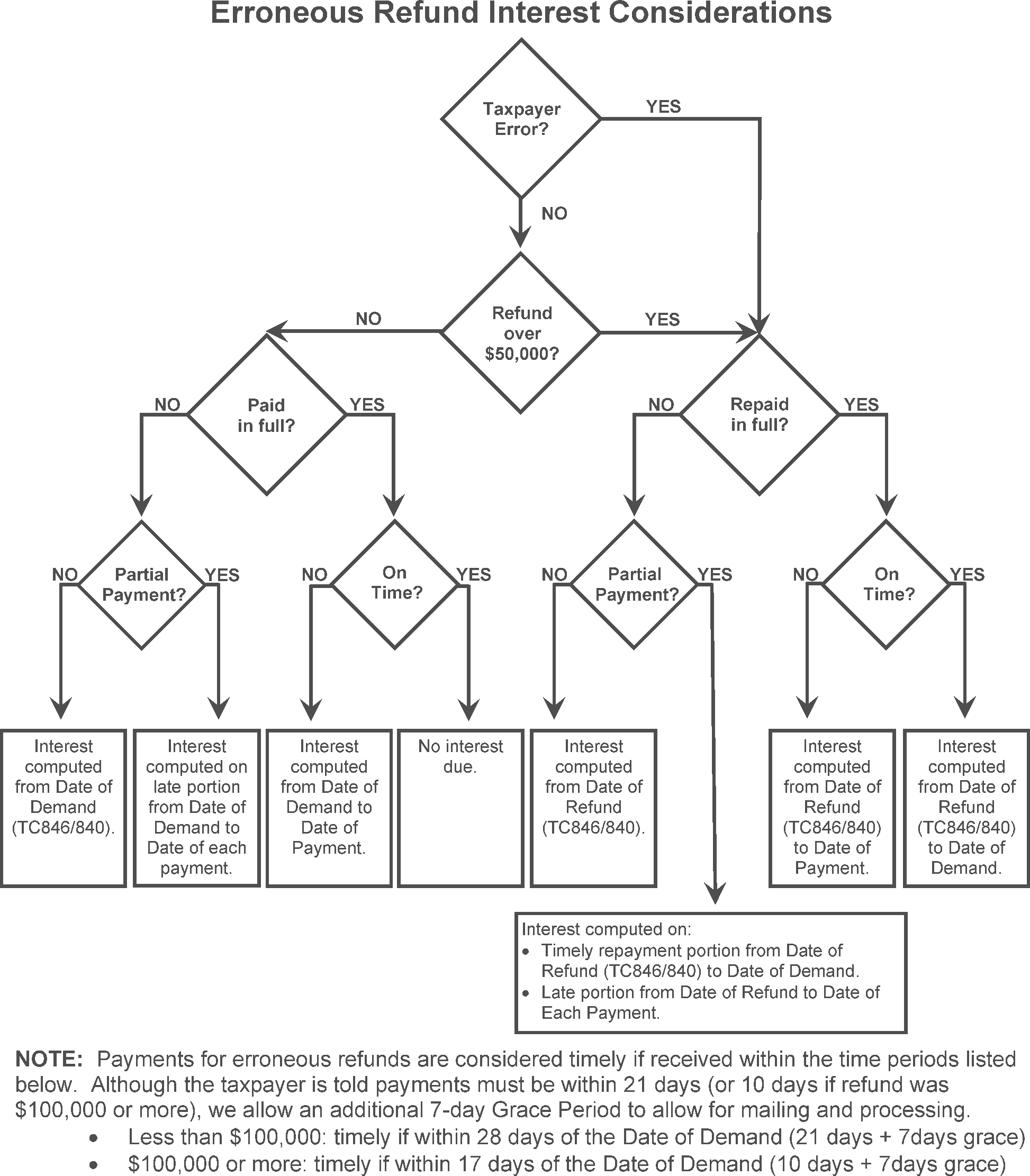
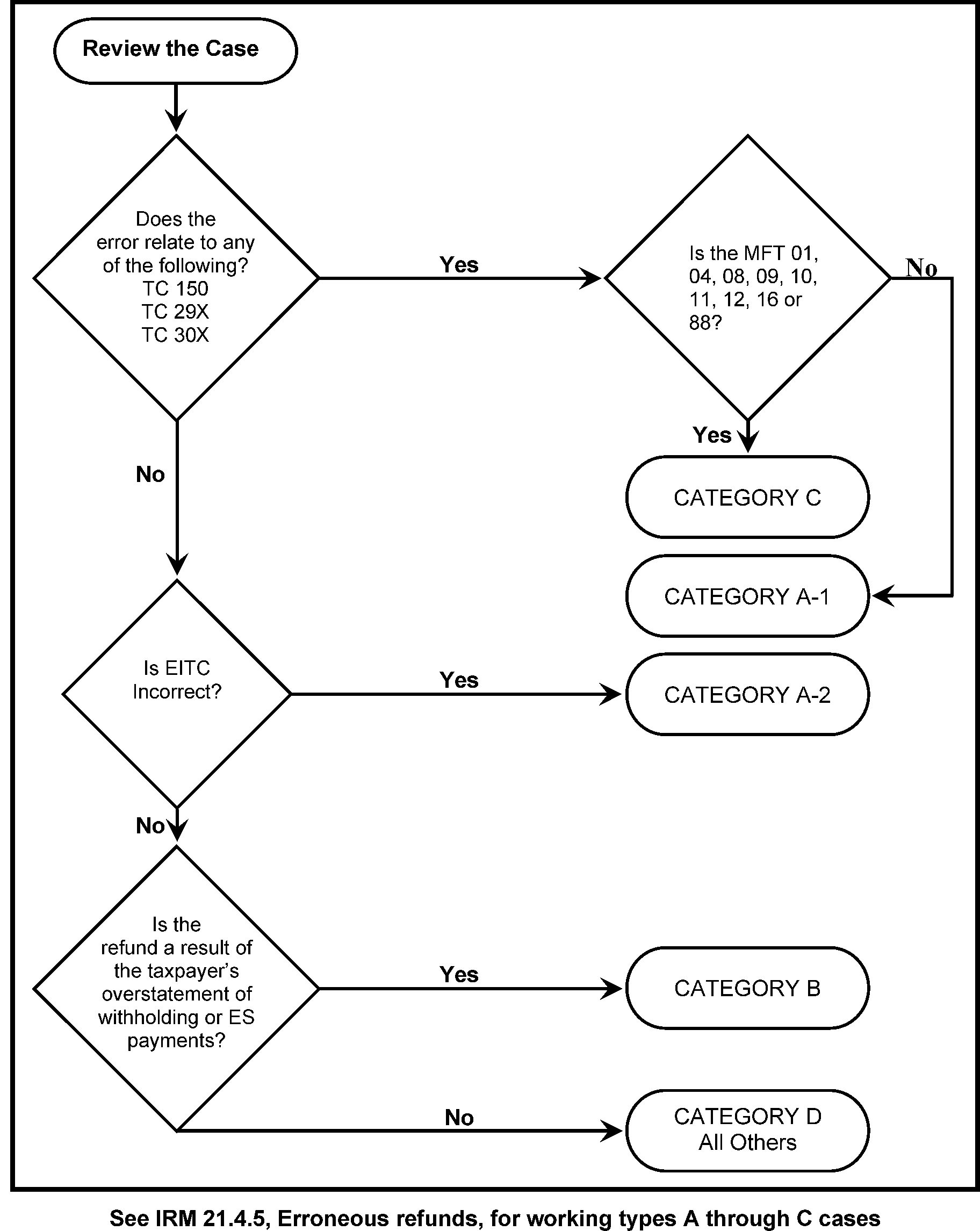
Please click here for the text description of the image.
| If the: | Example | Then the Category Is: |
|---|---|---|
| Error relates to TC’s 150, 29X, and/or 30X and MFT’s are not 01, 04, 08, 09, 10, 11, 12, 16, or 88. |
|
"A1" |
| Refund relates to disallowed Earned Income Tax Credit (EITC), TC’s 764, 765, and 768 or Child Tax Credit Issue (Refundable part). Non Refund TC 766. |
|
"A2" |
| Refund was caused by taxpayer's overstatement of prepaid credits (TC 66X or TC 80X) |
|
"B" |
| Error relates to BMF TC’s 150, 29X, and/or TC 30X and the MFT is 01, 04, 08, 09, 10, 11, 12, 16, or 88. |
|
"C" |
| Error relates to any erroneous refund that is not included in the above categories. |
|
"D" |
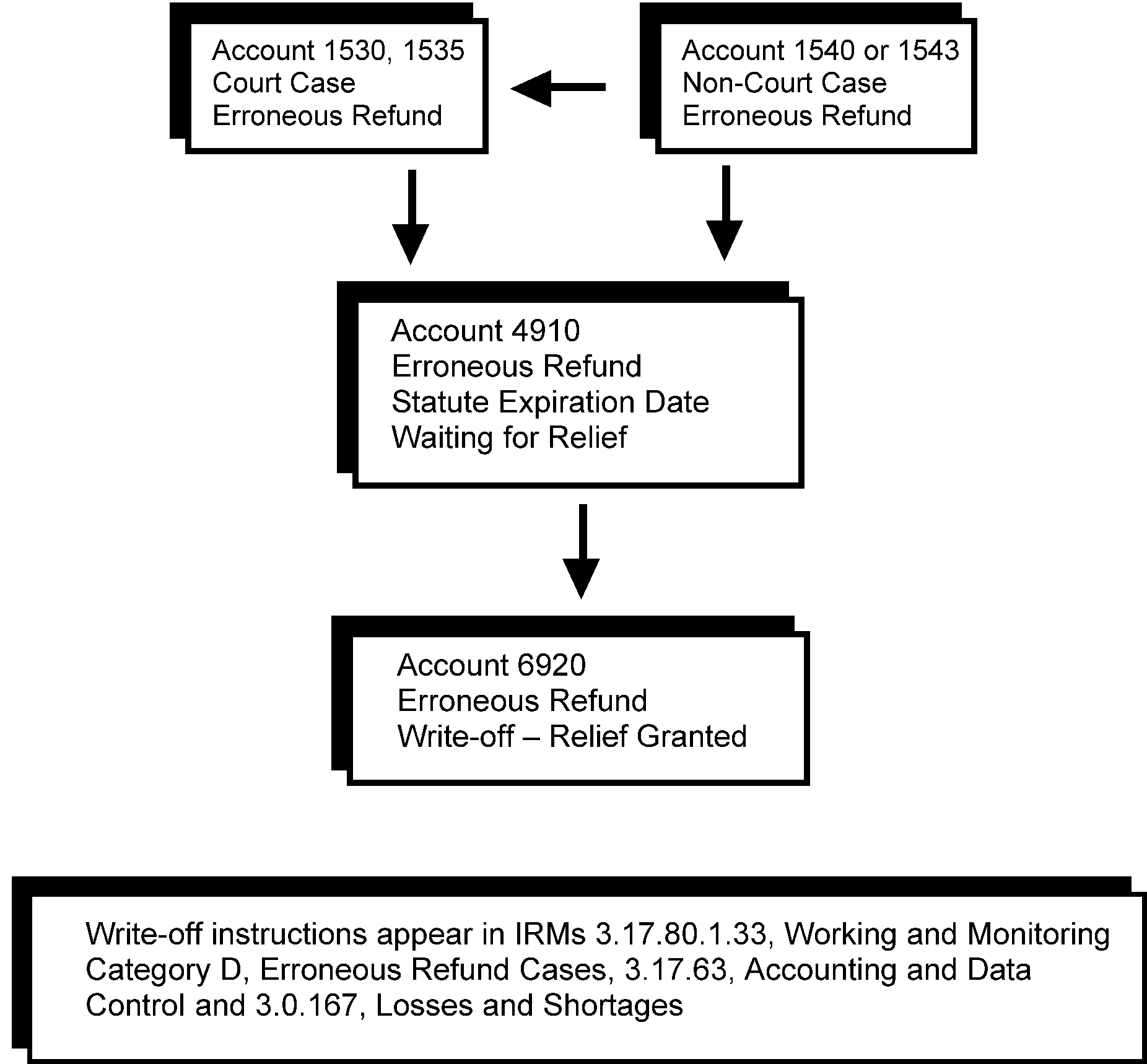
All Cases must Be Sent via E-mail combined into one pdf file.
| Submission Processing site | Name and Address | Telephone # | |
|---|---|---|---|
| Austin 18 | IRS - Austin SPC Attn: SP Accounting Operations Erroneous Refund Coordinator AUSPC Stop 6271 PO Box 934 Austin, TX 78767 or 3651 S IH 35 Austin, TX 78741 |
≡ ≡ ≡ ≡ ≡ ≡ ≡ ≡ ≡ | *TS SP Erroneous Refund Austin |
| The below sites are to be sent to the Kansas City Campus. Kansas City 09 Atlanta 07 Andover 08 Fresno 89 |
IRS - Kansas City SPC Attn: SP Accounting Operations Erroneous Refund Coordinator 333 W. Pershing Rd. Stop 6250 P-6 Kansas City, Missouri 64108 |
≡ ≡ ≡ ≡ ≡ ≡ ≡ ≡ ≡ | *TS SP Erroneous Refund Kansas City |
| The below sites are to be sent to the Ogden Campus. Ogden 29 Brookhaven 19 Cincinnati 17 Memphis 49 Philadelphia 28 |
IRS - Ogden SPC Attn: SP Accounting Operations Erroneous Refund Coordinator PO Box 9950 - Stop 6714 Ogden, UT 84409 or 1973 North Rulon White Blvd. Stop 6714 Ogden, UT 84404 |
≡ ≡ ≡ ≡ ≡ ≡ ≡ ≡ | *TS SP Erroneous Refund Ogden |
| ≡ ≡ ≡ ≡ ≡ ≡ ≡ ≡ ≡ | ≡ ≡ ≡ ≡ ≡ ≡ ≡ ≡ ≡ ≡ ≡ ≡ | ≡ ≡ ≡ ≡ ≡ ≡ ≡ ≡ ≡ | ≡ ≡ ≡ ≡ ≡ ≡ ≡ ≡ ≡ ≡ ≡ ≡ ≡ ≡ | ≡ ≡ ≡ ≡ ≡ ≡ ≡ ≡ |
|---|---|---|---|---|
| ≡ ≡ ≡ ≡ ≡ ≡ ≡ ≡ ≡ ≡ ≡ ≡ ≡ ≡ ≡ ≡ ≡ ≡ ≡ ≡ ≡ ≡ ≡ ≡ ≡ ≡ ≡ ≡ ≡ ≡ ≡ |
≡ ≡ ≡ ≡ | ≡ ≡ ≡ ≡ ≡ | ≡ ≡ ≡ ≡ ≡ ≡ ≡ | |
| ≡ ≡ ≡ ≡ ≡ ≡ ≡ ≡ ≡ ≡ ≡ ≡ ≡ ≡ ≡ ≡ ≡ ≡ ≡ ≡ ≡ ≡ ≡ ≡ ≡ ≡ ≡ ≡ ≡ ≡ ≡ |
≡ ≡ ≡ ≡ ≡ ≡ | ≡ ≡ ≡ | ≡ ≡ ≡ ≡ ≡ ≡ ≡ | |
| ≡ ≡ ≡ ≡ ≡ ≡ ≡ ≡ ≡ ≡ ≡ ≡ ≡ ≡ ≡ ≡ ≡ ≡ ≡ ≡ ≡ ≡ ≡ ≡ ≡ ≡ ≡ ≡ ≡ ≡ ≡ |
≡ ≡ ≡ ≡ ≡ ≡ ≡ ≡ ≡ ≡ ≡ ≡ ≡ ≡ |
≡ ≡ ≡ | ≡ ≡ ≡ ≡ ≡ ≡ ≡ ≡ ≡ ≡ ≡ ≡ ≡ ≡ ≡ ≡ ≡ ≡ ≡ ≡ ≡ ≡ | |
| AO/SC Code | Blocking Series | Description | Document Code 45 | Trans Code | Freeze Code | Processed By |
|---|---|---|---|---|---|---|
| SC | 220-299 | Repayment of Erroneous IMF/BMF | Form 3245 | 720 | - | Receipt & Control |
| ULC | 500-519 | IMF/BMF | SF 1098 Form 3245 |
841/740 | - | Accounting |
| ULC | 520-529 | ANMF | SF 1098 Form 3245 |
841/740 | - | Accounting |
| ULC | 530-539 | IMF-IRAF | SF 1098 Form 3245 |
841/740 | - | Accounting |
| ULC | 540-549 | IMF/BMF/ANMF | TFS 3813 Form 3245 |
843/742 | - | Accounting |
| ULC | 550-554 | IMF/BMF | SF 1081 Debit/POC TRACS Form 3245 |
843 | - | Accounting |
| ULC | 550-553 | IMF/BMF | SF 1081 Debit Settlement Authorized Form 3245 | 840 | Accounting | |
| ULC | 555 | Intercepted Checks Manually Processed 1098 Listing | SF 1098/Form 3245 | 841 | P- | Accounting |
| ULC | 666 | IMF/BMF/ANMF | Limited Payability Cancellation Credit/TRACS Form 3245 | 740 | S- | Accounting |
| ULC | 800 | Repayment of Erroneous Refunds ANMF | Form 3245 | 720 | - | Receipt & Control |
| ULC | 888 | IMF/BMF/ANMF | SF 1081 Credit/RC/UCC TRACS Form 3245 | 841 | - | Accounting |
| ULC | 889 | Use for MFT 06/08 Only | SF 1081 Credit/RC/UCC TRACS Form 3245 | 841 | - | Accounting |
| ULC | 55555 | Intercepted Checks | Master File Tape Processing | 841 | P- | Computer Generated |
| ULC | 66666 | Limited Payability | Master File Tape Processing | 740 | S- | Computer Generated |
| SC | 77777 | Undelivered ELF (Electronic Filed Return) | Master File Tape Processing | 841 | - | Computer Generated |
| SC | 88888 | Recertified Credit | Master File Tape Processing | 841 | - | Computer Generated |
| SC | 88899 | Returned Credit (Due to CHKCL) | Master File Tape Processing | 841 | P- | Computer Generated |
| SC | 99999 | Undelivered Check | Master File Tape Processing | 740 | S- | Computer Generated |
| SC | 99999 | Returned Checks | Master File Tape Processing | 841 | P- | Computer Generated |
| AO/SC Code | Blocking Series | Description | Document Code 45 | Trans Code | Processed By |
|---|---|---|---|---|---|
| ULC | 200-299 | IMF/BMF | Refunds/ Form 3753 | 840 | Accounting |
| ULC | 300-399 | BMF (F4466 Only) | Refunds/Form 3753 | 840 | Accounting |
| ULC | 900 | -0- Amount | Form 3753 Dummy Refunds to Release X- Freeze | 840 | Accounting |
| ULC | 920 | IMF/BMF/NMF | Form 3753 Used When Transferring Refunds to Proper Account and in Conjunction with Form 3809 (*Optional Form 12857, top portion) | 840 | Accounting |
| ULC | 600 | Manual Refund/Direct Deposit | IRS Error | 840 | Accounting |
| * Option Form 12857, Refund Transfer, will arrive in accounting to transfer accounts only. These items do not create a refund condition. Form 12857, top portion only, are numbered Document Code 45 and separated from the bottom portion prior to sending to RRACS area via Form 813. | |||||
| * If posting document requires DLN for Document Code 45, Blocking Series 92X, aka "dummy refunds" , enter "0" (zero) in Block 4 on Form 3753 (Schedule Number) or Form 12857 (Refund Schedule Number). | |||||
| ≡ ≡ ≡ ≡ ≡ ≡ ≡ ≡ | ≡ ≡ ≡ ≡ ≡ | ≡ ≡ ≡ ≡ ≡ ≡ | ≡ ≡ ≡ ≡ ≡ ≡ | ≡ ≡ ≡ ≡ ≡ ≡ ≡ ≡ ≡ ≡ |
|---|---|---|---|---|
| ≡ ≡ ≡ ≡ ≡ ≡ ≡ ≡ ≡ ≡ ≡ ≡ ≡ ≡ ≡ ≡ ≡ ≡ ≡ ≡ ≡ ≡ ≡ | ≡ ≡ | ≡ ≡ ≡ ≡ | ≡ ≡ ≡ ≡ ≡ ≡ ≡ ≡ ≡ ≡ ≡ ≡ ≡ ≡ ≡ ≡ | ≡ ≡ ≡ ≡ ≡ ≡ ≡ ≡ ≡ ≡ ≡ ≡ ≡ ≡ ≡ ≡ ≡ ≡ ≡ ≡ |
| ≡ ≡ ≡ ≡ ≡ ≡ ≡ ≡ ≡ ≡ ≡ ≡ ≡ ≡ ≡ ≡ ≡ ≡ ≡ ≡ | ≡ ≡ ≡ ≡ ≡ ≡ ≡ ≡ ≡ ≡ ≡ ≡ ≡ ≡ ≡ ≡ ≡ | ≡ ≡ ≡ ≡ ≡ ≡ ≡ ≡ | ≡ ≡ ≡ ≡ ≡ ≡ ≡ ≡ ≡ ≡ ≡ ≡ ≡ ≡ ≡ ≡ ≡ ≡ | ≡ ≡ ≡ ≡ ≡ ≡ ≡ ≡ ≡ ≡ ≡ ≡ ≡ ≡ ≡ ≡ ≡ ≡ ≡ ≡ ≡ ≡ ≡ ≡ ≡ ≡ ≡ ≡ ≡ ≡ ≡ ≡ ≡ |
| ≡ ≡ ≡ ≡ ≡ ≡ ≡ ≡ ≡ ≡ ≡ ≡ ≡ ≡ ≡ ≡ | ≡ ≡ ≡ ≡ ≡ ≡ ≡ ≡ ≡ ≡ ≡ ≡ ≡ ≡ ≡ ≡ ≡ | ≡ ≡ ≡ ≡ ≡ ≡ ≡ ≡ | ≡ ≡ ≡ ≡ ≡ ≡ ≡ ≡ ≡ ≡ ≡ ≡ ≡ ≡ ≡ ≡ ≡ ≡ ≡ ≡ ≡ | ≡ ≡ ≡ ≡ ≡ ≡ ≡ ≡ ≡ ≡ ≡ ≡ |
| ≡ ≡ ≡ ≡ ≡ ≡ ≡ ≡ ≡ ≡ ≡ ≡ ≡ ≡ ≡ ≡ ≡ ≡ | ≡ ≡ ≡ ≡ ≡ ≡ ≡ ≡ ≡ ≡ ≡ ≡ ≡ ≡ ≡ ≡ ≡ ≡ | ≡ ≡ ≡ ≡ ≡ ≡ ≡ ≡ ≡ | ≡ ≡ ≡ ≡ ≡ ≡ ≡ ≡ ≡ ≡ ≡ ≡ ≡ ≡ ≡ ≡ ≡ ≡ ≡ | ≡ ≡ ≡ ≡ ≡ ≡ ≡ ≡ ≡ ≡ |
| ≡ ≡ ≡ ≡ ≡ ≡ ≡ ≡ ≡ ≡ ≡ ≡ ≡ ≡ ≡ ≡ ≡ ≡ ≡ ≡ ≡ ≡ ≡ | ≡ ≡ ≡ ≡ ≡ ≡ ≡ ≡ ≡ ≡ | ≡ ≡ ≡ ≡ ≡ ≡ ≡ ≡ | ≡ ≡ ≡ ≡ ≡ ≡ ≡ ≡ ≡ ≡ ≡ ≡ ≡ ≡ ≡ ≡ ≡ ≡ | ≡ ≡ ≡ ≡ ≡ ≡ ≡ ≡ ≡ ≡ ≡ |
| ≡ ≡ ≡ ≡ ≡ ≡ ≡ ≡ ≡ ≡ ≡ ≡ ≡ ≡ ≡ ≡ ≡ ≡ ≡ ≡ ≡ ≡ ≡ ≡ ≡ ≡ | ≡ ≡ ≡ | ≡ ≡ ≡ ≡ ≡ ≡ ≡ ≡ | ≡ ≡ ≡ ≡ ≡ ≡ ≡ ≡ ≡ ≡ ≡ ≡ | ≡ ≡ ≡ ≡ ≡ ≡ ≡ ≡ |
| RRC Code | Paper Check Description | Trans. Code | Freeze Code | Block and Serial Number |
|---|---|---|---|---|
| 01 | Intercepted Checks | 841 | P- | 55555 |
| 02 | Undeliverable Checks | 740 | S- | 99999 |
| 03 | Returned Checks (other than intercepted or undeliverable) | 841 | P- | 99999 |
| 04 | Effective January-2015 Intercept Checks (CC NOREF) | 841 | P- | 77798 |
| 08 | Unavailable Check Cancellation Credit (returned on outstanding checks, because of a check claim, CC CHKCL/ Status 32) | 841 | P- | 88899 |
| 09 | Unavailable Check Cancellation Credit | 841 | None | 88888 |
| 09 | Reclamation Credit | 841 | None | 88000 |
| 09 | Outstanding check as the result of a paper 1184. | 841 | None | 88111 |
| 11 | Taxpayer correspondence attached. (Could include a photocopy fee refund cancelled that would not show on the MF.) | 841 | None | 99999 |
| 40 | Limited Payability (LP) expired credit | 740 | S- | 66666 666XX (prior to 1992) |
| 71 | Unavailable Check Cancellation Offset Return. Because of an agency claim, only the TOP offset amount of the original payment is returned. See IRM 21.4.6, Refund Offset | 841 | See IRM 21.4.6, Refund Offset | 88888 |
| 72 | Unavailable Check Cancellation Partial Payment Return. Because of an agency claim, only the net amount of the original payment after TOP offset is returned. See IRM 21.4.6, Refund Offset | 841 | See IRM 21.4.6, Refund Offset | 88888 |
| RRC Code | Electronic Funds Transfer (EFT) Description | Trans Code | Freeze Code | Block & Serial Number |
|---|---|---|---|---|
| 60 | Invalid/Missing Routing Transit Number | 841 | None | 77777 |
| 61 | Invalid/Blank Bank Account Number or Account Type. Must indicate (C) Checking or (S) Savings | 841 | None | 77777 |
| 62 | Direct Deposit Check Receiving Financial Institutions Non-ACH Participant | 841 | None | 77777 |
| 63 | EFT Payments without Financial Organization Address on Financial Organization Master File (FOMF) | 841 | None | 77777 |
| Note: All EFT cancellation transactions will carry block and serial number 77777 and will flip to paper check. | ||||
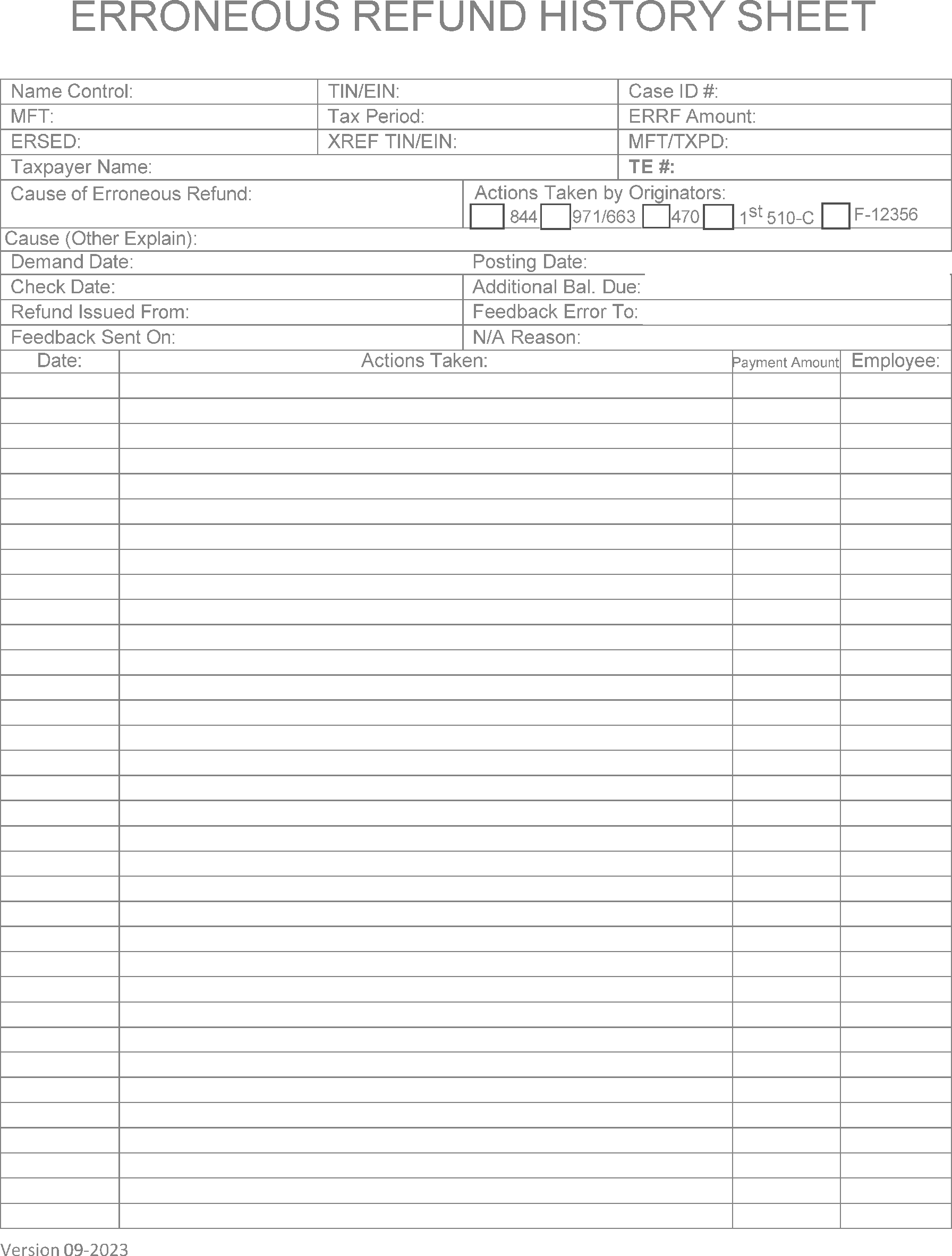
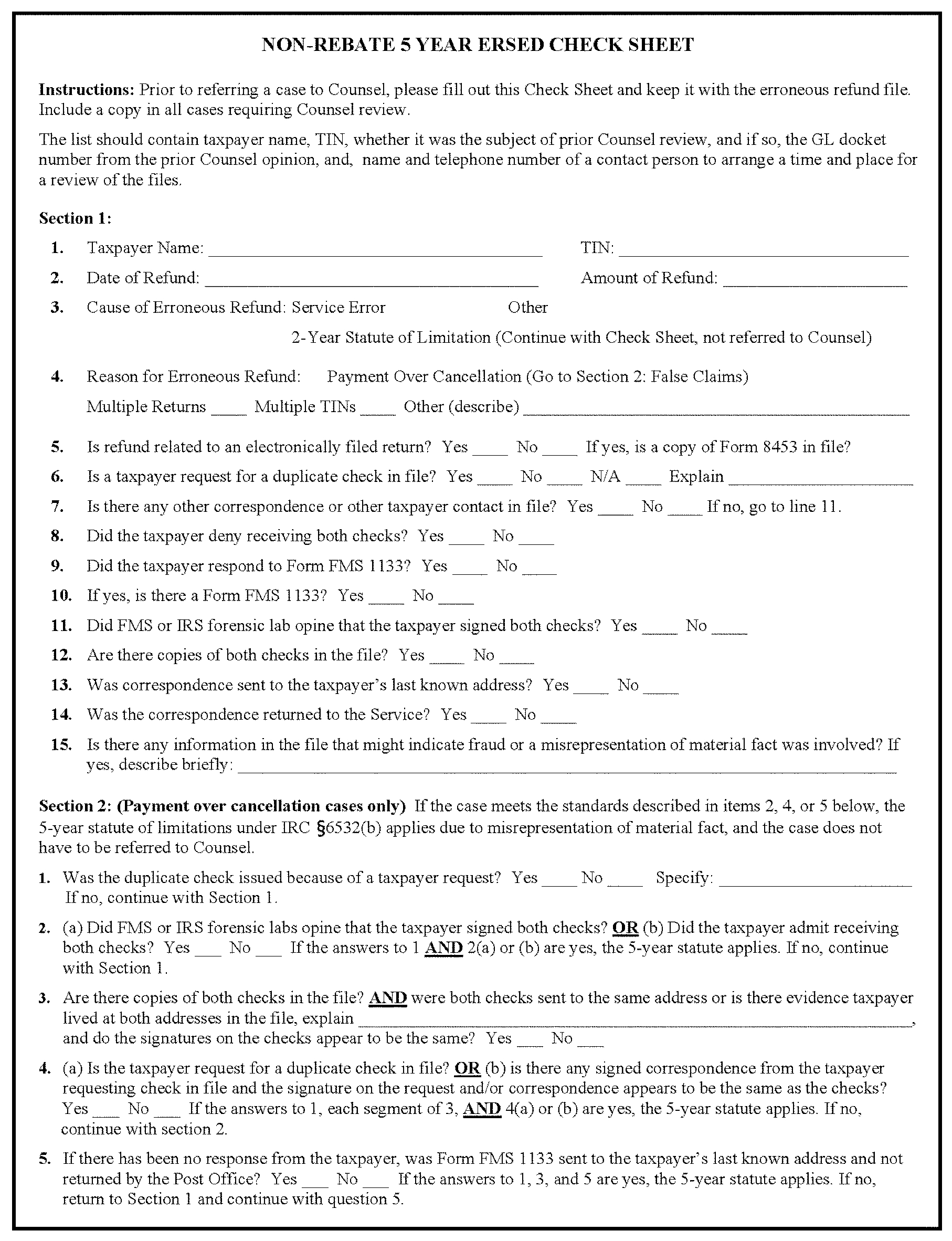
Refer to SERP Document 6209, Online Enterprise Computing Center data here: SERP - 6209 - IRM Supplements (irs.gov) Section 16 for posting cycles.
Look for Document 6209 on the IRS web site for more information about other posting cycle information for other calendar years.
Send the Form 14165-A (with boxes 1-9 completed) and a copy of the completed Form 14165 to both primary and back-up (when listed) BOD POC identified below. That point of contact will forward the form to be completed (boxes 10-12) by the area that caused the duplicate, manual, erroneous refund. Be very specific when completing Box 7 of Form 14165-A. When sending Erroneous Refund feedback Form 12356 , identify the BOD functional area and site so the BOD POC will know where to send the form for completion and/or feedback.
| BOD | Primary POC | Back-up POC | Primary POC Contact Information | Back-up POC Contact Information |
|---|---|---|---|---|
| APPEALS | Mark Feldpausch | Tim Kash | Feldpausch Mark W | Kash Timothy G |
| Criminal Investigations | Brian Wood | Gina Marshall | Wood Brian A | Marshall Gina M ; 210-355-4814 |
| LB&I | Donnell Lewis | Tony Mazzella | Donnell.Lewis@irs.gov; 601-292-4740 | Tony.A.Mazzella@irs.gov; 303-603-3869 |
| SBSE | Rachel L Farrell | Mike Kuglar | Rachel.L.Farrell@irs.gov; 631-977-3585 | Mike.Kuglar@irs.gov; 801-620-8171 |
| TEGE | Lina Laforet | Rachael Lake | Lina.M.Laforet@irs.gov; 801-620-3644 | Rachael.L.Lake@irs.gov; 801-620-4170 |
| TAS | Samaria Saliba | TAS Manual Refund Rejection OMX | Samaria.A.Saliba@irs.gov ; 978-805-0566 | *TAS Manual Refund Rejection |
| TS AM | Elissa Workhoven | Sandrine Vulpis | Elissa.J.Workhoven@irs.gov; 737-800-7968 | Sandrine.M.Vulpis@irs.gov ; 631-9977-5773 |
| TS CARE | Michelle R Jones | Stacey Houston-Williams or Brenna I Spence | Michelle.R.Jones@irs.gov; 404-338-8721 | Stacey.R.Houston@irs.gov; 678-627-4622 or Brenna.I.Spence@irs.gov; 470-639-2447 |
| TS RIVO | Linda Malan | Jennifer L Welsch | Linda.L.Malan@irs.gov; 470-639-3268 | Jennifer.L.Welsch@irs.gov |
| TS SP | Mary Preston | Bryce Procek | Mary.A.Preston@irs.gov; 816–499–5942 | Bryce.D.Procek@irs.gov; 801-620-6341 |
| A copy of the completed form must be forwarded by the BOD POC to CFO: ≡ ≡ ≡ ≡ ≡ ≡ ≡ ≡ ≡ ≡ ≡ ≡ ≡ ≡ ≡ ≡ ≡ ≡ ≡ | ||||
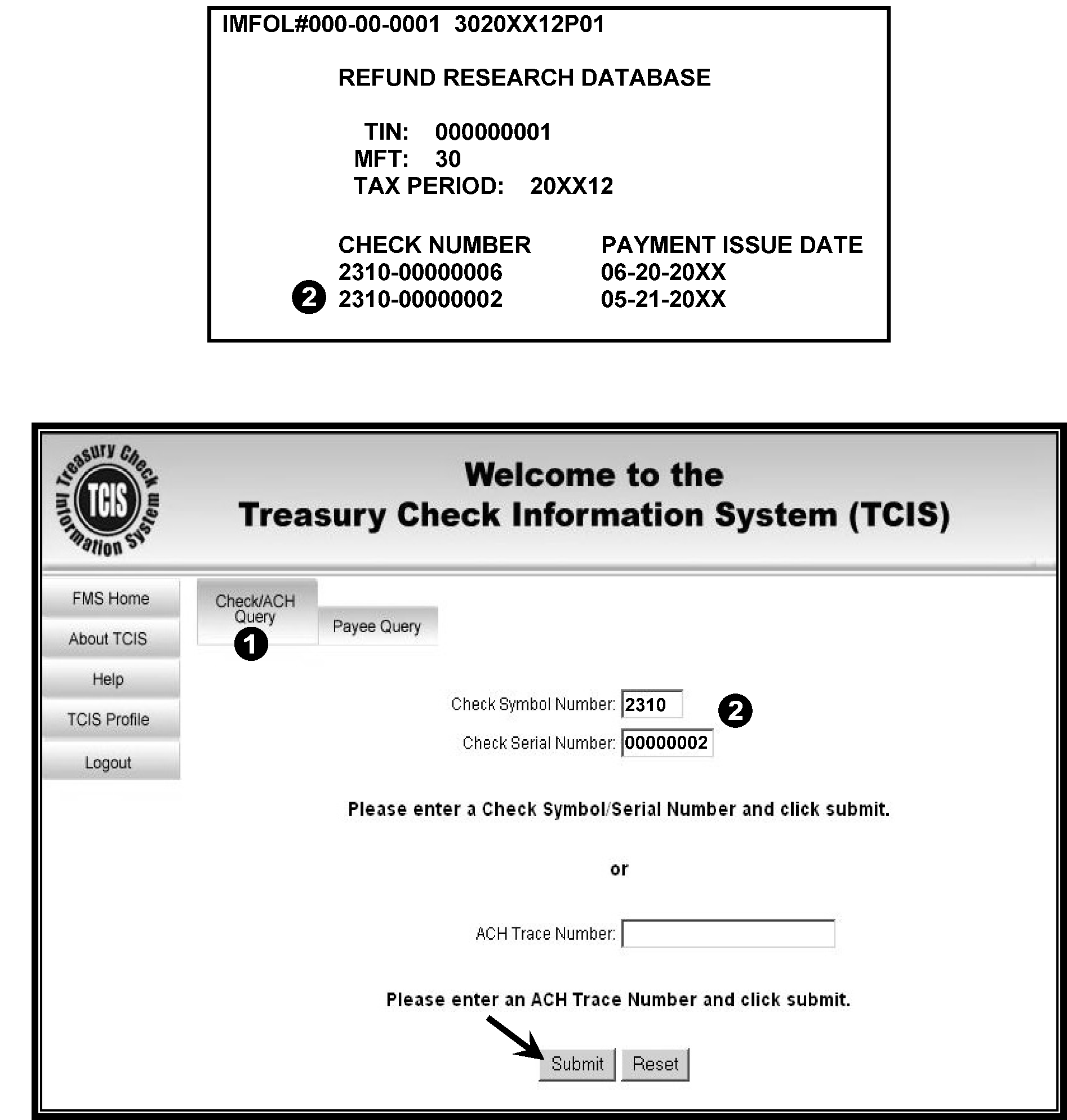
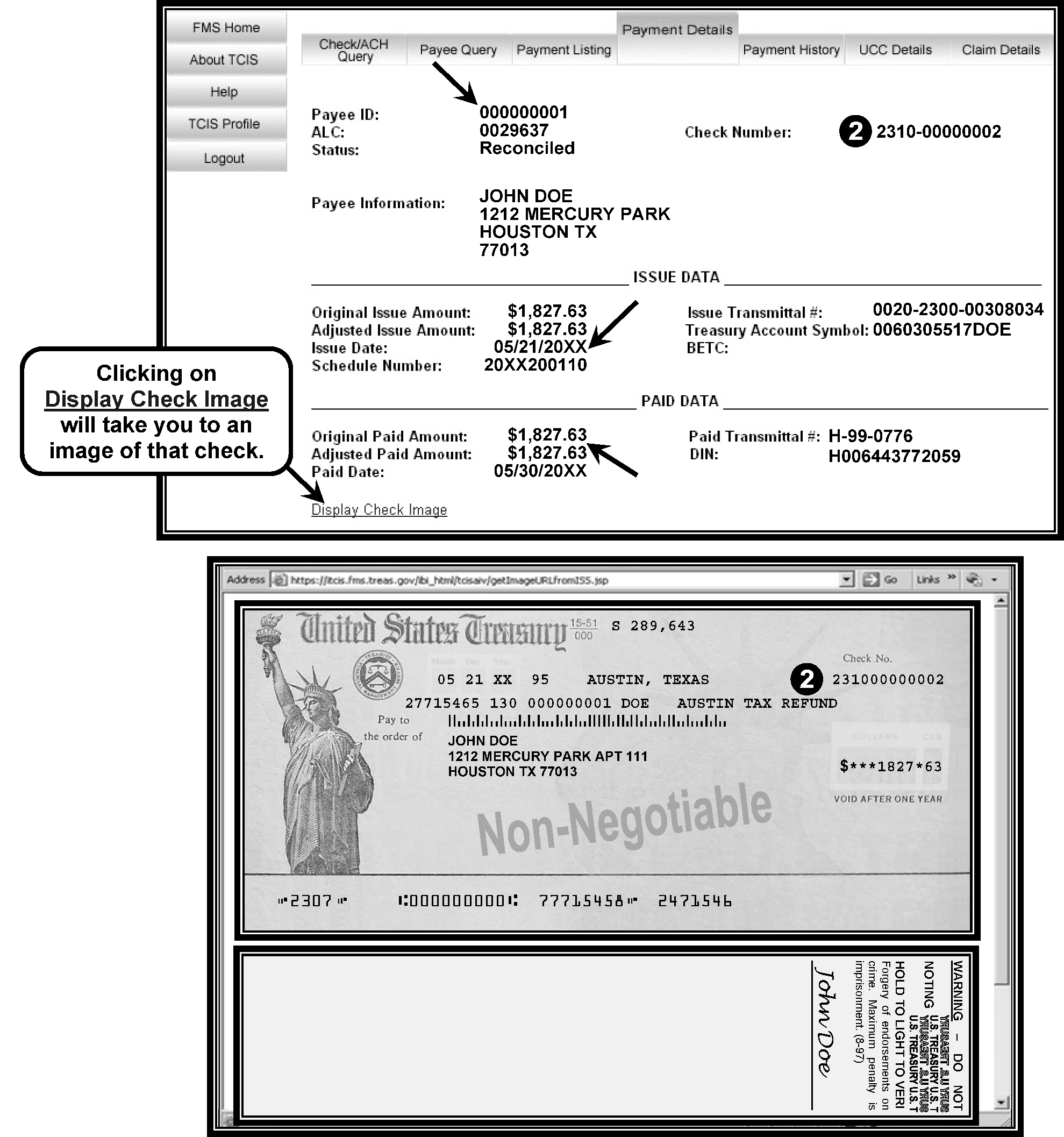
-
The below listing is not all inclusive. Refer to the Acronyms database found under, "Popular Tools and Services" in the main IRS website, for additional approved acronyms here: IRS Style Guide - Abbreviations and acronyms
| Acronym | Definition |
|---|---|
| 1530 Account | Erroneous Refund Court Cases |
| 1535 Account | Erroneous Refund Criminal Investigation (CI) Court Ordered Restitution |
| 1540 Account | Erroneous Refund Non-Court Cases |
| 1543 Account | Erroneous Refund Payment Over Cancellation |
| 1545 Account | Erroneous Refund Identity Theft |
| 1547 Account | Erroneous Refund Preparer Misconduct |
| 4910 Account | Erroneous Refund Disbursement Loss |
| 4970 Account | Unapplied Refund Reversal |
| 6565 Account | Limited Payability |
| 6905 Account | Erroneous Refund Identity Theft Disbursement Write Off |
| 6907 Account | Erroneous Refund Preparer Misconduct Disbursement Write Off |
| 6920 Account | Erroneous Refund Disbursement Write Off |
| ACC | Available Check Cancellation |
| ACTON | IDRS Case Control and History Request |
| ALC | Agency Location Code |
| AMS | Account Management Services |
| ANMF | Automated Non-Master File |
| BPD | Bureau of Public Debt |
| BFS | Bureau of Fiscal Service |
| BMF | Business Master File |
| CADE | Customer Accounts Data Engine |
| CC | Command Code |
| CARS | Central Accounting Reporting System |
| CCG | Check Claims Group |
| CDN | Claim Disposition Notice (BFS) |
| CFO | Chief Financial Officer |
| CHKCL | Non-Receipt Claim Check Claim Request |
| COMPA | Compute Interest or Estimated Tax Penalty Request |
| CP&R | Check Processing and Reconciliation System (BFS) |
| CI | Criminal Investigation |
| DCF | Dishonored Check File |
| DLN | Document Locator Number |
| DOJ | Department of Justice |
| EIN | Employer Identification Number |
| ERRF | Erroneous Refund |
| ERSED | Erroneous Refund Statute Expiration Date |
| ESTAB | Document Request |
| FLC | File Location Code |
| GAO | Government Accounting Office |
| HQ | Headquarters |
| ICS/ACS | Integrated Collection System/ Automated Collection System |
| IDRS | Integrated Data Retrieval System |
| IDT | Identity Theft |
| IGR | IDRS Generated Refund |
| IMF | Individual Master File |
| INTST | Interest / FTP penalty Accrual Computation Research |
| IPAC | Intra-Governmental Payment and Collections |
| IRM | Internal Revenue Manual |
| ISRP | Integrated Submission and Remittance Processing |
| IT | Information Technology |
| LP | Limited Payability |
| LPC | Limited Payability Cancellation |
| MFT | Master File Tax (Codes) |
| NMF | Non-Masterfile |
| NOREF (BMF only) | Refund Intercept Request |
| OAR | Operations Assistance Request |
| PACER | Payment and Claims Enhanced Reconciliation |
| PGLD/IM | Privacy, Governmental Liaison and Disclosure (PGLD)/Incident Management (IM) |
| POC | Payment Over Cancellation |
| RRACS | Redesigned Revenue Accounting Control System |
| RCTF | Recertification Category Code |
| REC | Reclamation Credits |
| RFC | Regional Financial Center |
| RFIQ | Refund Inquiry IDRS Category Code |
| RSN | Refund Schedule Number |
| SF | Standard Form |
| SP | Submission Processing |
| SSN | Social Security Number |
| TAC | Taxpayer Assistance Center |
| TAS | Taxpayer Advocate Service |
| TC | Transaction Code |
| TCIS | Treasury |
| TIGTA | Treasury Inspector General for Tax Administration |
| TIN | Taxpayer Identification Number (or SSN/EIN) |
| TOP | Treasury Offset Program |
| TRACS | Treasury Receivable Accounting and Collection System |
| TS | Taxpayer Services |
| UCC | Unavailable Check Cancellation |
| UPTIN | Unpostable Case Request |
| URF | Unidentified Remittance File, Account 4620 |
| XSF | Excess Collection File, Account 6800 |
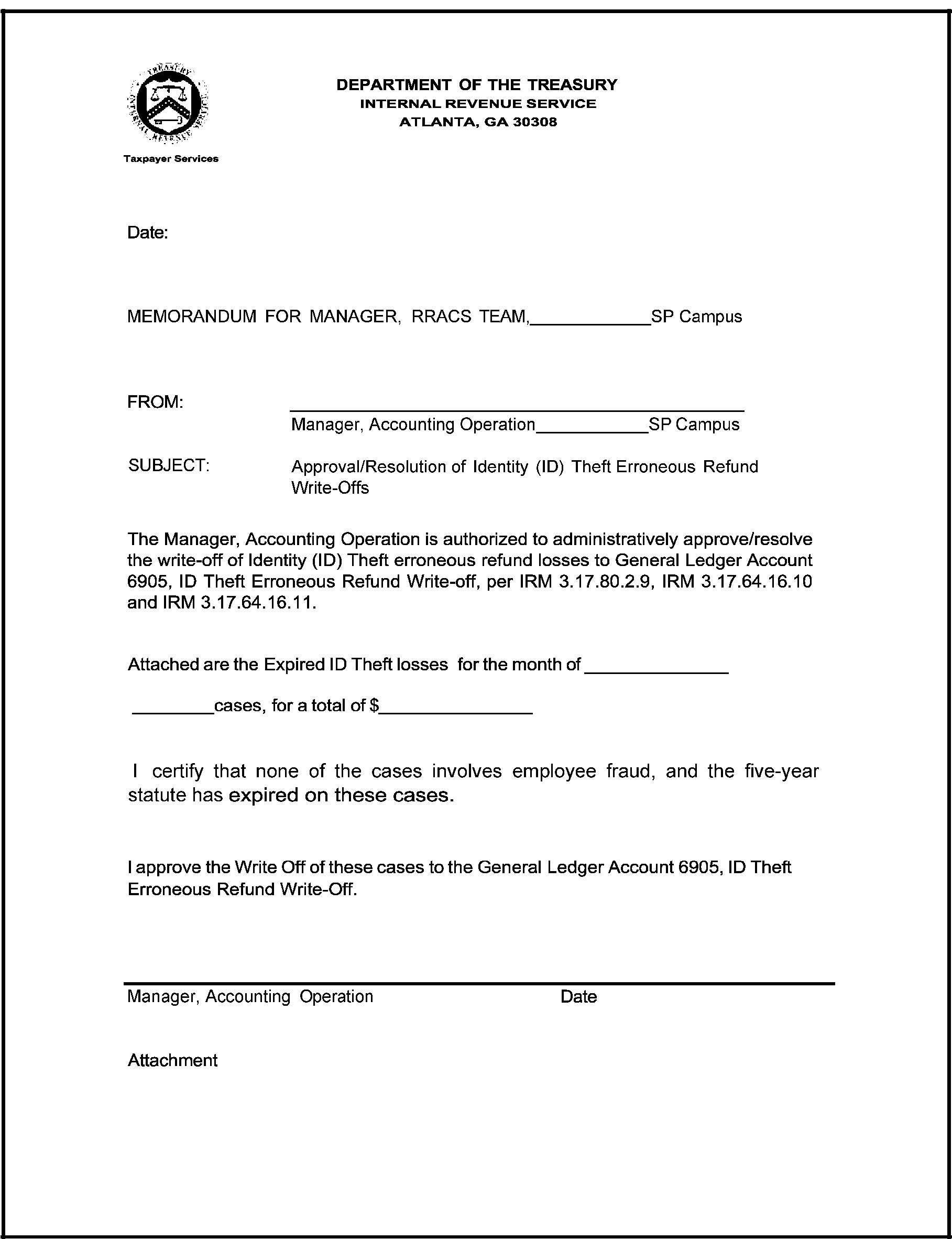
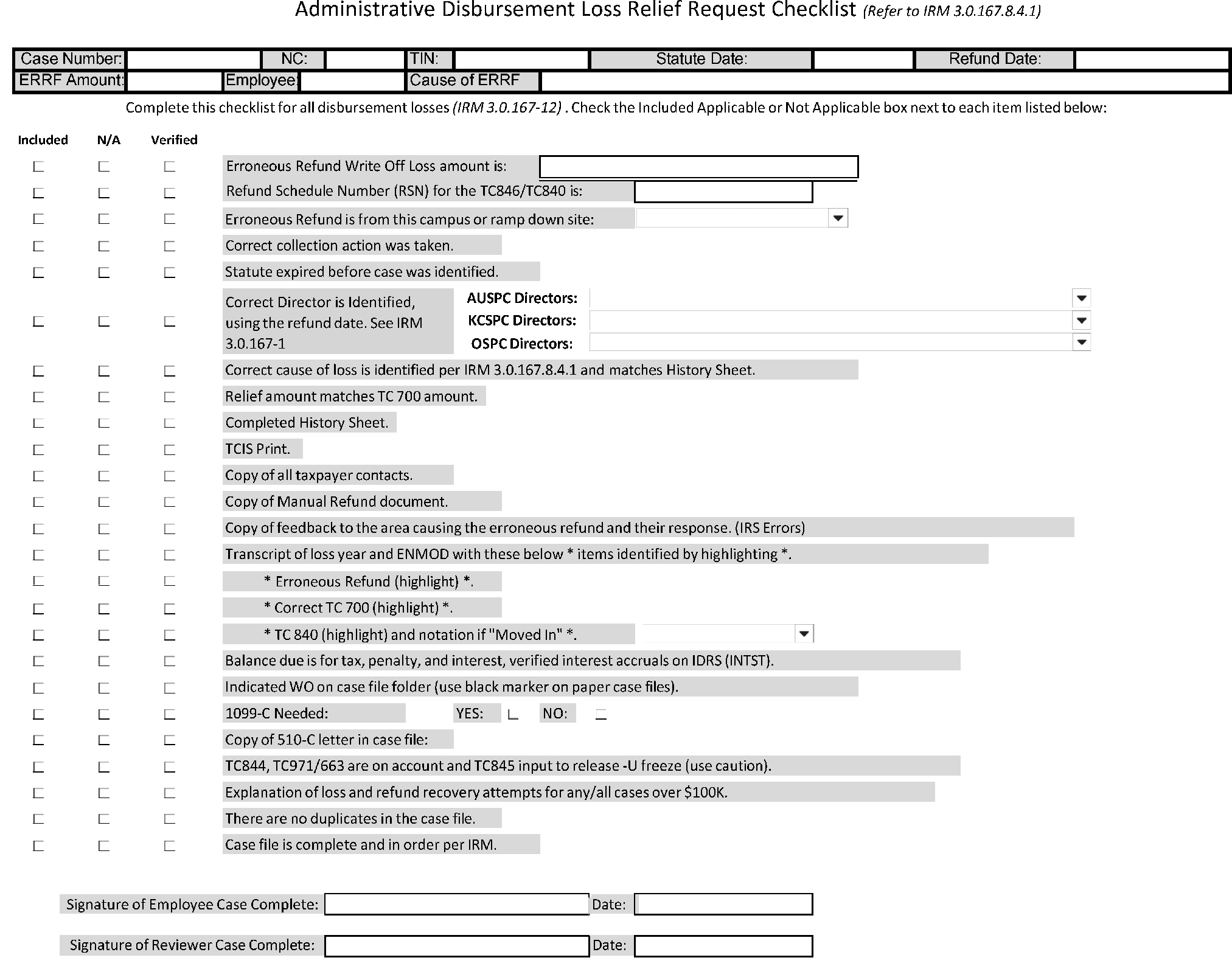
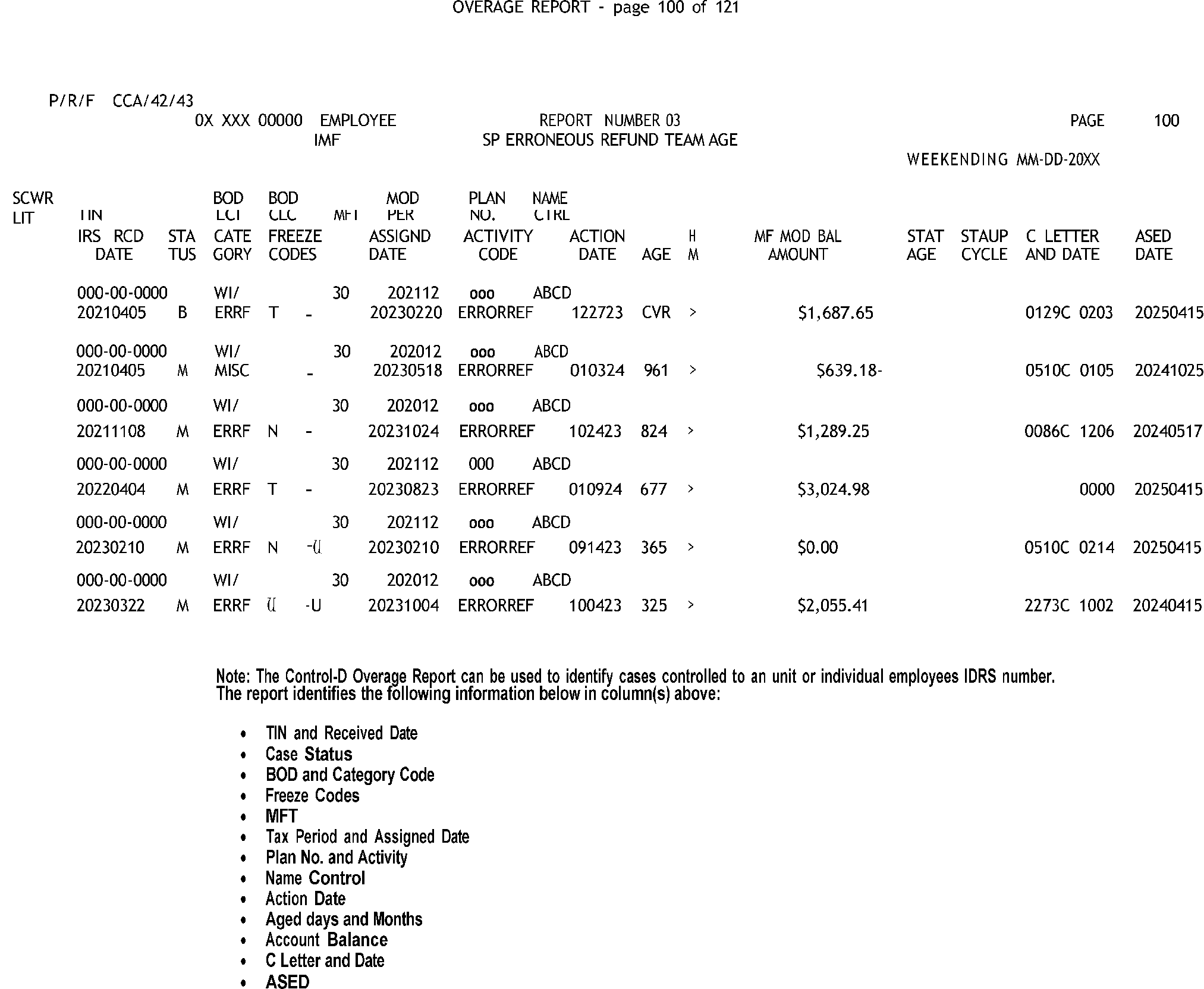
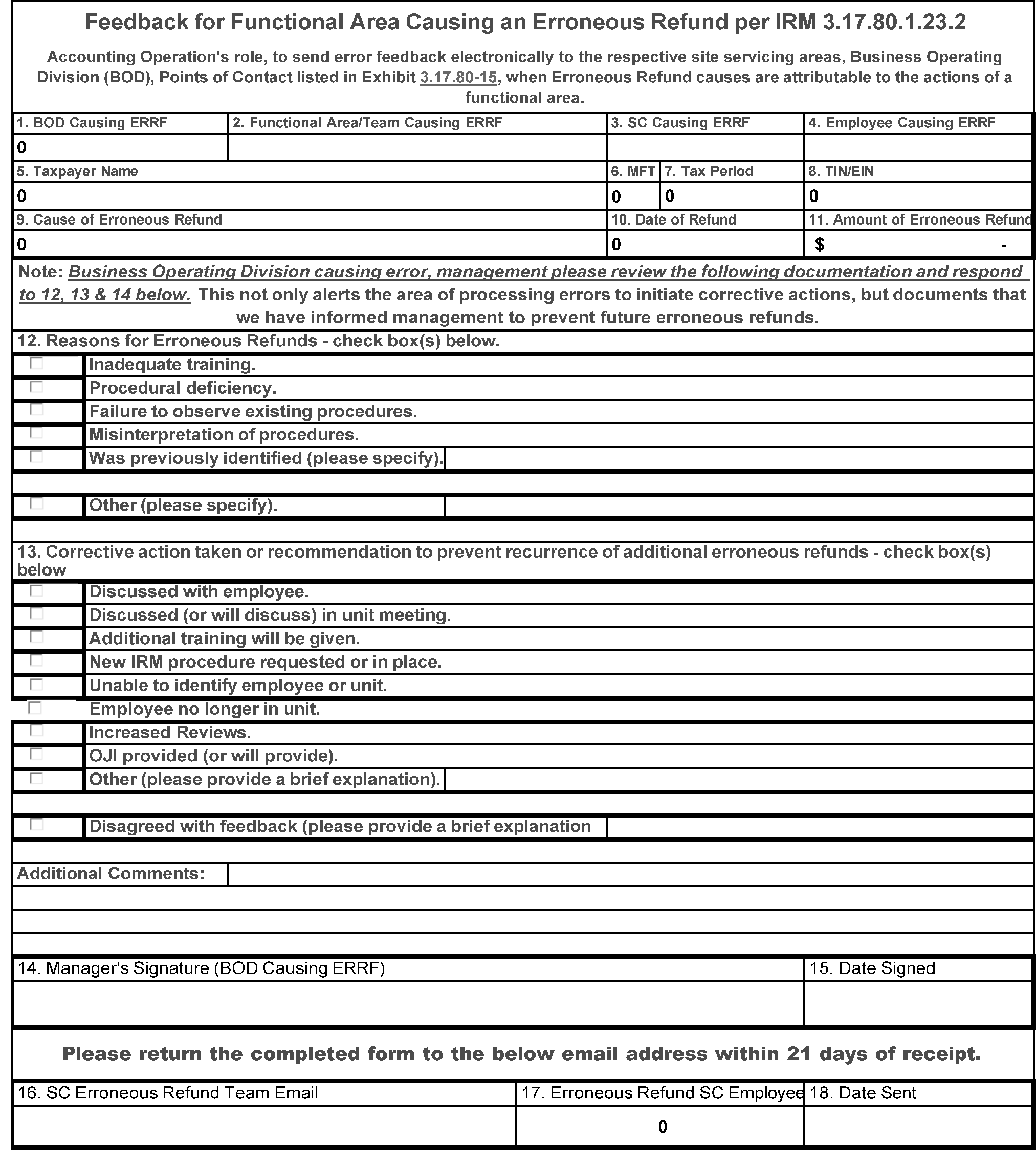
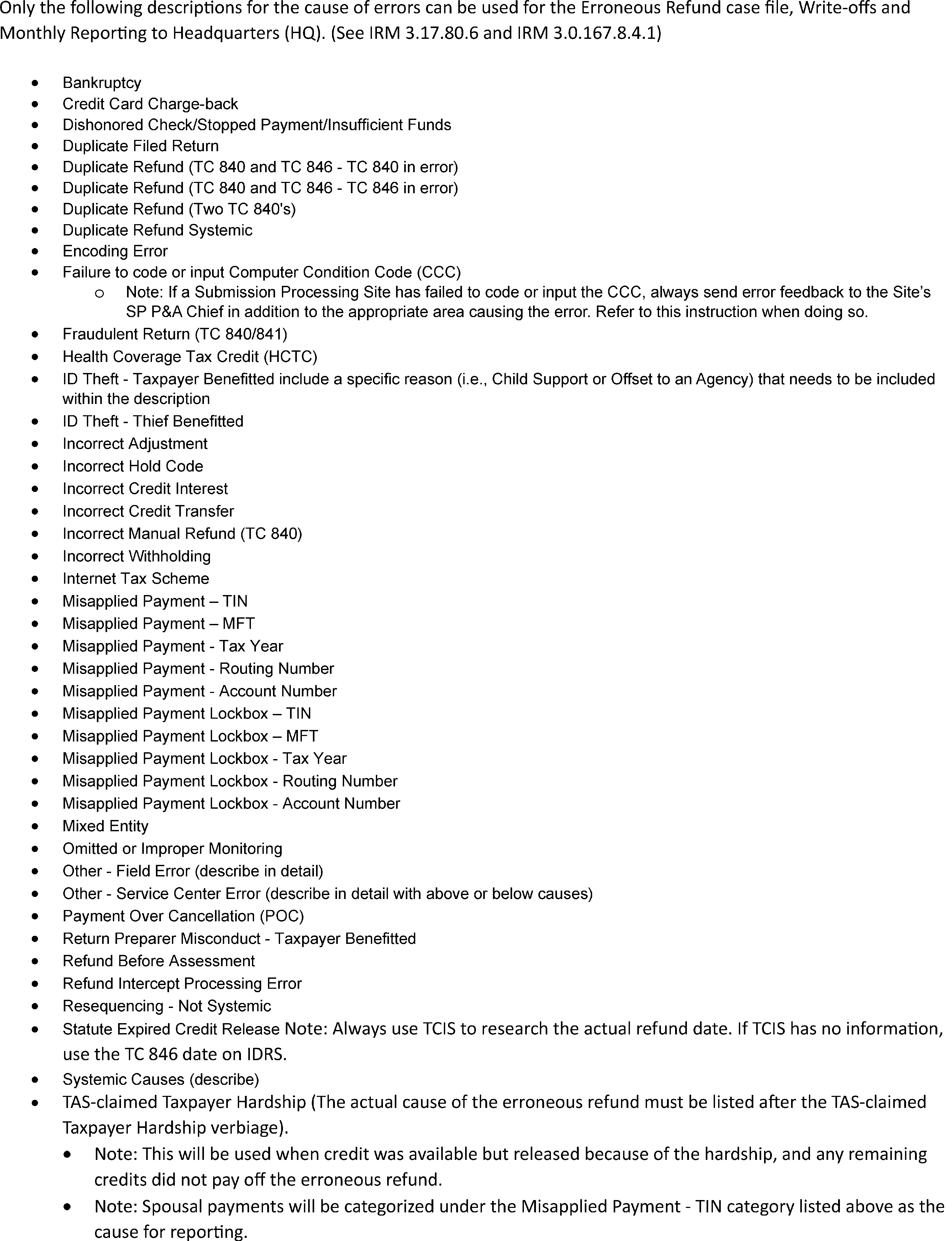
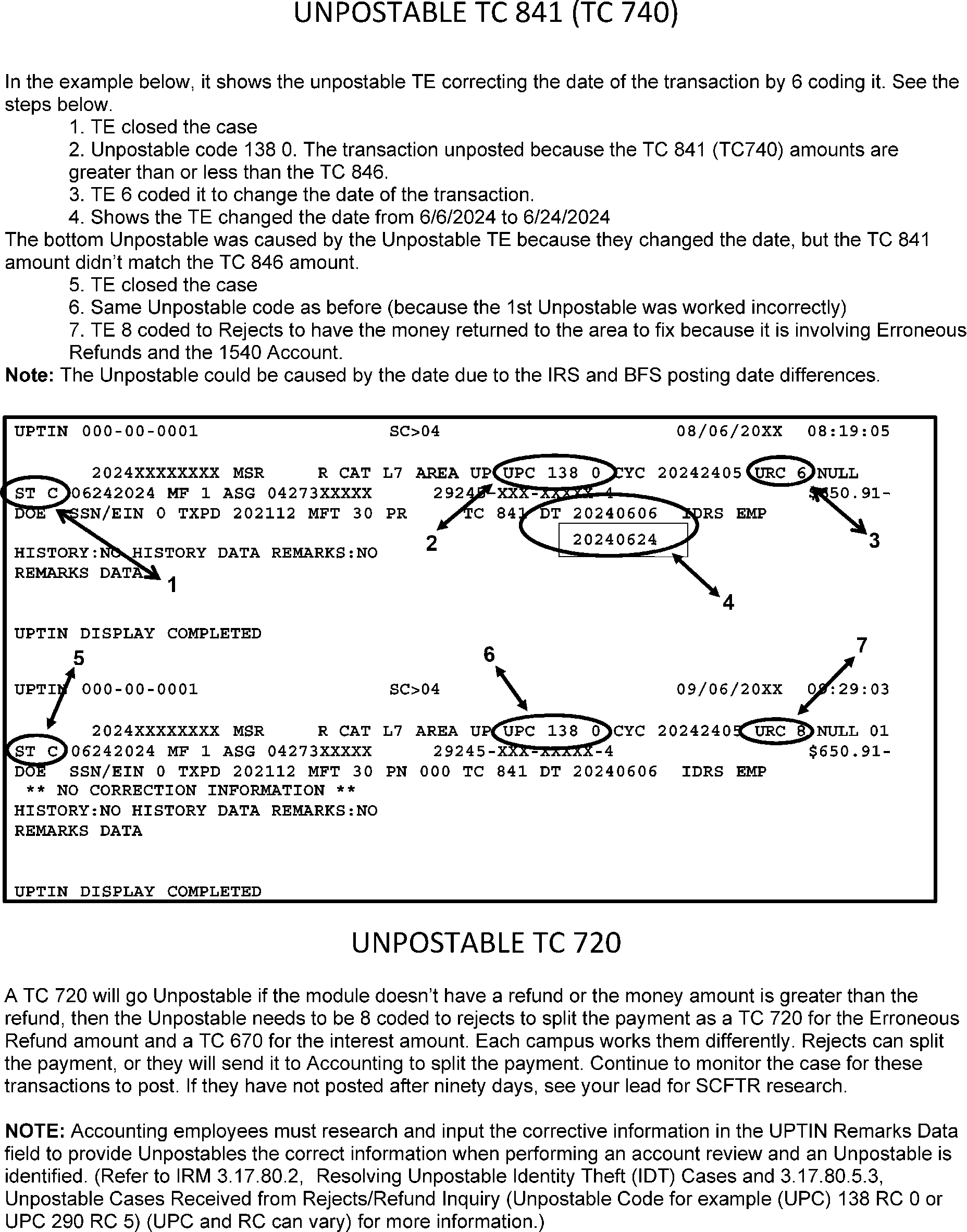
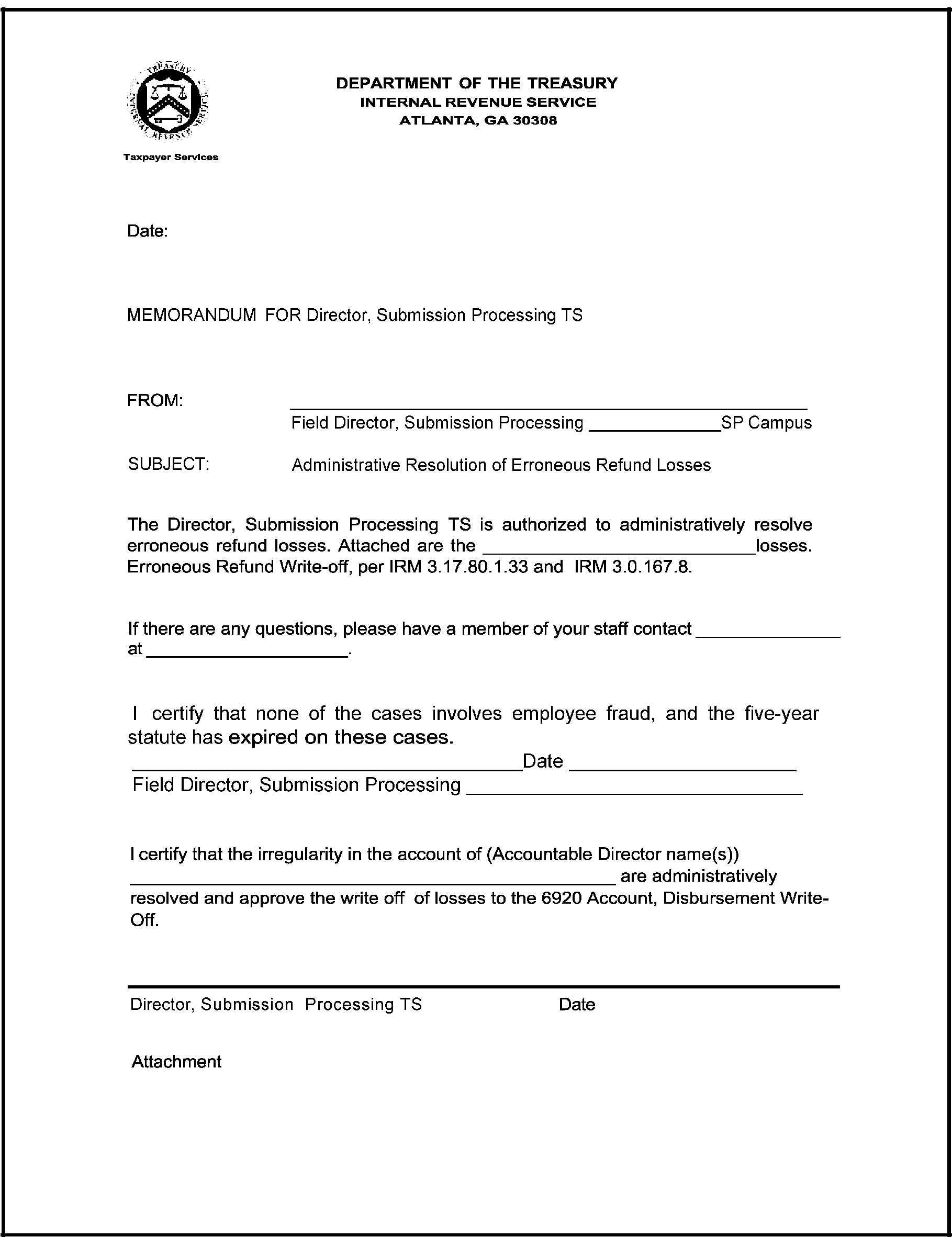
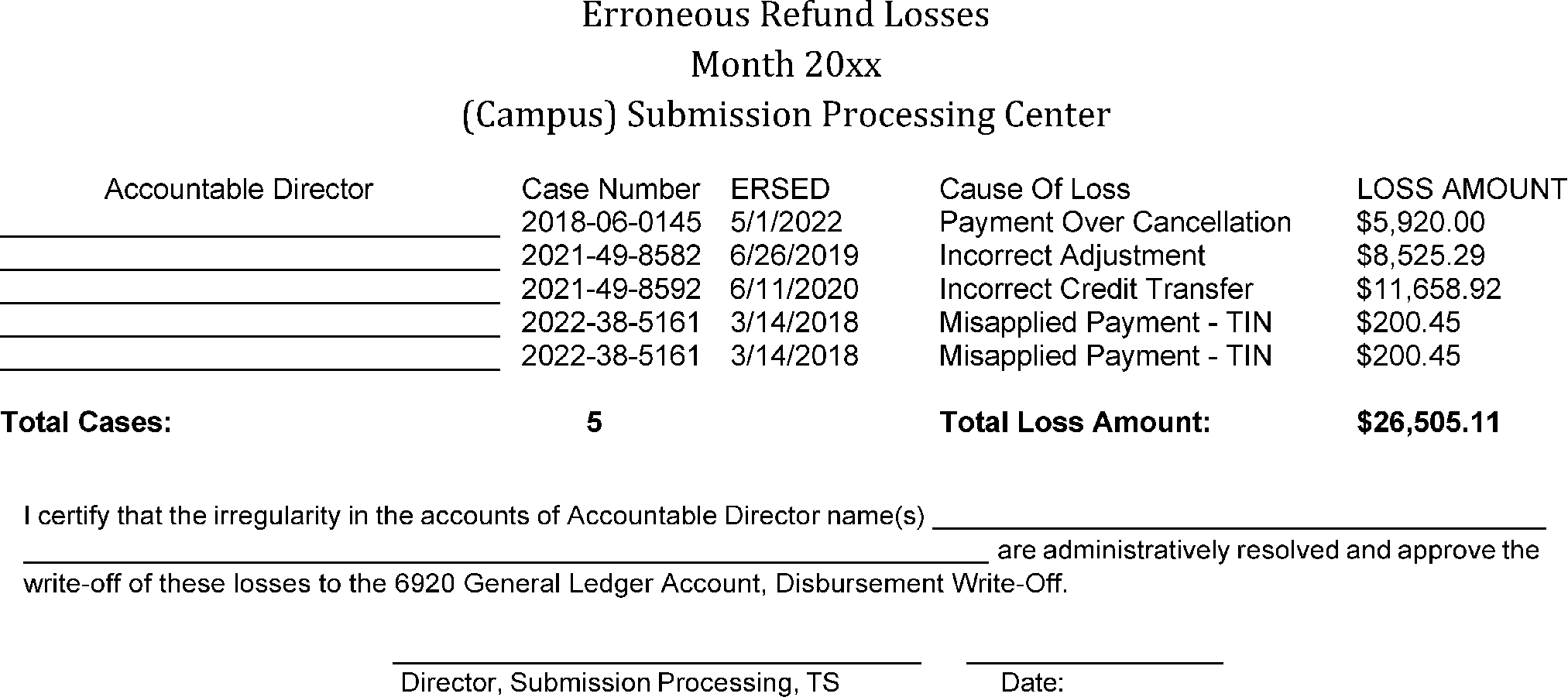
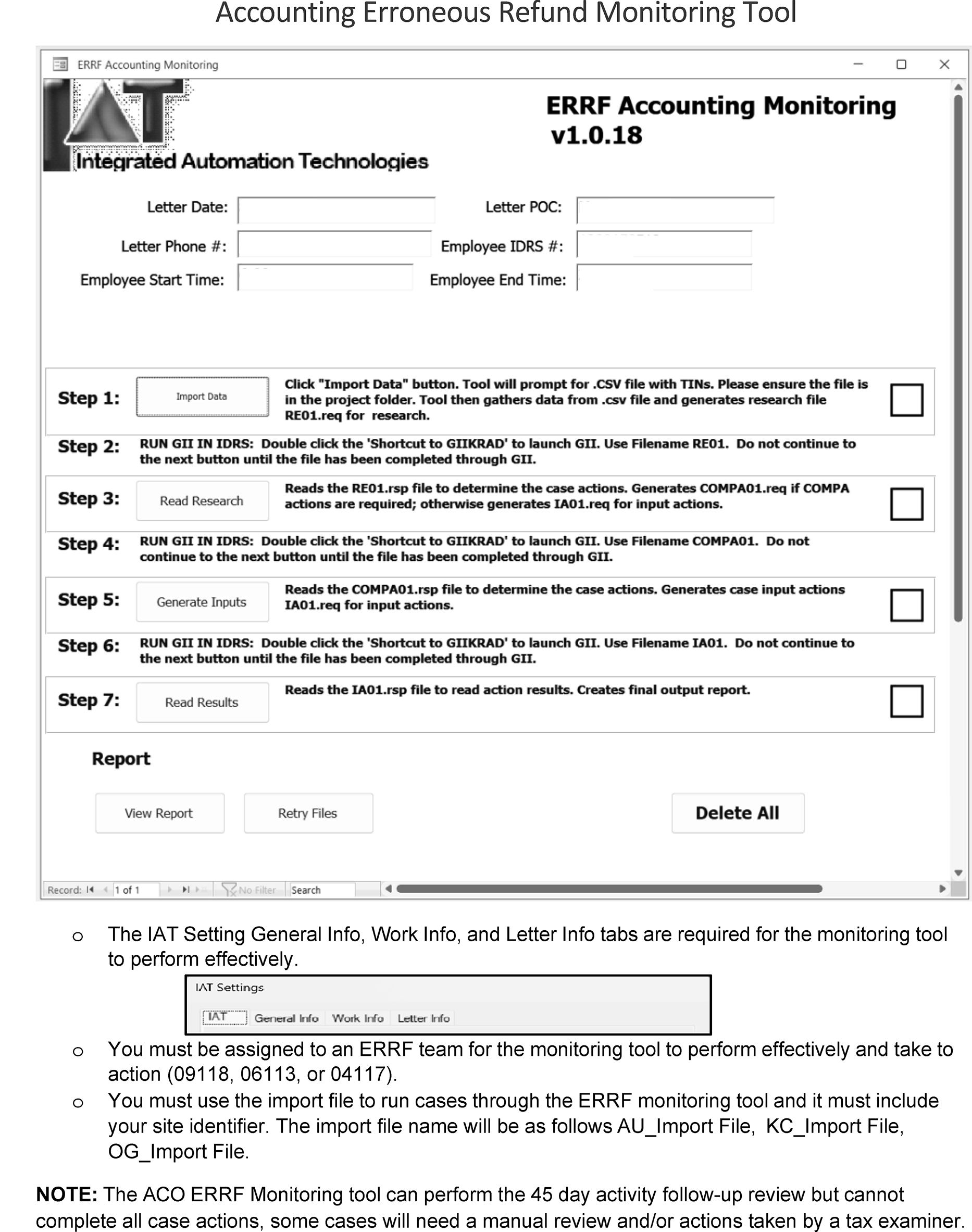
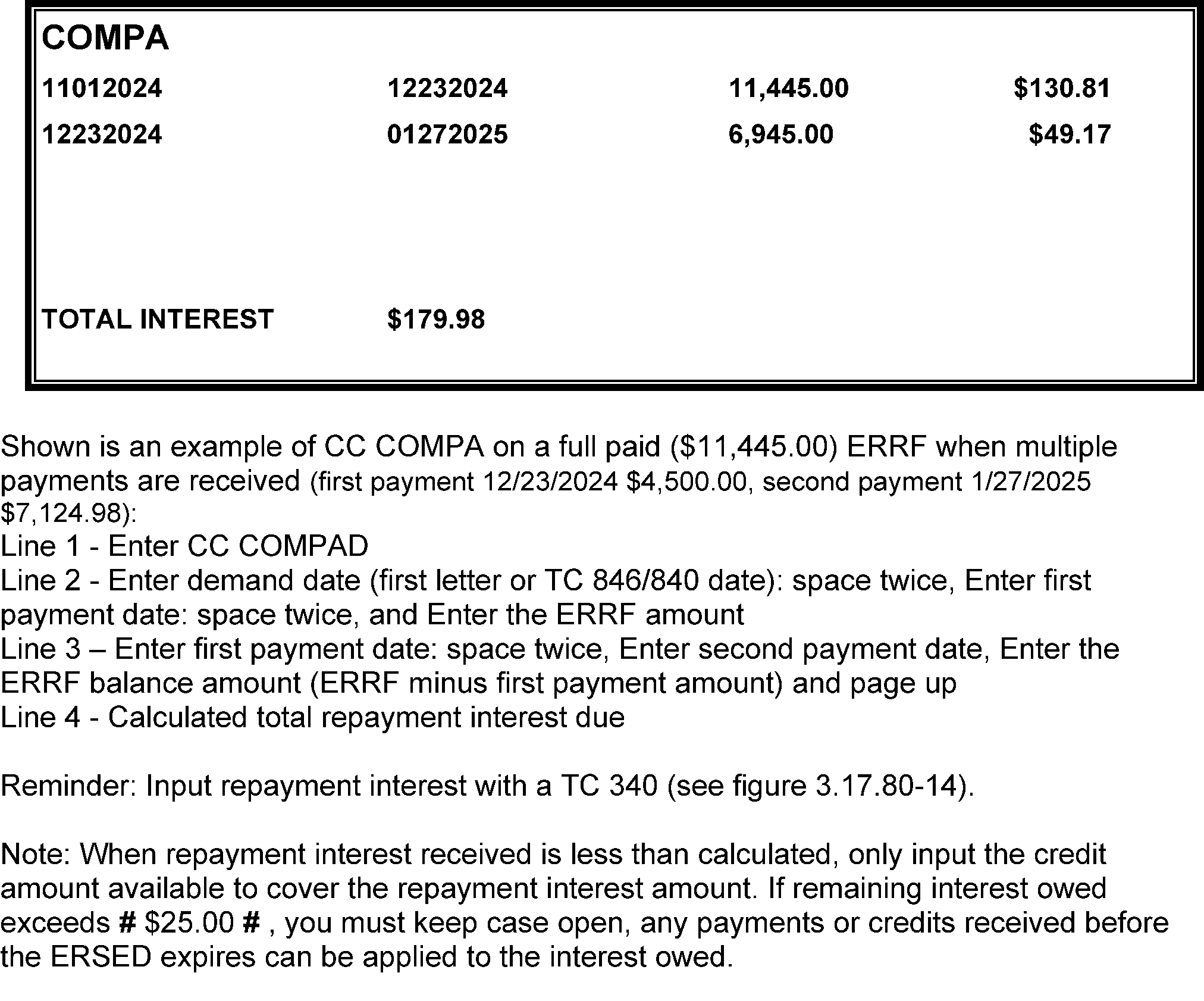
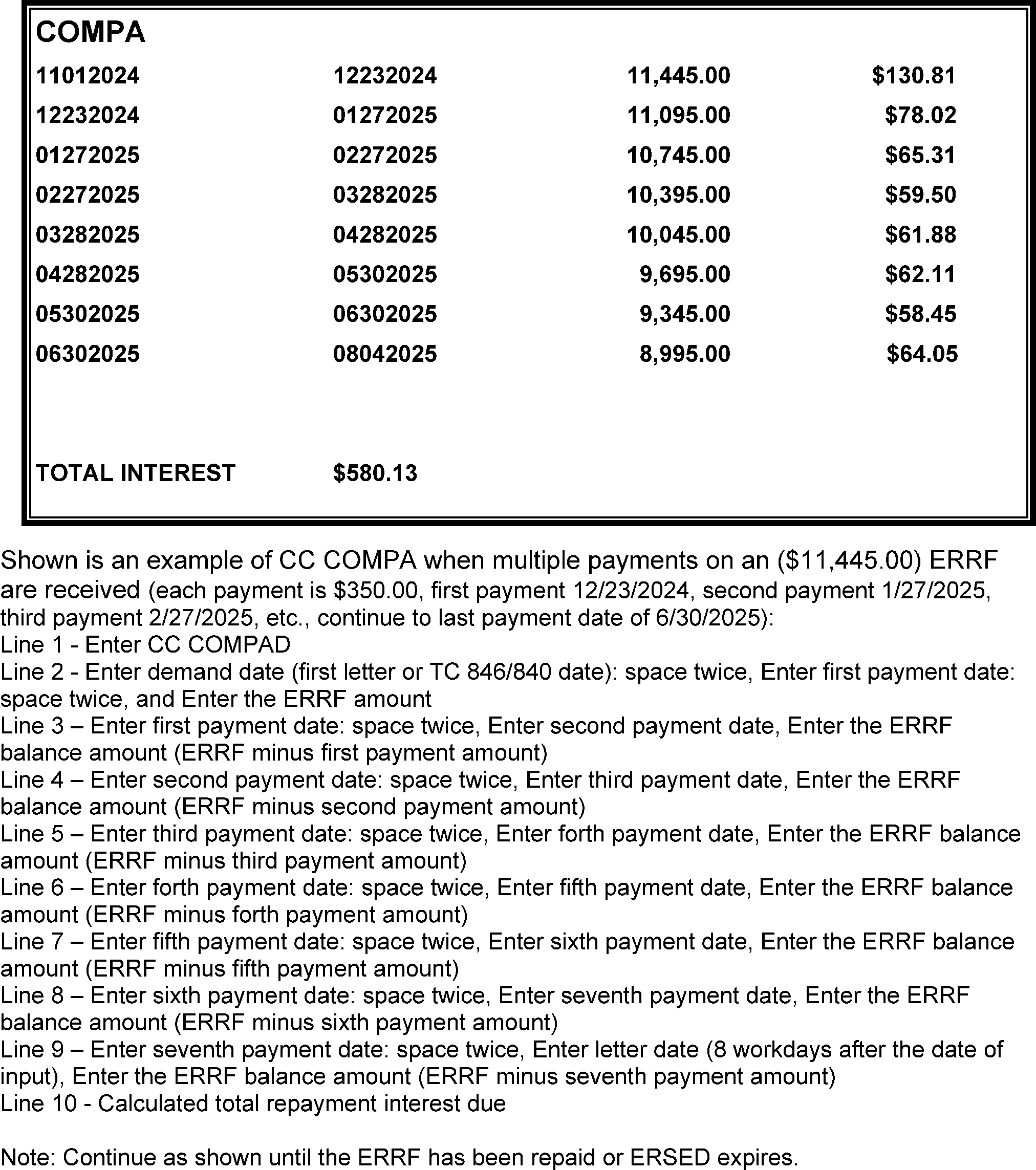

 )
or https:// means you've safely connected to the .gov website. Share sensitive information only on official, secure websites.
)
or https:// means you've safely connected to the .gov website. Share sensitive information only on official, secure websites.

